Lifestyle by Remi
Helping people find the best things to do in Japan and LA.
Kansai Region , Kyoto · March 11, 2023

Kyoto, Japan: 4-Day Travel Vlog + Itinerary
Planning a trip to Japan? This is episode six of my new Japan travel series, and today, we are heading to Kyoto. Kyoto is one of my favorite places to visit in Japan. It has the ability to transport you back in time and is seeping with rich history and culture. I can’t wait to show you what the area has to offer!
In today’s episode, I’ll share my 4-day Kyoto travel itinerary filled with Japan travel tips, things to do, places to eat, and more! I hope you enjoy it!
➡️ Don’t forget to subscribe to my channel: https://bit.ly/3fYsUxC ✨
DAY ONE – TRAVEL TO KYOTO
📍Kineya in Porta (実演手打うどん 杵屋 京都ポルタ店)
- Sanuki Udon restaurant in the underground shopping area at Kyoto Station
- Address: Japan, 〒600-8216 Kyoto, Shimogyo Ward, Higashishiokojicho, 902 京都ポルタ地下街 B1F
📍 Hotel Resol Kyoto Kawaramachi Sanjo
- Address: 59-1 Daikokucho, Kyoto, 604-8031 Japan
- https://www.resol-kyoto-k.com/en/
📍Imozou Kyoto Kiyamachi (焼酎・黒豚 芋蔵)
- Motsunabe hot pot
- 674-19 Kamiyacho, Nakagyo Ward, Kyoto, 604-8024, Japan
DAY TWO – HIKING FUSHIMI INARI
- Siphon coffee and breakfast shop near Fushimi Inari
- Address: 27-10 Fukakusa Ichinotsubocho, Fushimi Ward, Kyoto, 612-0012, Japan
📍Fushimi Inari Taisha Shrine (伏見稲荷大社)
- The Fushimi Inari Shrine is one of Kyoto’s oldest and most historic landmarks. It is an important Shinto shrine in southern Kyoto and is famous for its thousands of torii gates that line a network of trails toward Mount Inari.
- Address: 68番地 Fukakusa Yabunouchicho, Fushimi Ward, Kyoto, 612-0882, Japan
📍Fushimi Inari Sando Chaya (伏見稲荷参道茶屋)
- Address: 1-10 Fukakusa Kaidocho, Fushimi Ward, Kyoto, 612-0806, Japan
📍Kōdai-ji Temple (高台寺)
- Address: Japan, 〒605-0825 Kyoto, Higashiyama Ward, 高台寺下河原町526
* I don’t recommend going to Kōdai-ji after Fushimi Inari (even though I did it). Fushimi Inari is a workout in itself, so I don’t recommend planning anything too active afterward.
DAY THREE – CAFE HOPPING
📍 Smart Coffee ( スマート珈琲店)
- Address: 537 Tenshojimaecho, Nakagyo Ward, Kyoto, 604-8081, Japan
- Located on Teramachi Senmontenkai Shopping Street
📍 Blue Bottle Coffee Kyoto Kiyamachi Cafe (ブルーボトルコーヒー 京都木屋町カフェ)
- Address: Japan, 〒604-8023 Kyoto, Nakagyo Ward, Bizenjimacho, 310-2 立誠ガーデン ヒューリック京都 1F
- No outlets but good seating areas
📍 Starbucks Coffee – Kyoto Sanjo-Ohashi Bridge (スターバックス コーヒー 京都三条大橋店)
- Address: Japan, 〒604-8004 Kyoto, Nakagyo Ward, Nakajimacho, 113 近江屋ビル 1F
📍 Starbucks Coffee – Kyoto BAL (スターバックス コーヒー 京都BAL店)
- Address: Japan, 〒604-8032 Kyoto, Nakagyo Ward, Yamazakicho, 251 京都BAL 3F
📍Tully’s Coffee (タリーズコーヒー 河原町オーパ店)
- Underground coffee shop in a mall with outlets
- Address: Japan, 〒604-8026 Kyoto, Nakagyo Ward, 河原町 オーパ 地下 一階
📍Masayoshi Japanese Dining (京都ダイニング正義)
- Address: Japan, 〒604-8031 Kyoto, Nakagyo Ward, Daikokucho, 45 1F
DAY FOUR – ARASHIYAMA
📍Arashiyama
- Address: Ukyo Ward, Kyoto, 616-0007, Japan
📍Arashiyama Yoshimura (嵐山よしむら)
- Address: Japan, 〒616-8385 Kyoto, Ukyo Ward, Sagatenryuji Susukinobabacho, 3
📍Saga Toriimoto Preserved Street (嵯峨鳥居本伝統的建造物群保存地区)
- Address: Japan, 〒616-8435 Kyoto, Ukyo Ward, 嵯峨鳥居本
- Small local cafe at the bottom of the Saga Toriimoto Preserved Street
- Address: 27 Saganisonin Monzen Ojoincho, Ukyo Ward, Kyoto, 616-8426, Japan
- Address: 35-3 Sagatenryuji Tsukurimichicho, Ukyo Ward, Kyoto, 616-8384, Japan
Looking for more things to do in Japan? See more Japan travel vlogs and itineraries here ➡️ Japan Travel Series Playlist
Get a free Japan Travel Checklist!
Sharing is caring!
You’ll Also Love

Leave a Reply Cancel reply
Your email address will not be published. Required fields are marked *
Save my name, email, and website in this browser for the next time I comment.
This site uses Akismet to reduce spam. Learn how your comment data is processed .

5-Day Japan Travel Itinerary: Osaka, Kyoto, Nara & Kobe
Trending now.

follow @remishimazu

Work With Me
- Get In Touch
subscribe to newsletter
- Japan Travel
- Japan Destinations
- Japan Travel Tips
- Disclaimer Policy
- Privacy Policy
- Terms & Conditions
Copyright © 2024 Lifestyle by Remi · Theme by 17th Avenue

The PERFECT 3 Days in Kyoto Itinerary (2024 Update)
- Last Updated: January 26, 2024
Everything you need to know to plan your perfect 3 days in Kyoto itinerary!
Kyoto, once the capital of Japan, is home to a seemingly unlimited number of things to do .
From strolling quiet bonsai filled gardens to temple-hopping an unforgettable gold and silver pavilions.
This Kyoto 3 day itinerary will guide you through what you cannot miss out on in such a short window.
You’ll get some stunning views overlooking parts of Kyoto and walks through thousands of torii gates. Visit temples and shrines and stroll through a bamboo forest.
Also, plan on having some interesting cuisine of Kyoto – including fire ramen.
Yes, a bowl of ramen that is literally lit on fire just before serving!
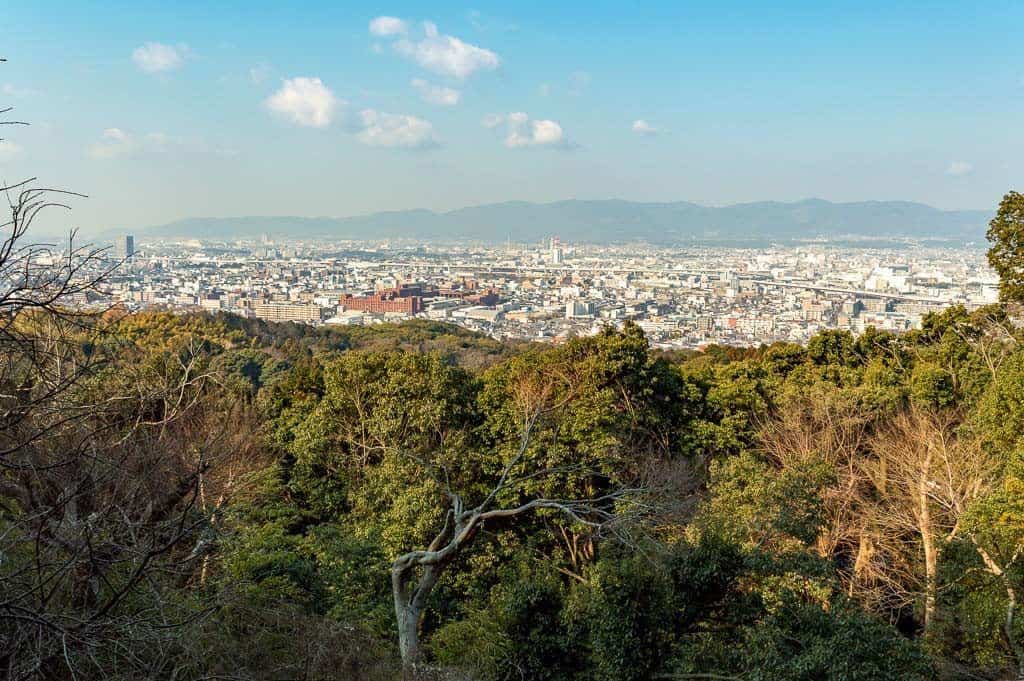
With all these memorable sights and attractions, 3 days in Kyoto might not sound like enough – as there will always be more to see in a city with a vast history and a unique, and often quirky Japanese culture.
Before we dive right into this 3 day Kyoto itinerary, here is a short history lesson for one of Japan’s best places to visit .
Table of Contents
History of Kyoto
8:45am – nijo castle, 11 am – menbakaichida fire ramen – lunch, 1 pm – kyoto imperial palace, 4 pm – nishiki market, 8 am – kiyomizu dera temple, 10 am – fushimi inari shrine, 12 pm – lunch, 1 pm – toji temple, 3 pm – ginkaku ji temple – silver pavilion, early – head to arashiyama, 8 am – togetsukyō bridge, 9 am – arashiyama bamboo grove, 11 am – tenryu ji temple, 12 pm – ryoanji temple and lunch, 3pm – kinkaku ji temple, summarizing your 3 day kyoto itinerary.
As mentioned above, Kyoto was once the capital city of Japan, from when it was founded in 794 to 1868.
However, Kyoto, which translates into “capital city,” has not always had the same name.
In 794, the city was founded as Heian.
Kyoto lost its capital city status when Japan handed control over from the leader of the samurai, the Shogun, back to the Emperor.
In 1868, the capital of Japan became Tokyo , where it has stayed ever since.
Today, Kyoto is Japan’s third-largest city (behind Osaka and Tokyo) and has plenty of ways to learn about the history of Kyoto.
There is plenty more on offer than just unforgettable temples.
Your Perfect 3 Days in Kyoto Itinerary
Without further ado, let me tell you what to do in Kyoto in 3 days!
First things first you need to find an awesome place to stay. We recommend staying in the Gion neighbourhood, so you’re central to everything there. You can find great accommodation here on Agoda .
Don’t forget to use our exclusive coupon code AGODANMD10 to get 10% off your booking.
READ MORE: Don’t miss our complete Travel to Japan guide !
Day 1 in Kyoto
We’re going to start off our Kyoto itinerary by tackling some of the best attractions in the city. Don’t forget to start your day early!
First up on this 3-day Kyoto itinerary is Nijo Castle .
One of 17 UNESCO Historic Monuments of Kyoto , Nijo Castle has several beautiful gardens and historical information within its giant fortified walls.
Tokugawa Ieyasu, the founder of the Tokugawa Shogunate, ordered all current feudal lords of Japan to contribute to the building of Nijo Castle.
Construction began in 1601 and completed in 1626.
Nijo Castle and the surrounding complex has been damaged by fire multiple times during the 1700s.
A lightning strike and a fire that ravaged much of Kyoto were to blame for the destruction.
Nijo Castle opens at 8:45 am.
It is a common theme to beat the crowds by arriving early, that’s why you should aim to be here by opening if you intend to have the castle grounds to yourself for a while.
Some of the main points of interest inside Nijo Castle include the Ninomaru Palace – consisting of five separate but joining buildings.
Intricate carvings from wood sand golden leaf decorations are present to this day.
They had the intention of portraying a powerful and wealthy.
One thing to look out for is the intentional “squeaky floors” to warn residents of ninja attacks as you can’t walk on the floor silently!
Nijo Castle is a great example of Japan’s final samurai period and a perfect way to start your 3 days in Kyoto.
Expect to spend 1-2 hours here, depending on how much you want to explore Nijo Castle and its grounds.
If you’re visiting Kyoto in spring, you can admire all the cherry blossoms that bloom on the grounds around the castle.
Kyoto is home to quite a unique style of ramen. In fact, the “fire ramen” is the only one in the world.
Plus, it’s a very short walk from Nijo Castle grounds.
This unforgettable bowl of ramen is in a tiny restaurant, so waiting times for your flaming bowl might take a few minutes to get seated.
That’s why I suggest getting here for a bit of an early lunch. It’s also delicious ramen as well!
Menbakaichida restaurant opens at 11 am, so if you can be within the first 5 or 6 guests, you shorten your waiting time until lunch to zero!
Now, when I say fire ramen, I mean they ignite your dish in a giant fireball in front of you, just before they serve it to you.
To make it safe, you’re given a paper apron for the oil splashes and specific instructions to lean backward on the bar stool.
Although it doesn’t feel it, the fireball is pretty cool.
It’s not just for a show, the flames help bring out the flavour in the green onions.
After a fiery lunch, it’s time to head to Kyoto’s Imperial Palace.
Today, you can visit the palace that served as the residence of the Imperial Family until Japan’s capital moved to Tokyo in 1869.
As is common with large wooden buildings, a fire destroyed the Imperial Palace a total of 8 times.
The version you see today was completed in 1855.
No reservation is currently required, and the opening hours are from 9 am to 5 pm.
Kyoto Imperial Palace is a short 5 minutes drive or 25-minute walk from Nijo Castle. You can combine your visit to the two attractions on a tour with a local guide !
Nicknames by locals as Kyoto’s Pantry, Nishiki Market is seen as the best traditional food market in the entire city.
Somehow, over 130 stalls of foods and goods line the narrow 5 block street in downtown Kyoto.
While this causes limited personal space, the atmosphere from the vendors and customers and all the tasty options to eat make Nishiki Market well worth the visit.
Nishiki Market is around 10 minutes by car or roughly 20 minutes on foot.
There is no entrance fee to enter this congested shopping street in downtown Kyoto.
It’s a perfect place to try some local Kyoto dishes and have a memorable dinner all at once.
If you love food, make sure you check out this foodie walking tour of Kyoto during the daytime!
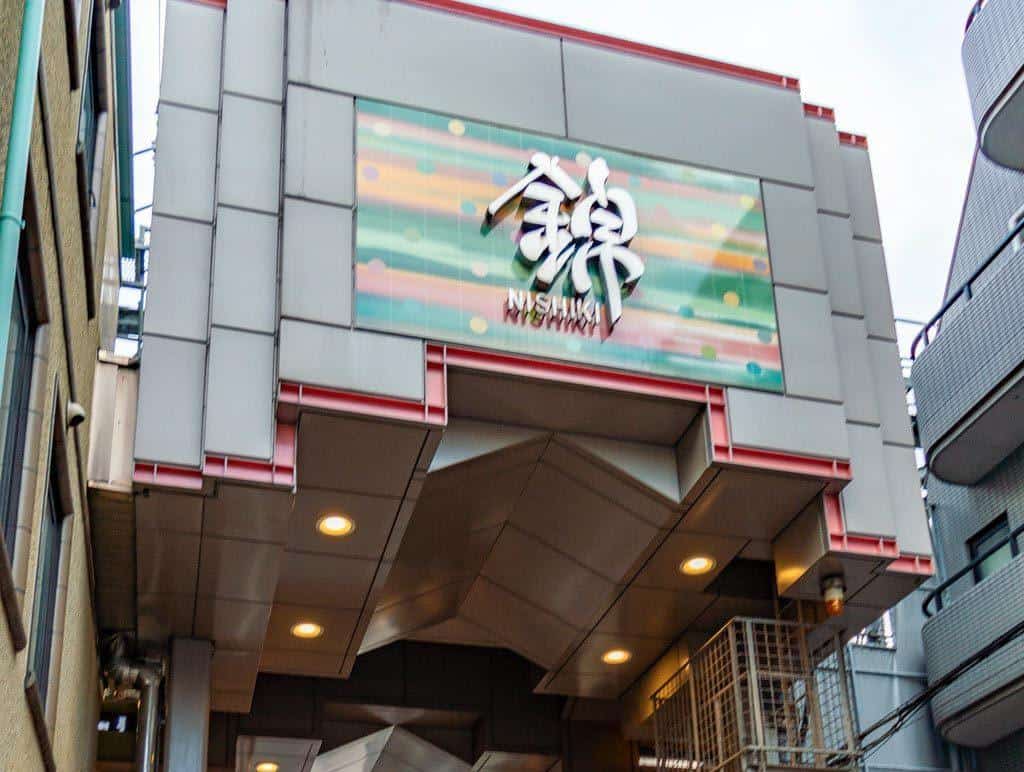
Check out our Japan Vlog on exploring the Higashiyama and Downtown Districts in Kyoto in Japan .
Welcome to day two of your 3-day Kyoto itinerary! Get up nice and early, as it’s going to be a jam-packed day in central Kyoto.
Start your day with a visit to the Kiyomizu Dera Temple, perched on the scenic hills of eastern Kyoto, Japan.
Originally established in 778, the present structure dates back to 1633 and is an architectural marvel, characterized by its wooden terrace jutting out over the hillside, offering a stunning vista of cherry blossoms in spring and vibrant foliage in autumn.
The temple complex is dedicated to the Buddhist deity Kannon and houses a sacred waterfall, Otowa-no-taki, where visitors partake in a ritual of drinking water believed to confer health, longevity, and success.
Kiyomizu Dera Temple stands as a testament to Japan’s religious heritage and architectural prowess. From here it’s just a 12-minute drive or bus ride to your next stop.
Fushimi Inari Shrine is usually the number one attraction – in all of Japan!
This popularity means that it is busy, very busy!
Dedicated to the Shinto God of Rice, Inari, thousands of bright torii gates lead visitors from the main shrine up Mt Inari.
This trail winds up the sacred Inari Mountain and eventually gives off some beautiful views of Kyoto and surrounding areas.
Even if you’re here as early as possible, you won’t be able to escape the crowds by the time you descend Inari Mountain.
But that early morning walk through one of Japan’s most important shrines is amazing.
At the entrance to the shrine complex stands the Romon Gate that was donated in 1589.
Another popular spot for a photo OP is where the torrid gates and pathway splits into a ‘Y’ shape.
Depending on your speed, the full hike to the summit of Mount Inari takes from 2-3 hours, so bring plenty of water and snacks along with you.
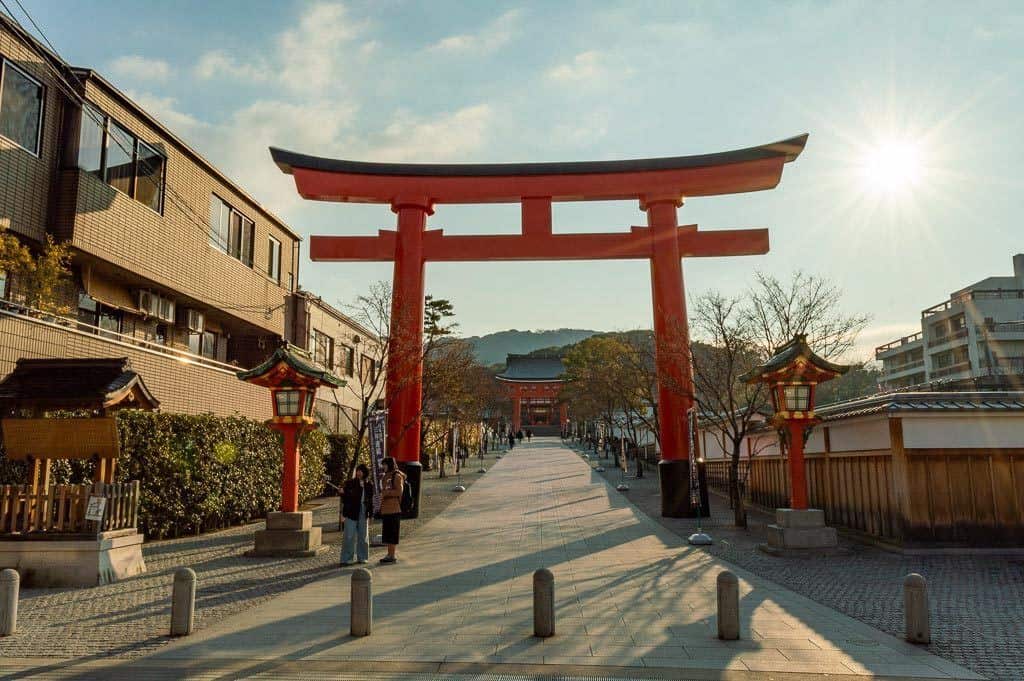
There are plenty of options for great restaurants for lunch around Fushimi Inari Shrine.
If you’re in the mood for sushi, Kyoto Train Station, has a great sushi train option, Ashami .
Whatever you’re looking for, from egg rolls and inari pockets to octopus and even horse meat (providing the translation is legitimate).
It’s a pretty cheap option for lunch with 3 or 4 plates costing around USD$6, depending on what plates you choose.
Toji Temple , or East Temple, was built at the start of the Heian Period in the late 700’s.
This 5 story pagoda is made from wood and is another famous UNESCO World Heritage Site in Kyoto.
Other notable buildings in the complex include Kondo Hall .
Reconstructed in the early Edo Period after a fire in 1486 destroyed the original.
It is considered one of the Toji Temple Complex’s original buildings.
Destroyed in the same fire is Kodo Hall, which sits next door. Kodo Hall served as the lecture hall in the Toji Temple area.
The wooden Toji Tower itself stands 57 meters tall, the tallest in all Japan.
You can get to Toji Temple via the Kintetsu Kyoto Line and is a 5-minute walk from Toji Station.
During cherry blossom season, the grounds around the temple are overflowing with the beautiful flowers as well!
After Shogun Ashikaga Yoshimasa’s death in 1490, Ginkaku ji Temple, or the Silver Pavilion, was reformatted from retirement house to Zen Temple.
While Ginkaku ji Temple is well worth a visit in itself, as are the other buildings in the complex, it is the beautiful moss-covered gardens that steal the show.
Walking a small loop through lush greeny and trickling rivers, it’s hard to find a place equal to the tranquillity of the Ginkaku ji Temple Complex.
Ginkaku ji Temple can be accessed from Kyoto Station by bus #5, 17 or 100.
Opening hours are from 8:30 am to 5 pm.
Expect to spend about an hour here, unless you walk the short trail very slowly taking in the sights.
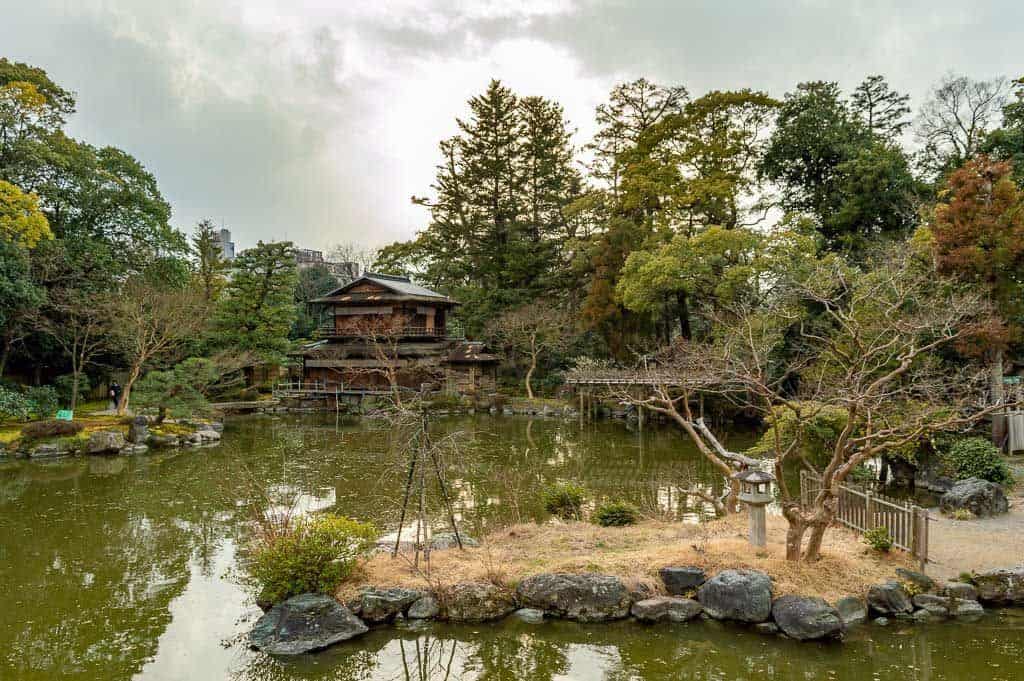
Check out our Japan Vlog on exploring the Gion District in Kyoto, Japan .
We’re almost at the end of your itinerary for Kyoto in 3 days. Don’t think you’ve done everything just yet though, we still have a few more amazing Kyoto activities for you.
On the western edge of downtown Kyoto is the district of Arashiyama .
This whole area is not only a Historic Site of Kyoto, but it’s also a Site of Scenic Beauty, as classified by the Japanese Government.
There are several things to do in the area of Arashiyama, and most are easy walking distance from each other.
As with most popular sites around Kyoto, Arashiyama is popular, and that brings crowds.
Arashiyama is easily accessed from Kyoto Station. Jump on the JR Sagano Line and head to Saga-Arashiyama Station.
From here, the center of Arashiyama is a 10-minute walk.
Check out our Japan Vlog on exploring Kyoto’s most famous attraction in Japan .
If you catch the train to Arashiyama JR Station, you will be close to Arashiyama’s well known Togetsukyō Bridge .
So it makes sense to visit here first.
In fact, the easiest way to get to the next stop, the Arashiyama Bamboo Forest , you’ll cross the bridge anyway.
Togetsukyō Bridge spans 155 meters across the Katsura River.
The original bridge was constructed a little upstream in 1606.
Walking the length of this bridge gives beautiful views of the river below and the surrounding mountains.
You might even get lucky enough to see local fishermen casting in along the banks.
One of the areas most visited sites of Arashiyama is the Bamboo Grove.
This is a natural bamboo forest, with paved trails weaving through the tall shoots of the sturdy, yet flexible plant.
Since 2015, the Arashiyama Bamboo Grove has opened free of charge to visitors.
This makes the attraction near Kyoto even more appealing.
If you’re wanting to visit the Bamboo Grove without hordes of visitors and hand-cart taxis, I suggest starting your day here.
For an even better experience, you can book yourself a great guided tour of the bamboo forests .
Or do something real different and try a rickshaw tour here.
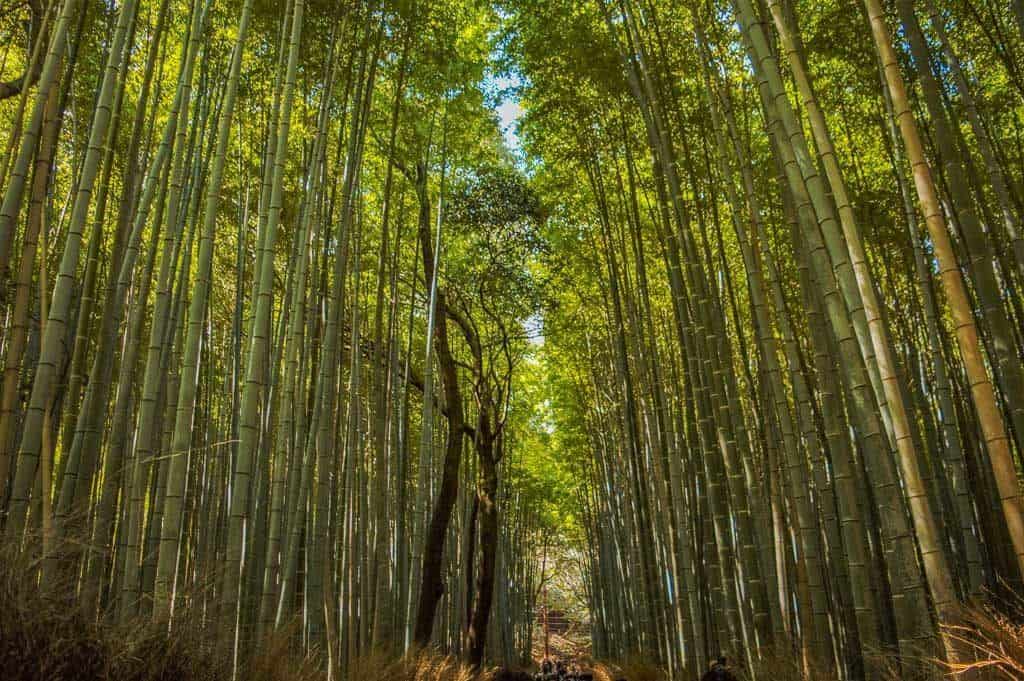
Built in 1339 by the Shogun Ashikaga Takauji, in dedication to Emperor Go-Daigo who passed away as means to ease the spirits of the late ruler.
Much of the temple grounds, including most of the building, have been destroyed multiple times throughout history and now date back to the Meiji Period (1868 – 1912).
The gardens of the Tenryu ji Temple survive in their original state to this day and provide a lovely stroll around the small pond.
Opening hours for Tenryu ji Temple are 8:30 am to 5 pm, and you should expect to spend around an hour here.
Ryoanji Temple was converted into a Zen Temple in 1450.
It’s also the site of possibly Japan’s most renowned rock garden.
Pretty much everything about this rock garden is uncertain, its date of construction and the meaning behind it.
The story I heard most is that these 15, expertly placed stones, resemble a tiger carrying a cub.
One of the most interesting facts, is that in this square enclosure of pebbles, no matter where you stand, you can only ever see 14 stones.
Personally, it’s the surrounding scenery that makes Ryoanji Temple a must-visit with 3 days in Kyoto.
There are plenty of quiet trails and immaculately kept ponds to soak in the reflection of the still surface.
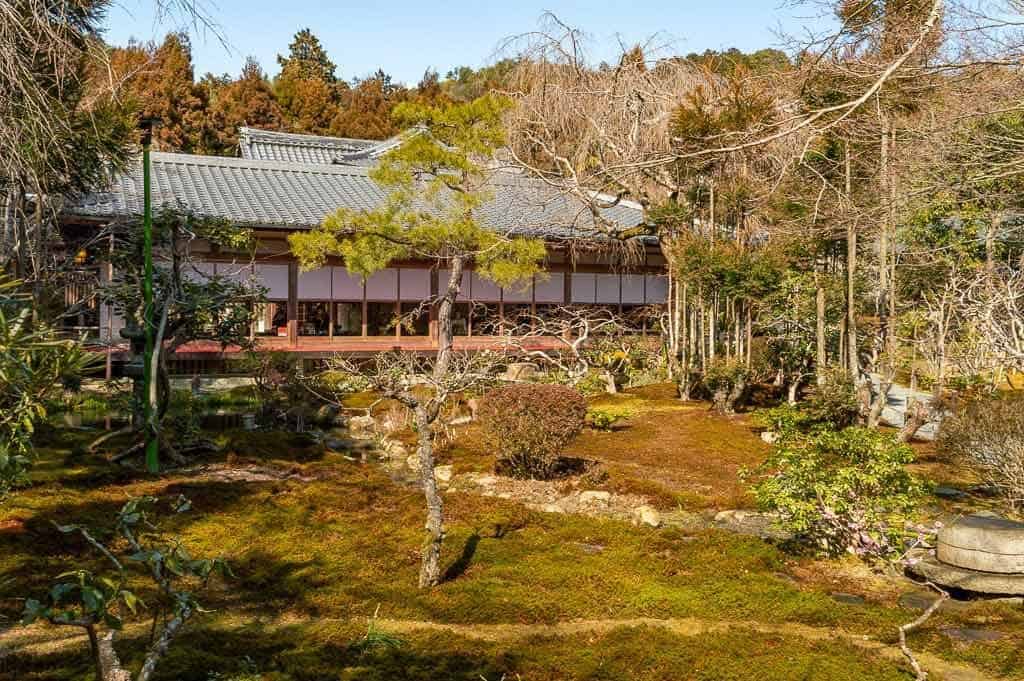
For lunch, there’s no need to leave the temple grounds.
There is a small restaurant that offers a Kyoto specialty, Yodafu .
Boiled tofu in a tasty broth is a lot more filling than you would expect.
This, along with Japanese Tea and a beautiful view overlooking the lush green surroundings is a perfect spot for lunch.
A 3 day Kyoto itinerary wouldn’t be complete without a visit to Kinkaku ji Temple, or the Gold Pavilion.
One of Kyoto’s famed 17 Historic Monuments, the Golden Pavilion Buddhist Temple is one of Japan’s most visited buildings.
This Zen Temple was originally completed in 1397 and reconstructed in 1955 after being burnt to the ground by a novice monk who then tried to commit suicide behind the temple.
The glimmering gold surface has a symbolic meaning and thought to cleanse negative thoughts concerned with death.
As it is so popular, getting a picture or a view without another person in the shot is almost impossible.
By standing next to the edge of the lake, looking out over the glass-like surface and the reflecting golden iconic symbol of Kyoto, it’s hard not to fall in love with Kinkaku ji Temple.
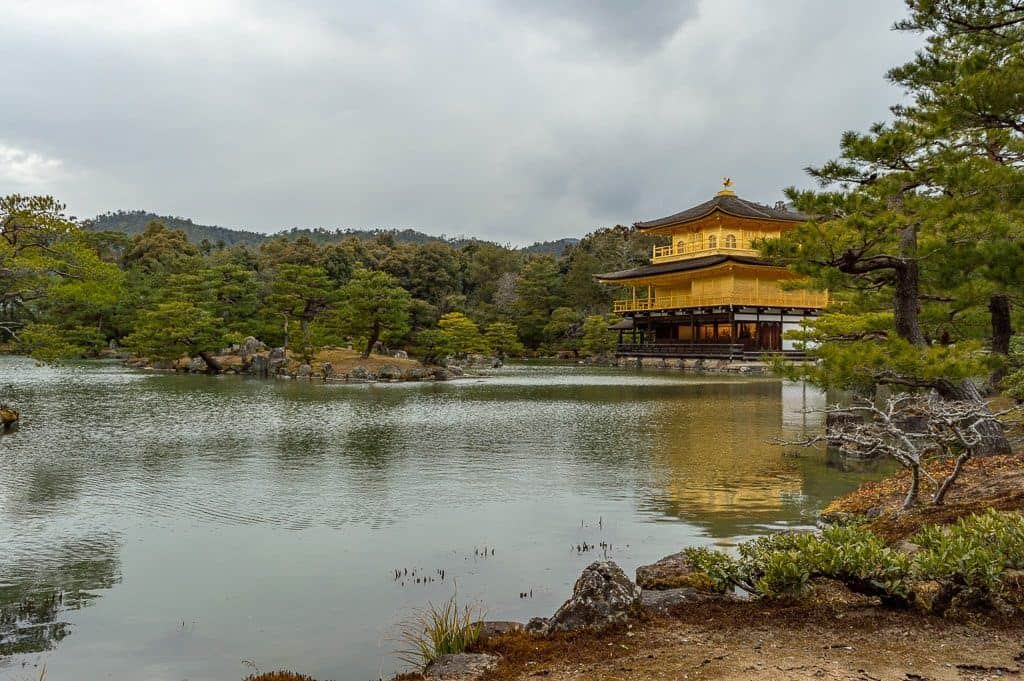
As with all destinations with the vast history and culture of Kyoto, there will always be more to see.
In fact, 3 days in Kyoto is just the beginning of this incredibly beautiful, historic city. There are so many more temples and shrines and hidden gems to check out.
But by following this Kyoto 3 day itinerary, you’ll be treated to a range of cultural, historical and scenic sights that this busy city has to offer.
And by the end of your trip here, you’ll have a small but memorable insight into one of Japan’s ancient capital cities.
Ben McLaughlan
Hi, We’re Alesha and Jarryd!

We’ve been traveling the world together since 2008, searching for the planet’s best destinations and adventures.
Love Travel?
Sign up for our free weekly newsletter for the best travel tips, ideas and deals!
We respect your privacy. Unsubscribe at any time.
READ MORE...
The Perfect 3 Days in Tokyo Itinerary
The Best Day Trips from Every City in Japan [2024]
18 Amazing Things to Do in Kyoto at Night (2024 Guide)
Related Posts
8 reasons why you should visit tohoku, japan on your next trip, the perfect yokohama itinerary for 1, 2 or 3 days (2024), 20 epic things to do in okinawa, japan [2024 guide], 12 awesome things to do in hakone, japan (2024 guide), 3 thoughts on “the perfect 3 days in kyoto itinerary (2024 update)”.
Love this itinerary! Can’t wait to visit Kyoto in 2024. Your detailed breakdown of the best temples, shrines, and other attractions is incredibly helpful. Definitely bookmarking this for my own trip planning.
Next June we will travel to Kyoto. we are 3 adults, what is the cost of a 3 day package?
Hi Aracelly, That is exciting you are going to Kyoto. Sorry we can not help you. We are not a travel agent. We are a website that gives out travel information. All the best.
Leave a comment Cancel reply
Save my name, email, and website in this browser for the next time I comment.

KYOTO TRAVEL GUIDE 2023 (Budget + Itinerary)
by thepinay solobackpacker | Jan 3, 2023 | Itinerary , Japan , Kyoto , Travel Guide | 5 comments
As promised, I’ll blog about KYOTO, so here’s my Kyoto Travel Guide based on my recent visit to Kyoto, Japan to help you plan your trip to Kyoto this 2023.
Kyoto is just as I imagined Japan to be – Japanese wearing their traditional kimono, ancient Japanese wooden temples fringed by Zen gardens and rich culinary tradition. After all, this bountiful district was the center of Japan’s culture for over 1,000 years. But after arriving in its bustling city center where towering buildings and complex train system welcomed me, admittedly, I wanted to find where I can get a glimpse of the “authentic” Japanese culture. But the moment I stepped out of Kyoto city center, I finally saw the reason why I wanted to book a trip here.
I was given the chance to visit Kyoto recently due to a blogger’s trip organized by Cebu Pacific Air. Japan has long been knocking on my door, the same airline gave me tickets a few years back, but I was not able to claim it. Then, a year after, I got another invite from another airline to visit Japan and blog my travel experience, but I never got to use the ticket because I was scared of applying for a Japan tourist visa. Then Cebu Pacific invited us to visit Nagoya , but I wasn’t available. So when the opportunity knocked again for the 4 th time, I knew I was destined to visit Japan. So from the Philippines, we flew to Osaka, Japan and we did a side trip to Kyoto . But some of us decided to extend our trip and explore more of Kyoto as well as Nara.
TRAVEL BLOG CONTENTS
ABOUT KYOTO, JAPAN
Kyoto, the erstwhile imperial capital of Japan from its foundation until the 19 th century. Most travelers booking a trip to Osaka, include Kyoto on their itinerary and it is easy to understand why.
Kyoto may not be as colossal as other cities in Japan (although historically it was, until it was bested by Tokyo and Osaka), but it is absolutely soaked in history and traditions. In fact, this traditional Japanese city is peppered with more or less 2,000 sacred temples and shrines including 17 UNESCO World Heritage Sites.
WHERE IS KYOTO?
So where exactly is Kyoto? Kyoto is a city situated in Kyoto Prefecture in Kansai Region on Honshu Island, Japan. Since Kyoto doesn’t have its own airport, the nearest international airport is Kansai International Airport in Osaka, Japan. If you are planning a trip to Kyoto, might as well include Osaka, Nara, Kobe or Himeji in your travel plan.
KYOTO TRAVEL GUIDE 2023
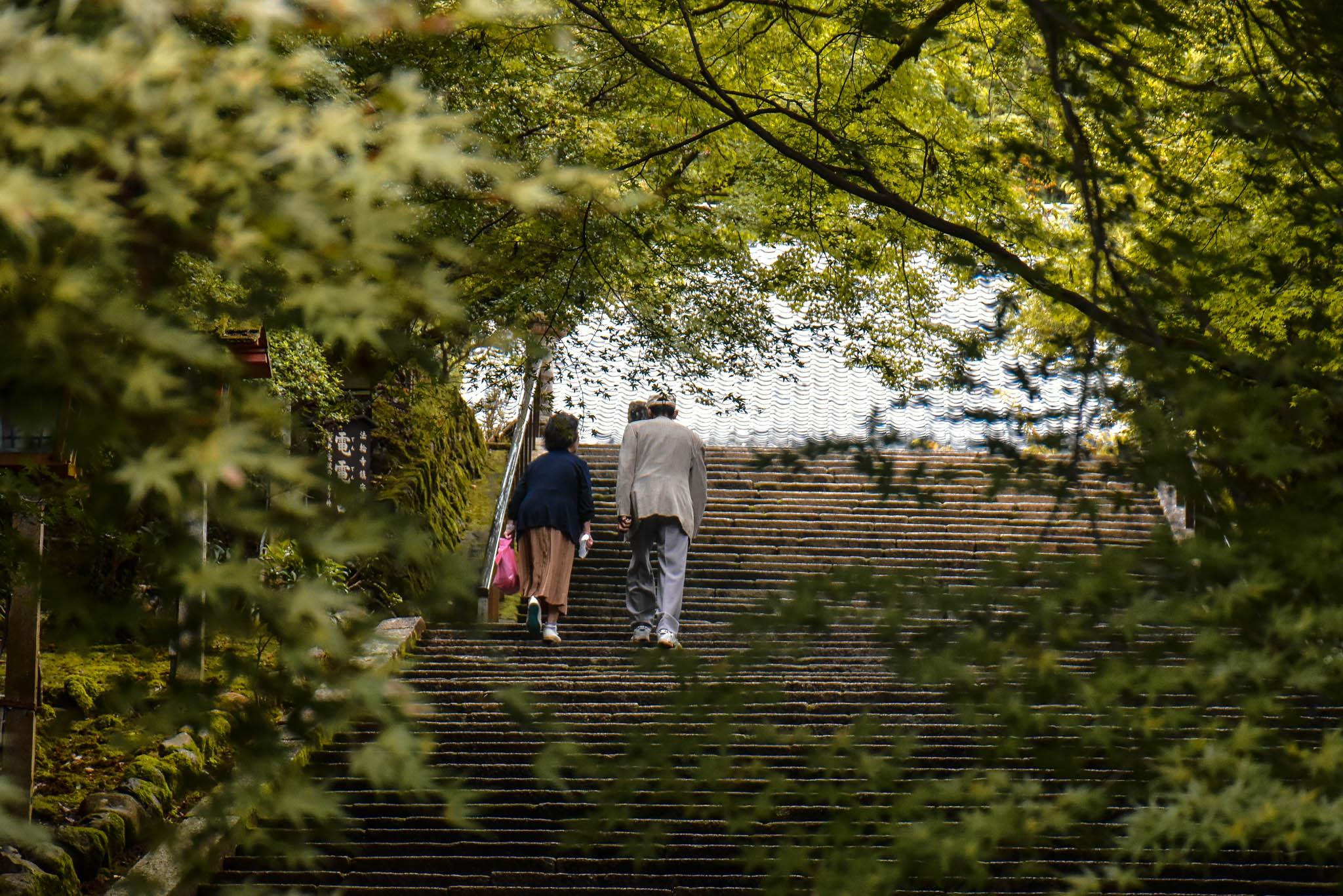
WHEN IS THE BEST TIME TO VISIT KYOTO, JAPAN?
Just like Osaka, Kyoto is also a year round destination, but spring attracts the most tourists because of the cherry blossom season. This period usually starts around mid-March until cherry blossoms reaches its full bloom roughly 2 nd week of April.
But if you are like me who wants to see Kyoto in varied colors, visit around November to December due to the autumn foliage. Not as swamped as spring, but definitely as charming.
If you are living in Southeast Asia and you want to experience snowfall, Japan is one of the nearest countries to tick that off your bucket-list. Winter in Japan starts in December and ends in February.
Nonetheless, whatever season you plan to see Kyoto, you will not get disappointed, because Kyoto parades its allure all season.
MONEY EXCHANGE IN KYOTO
I exchanged my money near the arrival area of Kansai International Airport (KIX) in Osaka. Otherwise, you can just withdraw from the ATMs in 7-Eleven around Kyoto city. Take note that many ATMs in Japan do not accept foreign credit card, debit card or ATMs. Withdrawal fee is JPY 600 / PHP 300/ USD 6. Do inform your bank that you will be traveling to Japan just to ensure that you won’t have a problem withdrawing overseas because for security purposes, some banks block the card whenever they notice suspicious foreign transactions.
INTERNET IN KYOTO
Wi-Fi while traveling around Kyoto is inevitable for me especially when commuting. So when riding buses and trains on my own, I always consult these two : Google Maps and Hperdia.com . Google Maps is reliable for location tracking and lets me know how far I am from my destination. I use Google Maps all the time when riding buses. On the other hand, Hyperdia.com tells me which train to ride, where to get off and how much is the fare for the train ride.
Upon arrival at Kansai International Airport in Osaka, there are Wi-Fi router for rent at the arrival section for roughly PHP 397/ JPY 900 / USD 8 per day (they only accept credit cards). However, because it is usually in-demand, sometimes they are out of stock. To avoid the hassle of looking for a Wi-Fi router, I recommend you rent a Wi-Fi router before leaving the Philippines. You can rent a 4G WiFi pocket handy device with convenient pick up and drop off at all international airports in Japan. You can enjoy 4G WiFi coverage across Japan on a pay per day rental basis and connect up to 5 devices on the same pocket WiFi router. Per day rate is roughly PHP 224 / JPY 508 / USD 4.51, by far the cheapest rate I’ve heard. You can rent a 4G pocket WiFI here .
JAPAN VISA
How to get to kyoto, japan from manila.
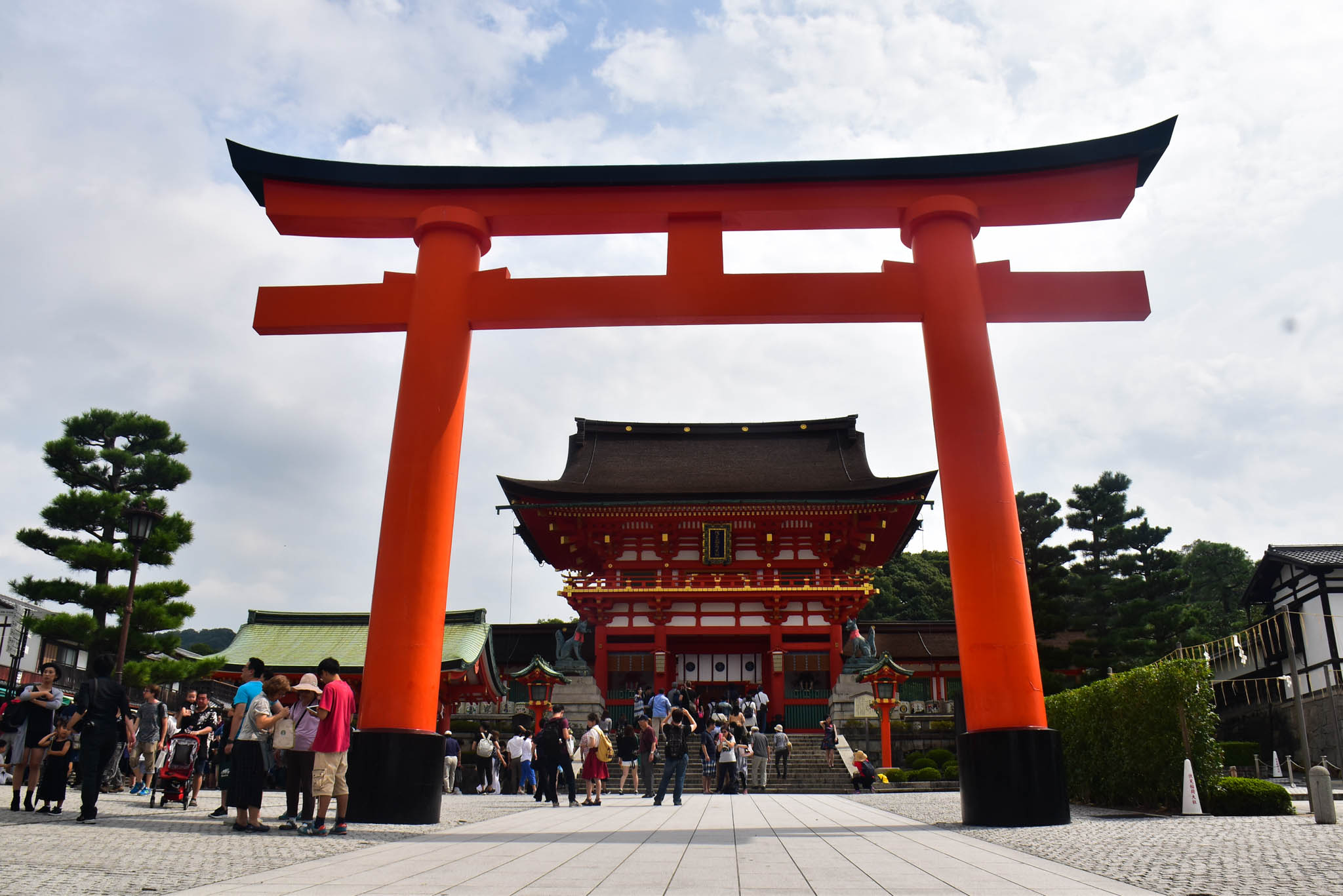
Like I mentioned above, the nearest airport to Kyoto is Kansai International Airport , popularly known as KIX, situated in Osaka, Japan. There are several airlines flying to Osaka from the Philippines, but we flew via Cebu Pacific , the largest airline in the Philippines. They have flights between Manila and Osaka five times weekly, with lowest year-round fares starting from PHP 6,399. If you plan to visit Tokyo too, you can book your return flight to Tokyo as they also fly from Tokyo (Narita) to Manila and Cebu, Nagoya and Fukuoka to Manila and vice versa. Book its trademark lowest fares now through http://bit.ly/CEBOsakaflights or (+632)7020888, or follow its Facebook or Twitter pages for the latest seat sales.
HOW TO GET TO KYOTO CITY FROM OSAKA AIRPORT
By haruka train.
If you are just traveling within the Kansai Region in Japan, you can purchase a JR West Kansai Area Railpass here. From Kansai International Airport in Osaka, to get to Kyoto, you can ride a train.
Haruka train departs every 30 minutes, so about 2 trains per hour. Travel time is about 1 hour and 40 minutes. Fare is about PHP 847 / JPY 1,880 / USD 35. Non-reserved seat fee PHP 970 /JPY 1,114 / USD 9. Reserved seat fee is PHP 761 / JPY 1,690 / USD 15. Green seat is PHP / JPY 2,250 / USD 20. So total fare is around PHP 1,608 to PHP 1,817/ JPY 3,570 to JPY 3,350/ USD 35 to USD 44.
If you want to save on Haruka train ride, use your JR Railpass , or your ICOCA Card . If you have a JR Railpass , you can ride the Haruka train, a limited express train to Kyoto for free. Since Haruka train is a limited service, you need a fare ticket (passing the gate) for non-reserved travel and a limited express ticket (Haruka ticket).
In case you don’t have a JR Railpass, you can also use the ICOCA Card , you can purchase the ICOCA Card here for fare ticket (passing the gate) and just purchase a Haruka ticket from the conductor onboard the train.
ICOCA & HARUKA is a set of cards: ICOCA IC Card pre-charged with JPY 1,500 / PHP 676/ USD 13.47 + a discounted ticket for the Kansai-Airport Express HARUKA. You can use the ICOCA Card on JR, subway, private railway and bus transportation and even for shopping in the Kansai Area and beyond, meanwhile, the Kansai-Airport Express HARUKA offers direct trip from Kansai-airport Station to Tennoji, Shin-Osaka and Kyoto Stations. Take note that Haruka doesn’t stop at Osaka Station, only at Shin-Osaka Station.
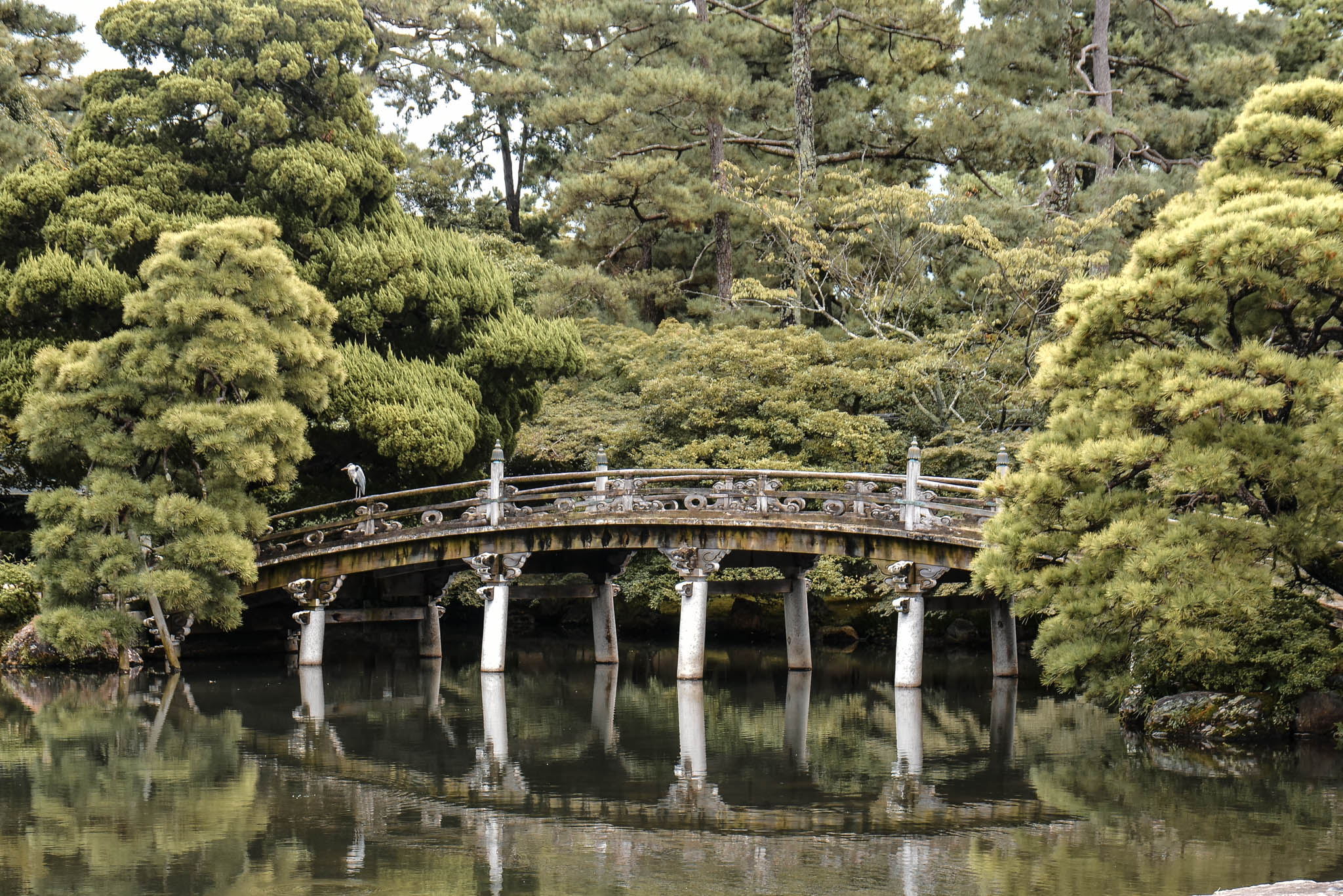
By JR Railpass Trains
(2 Transfers)
From Kansai International Airport (KIK), to get to Kyoto City, you can also take the JR Airport Rapid Train to Osaka Station. Then at Osaka Station, take another train at JR Kyoto Line to Kyoto. Travel time is about 1 hour and 40 minutes.
(2 transfers)
From Kansai International Airport (KIX) take the Nankai Ltd. Exp. Rapit 52 to Osaka. Get off at Osaka Station. Travel time is 53 minutes. Then take the LTD. Exp Thunderbird 29 to Kyoto. Travel time is 27 minutes. Total fare is about PHP 1,351 /JPY 3,000 / USD 27.
From Kansai international Airport, there are limousine buses that can take you directly to Osaka or Kyoto. You can purchase a bus ticket for the airport transfer to Osaka and Kyoto here .
Hiring a car in Kyoto is expensive. If your wallet is well-endowed and you want stress-free transfer from Kansai International Airport to Kyoto, you can rent a car.
Since Kansai International Airport is really far from Kyoto (about 56 KM or about 1 hour 3 mins drive) taking a cab is really expensive. Flag down is PHP 301 / JPY 650 / USD 6.
GETTING AROUND KYOTO, JAPAN
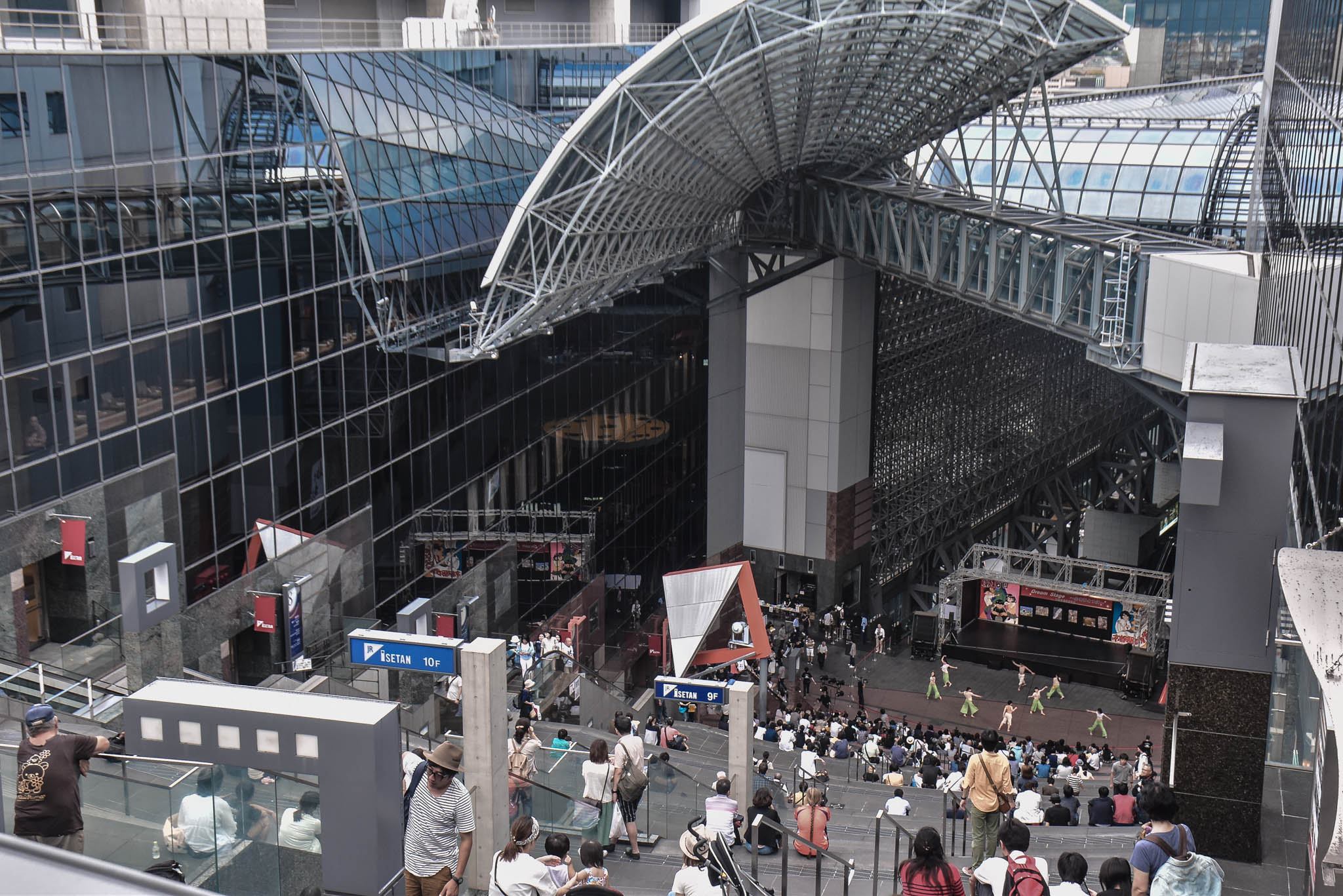
What I like about traveling in Kyoto is its efficient transport system. The trains connect each city or destinations to another. It might look complex for a first-timer, but if you observe well and use the train often, you’ll get the hang of it. Same with buses, almost everything in Kyoto is connected by a network of bus routes.
If you have a JR Pass , you can use it in getting to some of Kyoto’s top attractions like Fushimi Inari Station, Tofuku-ji Temple, Uji and Arashiyama from Kyoto Station. Kyoto’s train system is made up of JR Lines and other private lines like Hankyu Lines. You can also use your JR Pass to travel to nearby cities like Osaka, Nara and Kobe. You can purchase a JR West Rail Pass here if you are only traveling in Kansai Region. If you are traveling beyond Kansai, for example you are going to Kyoto or Nagoya, I recommend buying a JR Rail Pass.
HANKYU LINES
For unlimited train travel on all Hankyu Lines in Kyoto, Osaka and Kobe, you can purchase a Hankyu 1 Day or 2 day Pass here . Tickets start at PHP 364 / JPY 808 / USD 7.25
One of my favorite ways for Kyoto sightseeing is by bus because they have routes that cover the entire city. Getting around by bus in Japan is not as convenient as by train, but it is enjoyable and information is easy to come by. While most city buses runs from 7:00 AM until 9:00 PM daily, a few start as early as 5:30 AM until 11:00 PM. When the bus and subway systems close for the night, generally around midnight, your only option will be riding a cab. I suggest getting a bus map from the Tourist Information Center so you’ll have an idea about the bus route.
I highly recommend getting on the Raku Buses as they are meant for tourist sight-seeing. If you board the regular city buses, many of them don’t have signs in English, unlike the Raku Bus.
Now you might ask what is a Raku Bus and how do I spot it? Raku Buses are pink-colored loop buses that run through Kyoto’s key tourist destinations. They are easy to spot as they have the following numbers and routes:
Raku Bus 100 leaves regularly from Kyoto Station from 7:40 AM to 05:00 PM with the following route: Kyoto Station National Museum & Sanjusangendo Temple → Kiyomizudera Temple → Gion → Heianjingu Shrine → Ginkakuji Temple
Raku Bus 101 departs regularly from Kyoto Station from 8:00 AM to 04:30 PM with the following route:Kyoto Station → Nijo-jo Castle → Kitano Tenmangu Shrine → Kinkakuji Temple → Daitokuji Temple → Kitaoji Bus Terminal
Raku Bus 102 departs from the Ginkakuji-michi Bus Stop from 8:04 AM to 4:34 PM with the following route: Ginkakuji Temple → Kyoto Imperial Palace → Kitano Tenmangu Shrine → Kinkakuji Temple → Daitokuji Temple → Kitaoji Bus Terminal.
I recommend buying a Kyoto City Bus Pass or purchase a Kansai Thru Pass here for unlimited rides on subways, railways and buses across Kansai and Osaka Bay Region (Kyoto, Osaka, Nara, Kobe) for 2 or 3 days.
You can use your Kyoto City Bus Pass or Kansai Thru Pass on Raku Buses that I discussed above. . When you board the Kyoto City Bus Pass or your Kansai Thru Pass with your 1 or 2 day pass for the first time, the first time you get off the bus, you need to enter the card on the card slot and the date will be printed. Then the next time you board the bus, just show the card with the date to the driver. In case you board the non-flat fare routes bus, you need to enter the card again to the card slot. You will be billed extra if your stop is outside the short distance (flat fare) route. Flat rate bus fare is JPY 230 / PHP 102/ USD 2 for adults and JPY 120 / PHP 53.45 / USD 1.07 for kids.
At each bus stop, a guidepost indicates the stop name, the bus route, the bus number and even a timetable for services on weekdays and weekends and public holidays. Take note that when riding a bus in Kyoto, you have to enter at the rear door and exit at the front door. There is a paper ticket dispensing machine beside the driver, tell the driver where you are going and drop the exact fare there. If you are riding the Raku Bus, the next stop will be announced in Japanese and sometimes English.
BY ICOCA IC CARD
In Kansai region in Japan, they have the ICOCA Card, a contactless travel card for Kansai trains, buses & shopping. Works like Octopus Card in Hong Kong. Basically the ICOCA IC Card covers the major cities of the Kansai region including Osaka, Kyoto, Nara and Kobe. To use this, just swipe the ICOCA Card and you can seamlessly hop aboard metros, buses, trains or even pay for your shopping. The card is preloaded with JPY 1,500 / PHP 662/ USD 13 credit, plus the JPY 500 / PHP 220/ USD 4.44 so it’s ready to use as soon as you pick it up. Additionally, you can get discounted Haruka rail ticket for the Kansai Airport Express (incl. Tennoji, Shin-Osaka and Kyoto) on presenting your ICOCA card (temporary visitors with foreign passports only). Just pick up the card at Osaka Kansai International Airport Terminal 1: HIS counter (1/F) next to the Northern Exit in the Arrival Hall (Opening hours: 8:30am-10:00pm) or at Osaka City Air Terminal (JR Namba Station), Opening hours: 8:30am-8:30pm. You can purchase the ICOCA Card here
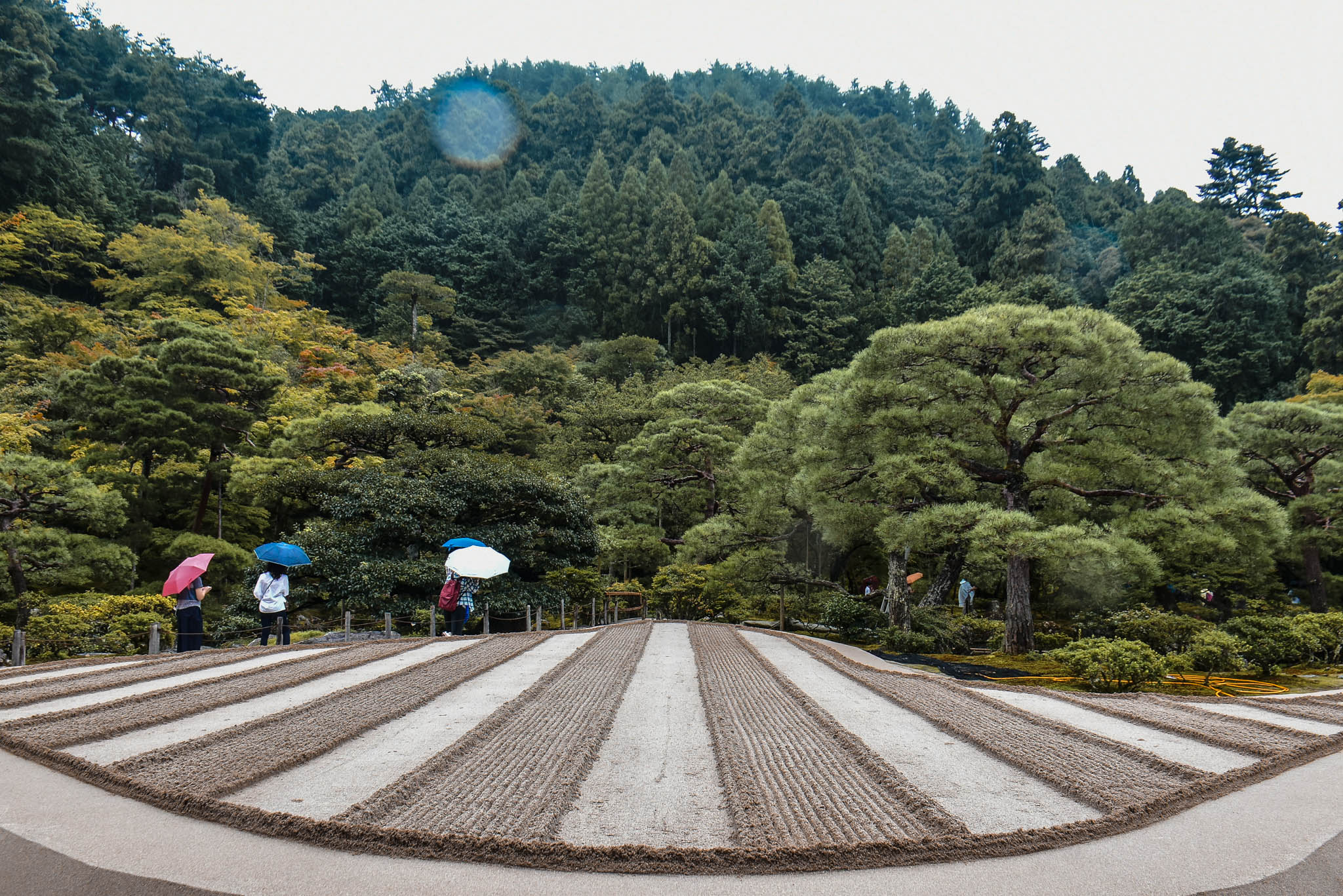
Taking a taxi in Kyoto is expensive, but if you want a comfortable and stress-free journey to your destination and you don’t mind spending more money, then take a taxi. Flag down is JPY 650 / PHP 301 / USD 6. Many taxi drivers in Kyoto are elders, so in a way, you are helping them stay in their job.
Car rental in Kyoto is possible but quite hefty as they charge per hour.
KYOTO TOURS 2023
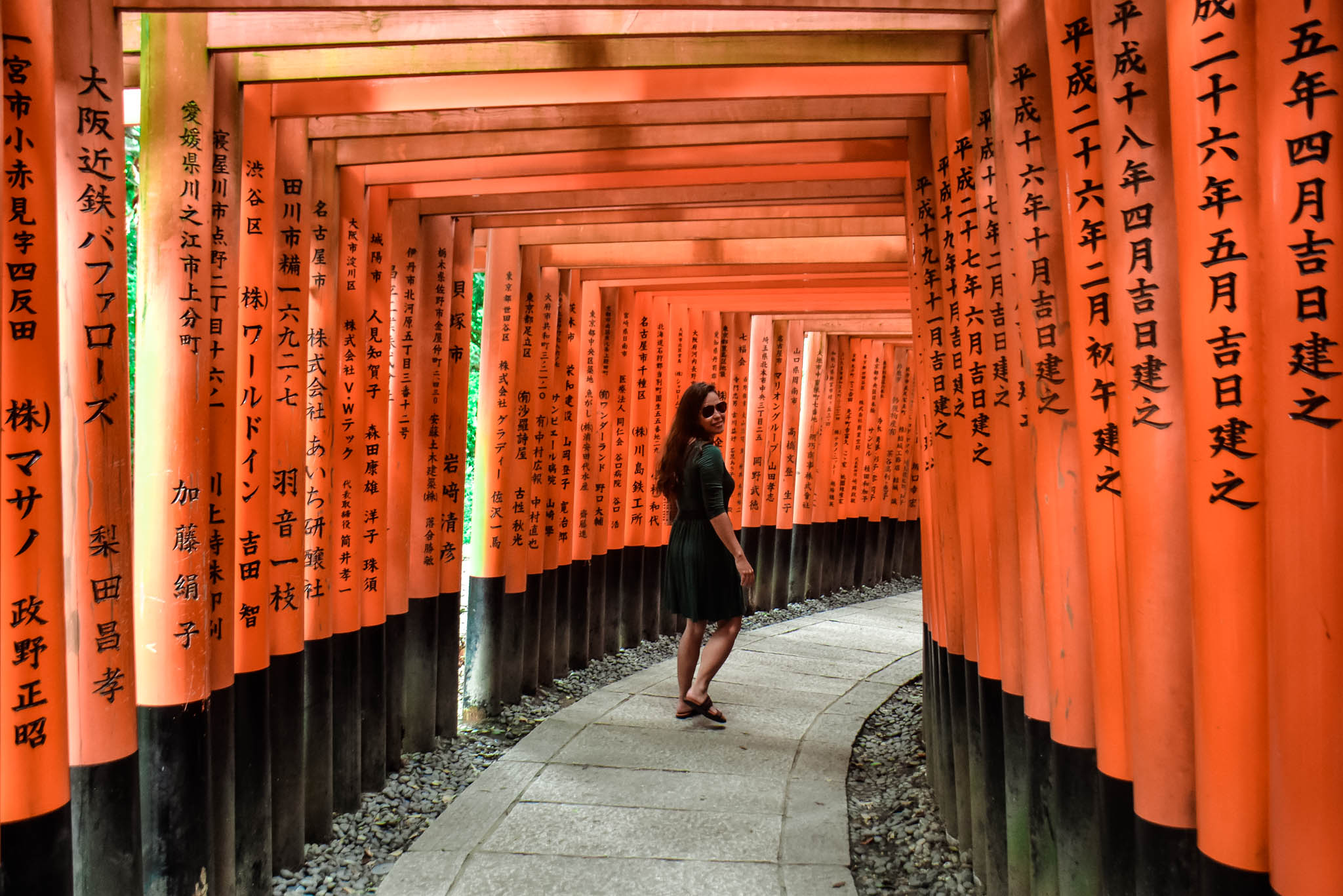
KYOTO SIGHTSEEING TOUR
If you are not keen on commuting and doing a DIY tour of Kyoto, you can book a Kyoto Morning Tour here . The tour includes a visit to Nijo Castle, Kinkaku-ji Temple, Kyoto Imperial Palace and Kitano-tenmangu Shrine. You can also BOOK A KYOTO AFTERNOON TOUR HERE
KIMONO RENTAL
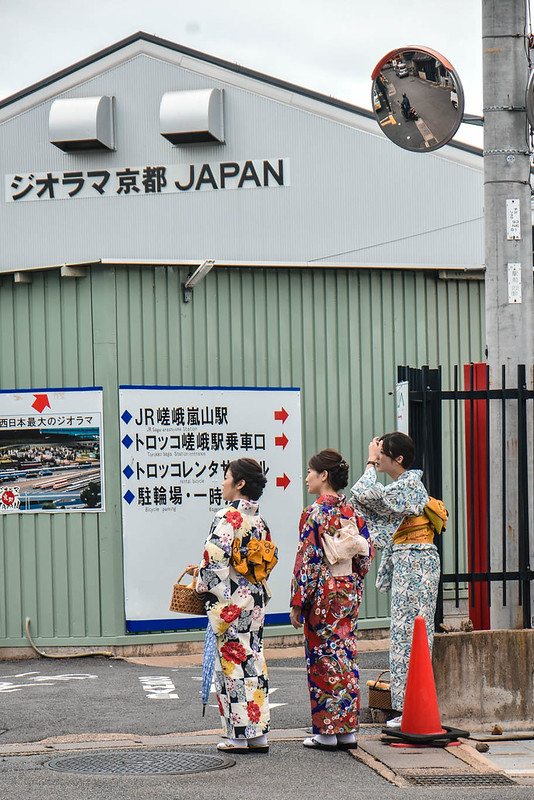
Many foreign tourists visiting Kyoto like to dress up in Kimono while traveling around famous destinations in Kyoto. You can RENT KIMONO HERE
That’s the cheapest rate I’ve seen.
KYOTO, JAPAN DIY TOUR
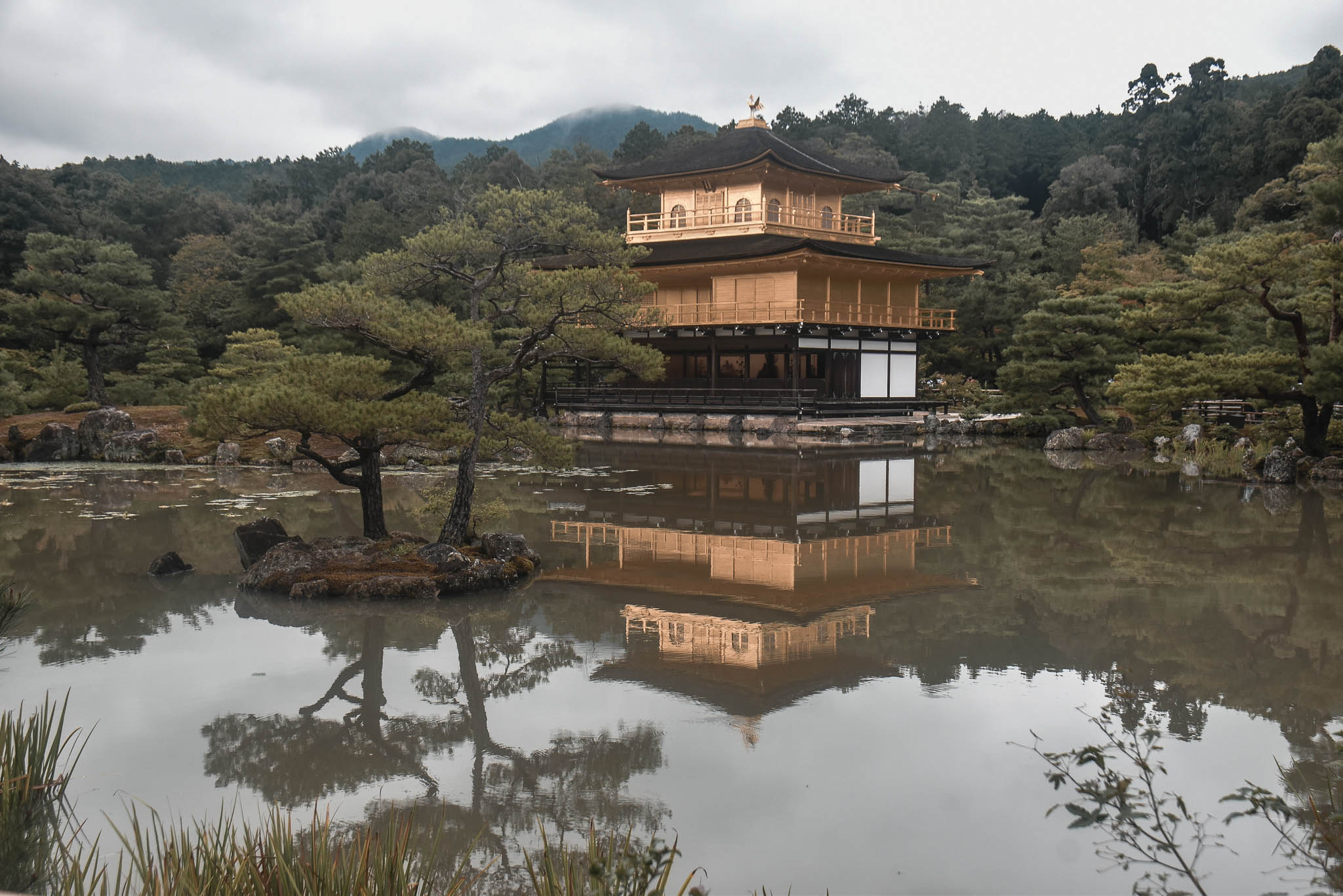
TOP ATTRACTIONS IN KYOTO, JAPAN FOR FIRST TIMERS
Kyoto is the cradle of Japanese culture, exploring this charming city is like walking back in time. The city is blissfully dappled with ancient temples and shrines, imperial palace and castles and classical Japanese gardens, all of these vying for your attention. In Kyoto, you’ll still see elderly women sporting their kimonos and geishas and miko still entertaining visitors (at exorbitant prices though). With so much to see and do in Kyoto, you’ll probably be templed out, so plan your itinerary well to balance the visit to shrines, temples and museums and shopping at traditional shops (see my sample Kyoto itinerary and guide below).
Here are some of the top attractions for first-timers in Kyoto. When planning your Kyoto itinerary, it is important to take note that most of Kyotos sights are spread out over the following district. For a detailed guide on how to get to Kyoto top attractions, read my blog here: TOP ATTRACTIONS IN KYOTO, JAPAN and HOW TO GET THERE.
CENTRAL KYOTO
Central Kyoto is the business hub of Kyoto City, this is where most of the hotels are concentrated. But it is also home to Toji (one of the oldest city temples), the Kyoto Imperial Palace and Nijo-jo Castle, former abode of the Tokugawa shoguns.
Kyoto Station
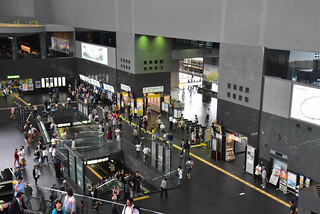
Kyoto Tower
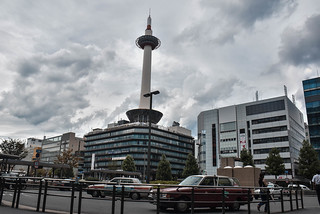
Nijo-jo Castle
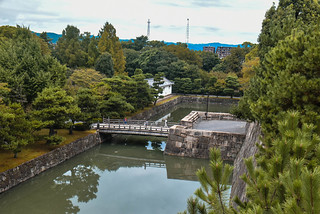
Kyoto Imperial Palace
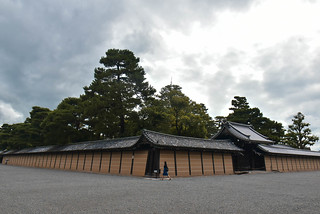
Kyoto Manga Museum
SOUTHERN KYOTO
Southern Kyoto is made up mostly of the Kyoto ancient capital, this is where you head to get to the poular Fushimi Inari Shrine.
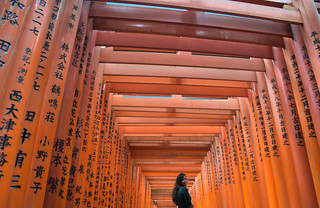
Tofukuji Temple
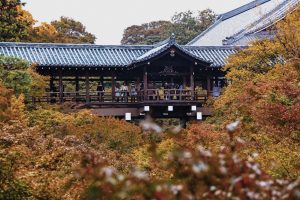
NORTHERN KYOTO
Most of Kyoto’s interesting century-old shrines and temples can be found here including UNESCO World heritage Sites. This is where you’ll find Kinkakuji (Golden Pavilion), Ryoanji temple, Ninnaji Temple and Kamo Shrines, among others.
Kinkakuji Temple (Golden Pavilion)
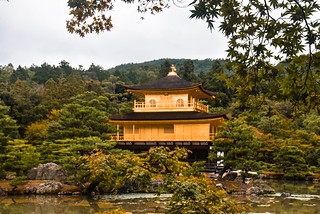
Ninnaji Temple
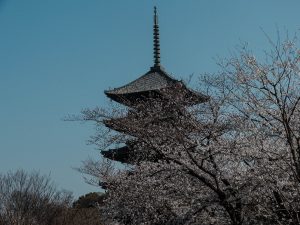
EASTERN KYOTO (Higashiyama)
Care to see geishas and miko that still entertain? Head to Gion District in Eastern Kyoto, but prepare your wallet as prices are ridiculously expensive here. If you cannot afford a tea ceremony with the geishas at one of the traditional tea houses here, you can dine instead at one of the many restaurants sprinkled in Gion. Interestingly, Gion is an entertainment district by night and a traditional shopping neighborhood by day.
Eastern Kyoto is also dappled with popular temples and shrines such as Kiyomizu-dera temple, Ginkaku-ji (Silver Pavilion) and Philosopher’s Path.
Higayashima District
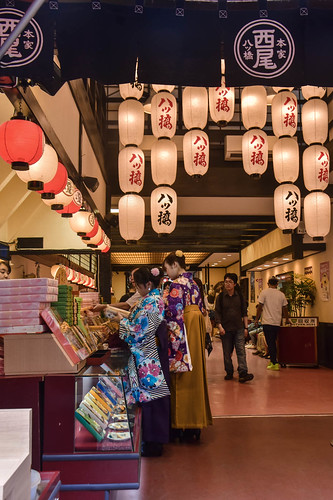
Kiyomizudera
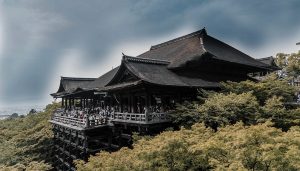
Ginkakuji (Silver Pavilion)

Philosopher’s Path
Western kyoto (arashiyama).
One of my favorite district in Kyoto is Arayashima, I could spend one day exploring this district alone with beautiful Bamboo Forest and temples and shrines hidden in forest-fringed mountains. Just avoid the holidays and weekends because it can get pretty crowded.
Arashiyama Bamboo Forest
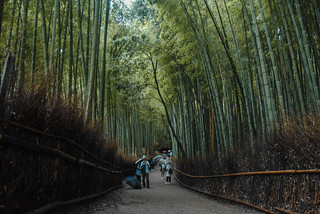
Sagano Railway
ALSO READ:
Top attractions in kyoto, japan and how to get there, where to stay in kyoto.
When in Kyoto, I like staying near Kyoto Station because public transport is readily accessible. Here are some of the best hotels and hostels you can find near Kyoto Train Station.
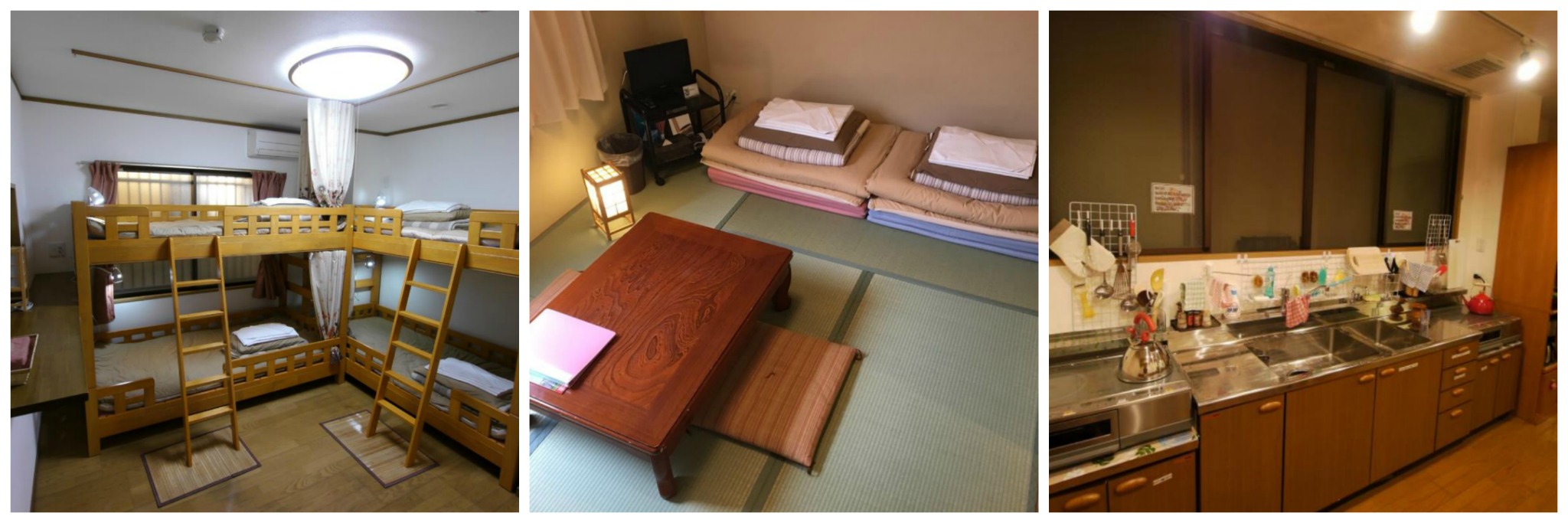
CHECK ROOM RATES HERE

WHERE TO EAT IN KYOTO

Kyoto like Osaka is a foodie haven, boasting more or less 174 Michelin star Restaurant, but your wallet must be well-endowed if you want to try them as the dishes usually start at PHP 6,306 / JPY 14,000 / USD 126.
Kyoto is well-known for kaiseke (huate cuisine), a traditional multi-course Japanese meal that has been around for over 500 years. There are a lot of restaurants in Kyoto to try this, some have Michelin star ratings.
Because we didn’t really have much time, we just dined at restaurants near the attractions we are visiting.
If you are on a budget, your best bet is “tachi-kui” (stand-and-eat restaurants) scattered along downtown Kyoto and train stations. My friend Marky and I tried one near our hostel, but because we were lazy, we opted to sit. The food is as cheap as those sold at Lawsons or 7 Eleven.
Nishiki Market
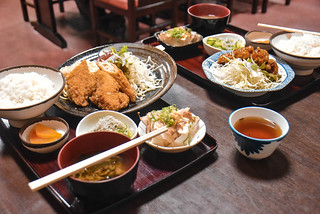
If you are craving for ramen like us, rush to the 10 th floor of Kyoto Station where the Kyoto Ramen Street (Kyoto Ramen Koji) is located. This is where you’ll find cheap eats in Kyoto and restaurants serving ramen. To order ramen, you need to use the vending machine in front of the café/ resto to pick the ramen that you want. Don’t worry as there are food pictures and English button. Then, once you have your ticket, hand it to the restaurant staff. Honestly though, the ramen that we tried at one of the ramen place here didn’t really work for me.
Eat Paradise at the 11th floor of Kyoto Station has a wide selection of restaurants to choose from, serving moderate to expensive meals.
Gion District
If you want to taste traditional Japanese dishes in a traditional setting, head to Gion District. This place is oozing with restaurants serving Japanese dishes.
Fushimi Inari Shrine
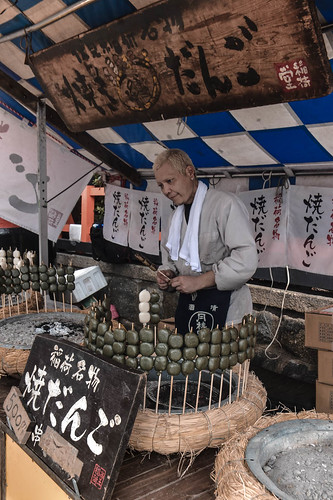
Fushimi Inari Shrine is peppered with food stalls selling different kinds of Japanese street food.
Hatakaku Restaurant
Hatakaku Restaurant invented “botan nabe”(wild boar hot pot stew), a popular dish in the mountainous area of Japan where wild boars are pretty common. To make this dish, wild boar meat is thinly sliced and arranged like a peony flower (botan) on a plate. However, it is only served around November to March during winter season when the wild boar meat is available. Prepare around JPY 10,000 for this dish, so best to tag some friends along so you can share the cost. The restaurant is just north of the Kyoto Imperial Palace.
JIKU KAPPO SARA
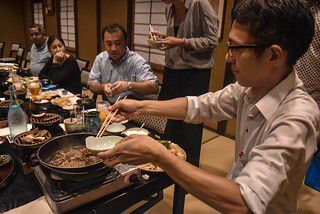
We also got to try the famous Omi Beef , one of the best beef in Japan, along with Kobe Beef and Matsusaka Beef, at Yasu-shi in Shiga prefecture, about 30 minutes away from Kyoto. It’s really a must-try when in Japan! We dined at a restaurant called Jiku Kappo Sara where they have a special set of Omi Beef Steak that comes with Omi beef steak, sushi, sashimi, tempura, Omi-rice and miso soup for JPY 4, 600 (PHP 2,143 /USD 44) or you can order their middle set meals for JPY 3,900 (PH 1,817) without the sushi and sashimi.
KYOTO SAMPLE ITINERARY
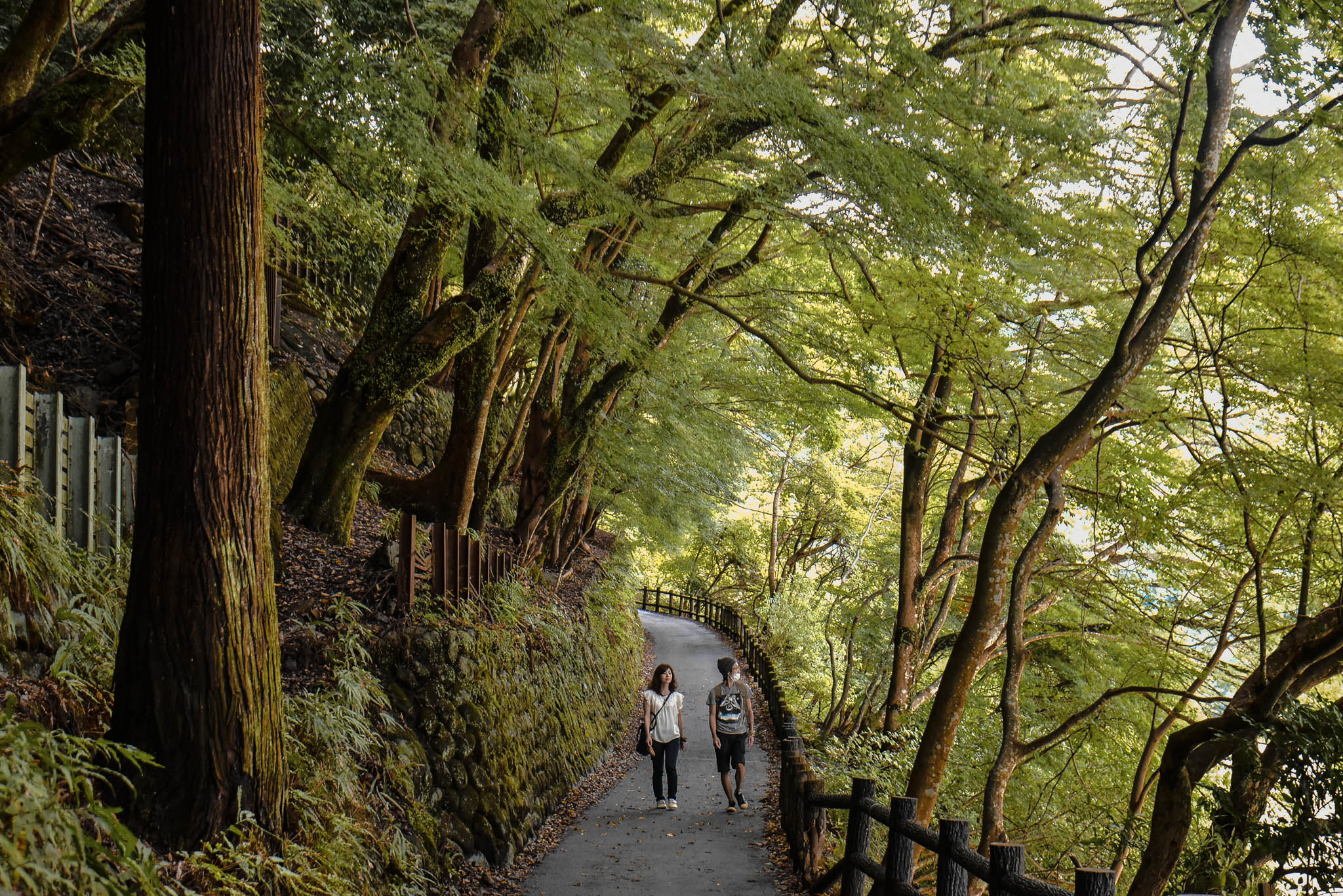
This Kyoto travel guide won’t be complete without the sample Kyoto trip itinerary. Here’s my sample 3 day itinerary for Kyoto, Japan, feel free to make adjustments depending on your travel schedule and budget. Also, do note that before heading to Kyoto, we already explored Osaka. If you spend 2-3 days in Kyoto, it will give you time to explore the usual top attractions in Kyoto for first-timers . After Kyoto, you can also do Nara or Kobe, but we opted to go to Nara after. Will be writing a detailed Nara Travel Guide soon.
KYOTO TRIP BUDGET
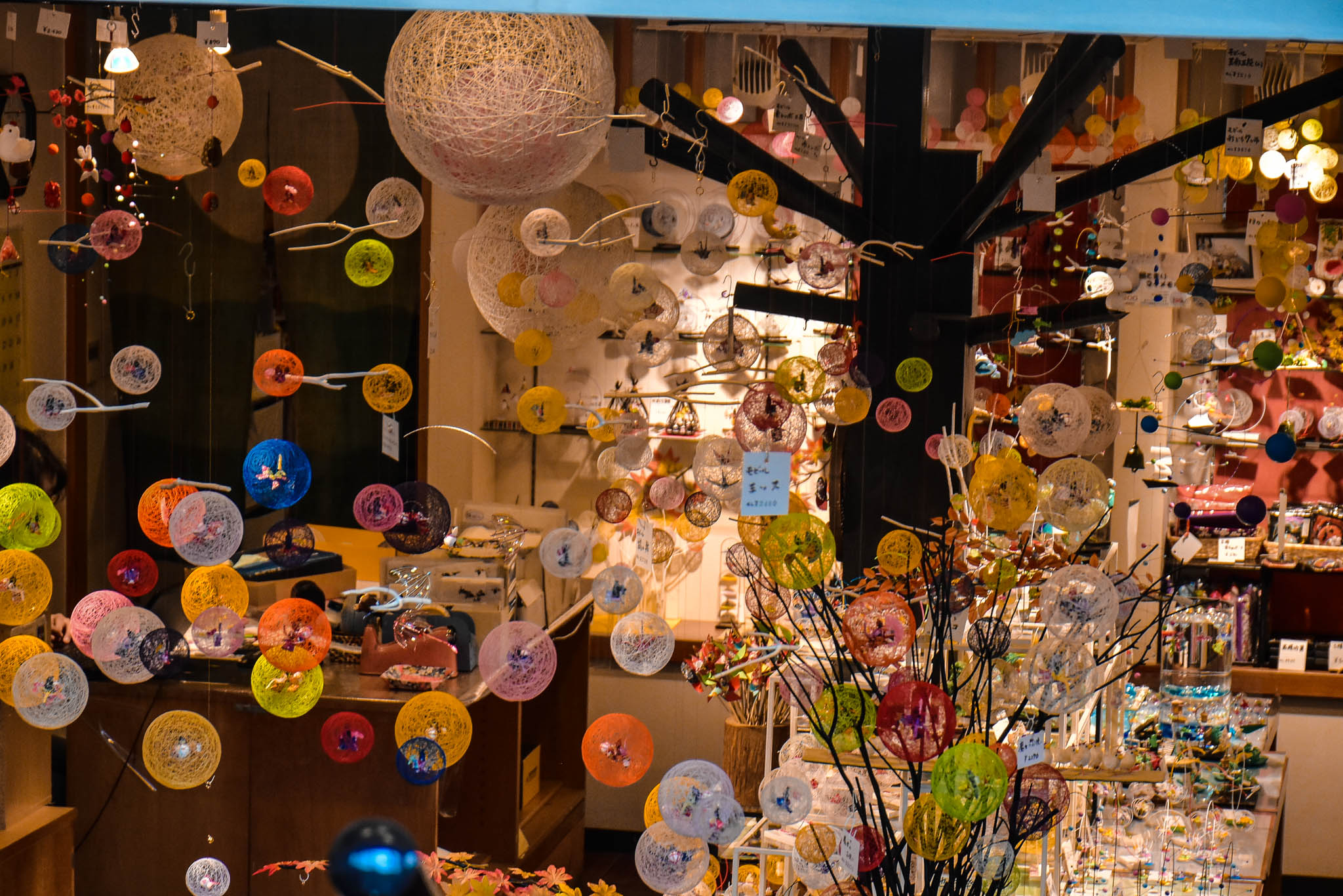
To help guide you in planning your trip to Kyoto, here’s a sample breakdown of expenses for a 3 day budget trip in Kyoto, to give you a rough estimate of how much to spend while in Kyoto. Budget for Kyoto is tricky as it will also depend on how much you spend on food and accommodation. Japan is not as expensive as I thought, as you can see from the expenses breakdown below, it is manageable.
NARA TRAVEL BLOG (Budget + Itinerary)
Osaka travel guide, nagoya travel guide (budget +itinerary), sapporo travel guide, nagoya itinerary + central japan, tokyo tourist spots, shirakawa-go from kyoto, hakuba ski travel guide, fukuoka travel guide (itinerary + budget), related posts.

PUERTO GALERA ITINERARY (TRAVEL GUIDE + BUDGET) 2024
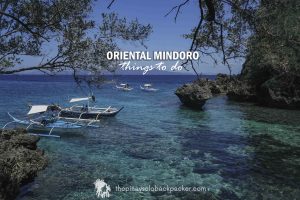
ORIENTAL MINDORO: Things to Do in Puerto Galera + Itinerary 2024
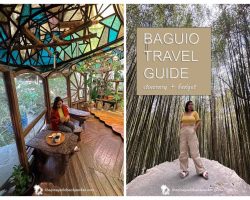
BAGUIO TRAVEL GUIDE (ITINERARY + BUDGET) (2024)

2024 LILIW TOURIST SPOTS + ITINERARY
Hi! I’m travelling to Kyoto soon with my senior citizen parents. I’ve been to Kyoto before and I know there’s a lot of walking involved to get to one place to another. I’m interested in the BUS DAY TOUR. I think this will be the most comfortable for them to go around Kyoto. I tried the link that you mentioned but got directed to a different offering – Hankyu Tourist Pass. Or is it right? I’m a little confused. Hope you can help me with this. Thank you!
Salamat! Ang dami kong nalaman!
Thanks for sharing . I really enjoyed reading you blogs. Hope i can go to Japan too and visits some of their famous landmarks.
Hi Grace, you can do it too! 🙂
What an amazing and a fascinating place to visit. I really didn’t know much about this but after reading this post I will surely visit one day. Thanks for sharing such an amazing post.
Submit a Comment Cancel reply
Your email address will not be published. Required fields are marked *
- BEACH RESORTS
- BORDER CROSSING BY BUS
- Cruise Guide
- FERRY SCHEDULE AND RATES
- General Santos
- Historical Sites
- Hotels and Resorts
- Shiragawago
- SHIRAKAWA-GO
- Cameron Highlands
- Kota Kinabalu
- Kuala Lumpur
- New Zealand
- Cagayan North
- Camarines Norte
- Caramoan Island
- Catanduanes
- Davao del Sur
- Ilocos Norte
- Lanao del Norte
- Kalanggaman
- Mindoro Occidental
- Puerto Galera
- Negros Oriental
- Nueva Ecija
- SAN TEODORO
- Puerto Princesa
- San Vicente
- Quezon Province
- Northern Samar
- Surigao del Norte
- Surigao del Sur
- Capones island
- Zamboanga City
- Zamboanga del Norte
- Solo Female Travel 101
- South Cotabato
- Star Cruises
- Kanchanaburi
- Tourist Spots
- Travel Apps
- Travel Gadget
- TRAVEL GADGETS
- Travel Guide
- TRAVEL REQUIREMENTS
- Uncategorized
- UNESCO World Heritage Site
- HO CHI MINH CITY
COPYRIGHT NOTICE:
Terms of use:.

- Privacy Overview
- Strictly Necessary Cookies
This website uses cookies so that we can provide you with the best user experience possible. Cookie information is stored in your browser and performs functions such as recognising you when you return to our website and helping our team to understand which sections of the website you find most interesting and useful.
Strictly Necessary Cookie should be enabled at all times so that we can save your preferences for cookie settings.
If you disable this cookie, we will not be able to save your preferences. This means that every time you visit this website you will need to enable or disable cookies again.

Girl Eat World
A girl's adventure in food and travel around the world, kyoto travel guide for first-time visitors: what to see and eat in kyoto.
Recently, I had the opportunity to revisit Kyoto again, for the third time. I visited Kyoto for the first time during Sakura (Spring) season, then again in Momiji (Fall) season, before coming back during the pandemic when there weren’t any international tourists in Japan .
Needless to say, I feel like I’ve seen Kyoto at its best times and I can’t wait to share everything I know about Kyoto with you!
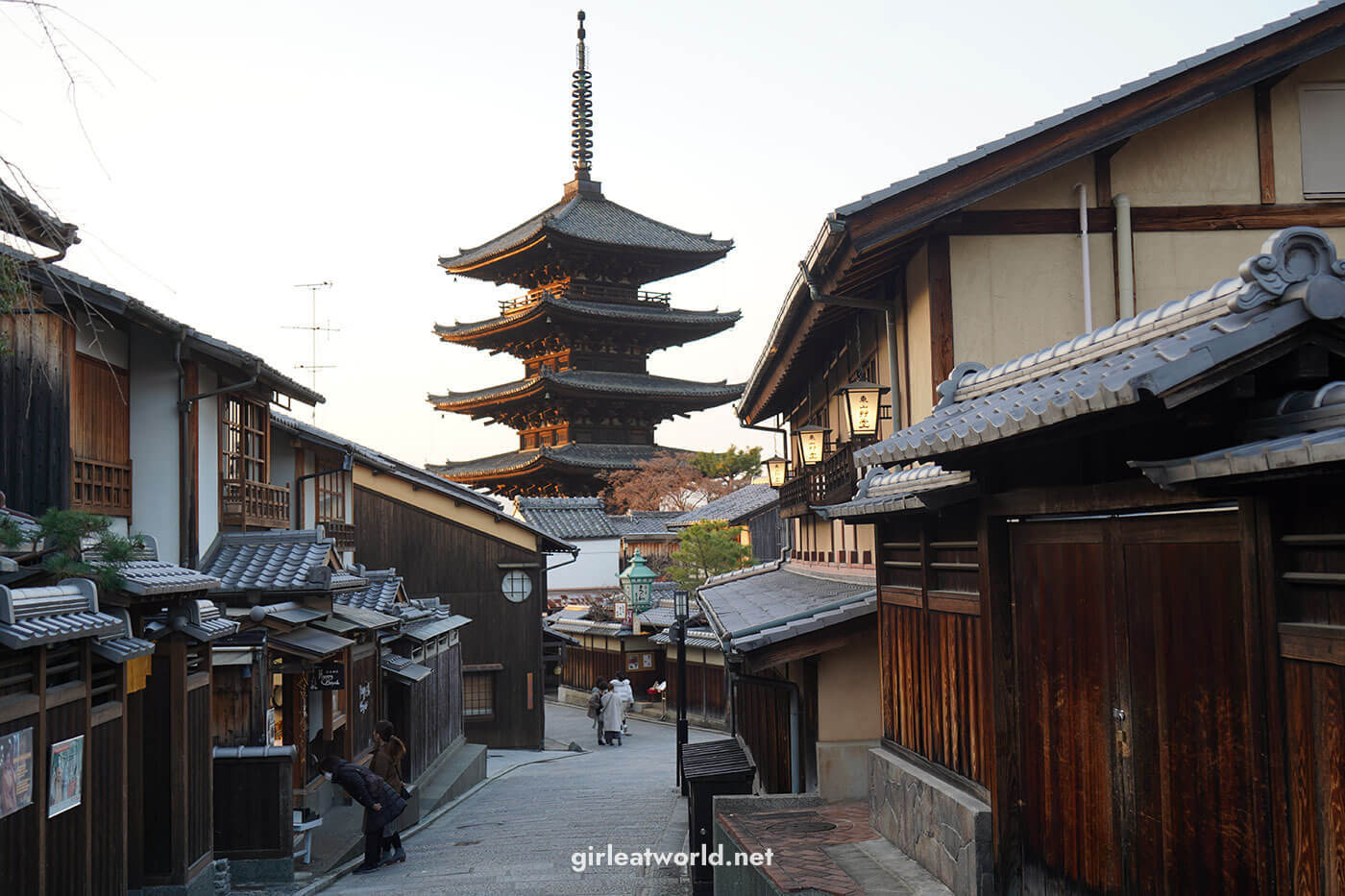
- How to get to Kyoto
How many days should I spend in Kyoto?
When is the best time to visit kyoto.
- Where should I stay in Kyoto?
How can I get around Kyoto?
- Can I store my luggage in Kyoto?
- What are the must-do things in Kyoto?
- What and where to eat in Kyoto
How can I get to Kyoto?
First things first, let’s cover the ways you can get to Kyoto. Kyoto is located in Kansai, south of Honshu, Japan’s main region. It is around 500km south of Tokyo . Here is how you can get to Kyoto:
1. Fly into KIX, then take the Haruka Airport Express
As a foreign visitor, the best and fastest way to get to Kyoto is to fly into Kansai International Airport (KIX) and take the train to Kyoto, going through Osaka. From KIX to Osaka, it only takes about 50 minutes by Haruka airport express train and then another 15 minutes to Kyoto and slightly longer if you take the local train, perhaps 30 minutes.
(In fact, Osaka is a great base for your trip if you’re interested in exploring other things in Kansai aside from Kyoto, as I have outlined here )
You can purchase Haruka airport express train ticket here , or if you already have a JR pass, then you can use your JR pass (assuming you bought Unlimited JR Pass ).
2. Take the Shinkansen, Japan’s ultra-fast bullet train
The price of Unlimited JR Pass has increased by 70% since 1 Oct 2023 . Even though you’ll see many recommendations for buying a JR Pass to save some costs, it could be outdated. Since the price hike, it has become harder to justify the cost of the JR Pass, however regional passes like the JR West Kansai Pass might still be worth it. I am working on updating my blog post to reflect this change.
If you’re thinking of making Kyoto one of your stops on a long trip to Japan, it’s very possible to take Shinkansen. From Tokyo, it will take only 2.5 hours to reach Kyoto by Shinkansen. Just make sure you’ve purchased a JR Pass that covers both areas, in this case, if you’re traveling from Tokyo to Osaka / Kyoto then you’d probably want the Unlimited JR Pass .
The Shinkansen conveniently drops you off at the main Kyoto / Osaka station (depending on where you’ve decided to base yourself – I’ve written about that here ), and from there you’ll be able to take local trains to wherever you need to go.
You should be able to see most things you want to see in Kyoto in 2 days , but it really depends on your travel style. If you wake up early and are okay with going around the entire day til night time, then 2 days is good.
However, if you prefer to take things slow, you could allocate more days. You can see the list of things to do in Kyoto below, where I outline my recommended places to visit and decide for yourself!
Without a doubt, the best time to visit Kyoto (and many other parts of Japan) is during Sakura time or Momiji time . You can click on the links to determine the best times as it varies every year.
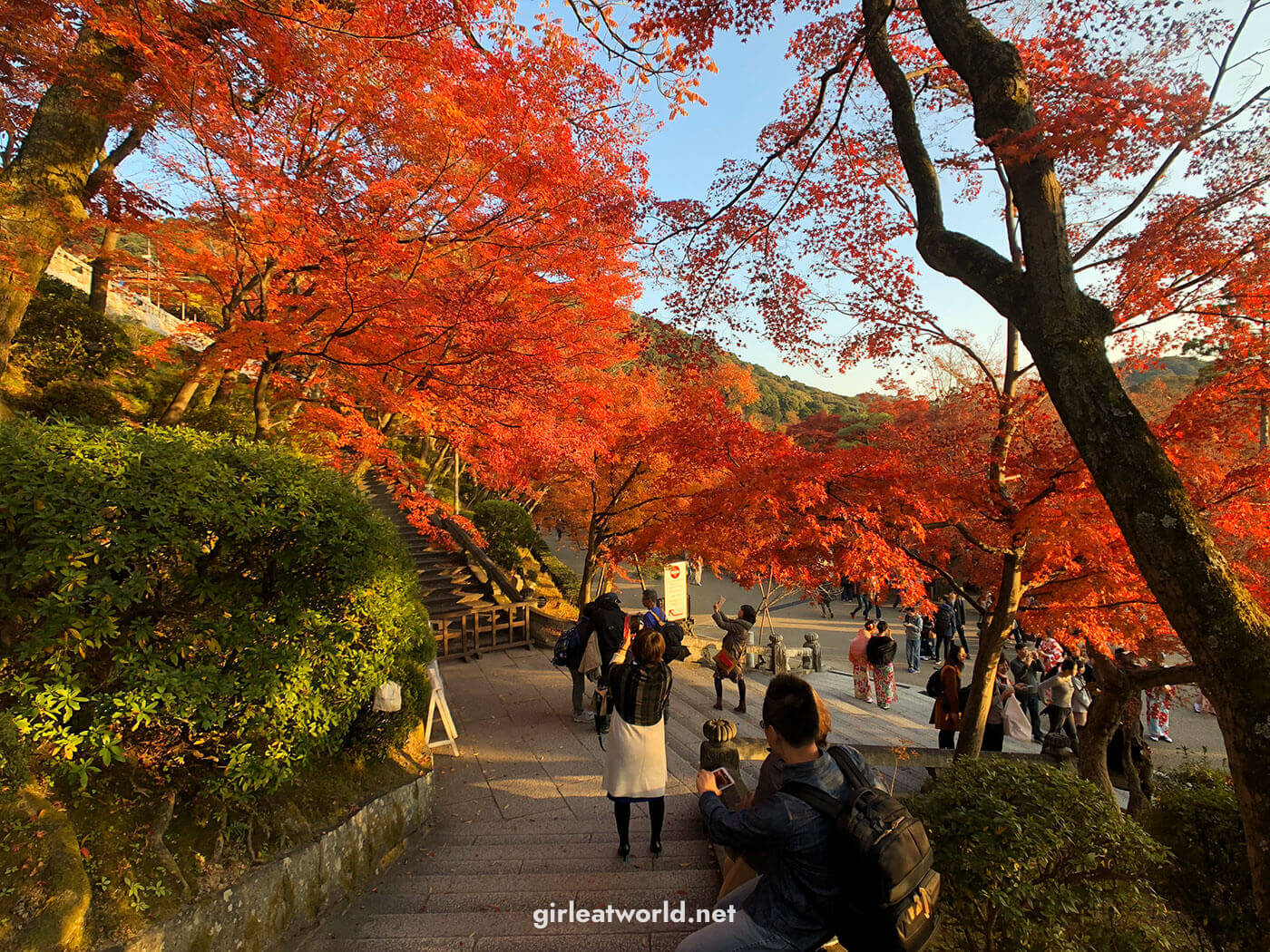
Kyoto (and all of Japan) is just insanely beautiful during these two seasons. However, they are also probably the most popular time to visit Kyoto, so expect a lot of crowds.
Avoid golden week which is the first week of May and Obon in middle of August, as these two are big holidays in Japan. You’ll not only have to battle the international tourists that are coming to Japan, but domestic Japanese tourists too!
Where should I stay when visiting Kyoto?
As I said before, I believe that Osaka , not Kyoto, is a better place to base yourself especially if you’re interested in exploring other things in Kansai, as I have outlined in my Kansai itinerary post .
This is my preference for many reasons:
- Accommodations in Osaka are more diverse and affordable. Kyoto on the other hand is seen as a luxury place to stay. You’ll be expected to pay a luxury price too!
- It only takes 15 minutes to Kyoto by Shinkansen (which you’d be using if you have a JR pass) or 30 minutes by local train.
- Kyoto gets pretty quiet (read: dead) by nighttime, whereas Osaka is the second largest city in Japan so you’ll still find plenty to do at night.
- Osaka is a great base if you’re exploring other areas in Kansai , since it’s located right in the middle of everything.
➡️ If you want to know where you can stay in Osaka, click on my Osaka travel guide .
Accommodations in Kyoto
That said, I understand that some people prefer the quaintness and quiet of Kyoto, so here are some good places you can consider. Just be mindful that they would be on the more expensive side!
- Yadoya Manjiro – If you want the true Japanese experience, you’d want to stay in a ryokan (traditional Japanese inn). Yadoya Manjiro is located a stone-throw away from Kiyomizu-dera, making it extremely convenient to explore the quiet old streets of Kyoto at night, once other tourists have left Kyoto.
- Kyoto Higashiyamaso – Another ryokan in the same area as Yadoya Manjiro. You really can’t beat the location!
- Kyoto River-view House Kyoraku – with rooms starting from US$70 a night, this is probably one of the most affordable options in Kyoto. It is located in the more modern part of Kyoto closer to the main station, but still within walking distance of the old Kyoto part.
Okay, now that we’ve covered the basics. How can we get around Kyoto? There are a few ways:
1. Using local train and bus
As with most cities in Japan, Kyoto’s public transport is top-notch. You can easily use Google Maps to chart out how to get from point A to point B with public transport in Kyoto.
I highly suggest getting a train card (IC card) if you plan to use public transport. It just makes everything so much easier, since you don’t need to buy a ticket for every journey – you just have to tap the card in and out of the station. The local train card is called ICOCA in Kansai, but if you have Suica or Pasmo from Kanto / Tokyo (or IC card from other regions), those should work here too.
Good news for iPhone users – the IC cards have gone virtual and you can use your phone as an IC card! This makes everything even more convenient, as you can refill the balance via your phone without having to go to the station. Note that you do not need to buy a physical IC card to do this , just start the process straight from your phone!
Virtual IC Card: Read up on how to travel in Japan without a physical IC Card here !
2. Renting a Bicycle
One option many might not know is renting a bike. This is what I did on my first visit to Kyoto and it allowed me to see more of the city. The tourist area in Kyoto is not actually that big, so this is a very feasible option. We biked from Kyoto station to Arashiyama , and it only took about an hour with some detours.
You can rent two types of bikes:
- Regular Bikes at High Class City Bike Rental
- Electric Assist Bike Rental – If you think you’ll need some assistance from the motor so you don’t have to pedal so hard all the time!
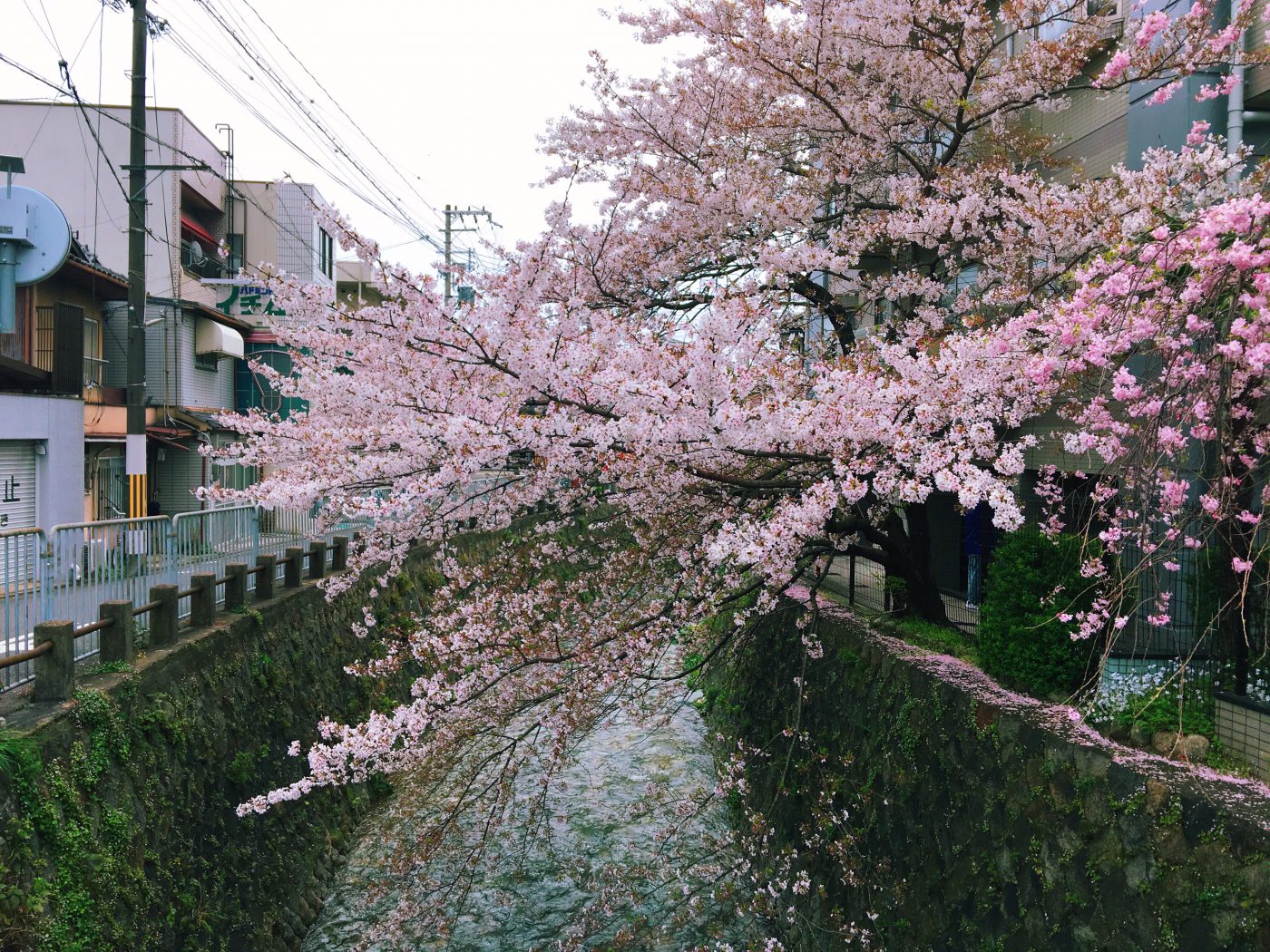
On my latest visit, we rented a car as we were traveling with a toddler. But I would say exploring Kyoto by car is not the most ideal, as the streets are quite narrow in the areas that you would want to visit as a tourist.
But the biggest issue is that parking can get really expensive in Japan. We paid 1,000 – 1,500 yen each time we parked our car, which really adds up quickly if you’re visiting multiple places in Kyoto. However, it was certainly the most convenient way when traveling with a toddler.
You can rent a car from near Kyoto station here .
Can I store my luggage at Kyoto station?
Yes!! There are plenty of coin lockers to store your luggage at the train stations in Kyoto, or any other major train stations in Japan. You can choose the size of the lockers, ranging from 300 – 700 yen. Here is a photo of what it might look like:
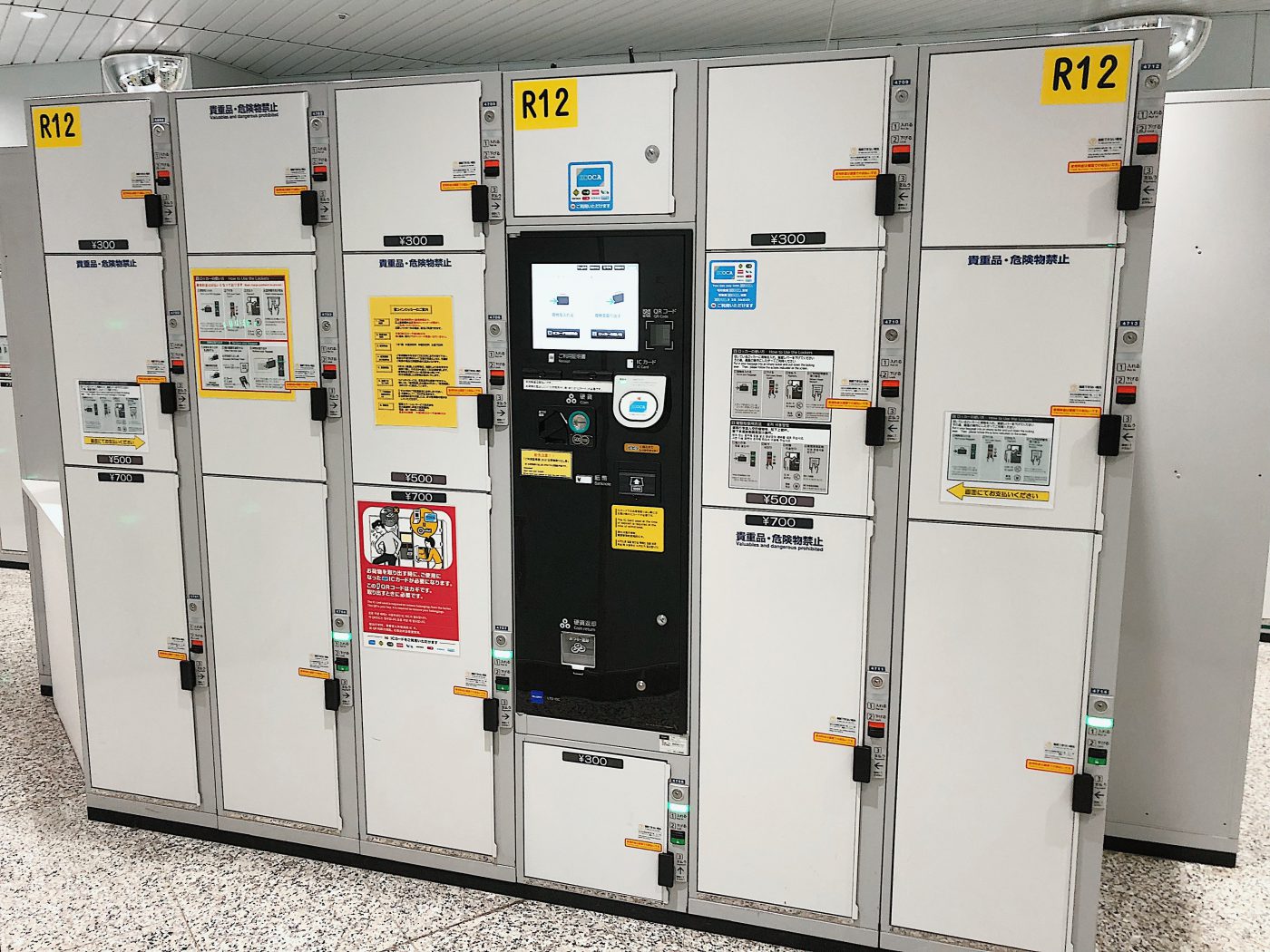
You can’t really see from the photo above, but the locker is very deep. The 300 yen option is good for backpacks (the kind you take for backpacking trips), while the 700 yen option would fit very large luggage. The 300 yen one looks small but you can definitely fit a 10kg backpack laying flat with plenty more room, so I think bigger backpacks would fit too.
Take note that the locker fee is only good to open the locker once, so if you forget something and need to take your luggage out, you’ll need to pay another set of fees. And don’t forget where your locker is located! You might want to take a photo of it just so you don’t have a hard time locating it later.
Things to do in Kyoto
Now that you know how to travel around Kyoto – you might be wondering “What are the must-do things in Kyoto?”. Well, you’ve come to the right place!
Here are some of the must-do in Kyoto:
1. See Senbon Torii (“thousands of gates”) at Fushimi Inari Taisha
When you think of Kyoto, I’m willing to bet the first thing that comes to mind is the rows upon rows of vermilion-colored torii that are so symbolic of Japan. Well, these rows of torii can be found at Fushimi Inari Taisha !
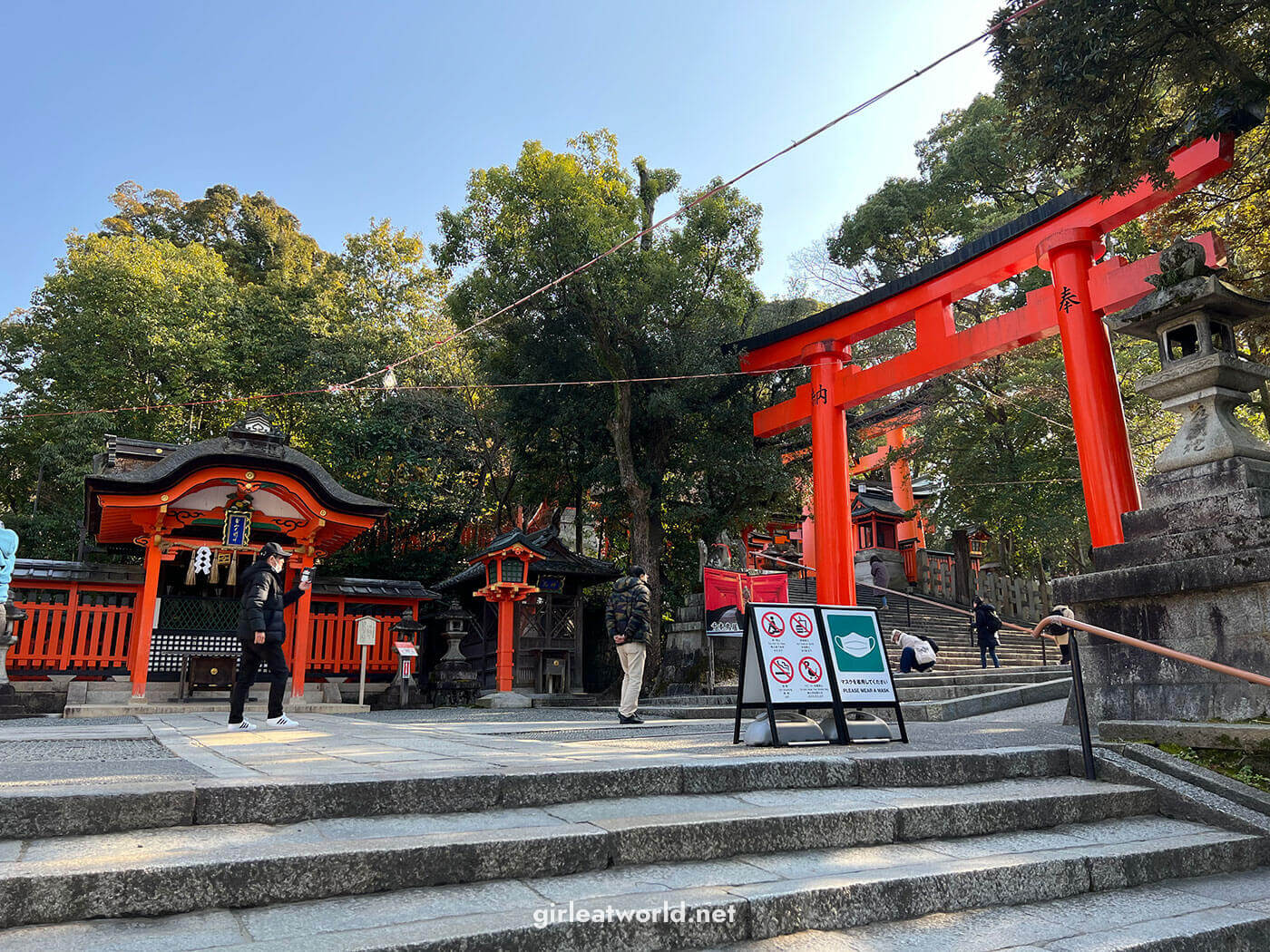
Enter the temple area and go past the shrine, then continue your hike up and you’ll see the torii soon. The rows of torii actually double up as a 5km trail up to Mount Inari. If that sounds far to you, you don’t actually have to go all the way up, you could just do a little bit of the walk and circle back.
In the three times I’ve been to Kyoto, I’ve never made it up to the top of the mountain due to time constraints, but I’ve been told the further away you go, the lesser the crowd! I would totally do it if I had the time.
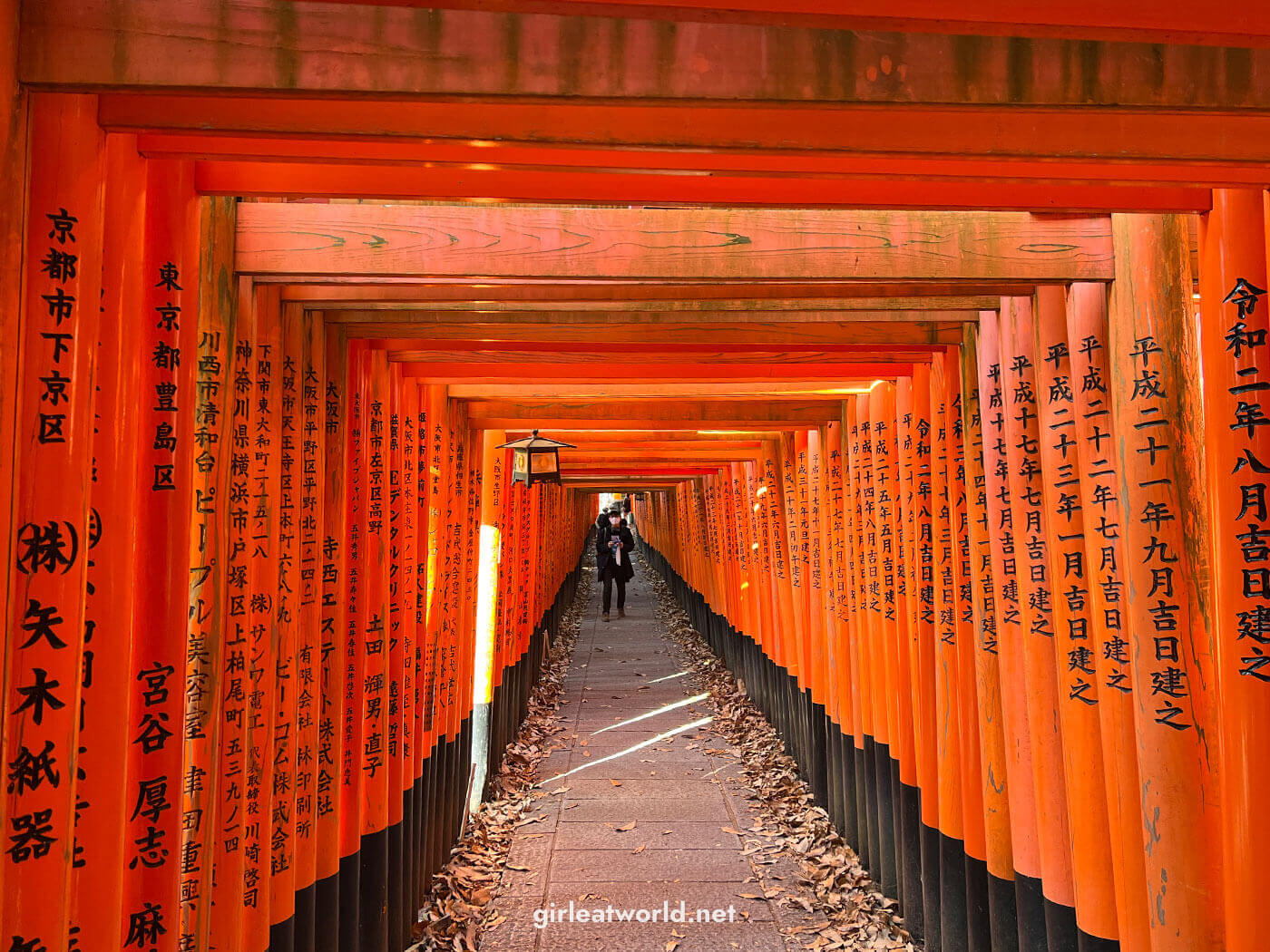
The main temple area is also worth a visit. I got this super cute Ema (wooden plaque for prayers) shaped like a torii for 800 yen. You’re supposed to write your wishes on an ema and leave it at the temple, but you could also take it home as a souvenir like I did.

Another thing you might want to do while at the temple (or any other temple in Japan) is purchase an Omamori , a small amulet containing a blessed piece of wood meant to protect you or you can gift it to your loved ones for their protection. They cost about 500-800 yen and there are different types of Omamori for different purposes – for health, giving birth, for students, etc. Most temples in Kyoto will have signs in English explaining what they are!
There is also a great lunch option nearby, at a restaurant called Kanoko . Scroll down for more info and my food recommendations in Kyoto!
2. Visit Kiyomizu-dera
Kiyomizu-dera is undoubtedly one of the most famous temples in Japan. There is a public area which you can explore for free, and then there is a ticketed area which costs 400 yen. I skipped the ticketed area on my first two visits as it was quite crowded and there was a line for entering. But I finally went in on my latest visit, and I can honestly say it is worth it.
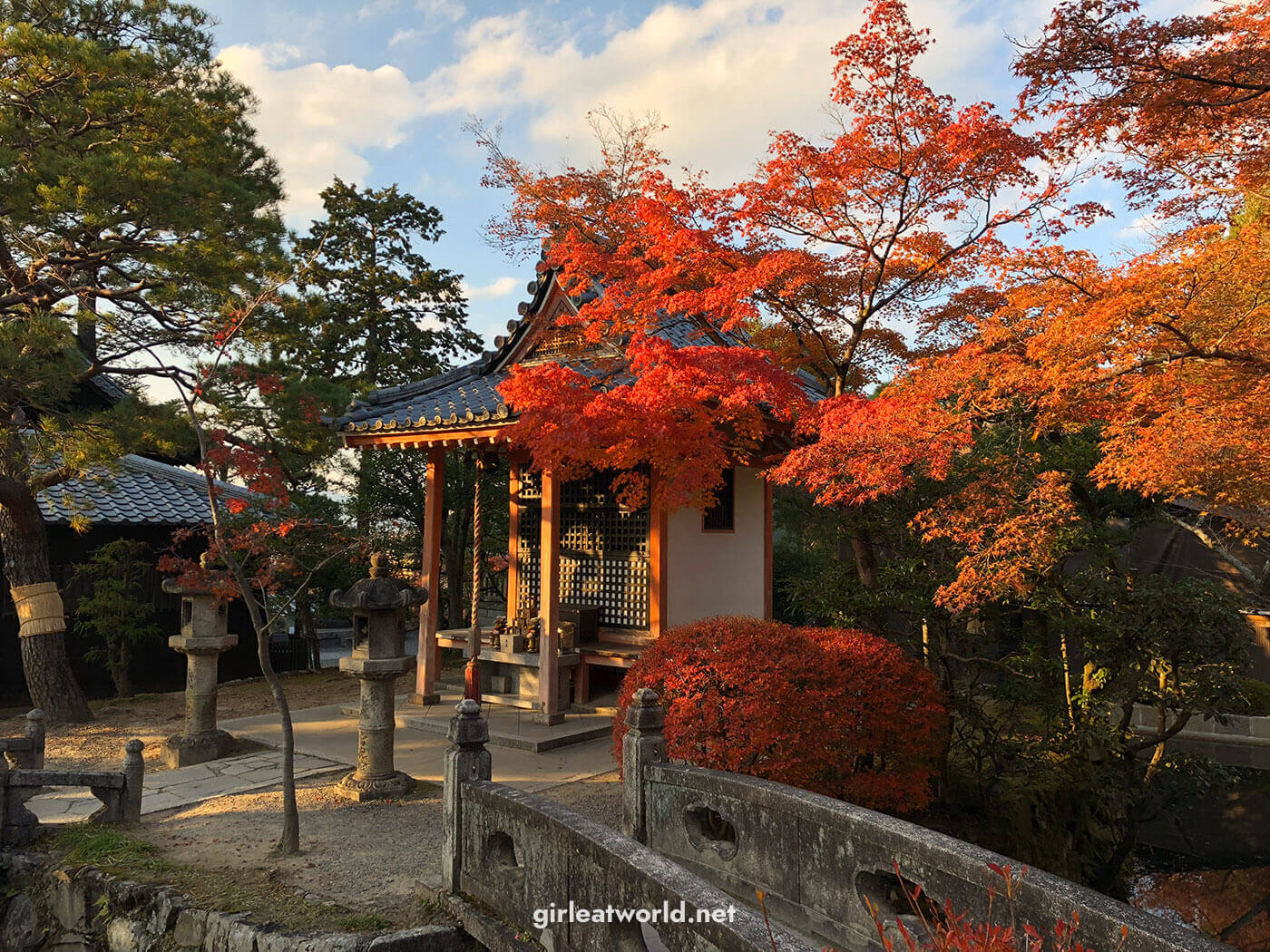
Kiyomizu-dera means “Pure water temple”. If you decide to enter the ticketed area, you can see the actual Kiyomizu-dera main hall. Take a moment to marvel at the ancient Japanese architecture, which is built on a cliff and without any nails (common for Japanese temples).

Past the main hall, you’ll be taken on a path to walk around the garden which will be so beautiful, especially during Sakura and Momiji time! There is another smaller temple for safe delivery (a common pattern with many other places in Kyoto, I noticed) where you can see the main hall from afar.
Then, at the base of the temple is Otowa waterfall , where you can take some water for drinking. The water here, as the name Kiyomizu suggests, is considered to have many fortune benefits. Next to it is a small teahouse where you can have snacks and a light lunch.

3. Stroll around Kyoto’s Higashiyama (東山) and Gion district
Kyoto is charming for its quaint old Japan look. Well, the old Japan area is mostly located in the Higashiyama district.
Higashiyama means “eastern mountain” and that’s exactly where the district is located – along the slope of the eastern mountain of Kyoto. Kiyomizu-dera is actually located in Higashiyama district, so you can combine this activity with visiting the temple.
You can expect to see quaint traditional buildings, unique souvenir shops (this is a great place to pick up something to bring back home), small ryokan (Japanese-style inn) and street food vendors. It’s a very nice area to stroll around.
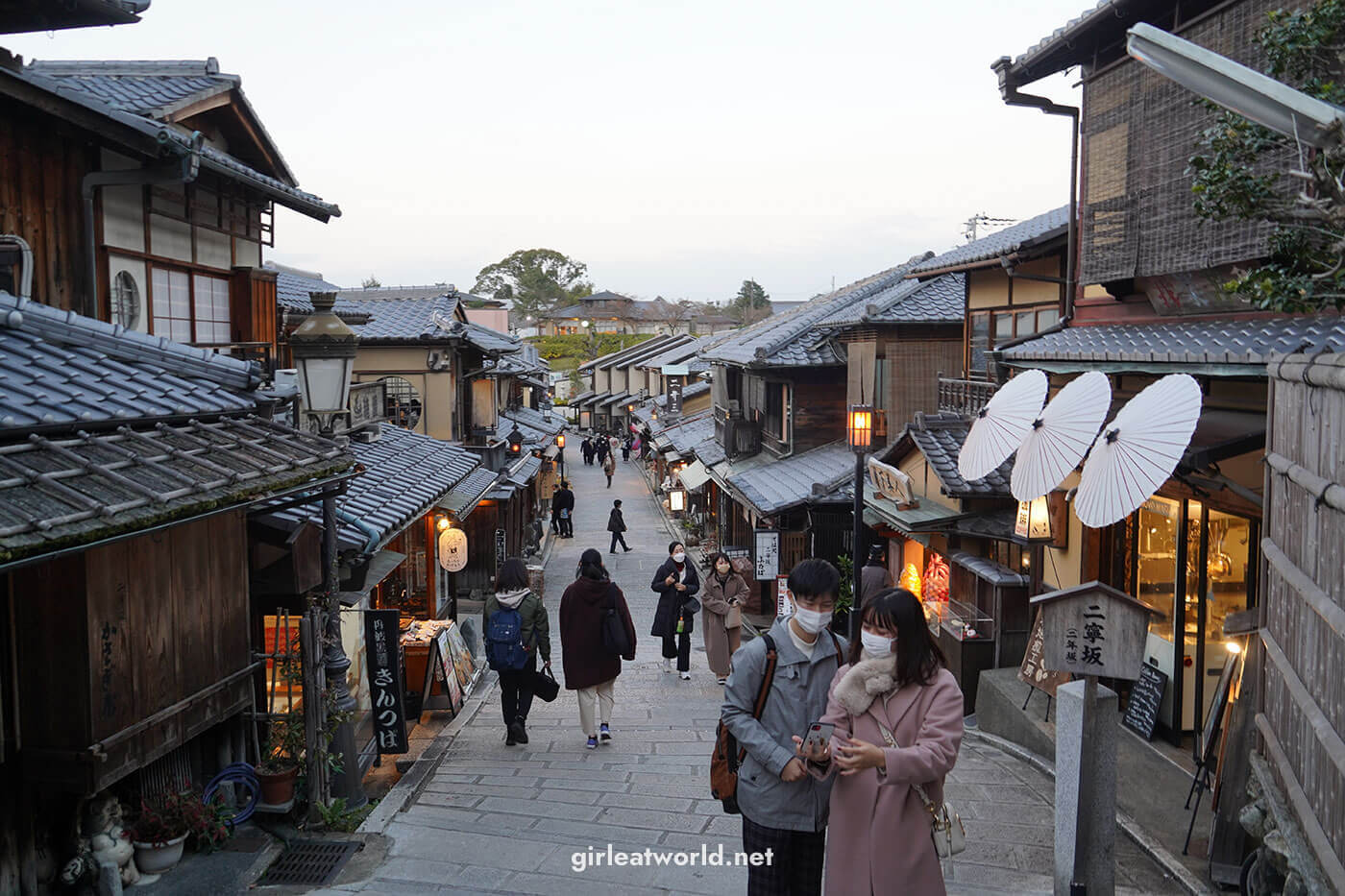
Aside from the obvious Kiyomizu-dera , there are a few places you won’t want to miss in this district:
- Ninenzaka and Sannenzaka (literally translated two year hill and three year hill) – the slopes near Kiyomizu-dera that are symbolic of Kyoto. You can find souvenir shops and street vendors in this area.
- Hidden Starbucks ( map ) – There is a Starbucks at Ninenzaka, but it’s not obvious as it does not have any of the iconic green Starbucks color. The facade of the store has been designed to fit the aesthetic of the rest of the neighborhood. Inside, you’ll find a garden on the first floor and traditional tatami seats (straw mats) on the second floor.
- Studio Ghibli store ( map ) – if you are a fan of Ghibli, and who isn’t, make sure to stop by here for a chance to bring back some souvenirs home. They have all kinds of things – from cups and utensils to stuffed toys and apparels.
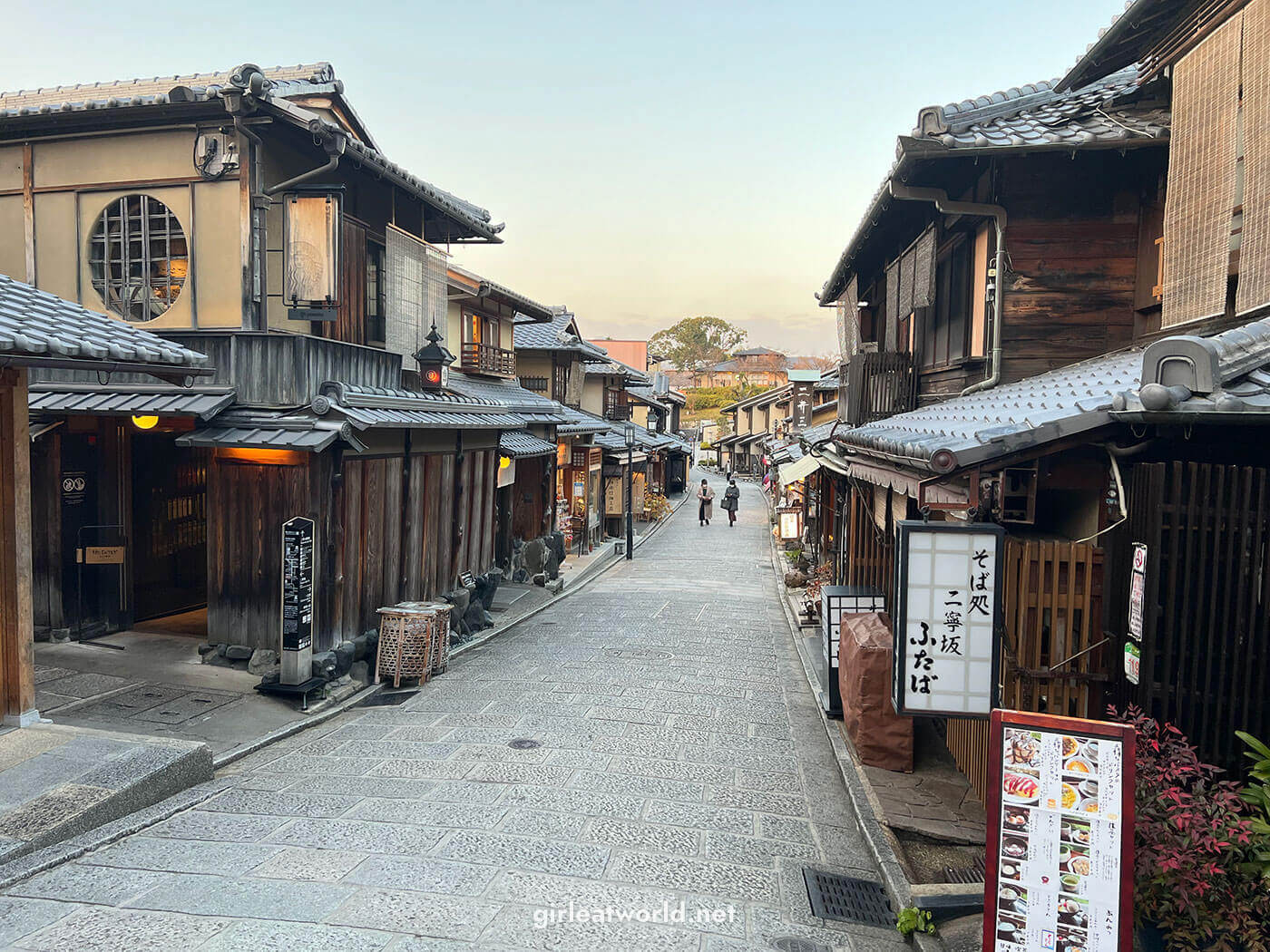
Near Higashiyama is Gion – also known as the Geisha district. Gion is not technically part of higashiyama, but it’s very close by. The district is filled with tea houses where a geisha and a maiko might be doing their job as entertainers. There are also some high-end restaurants in this area.
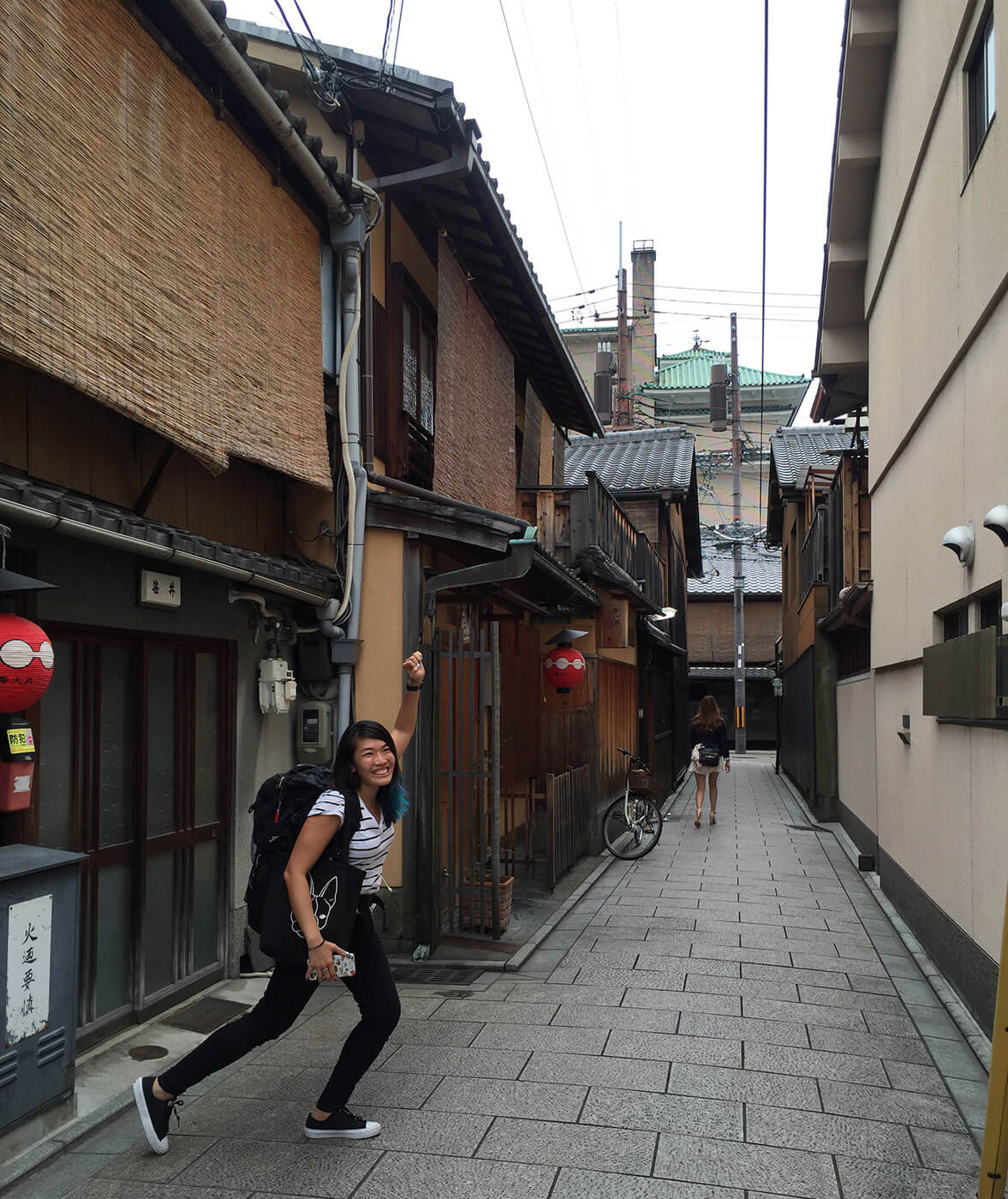
4. Take a walk at the philosopher’s path
Tetsugaku no Michi, aka Philosopher’s path is a beautiful serene path along the canal that takes you from near the old streets of Kyoto to Ginkaku-ji. The path gained its name from Kitaro Nishida, a famous philosopher from Kyoto, who would take this path as a way to meditate. It is lined with beautiful cherry blossom trees, so you definitely want to be here during Sakura season! However, it is also still a good place to visit even if it’s not Sakura season.
You can start the walk from Keiage incline, to Nanzenji, then taking your way up philosopher path before ending up at Ginkaku-ji.
5. See Ginkaku-ji and Kinkaku-ji
Yes, the names are very similar but these are two different temples, located quite a distance apart from each other! Kinkaku-ji is Temple of the Golden Pavilion, while Ginkaku-ji is Temple of the Silver Pavilion.
Kinkaku-ji is a unique-looking temple, with pure gold-leaf coating covering the top two levels the temple. Ginkaku-ji, on the other hand, was meant to be the silver version of Kinkaku-ji as the name might have indicated. However, the temple has remained “unfinished” and to this date no silver foil has been used to coat the exterior of the temple.
6. Visit Arashiyama
Another famous visual from Kyoto is the serene Arashiyama bamboo forest . There are a few entry points to get to the bamboo forest, but I usually start from this point at Google maps , and end at Kameyama Park. The bamboo forest path is not very long (probably will take you 15-30 minutes max to walk) but there are plenty to do and more temples to visit around Arashiyama too!
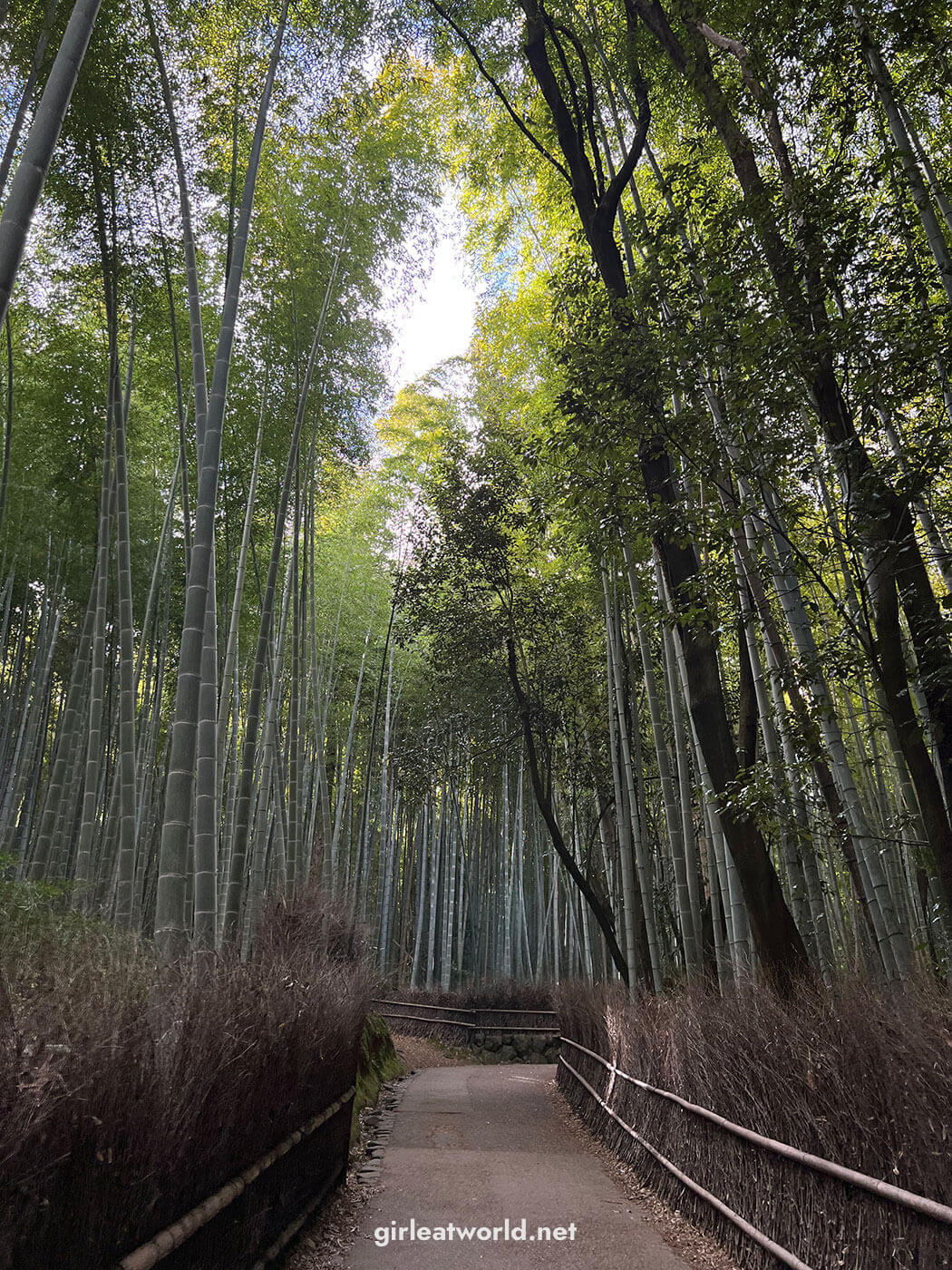
Once you’re done with the bamboo forest, take some time to explore the area too! Kameyama Park offers a tranquil walk around, and there is a trail that takes you down to Katsura River.

Once you’re done exploring, you could walk down the river to a nearby park along Katsura River, called Arashiyama Park . During Sakura time, this park is filled with cherry blossom as well as snacks you can buy. I bought a sakura ice cream here!
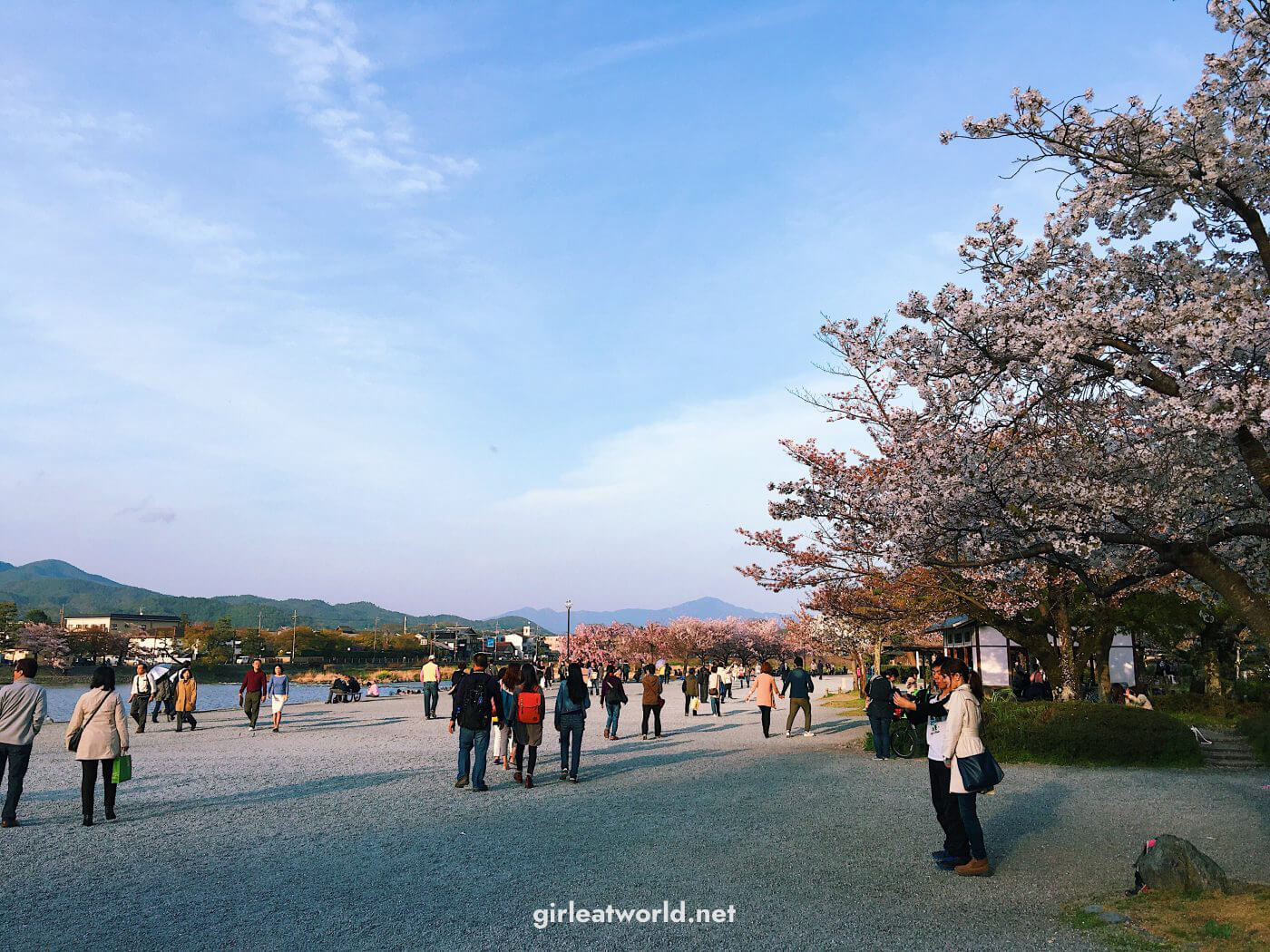
Or you can visit some temples in Arashiyama. Tenryu-ji and Seiryo-ji is the big temples nearby. Each visit would set you back 400 yen per person.

7. Take the Sagano Romantic Train (in Arashiyama)
The Sagano romantic train, aka Sagano Torokko scenic railway, starts from near Arashiyama bamboo forest and takes you to JR Kameoka station. It takes 25 minutes to complete this journey, or 50-60 minutes to do a round trip if you are not interested in exploring Kameoka.
To make things simpler, you can pre-book a ticket for Sagano Romantic Train and pick it up at the Kyoto station.
8. Dress up in traditional Japanese clothing
If you want to fully immerse yourself in the Japanese atmosphere, you might want to rent a Kimono (or Yukata if it’s summer) while you’re walking around Kyoto. I saw plenty of tourists who did this and it definitely makes for a good photo. Here is where you can rent a kimono / yukata in Kyoto near Kiyomizu-dera.
Or, if you want to take it a step further, you can take a peek into the life of a maiko and dress up as a maiko (complete with the makeup). It also comes with a photoshoot so you can remember the experience.
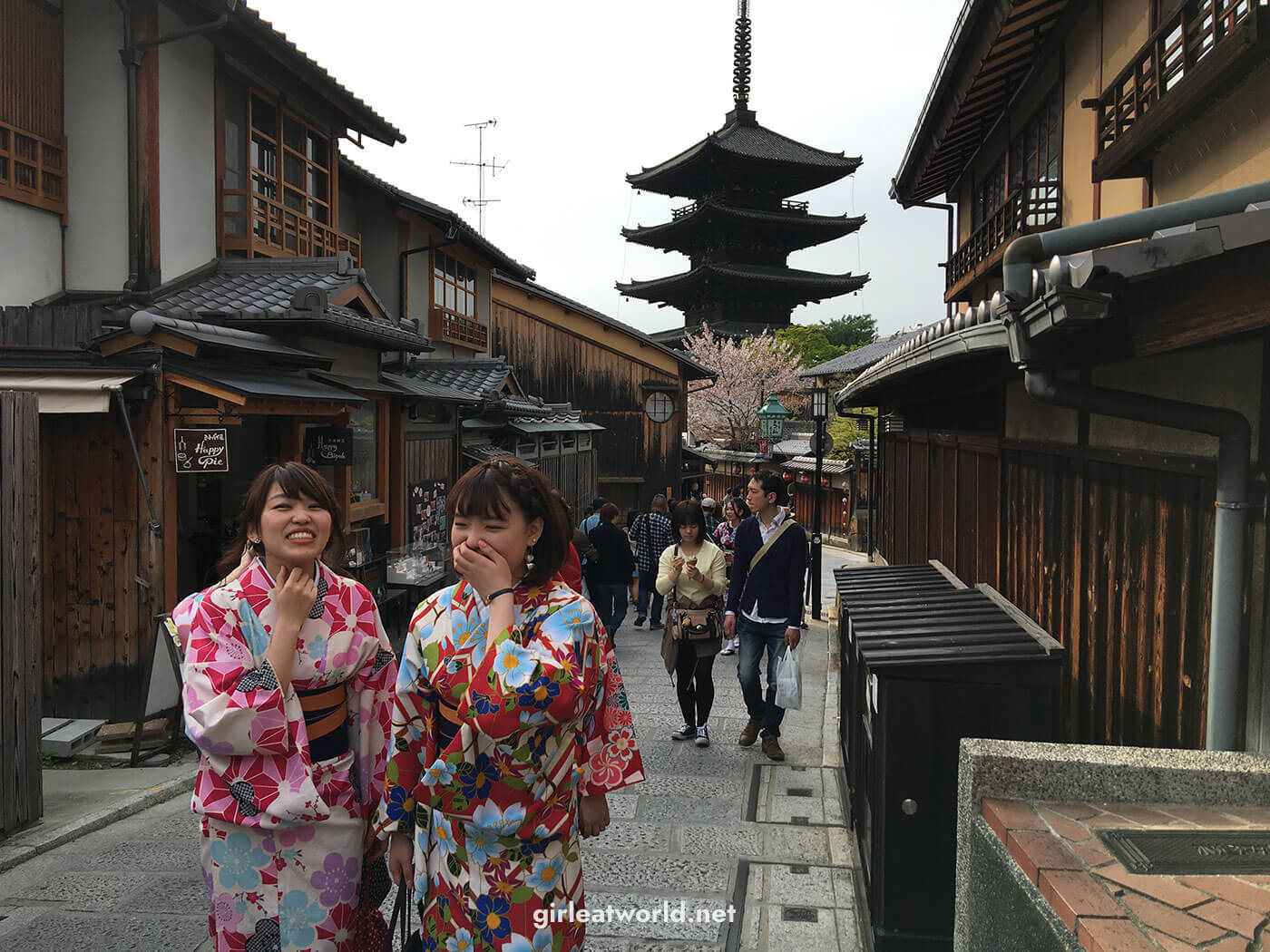
And, if you’re wondering if it’s considered offensive to wear Japanese traditional clothing – the short answer is no . Japanese culture does not consider it cultural appropriation when a foreigner wears traditional Japanese clothing, especially when you’re wearing it properly!
9. Iwatama Monkey Park in Arashiyama
Iwatama Monkey Park is an open-air park where you can see and feed Japanese Macaque. The monkeys here are not confined in a cage, because they are wild and are free to come and go as they please. Personally, I have never been because I am scared of wild monkeys, and they could be quite territorial.
10. See Kyoto at night / after dark
Temples and shrines in Kyoto close as early as 5 pm. But if you’re lucky, during certain times of the year, you can come back at night to certain temples to see them illuminated with lanterns and lights. These events are:
- Higashiyama Hanatouro (in March for 10 days)
- Hikari no Kyoto (November)
- Arashihyama Hanatouro (December)
Some events are one-off and don’t repeat every year, so be sure to pay attention to posters when you are visiting during the daytime. They might tell you if anything is on for nighttime.
What and Where to Eat in Kyoto
The name of this dish tells you a lot about the dish itself. “Yu” means hot water, and “Dofu” means… well, tofu. Quite literally, the translation for this dish is boiling tofu. If you don’t like tofu, you probably won’t enjoy it but I am a tofu lover and I thought it was great! Yudofu is usually served as kaiseki, a Japanese multi-course meal, and it does come at a price.
Where you can have Yudofu in Kyoto:
- Shoraian – By Katsura River near Arashiyama Bamboo Forest. It is a little difficult to find and might require a reservation as the place is small. We were turned away when we tried to walk in.
- Yudofu Sagano – We went to Yudofu Sagano near Arashiyama and had a 10-course kaiseki for 4,000 yen. It was an expensive lunch, but worth it because the food was so good and even being in the restaurant itself was really nice experience. They have a zen garden in the middle!
- Okutan – a 350 years old restaurant near Nanzen-ji temple.
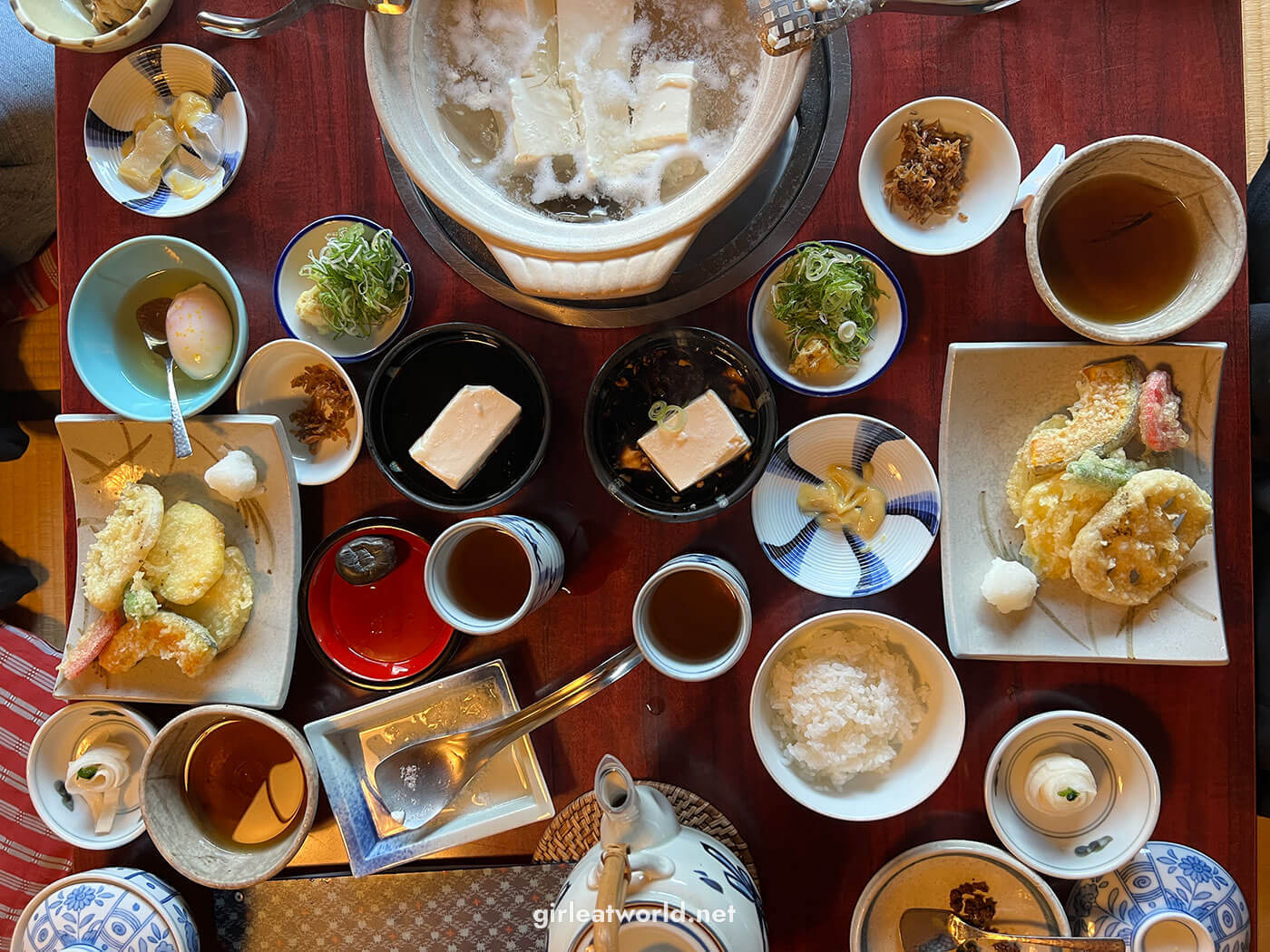
2. Uji Matcha
If you enjoy matcha (fine green tea powder), you’ll want to try matcha from Uji, a city in Kyoto. Uji is blessed with soil that is favorable for growing tea leaves. Matcha from Uji is considered one of the best in Japan, as it is rich in taste and very fragrant.
That’s why you’ll see matcha nearly everywhere in Kyoto – in the form of a tea drink, mochi, green tea ice cream topped with matcha powder, or even chasoba , noodles that are green in color from green tea ingredients.
Where you can try Uji Matcha in Kyoto:
To try Uji Matcha without visiting Uji itself, look out for these names while you are in Kyoto:
- Tsujiri – One of the most famous tea houses originated from Uji in Kyoto. They also have a small ice cream shop at Kyoto station, and their green tea soft serve is one of the best I’ve had.
- Itoh-kyuemon – another famous tea house from Uji. They also have a shop close to Kyoto station, selling dessert and their tea leaves.
3. Shojin Ryori
Shojin Ryori is a traditional Buddhist cooking, usually served as a multi-course meal. There is no animal product used, making it suitable for vegans, vegetarians, and those who need a halal option.
Shojin Ryori is made using the five basic concepts: five flavors (sweet, sour, spicy, bitter, and savory) five cooking styles (steamed, boiled, roasted, stewed, and raw), and five colors (white, black, red, green and yellow).
Shojin Ryori does come at a price – and it could be over 10,000 yen per person!
Where you can have Shojin Ryory in Kyoto:
Here are places where you can try Shojin Ryori:
- Shigetsu at Tenryu-ji ( map ) – near Arashiyama Bamboo forest
- Ajiro ( map ) – Michelin-starred vegetarian restaurant
- Hyotei ( map ) – A 400-year-old restaurant that is also a 3-star Michelin, located conveniently near the Higashiyama district
Other notable places to eat in Kyoto
Kinkaku soft ice cream ( map – near Kinkaku-ji) – This place serves gold-leaf softserves. It might be gimmicky, as it is obviously playing on the fact that Kinkaku-ji is covered in gold-leaf coating, but it does look special doesn’t it? Each ice cream will set you back 950 yen.
Nishiki Market ( map ) – Amazing food market that has been around for 400 years. It spans over 400m long and contains 100 stalls. You can find basically every Japanese food here. I’ve had sushi, sakura mochi, ichigo daifuku, just to name a few.
Kichi Kichi Omurice ( map – near Nishiki Market) – Have you seen the viral video of a guy serving the perfect Omurice a few years back? that restaurant is Kichi Kichi, and it is in Kyoto! I would highly recommend making a reservation if you intend to go, as the restaurant does not do walk-ins due to its popularity.
Gion Yata ( map )- Great restaurant for traditional kaiseki (multi-course) meals.
Ogawa Soba ( map – near Kinkaku-ji) – Great soba near Kinkaku-ji. It’s a little out of the way from most other places you’d want to see in Kyoto, but it might be worth it if you’re already in the area for Kinkaku-ji.
Kanoko ( map – near Fushimi Inari Taisha) – A simple restaurant right off the exit of Fushimi Inari Taisha. It looked unassuming from the outside, but they have a zen garden in the restaurant. They serve the usual suspect of Japanese cuisine fare like soba, tempura and set meals. Such a nice atmosphere and great food!
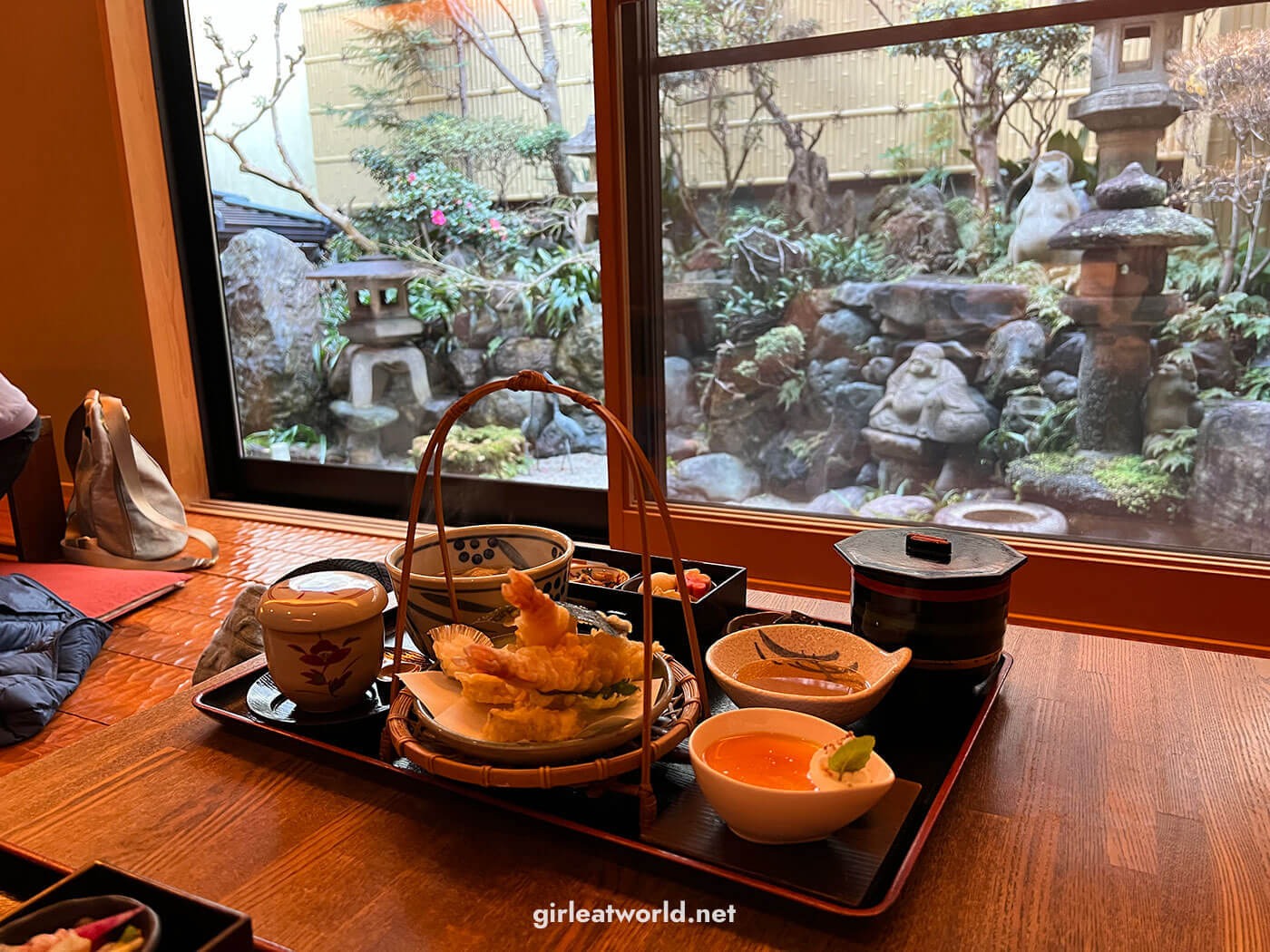
Bread & Espresso & Arashiyama ( map ) – Unique coffee shop near Arashiyama bamboo forest. It’s pretty popular so you might have to wait for a table.
Okay, folks, that’s all I have on Kyoto. If you end up making it to Kyoto, please comment below and let me know how your experiences are. And if my guide has helped you, please let me know too! I love reading and responding to your comments.
Until next time 🥰
Japan is one of my most-written topics in this blog and I go to Japan quite often. If you’re looking for more posts about Japan, please click here !
18 Comments
- February 22, 2024
Hi Melissa,
I will be travelling to Kansai area in March 8-16. 8-10 Mar – staying in Kyoto 10-16 Mar – staying in Osaka, day trip to Kobe & day trip to Nara
Do you think I can just buy the Kansai pass thru and use it from Kansai airport to the rest of the places? What other passes to you recommend.
Thank you for your time!
- February 17, 2024
Thank you for your site. It’s super helpful.
I am wondering what kind of pass I should be getting when in Japan.
We plan to to fly to KIX on March 10
Here is our itinerary March 10 Osaka March 11 leaving Osaka and spent the day in Nara. After visiting Nara, we will be leaving Nara for Kyoto, and stay in Kyoto March 11 to March 14 4 nights in Kyoto March 15 leaving Kyoto, and arriving in Hakone March 15 and March 16 2 nights in Hakone March 17 leaving Hakone and arriving in Fuji 5 lake March 17 and 18 both nights in Fuji 5 lake March 19 leaving Fuji 5 lake and heading to Tokyo March 19 – March 22 – 3 nights in Tokyo
In the Kensai area, should I get JR west Kensai pass, or should I get Kintensu 1 day pass, and purchase Haruka airport express to Osaka separately?
What would you recommend to go from Kyoto to Hakone?
Thank you so much.
- February 20, 2024
Your itinerary used to be covered by the unlimited JR, but since the price increase it is no longer worth it.
For Hakone and Fuji Five Lakes, I recommend looking into the Fuji-Hakone pass. This include the one way back from Fuji five lakes to Shinjuku. However it is only valid for 4 days, so you might want to activate it on your second day in Fuji five lakes.
For the Kyoto to Hakone portion, you’ll have to buy the tickets a la carte.
For Kansai, both of the options you mentioned are good, it just depends on your preference – do you like taking JR trains more or are you ok with the Kintetsu trains?
- January 18, 2024
Melissa, your blog is super helpful with planning of my Japan trip itinerary in late April/early May. I have prepared the draft of the plan as follows – however i stil cannot determine whether i am not spending too much time in Tokio, yet adding Nikko as day trip would mean i would spend most of that day travelling 🙂 Is the below reasonable or should i play with dates?
Date Activity 2024-04-20 arrival at KIX Osaka, checkin in hotel – dinner Dotonbori 2024-04-21 Osaka – day trip to Nara 2024-04-22 Koyasan – arrival ca noon, sighseeing of temples, evening cementary visit. 2024-04-23 Koyasan – early morning sightseeing return to Osaka (Osaka Castle and temples) 2024-04-24 Trip to Hiroshima with stop over in Himeji 2024-04-25 daytrip Mijaima, evening departure to Kyoto 2024-04-26 Kyoto – Fusimi Inaria Taisha, Nishiki market, Gion 2024-04-27 Kyoto – Arashima Bamboo Grove, Kinkaku-ji, Kiyomizu Dera. Pontocho 2024-04-28 Kyoto – Hokanji Temple, departure to Tokio 2024-04-29 Tokio – Shinjuku, Shibuya (Gotokuji Temple, Meiji Shrine, Park Yoyogi, Harajuku,Roppongi Hills ) 2024-04-30 Tokio – Toyosu Market, Tsukiji Market, Ginza and Tokyo Station, TeamLabs (?), Imperial palace gardens 2024-05-01 Tokio – Asakusa (Imado. Senso-ji Temple, Akihabara, Park Ueno, Akihabara i Ikebukuro, 2024-05-02 Tokio – Hakone day trip 2024-05-03 Tokio – day trip Kamakura – 2024-05-04 Tokio – souvenir shooping,evening Departure from Narita
Hey Krysztof, I think your itinerary looks very reasonable! You can save Nikko for later since you’re already heading to Hakone (the vibe is somewhat similar). I myself didnt go to Nikko until my 3rd visit to Japan. Just be mindful of the first few days of May being Golden Week. It is one of Japan’s largest holiday and there will be more domestic tourism on those days. However tourist attractions should still be open.
- July 5, 2023
Hi Melissa, So basically i can just rent a bicycle and cycle around Kyoto the whole day before i head back to Osaka? Was thinking if i should stay in Kyoto because I plan this way: Day 1-2 : Osaka Day 3 : Kyoto Day 4-6 : Tokyo Day 7-8 : Hakone
Hey Mandy, that sounds good to me! I highly recommend biking around Kyoto if the weather is good. Since you plan to head out to Tokyo, it could be good to stay in Kyoto if you want. I would try to stay near the JR station.
- May 30, 2023
Thanks for such a helpful writeup.
I clicked on the recommended accomodations and it seems like none are taking reservations. Are they perhaps alr closed due to the pandemic? Would you have other recommendations for accom?
Thanks alot! <3
- May 31, 2023
Hey Claire, they are still operational, but popular so they may be sold out on the days you are looking at
- May 8, 2023
I plan to travel to Kyoto Osaka in mid November this year. May I know when you travelled to Kyoto Osaka? I meant in fall foliage or before that? I would like to ask, is it worth to reschedule my plane to late Nov when fall foliage? because i need to pay penalty fee to airlines. Is mid of Nov worth or not? Thanks
Hey Ellen, I can’t say because it’s different every year, but generally for Osaka and Kyoto the peak is at the end of November. You can refer to this map: https://www.japan-guide.com/e/e2014.html
- May 2, 2023
Thanks for the comprehensive write-up. We are making a trip to Kyoto, Hiroshima and Osaka (10 days in total….taking it slow as we have some senior citizens with us). Am wondering if I should get the 5 days JR West pass and activate it only when in Kyoto to Hiroshima and return to Osaka, as we plan to stay in Hiroshima for 3 days, or should I get the 7 days pass? And would it be different compared to JR All Pass or should I stick to JR West Pass? Thanks
Hey Dave, by JR West, do you mean the JR Kansai-Hiroshima pass with 5-day validity? As far as I know, the JR West Kansai only has a 1-4 day validity and doesn’t cover Hiroshima. and by JR All do you mean the JR Whole Japan one?
In any case, the bulk of the train price would be the train going from Kyoto to Hiroshima and back to Osaka, like you mentioned so I would make sure to activate the JR validity to cover those days. So for example it sounds like your itinerary might look like this:
Day 1-2: Kyoto Day 3-6: Hiroshima Day 7-10: Osaka
I would then activate the JR Pass on day 3 when traveling to Kyoto-Hiroshima, and make sure it is still valid on Day 7 when traveling to Hiroshima. Given the trains are already 12,000 yen one way without JR Pass, It sounds like the JR Kansai-HIroshima is what you want.
- April 7, 2023
Hi Do I need the Kansai JR pass if I stay in Osaka and travel to Kyoto for 3 days?
- April 10, 2023
If you’re only traveling to Kyoto, I would just take the local train and not buy JR pass. Unless you want to take the shinkansen from Osaka to Kyoto. But the time difference isn’t much (15 mins by shinkansen vs 25-30 mins by local train from Osaka)
- January 2, 2023
Hai Melissa,
Thank you for the travel info provided. It help me a lot on my journey this month. But, may you help me to explain regarding Kansai Area Pass? I still don’t understand the use of trains in Kansai. Do I need to buy a Kansai Area Pass ticket to visit places around Kyoto, Osaka and Nara? and is the Kansai Area Pass a JR pass? and can I use it to take the train from the airport to Kyoto? Sorry for so many questions. I have read a lot of information, but regarding the train I still confuse, either the train is local train or the JR train.
- December 28, 2022
Thanks this was so helpful!!
- December 18, 2022
I really love your sharing on Kansai area. Thanks!
Do you find Osaka and Kyoto is pram accessible? I am bringing my 3 years old kid there.
Leave a Reply Cancel reply
Your email address will not be published. Required fields are marked *
Save my name, email, and website in this browser for the next time I comment.
- X (Twitter)

KYOTO Travel Itinerary 2024 🇯🇵 | NARA Park 🦌| Japan Travel Vlog
Indulge in Kyoto’s diverse food scene, from savory soba noodles and takoyaki to fire ramen and castella cake.
Then, venture to Nara Park to meet the friendly bowing deer and marvel at one of the world’s largest wooden temples.
Don’t miss the UNESCO World Heritage Site, the stunning Golden Pavilion, and the picturesque Togetsukyo Bridge.
Get ready to plan an unforgettable journey through these ancient Japanese treasures with this Kyoto Travel itinerary!
Watch this video to see how we spent a total of $317.05 USD for the two of us including transportation from Osaka to Kyoto, transportation around Kyoto and to Nara, Kyoto Food, Kyoto hotel, and everything on our Kyoto and Nara itinerary.
Prices can of course vary depending on dates, and the number of people you travel with. This is just to give you an idea!
Video Time Stamps: 0:00 Intro to Kyoto Japan 0:44 Kyoto Sightseeing Pass 2:51 Fushimi Inari Gates 6:39 Higashiyama Ward 7:05 Kiyomizu-Dera 8:10 Ninenzaka 9:17 Menbaka Fire Ramen 9:52 Kintetsu Rail Pass 10:26 Nara Park 12:38 Todai-Ji 13:52 Hotel Tavinos 14:48 Arashiyama Bamboo Forest 15:55 Katsura River 16:33 Togetsukyo Bridge 16:58 Otagi Nenbutsu Ji Temple 18:29 Favorite Part of Japan 19:11 Seiryo-ji Temple 19:44 Castella Cake 20:14 Ain Soph Vegan Restaurant 20:50 Nishiki Market 21:45 Kinkaku-ji Temple Kyoto 22:40 Kyoto Tea Ceremony
How To Find Your Perfect Airbnb: https://chewstoexplore.ck.page/f2d29ebc25
Top 9 Ways to Find Cheap Flights: https://chewstoexplore.ck.page/find-your-next-cheap-flight
Check out our budget travel guides and itineraries: https://chewstoexplore.com/shop-2/
Our Amazon StoreFront Travel Essentials: https://www.amazon.com/shop/chewstoexplore
DJI Osmo Pocket 2- Vlogging Camera https://click.dji.com/AHIn4IL1ty1ZeSwuoSwKiw?pm=link
DJI Mini 3 Pro – My Drone https://click.dji.com/AL54qKWM6qPSIFVzL6dT8g?pm=link
Follow me on Instagram and TikTok: @chewstoexplore
Please check out some of our other videos below:
*Disclaimer: This video description contains affiliate links. That means that if you click a link and decide to make a purchase we will receive a commission at no extra cost to you. Youtube and blogging is a stream of income for us, and those purchases help support this channel. Thank you for your continued support!
What’s up explorers welcome back to our Channel we’re the choose here from choose to explore where we teach you guys how to see world and save it all so right now we’re in Osaka but we’re about to head to Kyoto so we’re actually spending 2 Days in Kyoto and we’re going
To show you the best things to do and see in Koto affordably so stay tuned you don’t want to miss this one so in order to get from Osaka to Kyoto we actually booked the kiyoto to Osaka sightseing pass and it was $6 for the one-day pass and that includes all transportation and
Entrance to a lot of attractions in kiyoto and Osaka so it’s about a 1hour ride on the keihan railway so let’s go so it was a beautiful Scenic sunrise on the train and we are here in Kyoto now and first impressions as soon as we walked up is
This place is beautiful it’s super naturesque it’s feels like it’s old Japan like all of these buildings are older it looks like what I think Japan look like and it’s not like big cities exactly I’m really loving it so far all right so quick walk to Hotel tavinos about 105 15 minutes is
Beautiful views coming down and this hotel is beautiful it’s like a manga design it has all these cool amenities and it was only $54 a night here um so overall we couldn’t even check in right now cuz our uh check-in time is around 4:00 but we were able to drop our bags
It has 24-hour bag drop and they have free breakfast coffee and croissant so good let’s head on out for the day and right from our hotel it was about 15 16 minute ride over and we are here the Fushimi Inari Gates which are the ICONic Japanese jaese orange Tor Gates we just
Pulled up and we just saw that there’s a shrine with beautiful orange buildings it’s beautiful here already all right so we made it here it’s like 8:00 there are a good amount of people here but we’re walking and I’m honestly Blown Away by the amount of
Tory Gates that are here I knew that there would be a ton of them but they’re literally right next to each other and they’re so big they’re so tall they’re super cool just to see in person here so one thing that also is amazing keep walking it is a little tiring right
Li yes it is I’m out of breath but there’s great viewpoints look right behind us there’s a beautiful view of the whole city of Kyoto and I made it all the way to the top and once again it’s another Shrine it’s pretty but uh 233 M up that last bit I
Ran up I’m a little winded but good views I wouldn’t say it’s worth it to go all the way to the end come here take your pictures see it and go back down now all right it kind of reminds me of the big columns in Egypt in like car Temple
Or in luxer because every single piece of it is covered with some kind of words inscriptions like how they are with hieroglyphics on the side so beautiful so it’s 10:00 now big difference from when you first got here at 8:00 and that still might have been
Too late definitely so there’s a lot of people who say it doesn’t matter what time you get to these Gates just keep walking keep going and you’ll be able to get your photo but honestly there’s always going to be people and it would be a lot more enjoyable if you just come
Really early When there’s less people take your time walking through enjoy it and take your pictures at your leisure not just rushing to take your pictures when there’s nobody right behind you so come before 8:00 a.m. so as soon as you walk out of fushi anari there’s a lot of different vendors
Where you can buy different foods so come and try some of the Local Foods I got the strawberry da fuku with the strawberry and it’s pretty good I like it it’s a little chewy like a Gummy Bear kind of but lots of flavor and it has
Red bean paste right tell me about that red bean it’s it’s all right it’s all right I got these candy strawberries cuz I’ve been seeing everybody eating them all around and it’s good it’s very sweet um the Candi part is kind of like hard and um it will definitely get stuck in
Your teeth it’s getting kind of stuck in my teeth but it’s really really sweet so one thing that’s really cool and interesting here about Kyoto is there’s a lot of places where you can rent kimonos it’s beautiful here guys so we’re walking uphill now and let me
Just say there are so many people out here it’s a beautiful day now the sun is out so it is getting hot I’m very happy that I took my jacket off Liv had to take hers off so we walked up to the top and we’re
Here at kium Mizu Dera and the walk up here listen it’s crowded there’s a lot of people and there’s a lot of shops here to buy souvenirs and things so it’s a beautiful place to come try foods and see a lot of people but when you go up
To the top there’s so many beautiful orange buildings and I don’t know if Kyoto loves orange but this is orange just like fishu Inari Gates and they’re so big but it’s not just the big size of the temples that is beautiful you literally turn around and you have the
Most beautiful view of Kyoto and it’s also a forest to the side and mountains to the back and it’s like nature and and City are meeting all in one spot this is a great place to see all the views this is also a place to watch Koto during the
Sunset cuz it’s beautiful to see kyota lit up and see it at night so we’re on inaka and we stopped at a restaurant called yukia they have really good handmade SAA noodles and it was my first time really having that it’s like a buck week noodle you can get
It cold or hot I got mine hot and I also got some Veggie tempora on the side and it was really good I definitely recommend you try it and check it out so right here in N zaka you have a super cool and unique Starbucks it’s like a traditional Japanese house where
It’s wooden and has a lot of Japanese stock furniture and buildings and it’s a Starbucks yes so there’s a lot of people inside it’s very popular but but if you do get a seat it’s literally on the floor like a traditional Japanese um setting and it’s really cool I just got
A nice caramel macchiato and I’m ready to go Liv and I just got here at mbaka fire Ramen and it’s called fire Ramen for a reason because the we ordered the ramen and it literally lights on fire right in front of us guys if you come here sure
To wash your eyebrows your mustaches and your chin Ladies as well um so Li got the vegetarian ramen and I got the pork Ramen and I thought it was just here for the show but honestly the ramen was really good so lots of flavor here I highly recommend to come and get that
Fire so actually today we got a little bit ambitious and we’re going to head to Nara which is maybe about 45 minutes to an hour from Kyoto it’s another City and it’s supposed to have some really unique experiences so stay tuned we’re going to
Go to Nara so in order to go to Nara we bought the ketsu pass which was1 15,000 Yen which is more or less $10 which will save us a lot of money round trip to go to Naro one way and back so after about 40 minutes we made
It to Nar Park it’s about 4:00 p.m. and we’re here and look the deer are trying to cross the street as we speak it’s so crazy but everybody’s respectful everybody’s letting them cross you know in New York they would have definitely hit them here we’re here in Nara I got my
Biscuits I paid 200 yen in order to get them now let’s go and feed the deer let’s hope they bow at me these are some respectful de okay okay good so I’m going to give you guys a tip about feeding these deer you’re going to
Get a whole packet for 200 yen to feed them but you shouldn’t have that whole packet of biscuits out at the same time just have one at a time because then they’re going to keep Bing you and then they’re going to keep following you along and then they’re going to be
Nagging you just need to show them one at a time so if you look here it’s a green light it says don’t walk but they don’t follow the rules look they’re doing their own thing this is jaywalking this is Jay walking look at this that’s against the rules that is illegal
I’m not going to lie I’ve never heard a deer make any noise but the noise that these deers are making are crazy it’s honestly crazy cuz they have no fear of humans like they are just integrated in society at this point so right behind us is taji which is one
Of the largest wooden temples in the world and it’s really large and really impressive and I’m so happy that we came down here to see it it actually has one of the biggest Buddhas in the world that’s made out of bronze it’s over 15 M
Tall but you got to pay to get it tickets so we’re not going to go cuz we don’t have much time to really explore inside so I got this cracker I want to give it to live cuz I want live to feed them I’m not going to feed him feed him
I will not you have to feed him take it live the dare’s going to see you with the cracker look look he’s coming he’s coming for you live live where you going all right in the sun just set we had an amazing time with Nara I mean at
Least I did we got to feed the deer we got to see the beautiful wooden statues and monuments and just had a good time yes Nara is very beautiful very naturesque very cool place to be if you’re into seeing a lot of deer but for
Me I don’t think I could live here cool to visit though and last night we ended up staying at hotel tavino and we got this place I think $52 a night it’s a beautiful place it’s manga themed and it’s Unique hot showers highly recommend this and even has a beautiful view that
You can come turn up and turn down so now we’re up it’s a good morning to get the day started bright and early so let’s go all right so we just took the bus the number 11 which took us all the way here to the rashim myu bamboo forest and it’s
Beautiful there is so much bamboo it’s so tall and there so many of them it’s super interesting to see here so let’s go and let’s explore so we got here around 7:30 and there was a good amount of people here already but there was enough space where
You could come and take amazing photos pretty much isolated from everyone else but we’re here leaving now about an hour later and there’s a lot more people the sun is shining now um it is a little chilly right now but it’s beautiful for sure yeah I’m really loving it here cuz
Of the tall bamboo it feels really peaceful to just look at it and look all around and be surrounded by it super Serene Vibes here so now we’re leaving the Bamboo Grove and we’re walking through the arashiyama park and it’s a really pretty big green space so walking towards the
Water where we could hopefully see the river and see an iconic Bridge so let’s go let’s see so the walk from the park along the riverfront is amazing it’s such a beautiful walk where you could really get to see the hair the river and also see all of the Fall Foliage it
Also has a beautiful view of the togetu Q Bridge which is supposed to be one of the most iconic bridges in Japan I’m not sure why it’s so iconic but it’s cool to see the people and see everybody taking pictures so come and do that as well
So we just made it to the otagi temple which is a super unique Temple here in Kyoto number one is because it’s been destroyed and rebuilt so many times due to natural disasters like typhoon secondly it’s about 1,200 statues here of heads of different followers of Buddha so some are looking more happy
Some are looking like they’re deep and serious prayer some of them have um things with them that look like different hobbies that they pray take in so it’s a very unique area I’ve had a lot of bad days but never like this one right here my man had a rough outing
So Taki Temple is actually on top of a hill in order to get back to the town we’re having a nice beautiful Scenic walk back down and we actually passed the Arts and Crafts college and when you’re going down here you see a lot of people stopping drawing the different
Buildings and yeah so it’s beautiful to see so far we’ve been to Tokyo we’ve been to Osaka we’ve been to Nara and now we’re in Kyoto and Kyoto is my favorite region my favorite too for sure it’s just like it’s authentic you see old Styles you see the architecture this to
Me is what Japan I’ve always dreamt about is it’s quiet here it’s Serene this is a place that I could see myself coming back to over and over again and I feel like I could live here I love living in New York but I would definitely come back and visit here over
And over cuz you just feel the Sunshine hit you you see all the beautiful Greenery you just hear the birds chirping and it’s very peaceful and Serene really nice so we are starving we got to get something to eat we stopped by siroi Temple and it’s is a nice beautiful
Temple but live God some to ice cream yes I really liked it it was very light and very it was also really sweet the one that I got so I recommend coming there and trying it out on your walk through kotel and on our way to the market we
Stopped cuz we saw this super cool fluffy sponge cake kind of thing called made out of castella dough called fwn P pie it’s a nice jiggly like pound cake so we got this one one it was around 800 Yen for the brown sugar one lots of flavor sweet kind of spongy sof really
Cool interesting dessert it’s really Airy and it’s sweet and it’s very light so you don’t feel bad if you eat the whole thing so we’re right here in the guon district and we just ate at a really good vegan restaurant called Ansa so I actually ended up getting the mushroom
Rice and it was so delicious so flavorful and I also got a cream soda and it was raspberry and it was probably my favorite cream soda I’ve had they do a lot of cream soda here in Japan and this one has been the best one that I’ve
Had so far I decided to save my appetite leave the vegan stuff alone and we’re heading to the Nishiki Market next so let’s go get some real food now our next stop here is in the Shiki market and it is a lot of people here during this time it closes at 6:00 p.m.
So be sure to get here earlier than that but they have a lot of different street vendors a lot of Local Foods um I first started by getting eel with soy sauce and it was phenomenal nice savory lots of food there lots of flavor and then
After that I stopped and I saw a long line for Takaki which is traditional to Osaka region so I had to get it it was super cheap it was like 280 Yen and it was six balls it’s like um octopus on the inside and I didn’t think I would
Like it cuz I was mad I was going to get about six but honestly lot of flavor I highly recommend trying it the octopus is really good so our next stop is Kaku G Temple right here in Kyoto and we’re here right before golden hour and and it makes
Sense to be at Golden hour at a golden temple yes it only costs 500 yen per person to get it it’s super Zen here there’s a beautiful gold Pavilion in the center and there’s a lot of water surrounding it and Greenery and it’s very peaceful and Serene there’s a lot
Of people here but it still feels very peaceful here cuz it’s so beautiful what I love about it is it’s two floors completely covered in pure gold leaf it’s a UNESCO world heritage sitze but I wonder how much is this place worth go ahead so they said if this goes in it’s
Good luck success for the family yeah so after the temple we went up the street to Coto tea ceremony and this is a really great and authentic experience so pretty much you go in and they lay out the the traditions for making matcha and you get to taste it matcha and it
Was a very interesting experience uh the matcha is definitely bitter but for the tea ceremonies they use a higher quality that’s sweeter than any other matcha so I really enjoyed it it was a really great mindful experience and got to learn a lot about the culture and their whole process for making the
Matcha teas I thought it was a super cool experience but matcha and me ain’t a good mix cuz the matcha was while it was cool to learn about the experience I don’t think MCH is good I think it’s a good experience for you guys to try if you guys are here in
Kyoto just to see how they’ve been doing this for hundreds of years yes all right and we just took the train from Koto back to Osaka for the second time we have one more full day and we are about to explore Universal Studios Japan see the one and only Super
Nintendo World so thank you guys so much we had such an amazing time in Kyoto and Nar we did so much and we got a lot more in store so please be sure to like comment and subscribe we’ll see you guys on the next one ah
Related Posts
人生必看的一場煙火秀!!!!, the osaka marathon wasn’t what i expected, yokohama sakura meets osmo pocket 3🌸, 19 comments.
It looks very beautiful and peaceful there ❤
Love you guys. Love the budget travel. Keep it going and more ppl will subscribe!
Just started watching your videos, love it, mostly when you give price of food, lodging etc. subscribed your channel. What’s your Instagram id so I can follow?
Man your channel needs to get more subs. Keep doing your thing guys.
Hi. Just found your channel and subscribed! going to Japan in July :-). Also watching your other blogs..keep up the good work…Loving your channel
Awesome video! Keep them coming!
Was the otagi temple within walking distance from the main arashiyama area/bridge? Great video, thanks!
Loved it! Thanks for this video, we are now convinced Japan will be our 2025 big trip. Olivia, where did you get that beautiful purple bag?
YAY !! KYOTO !!! My NO.1 fave !! ( of Japan ) I am super duper jealous of you now !! Lol.👍👍😍😀💜🥁🐉🎤🎶✈️🇯🇵💕💞
I have visited Nara & deer park as a kid & almost got killed by one !! Lol. I wasn't paying attention to my back & kept feeding deer gathered around in front of me ,the one was behind my back got upset & tried jumping on me !!! LOLLOLLOL 😅😂
What a great video this one was ,too !! You're getting better/ better each time !! 👏👏👏👍👍
You guys looked fabulous in Kyoto / Nara !! I love Olivia in that white shirt !! Very classy !! Elegant look on her ! 😍 👍👍
Olivia looked so~cute in that kimono !!! Too bad that you guys couldn't like matcha !! It's packed w full of nutrients ( million times more than regular green tea !! ) !! Lol. My mom is a matcha ceremony teacher as well as ikebana teacher ( Japanese traditional flower arrangement ) ,she was a pro jazz singer when she was young ,back in those days ! 💜🥁🐉🎤🎶✈️🇯🇵💕💞
are they strict with drones there?
The inscriptions on the tori gates at Fushimi Inari are the names of the people who sponsor that Tori. (Basically a donor wall, or a kind of advertising.)
You both did so much in Kyoto!
Beautiful trip!. Thanks for showing all of the details. Wish you had met up with Sundai Love who lives in Japan and just finished renovating a home in Kyoto for long term rentals.
loving the videos
Nice! When was this?
Write A Comment
You must be logged in to post a comment.
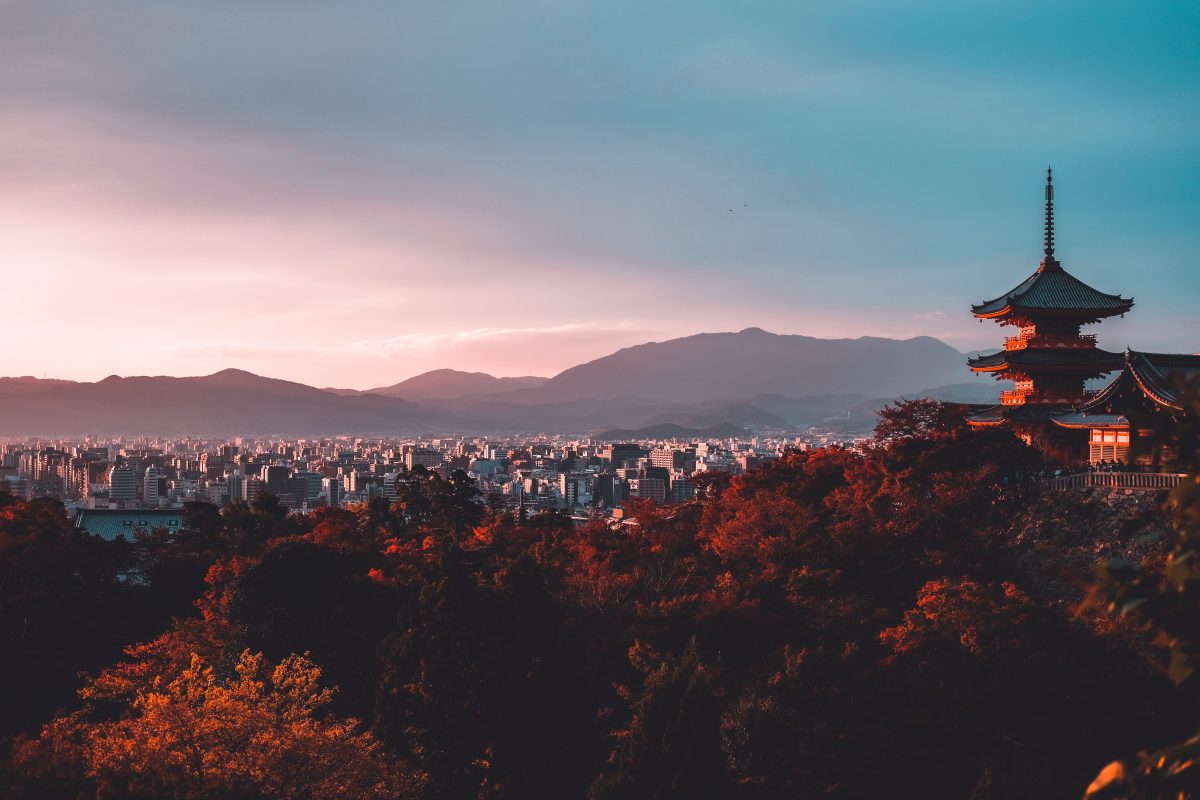
Japan’s ancient capital Kyoto is a must-visit when you are traveling to Japan. Kyoto is home to some of the country’s most famous spots and therefore a popular tourist destination. The beautiful city is located at the heart of the Kansai region and offers a wide range of activities to do and places to visit. Being largely spared from the WWII bombings, the city could preserve many of its old buildings and maintain its traditional atmosphere. Visit the tourist hotspots like the bamboo forest of Arashiyama or the numerous vermilion torii gates of Fushimi Inari Shrine . Stroll around the beautiful Gion District , visit local izakaya in Pontocho Alley, or go temple or shrine hopping at the approximately 2,000 Buddhist temples and Shinto shrines in Kyoto. If you are hungry head to Nishiki Market for regional specialties and if you’re lucky you might even spot a geisha or maiko on her way out.
Because of the central location, Kyoto is also a perfect base to discover other nearby places such as Nara, Osaka, Kobe and Koyasan. Kyoto can be reached by Shinkansen , normal train and bus conveniently and Kansai International Airport (KIX) is located under two hours away from Kyoto.
Here is a categorized overview of things to do in and around Kyoto. Click on the images to read more.
Best things to do in Kyoto
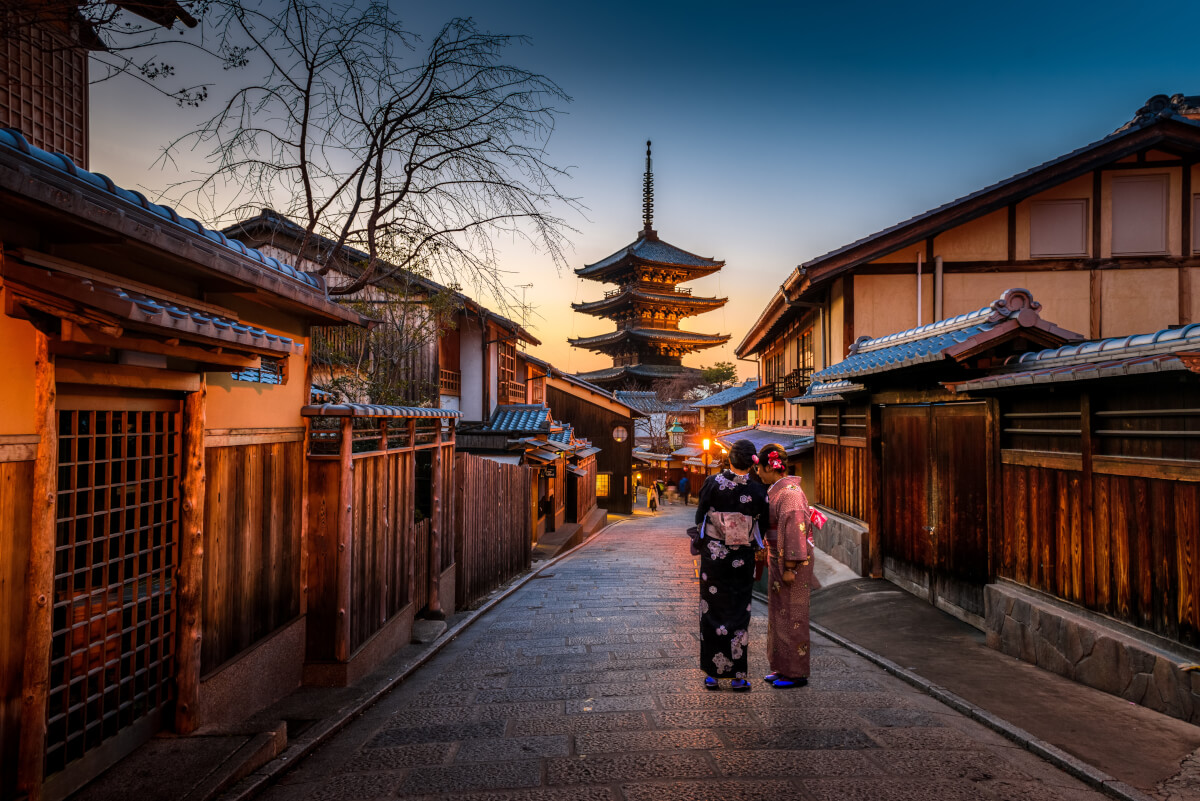
Tours & Tickets Kyoto

Accommodation in Kyoto
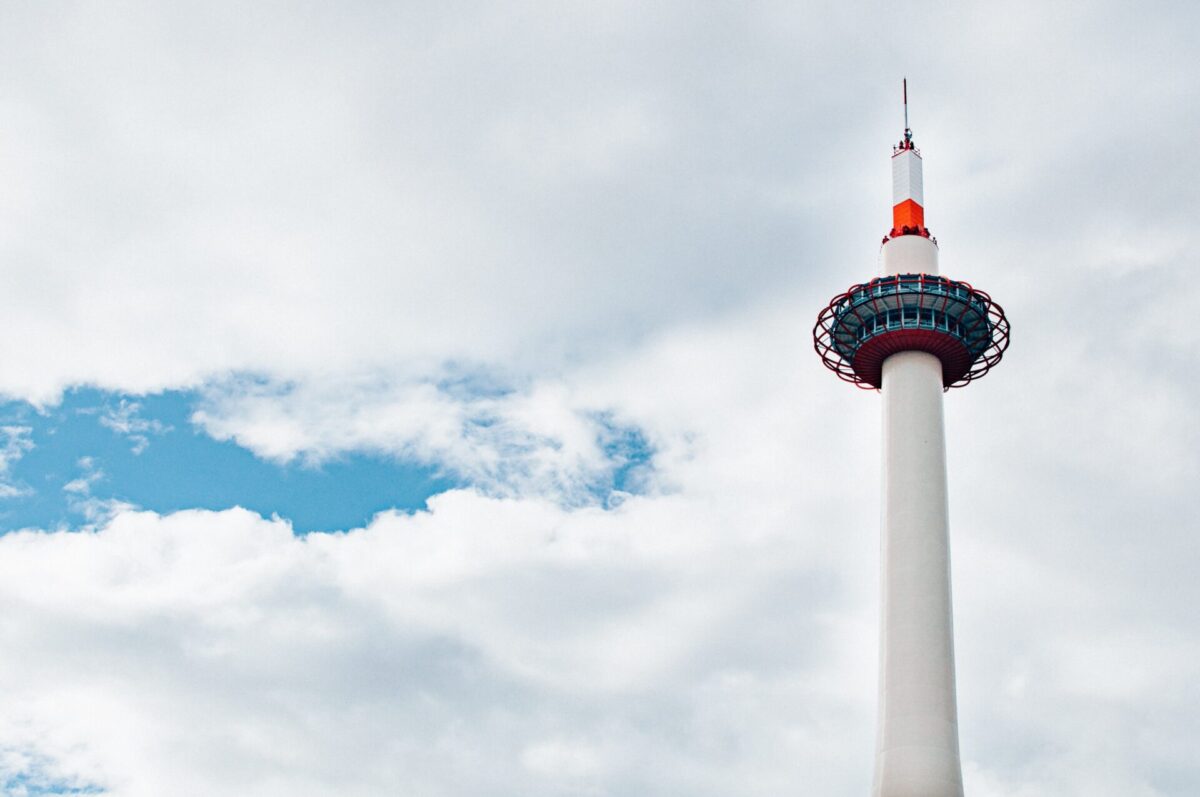
Follow us on Instagram , Facebook and Twitter for more travel tips and inspiration. Or tag us to get featured.
Happy traveling!

- Popular destinations
- Hidden places in Japan
- Tours and workshop
- Food and drink in Japan
- Itinerary in Japan
- Places to visit in Tokyo
- Food and drink in Tokyo
- Seasonal events
- Tours & workshops
- Tokyo This Week
- Day trip from Tokyo
- Itinerary in Tokyo
- Places to visit in Kyoto
- Food and drink in Kyoto
- Itinerary in Kyoto
- Day trip from Kyoto
- Travel tips
- Accommodation
- Cultural tips
- Transportation
- Tokyo Tours
- Kyoto Tours
- Kimono Rental
- Fukushima Tours
- Mount Fuji Tours
- Tour Package
- Media Kit(English/日本語)
1 Day Kyoto Itinerary, Japan (2024 GUIDE)
This 1 Day Kyoto Itinerary is the perfect guide for first-timers visiting the cultural capital of Japan.
From ancient temples and shrines to shopping streets and nourishing restaurants, there is something for everyone to enjoy.
There are so many things to do in Kyoto that you could quite literally spend weeks exploring this magnificent city.
But don’t worry – if you only have a short time frame to visit, seeing the top Kyoto attractions in one day is totally possible.
In this 1-day itinerary for Kyoto, I have included a complete list of the top places to see as well as some useful information on how to get around, where to stay in Kyoto, and a map of the city.
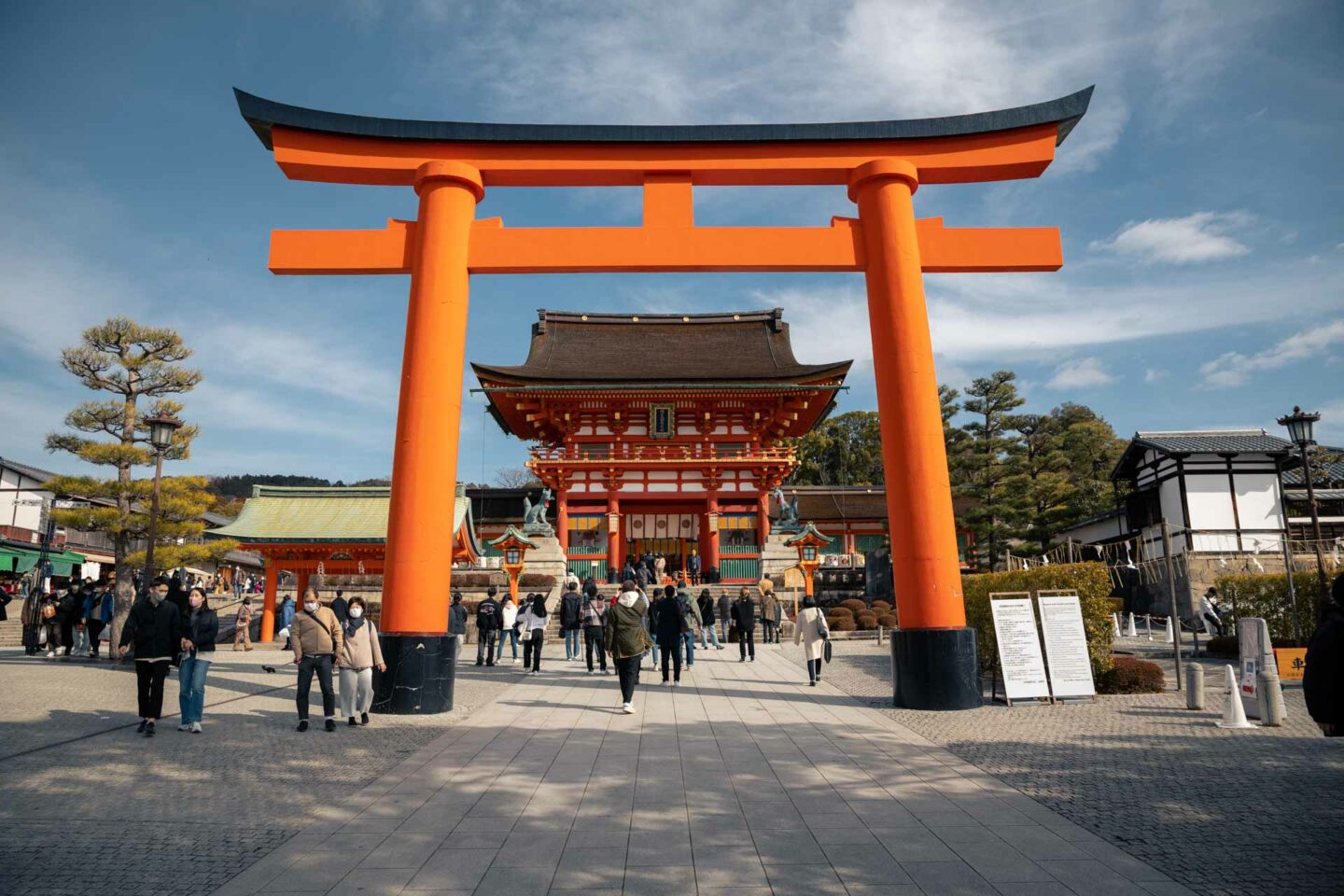
Table of Contents
1 DAY KYOTO ITINERARY OVERVIEW
To get the most out of your Kyoto 1 Day Itinerary, see below for a list of must-see attractions that I have included in this post:
- Kinkaku-ji Temple
- Ryoan-ji Temple
- Arashiyama Bamboo Forest
- Fushimi Inari (Tori Gates)
- Maiko Theatre (Geisha Girl Performance)
- Kiyomizu-dera Temple
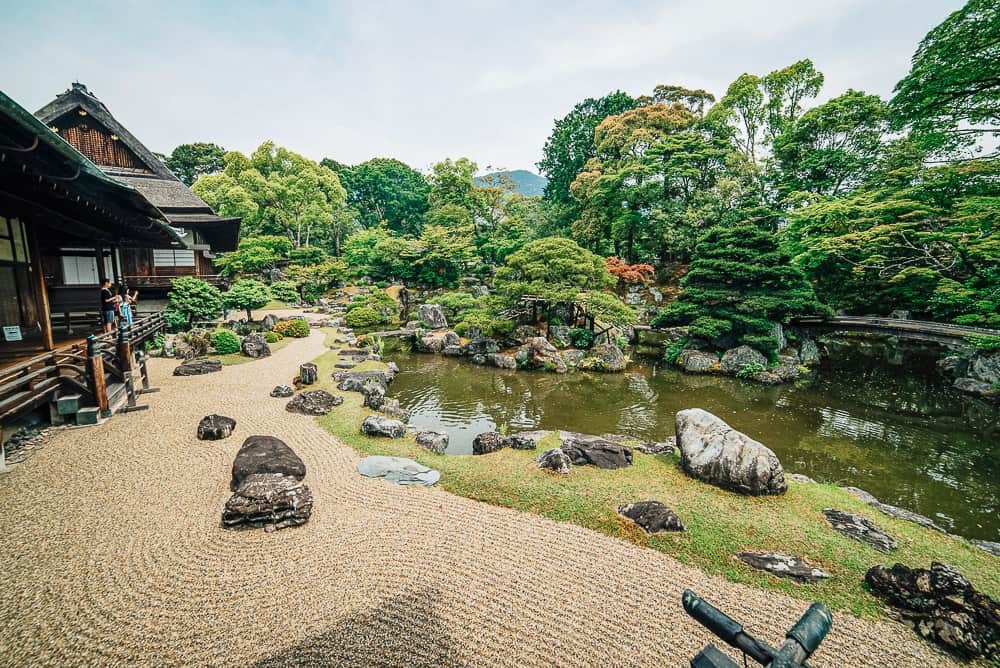
KINKAKU-JI TEMPLE
For the first stop on your 1 day Kyoto itinerary, I highly suggest paying a visit to Kinkaku-ji Temple in Kyoto’s northwest, where you’ll find the famous Golden Pavilion, located on a small lake in the middle of a serene garden.
The building dates back to 1397, and was once the holiday retreat villa for a prominent Japanese Shogun!
You can expect to spend about an hour exploring the temple and its surrounding gardens.
To reach Kinkaku-ji Temple on your Kyoto day trip itinerary, you can take the Kyoto City Bus 205 from Kyoto Station to Kinkakuji-michi bus stop, or Kyoto City Bus 59 from Sanjo-Keihan to the Kinkakuji-mae stop, or taxi directly to Kinkaku-ji Temple.
→ Click here for the pin location on Google Maps
ENTRANCE FEE & OPENING HOURS:
The entrance fee to visit Kinkakuji Temple is 400¥.
Opening hours are Monday to Sunday from 9 am – 5 pm.
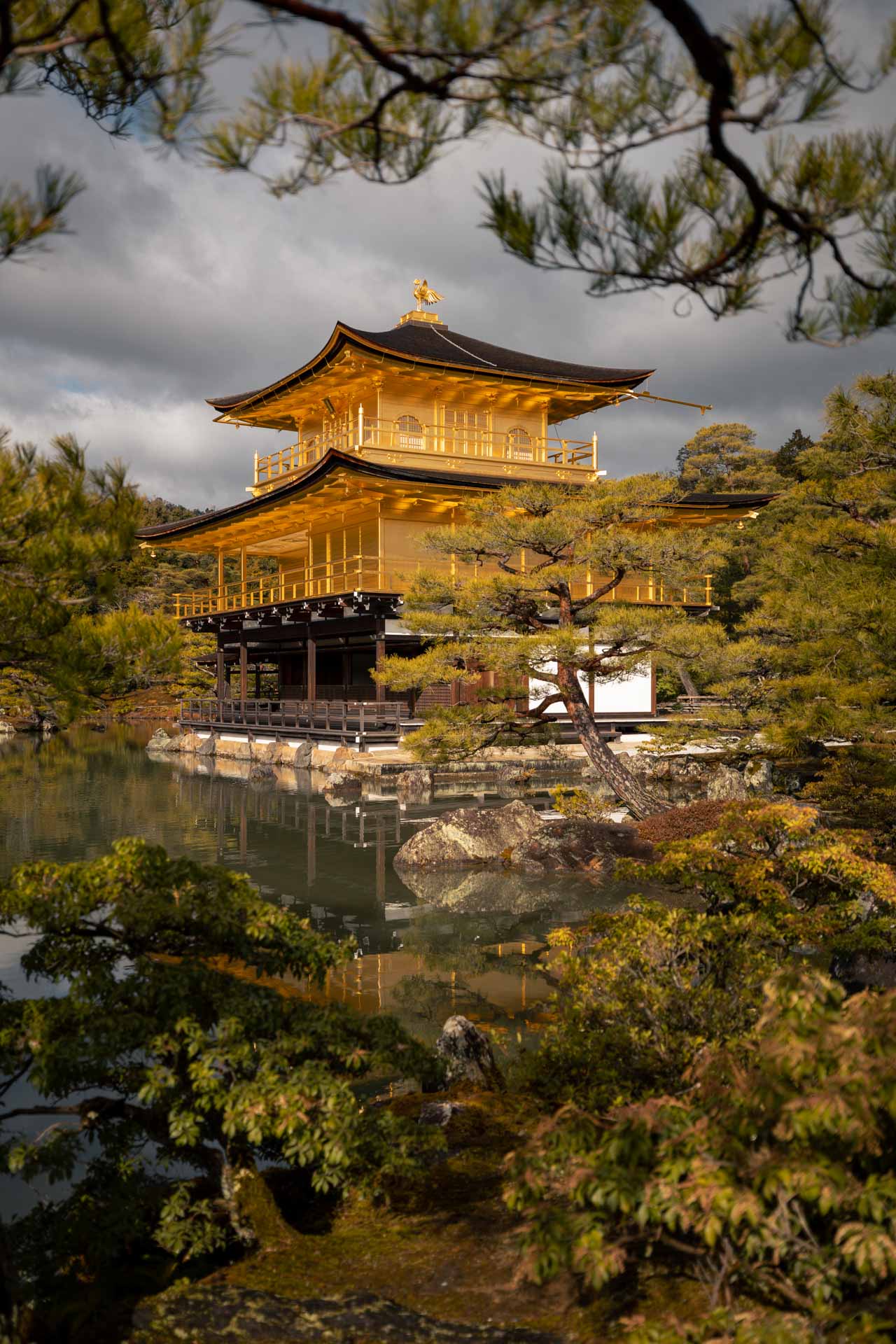
Have you got travel insurance for your trip?!

We all know accidents can happen and having Heymondo Insurance will save you thousands of dollars if something goes wrong.
Heymondo offers low-cost Travel Insurance to keep you covered on all your adventures.
RYOAN-JI TEMPLE
Ryoan-ji Temple is the site of Japan’s most famous rock garden, attracting hundreds of visitors every day.
Meditating with the view of this immaculately well-kept Cultural World Heritage site is the next best place to visit on your 1 day Kyoto itinerary!
From Kinkaku-ji Temple, it’s a 20-minute walk or a 5-minute bus ride to reach Ryoan-ji Temple.
The entrance fee to enter Ryoanji Temple is 500¥.
Opening hours are Monday to Sunday from 8 am – 5 pm – Plenty of time to visit on a day in Kyoto.
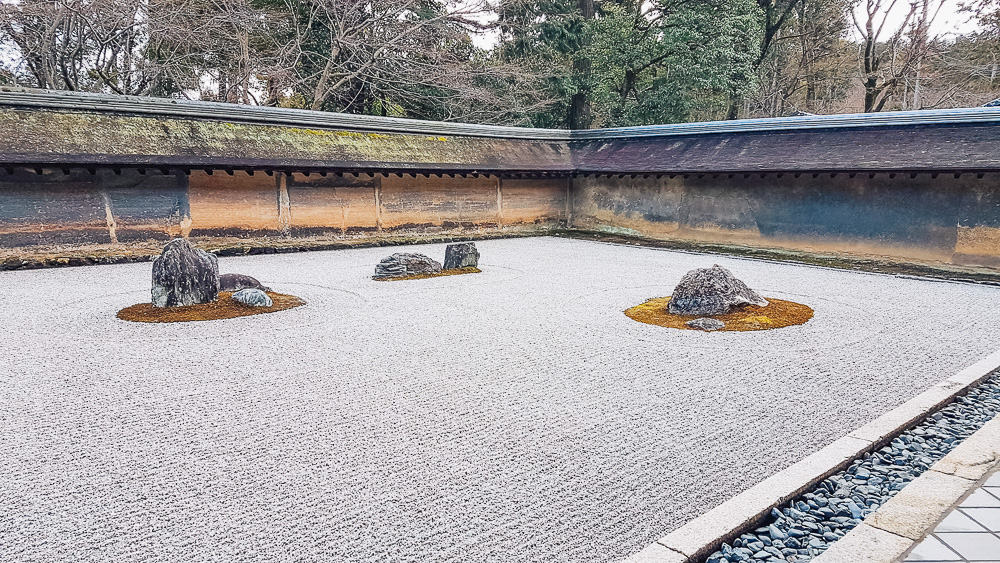
ARASHIYAMA BAMBOO FOREST
Next up on this itinerary is the world-famous Arashiyama Bamboo Forest. A trip to Kyoto wouldn’t be complete without having visited Arashiyama!
Kyoto’s bamboo forest is one of the most photographed attractions in the city and experiencing it through your own eyes is even better than any picture you would have seen of this place!
There is one main path leading through the Kyoto bamboo grove and when you enter the parallel tunnel of bamboo trees, you’ll feel like you’ve just entered another realm.
You will also notice the temperature drop when you are wandering through Arashiyama Bamboo Grove as the canopy above almost completely cuts out the sun.
The nature that surrounds Arashiyama is absolutely breathtaking and chances are you’ll spot a few monkeys in the area too, so keep your eye peeled.
A personal recommendation – make sure to come just after sunrise as photos will look even more stunning and you’ll avoid the group tours.
Talking about group tours, in case you don’t feel comfortable visiting by yourself, I recommend taking this early bird tour to Arashiyama Bamboo Grove . Many people prepare their 1 day Kyoto itinerary from Osaka only for that!
BEST TOUR IN KYOTO
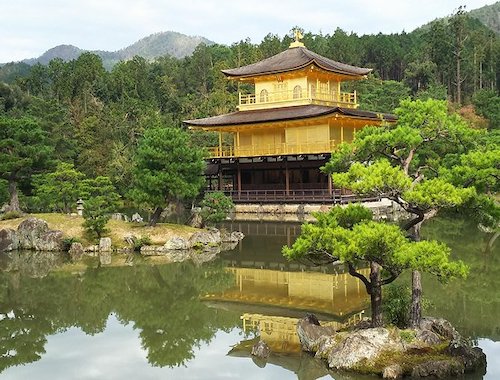
A must-do when visiting Kyoto is joining a Kyoto Early Bird Tour !
It includes a professional guide, a tour of the Bamboo Forest and other spots, and the Kinkakuji Temple!
The Bamboo Forest in Kyoto is located in Arashiyama, northwest of the city center.
Find your way to Saga Arashiyama Station on the JR Sagano line using the JR Pass and it’s a short 10-minute walk from here.
The Arashiyama Bamboo Forest entrance fee is FREE, which is another great reason to visit on your one day in Kyoto itinerary.
Opening hours are Monday to Sunday from 5:30 am – 11:30 pm, and that is so convenient if you plan a day trip to Kyoto from Osaka.
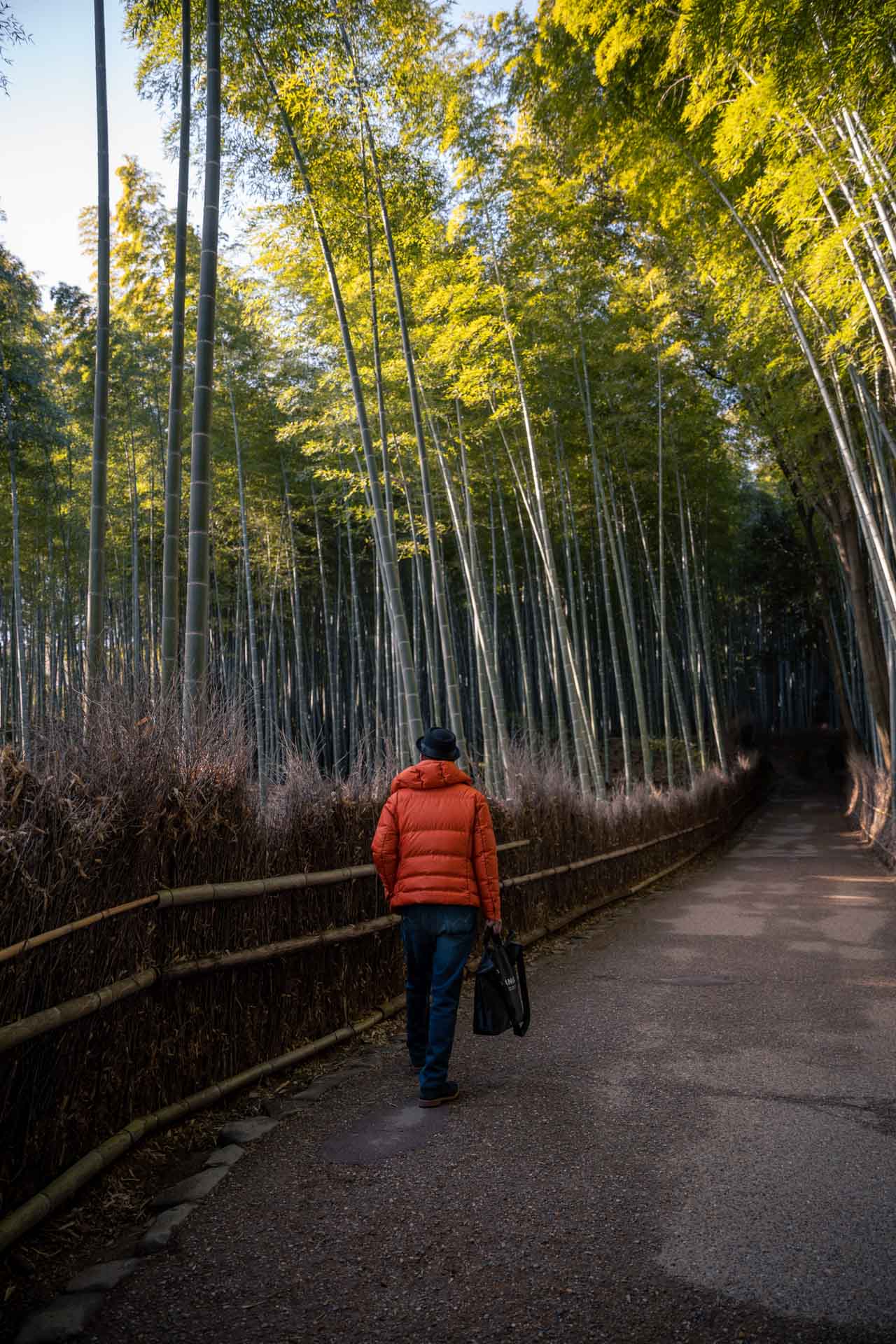
The BEST Backpack For Backpacking!
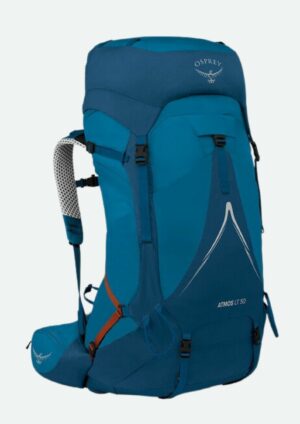
Less is more with the Atmos AG 50L , the newest arrival in the Osprey backpacking range!
From weekend explorations to month-long expeditions, this EPIC backpack is up to the task and will stand the test of time.
FUSHIMI INARI
Continue the adventure on your one day Kyoto itinerary by journeying through the world-famous Tori gates of Fushimi Inari.
This must-see shrine consists of a pathway lined with over 10,000 Tori gates that extends 4km up to the very top of Mount Inari.
It takes around two hours to walk to the very top and back down again, however, you can turn back at any time you want!
Along the pathway, you will also see many stone foxes, symbolizing the messenger of Inari – the god of rice… and business!
The Fushimi Inari Shrine is also known for its beautiful architecture and gardens, making it an ideal spot for photographers looking to capture some amazing shots and it’s a great idea for what to do in Kyoto in 1 day.
Take the JR Nara Line from Kyoto Railway Station using the JR Pass and ride it two stops to JR Inari Station.
The Fushimi Inari Shrine is FREE to enter and it’s open 24 hours a day, 7 days a week.
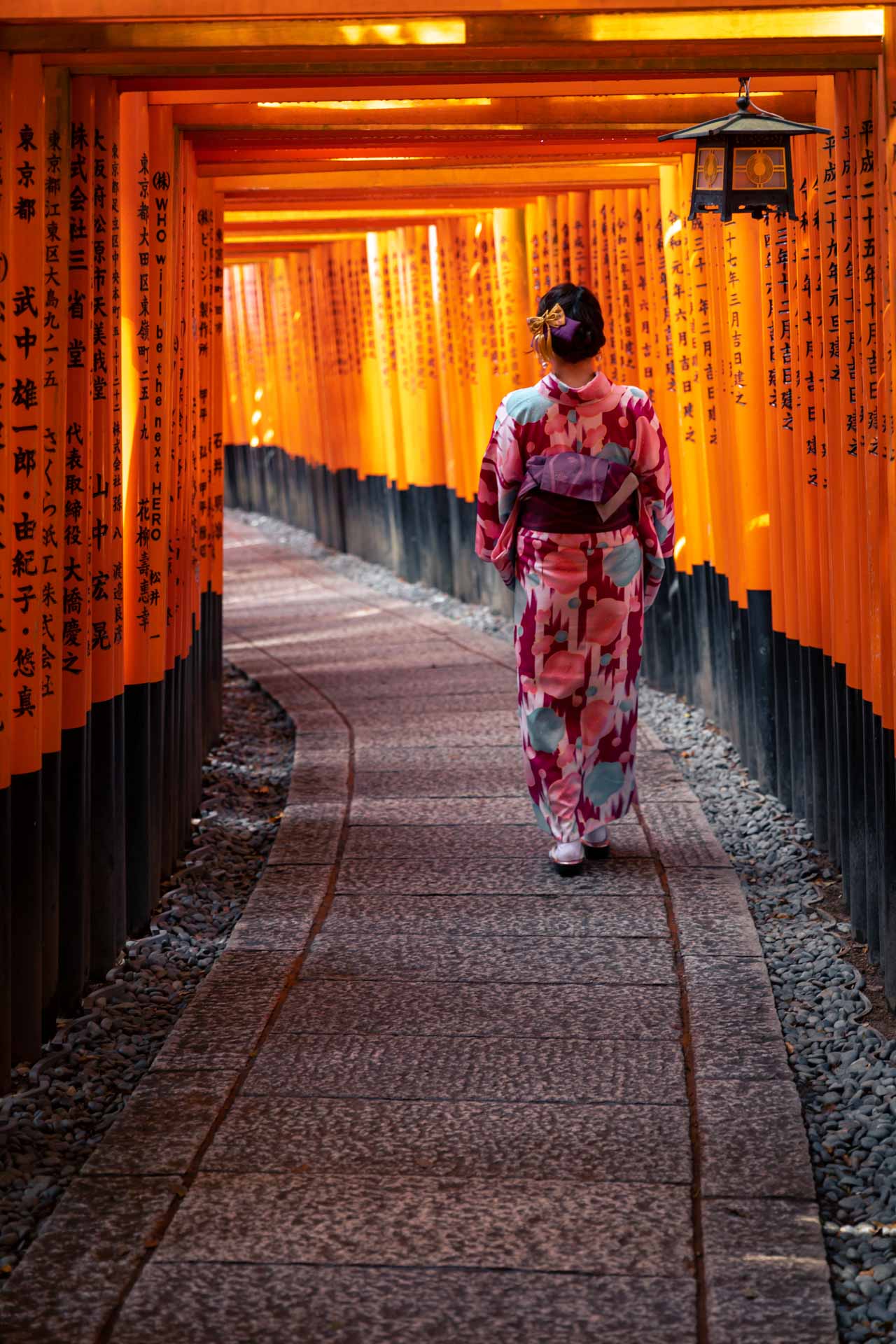
MAIKO THEATER
One of the most exclusive experiences to add to your Kyoto 1 day itinerary is meeting a traditional Geisha performer.
Geisha are highly skilled entertainers who appear at high-end dinners, private parties, and special events to add a special touch to the proceedings, and are rarely seen in public.
Many foreigners tend to run around the red light district areas to try to get a glimpse of a Geisha girl or pay large sums of money to have a private performance.
Luckily, for travelers on a budget, there are some cheap options to get a taste of what a Geisha show is like!
I personally recommend the Maiko Theatre. While training to become Geisha between the ages of 15 and 20, these girls are known as ‘Maiko’, and this theatre gives you the rare opportunity to get to see one of them close up!
Take the bus from Kyoto Station to Kawaramachi Gojo bus stop, then walk for 2 minutes, or 3 minutes walk east from Keihan Shimizu Gojo station (exit 4).
It is relatively inexpensive at 3300¥ for their basic show, including a special dance and Q&A session, and you can take as many photos of (and with) her as you like!
Opening hours are Monday to Sunday from 10 am – 7 pm.
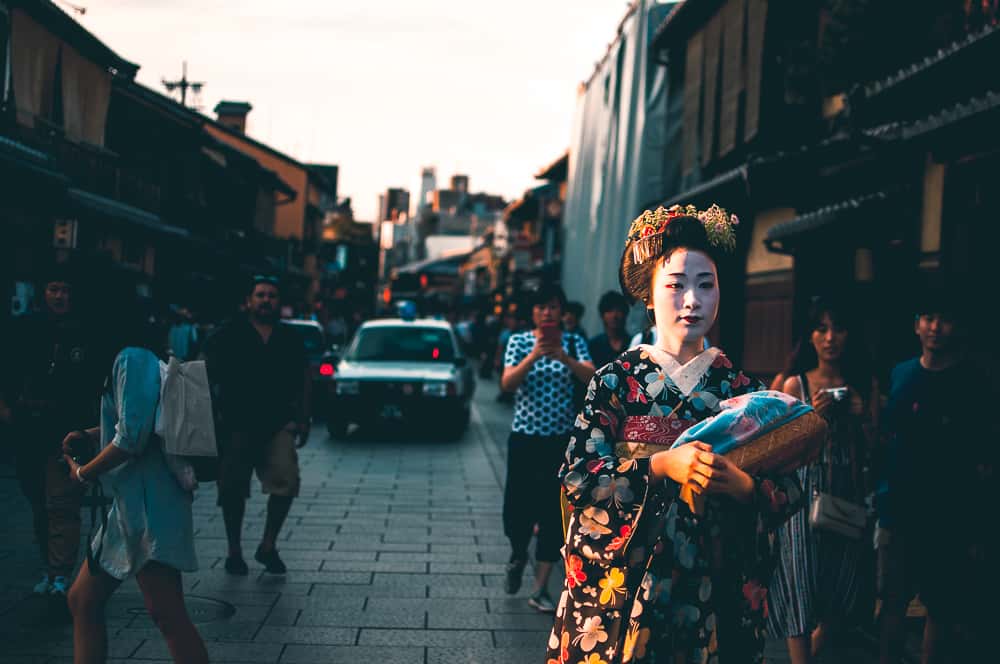
The BEST Affordable Camera For Travel

If you’re on the hunt for a professional camera for traveling, check out the Canon G7 X Mark II .
This tiny camera fits in your pocket, captures high-quality photos and videos, and has Wi-Fi so you can instantly transfer to your phone!
KIYOMIZU-DERA
Next on this itinerary for Kyoto is a visit to the Kiyomizu-dera (Water) Temple.
The walk leading up to the temple is almost as exciting as the temple visit itself, with a multitude of traditional buildings, shops, and restaurants.
Kiyomizu-dera is built into the side of the mountain, and from the huge verandah, you can see spectacular views of the hillside and the entire city.
Below the Kiyomizu-dera temple, you can find the reason why people make pilgrimages here from around Japan and the world – the Otowa Waterfall, a must-see on a Kyoto 1 day itinerary.
The waters are divided into three streams, and visitors use long poles with cups attached to drink from the streams.
Each stream has a different meaning and benefit – long life and health, success in school/career, and love. However, you can only drink from one… so choose carefully!
Make your way to Kiyomizu-michi street and follow it uphill until you reach the popular Kiyomizu-dera (Water) Temple.
The Kiyomizu-dera Temple entrance fee is 300¥.
This Kyoto tourist spot is open daily from 6 am to 6 pm, and that’s plenty of time to include it with other spots what to see in Kyoto for the day.
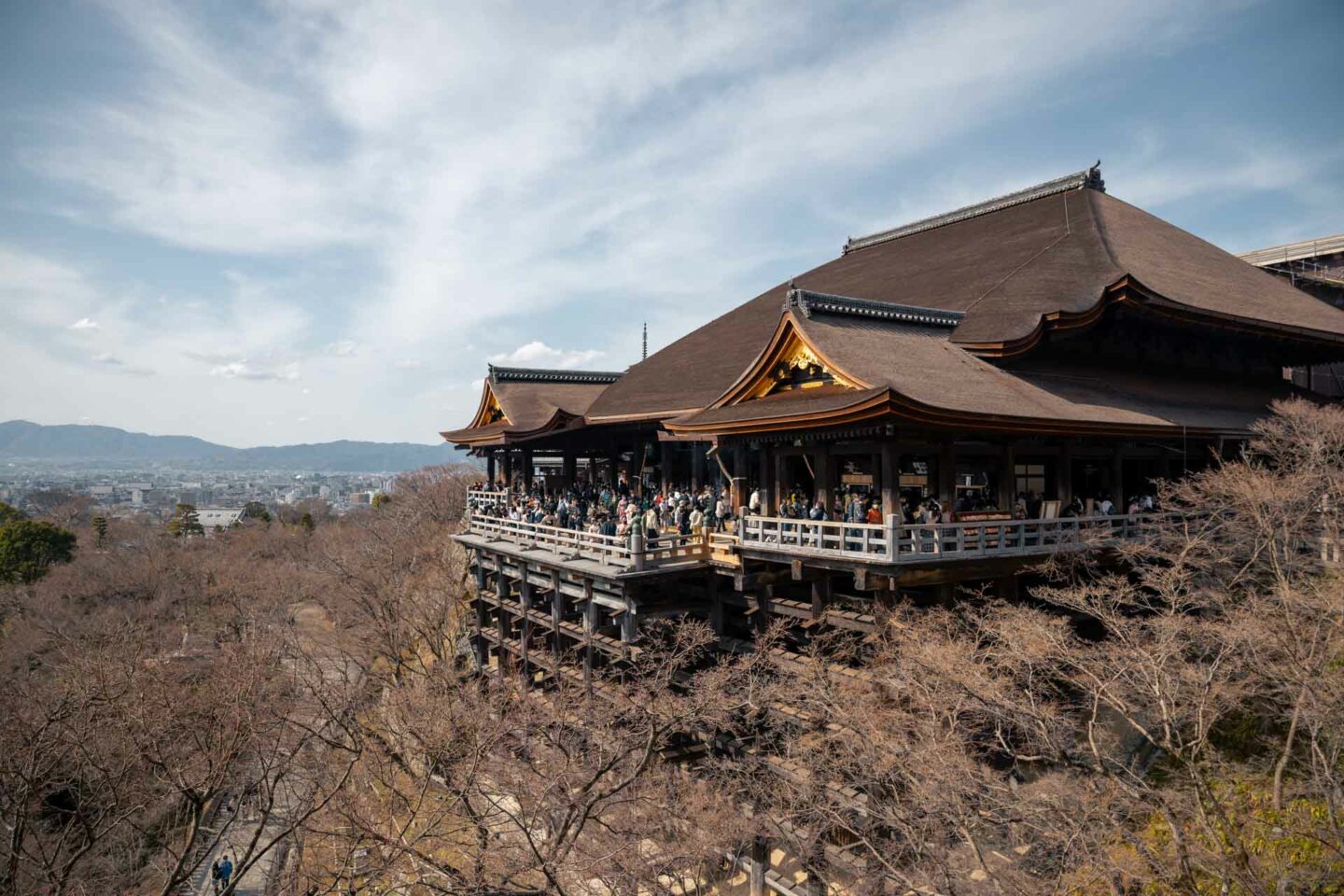
Last but not least on this Kyoto day itinerary is Gion, a must-do when taking a Kyoto day trip from Osaka or Tokyo.
From Kiyomizu-dera, you can meander down the iconic Sannen-zaka alleyway, a historical, stone-paved street lined with many traditional Japanese buildings, shops, cafes, and inns.
Sannen-zaka is also surrounded by several famous landmarks such as Yasaka Shrine, Maruyama Park, Yasaka-no-to Pagoda, and Kodaiji Zen Temple.
Once you reach the bottom of the hill, you’ve basically arrived at Gion, home to various red-light districts where you might be lucky enough to spot a Geisha! My favorite is Hanamikoji Street.
I recommend timing your arrival here for around 5:30 pm, as this is when the Geishas start leaving their homes to go to work (…and avoid the paparazzi of foreigners while doing so!)
Be careful though, you can be fined for taking photos of them, as it is considered highly disrespectful.
Put the cameras down for this one, and enjoy the chance to see one in the moment!
RELATED ARTICLE → 7 DAY JAPAN ITINERARY
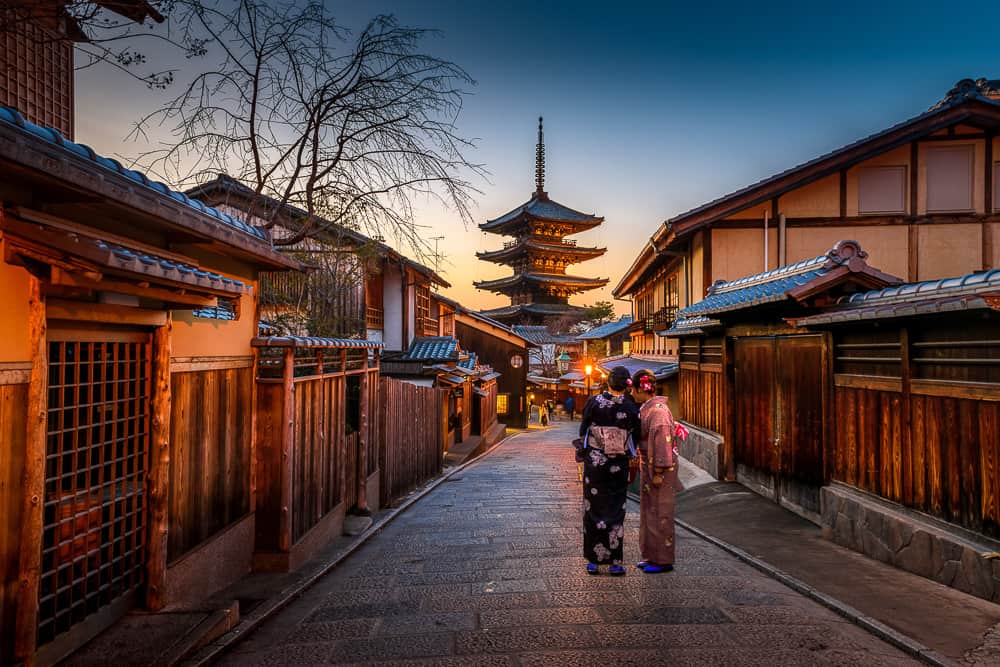
WHERE TO STAY IN KYOTO
There are thousands of accommodations to stay on a Kyoto 1 day trip, so I have narrowed it down to a few of the best places to stay to suit the needs of luxury travelers, budget backpackers, and everyone in between.
See the list of accommodations that I personally recommend for your Kyoto 1 day itinerary.
LUXURY: HOTEL GRANVIA KYOTO

MID RANGE: TUNE STAY KYOTO

BUDGET: PIECE HOSTEL SANJO
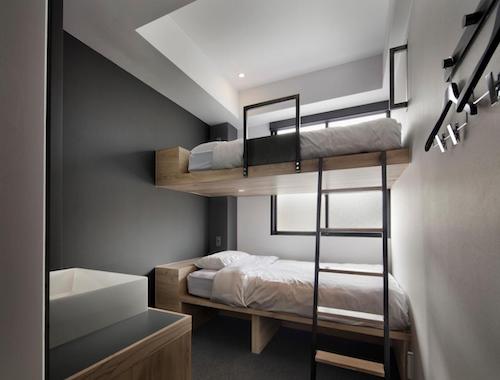
TRADITIONAL RYOKAN
If you’re looking for an authentic experience to add to your 1 day in Kyoto itinerary, I highly recommend staying at a traditional Ryokan (Japanese-style inn) during your stay.
My personal favorite is Kyoto Ryokan Kinoe which is conveniently located in central Kyoto just 5 minutes walk from Gion.
This cozy Ryokan offers spacious tatami mat rooms, 24-hour baths, and multi-course meals served for breakfast and dinner.
Staying here will make you feel like you’re a traveler back in Edo-era Japan, and it’s a great base for a Kyoto 1 day itinerary!

OTHER PLACES TO STAY IN KYOTO
Didn’t find the perfect accommodation to suit your needs above.
Use the interactive map below to search all the available hotels for your Kyoto day tour itinerary. Simply enter your dates of stay and hit the search button!

MORE THINGS TO DO IN KYOTO
If you have more than one day in Kyoto, be sure to check out my Kyoto travel guide which includes 25 AMAZING things to do in Kyoto!
Read More: Kyoto Travel Guide – 25 AMAZING Things To Do
Best day trips from kyoto.
The best day trips from Kyoto are to Nara and/or Osaka.
Nara was once the ancient capital of Japan and plays home to some of the country’s most important cultural places, including the world’s largest wooden structure.
Some of the best things to see in Nara on a day trip from Kyoto are the famous Todai-ji Temple which houses the world’s largest Daibutsu (bronze Buddha statue) and a visit to the Nara Deer Park where it’s said that when you bow to the deer, they will bow back!
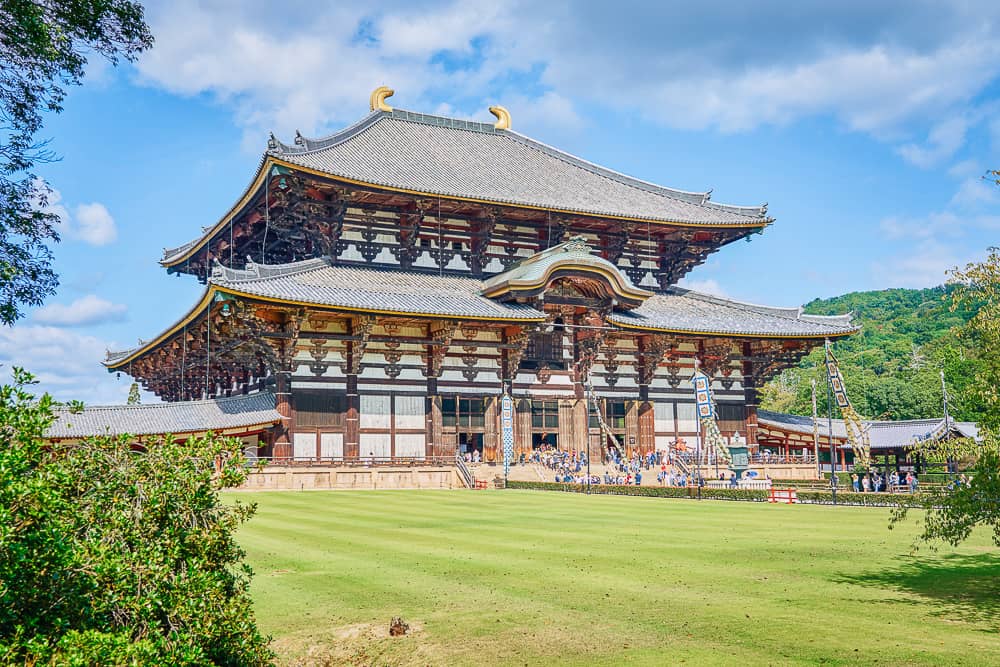
Osaka is the 3rd largest city in Japan and is most popular for its modern architecture, historical castles, buzzing nightlife, and sensory-overload shopping malls.
The top attractions to visit in Osaka on a day trip from Kyoto are the Dotonbori and Shinsaibashi shopping malls, Osaka Castle, Amerika-mura (America Town), and Universal Studios Japan.
Even if you have limited time on your Kyoto one day itinerary, I highly recommend going to Osaka for the day or half day.
Alternatively, you can see the city first and then proceed from Osaka to Kyoto on your Japan holiday.
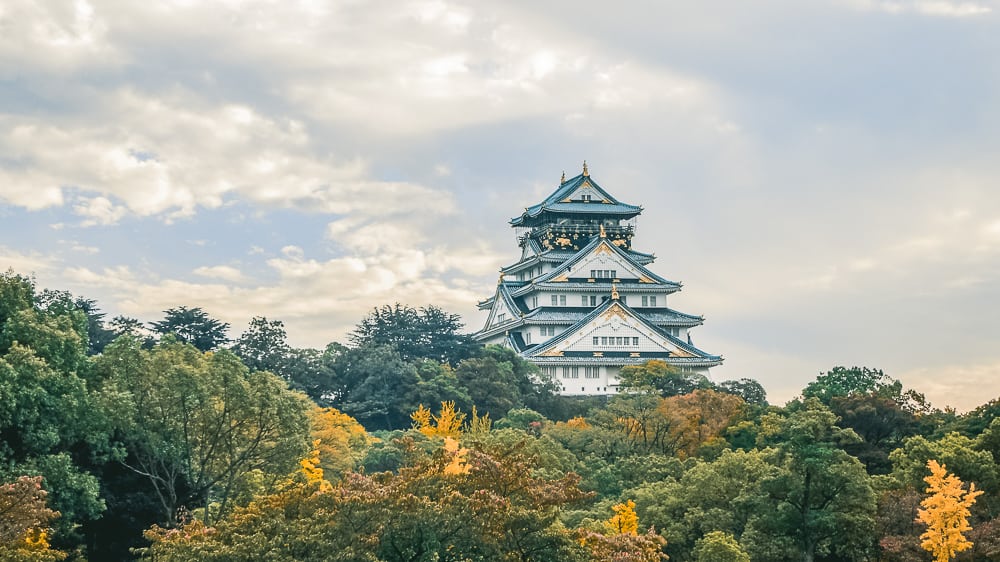
TRAVEL TIPS FOR KYOTO
For first-timers planning a one day trip to Kyoto, here are some useful travel tips to know before you go.
STAY AROUND CENTRAL KYOTO
While pretty much all areas of Kyoto are good to stay in, Central Kyoto is the most convenient. And since it’s near the main train station, you can even organize a day trip to Kyoto from Tokyo.
This puts you right at the center of all the main attractions in Kyoto, making it easier and less time-consuming to explore around.
From Kiyomizu-dera Temple and Fushimi Inari to Ginkaku-ji and Nijo Castle, most of the major landmarks are located within Central Kyoto, so there’s no need to walk for hours or take a taxi or a bike.
Staying centrally also allows for easy access to popular restaurants, shopping areas, and more, basically providing an optimal base for a few days.
Also, if you plan a Kyoto day trip from Tokyo, you can easily get around town and come back later or the day after to the train station.
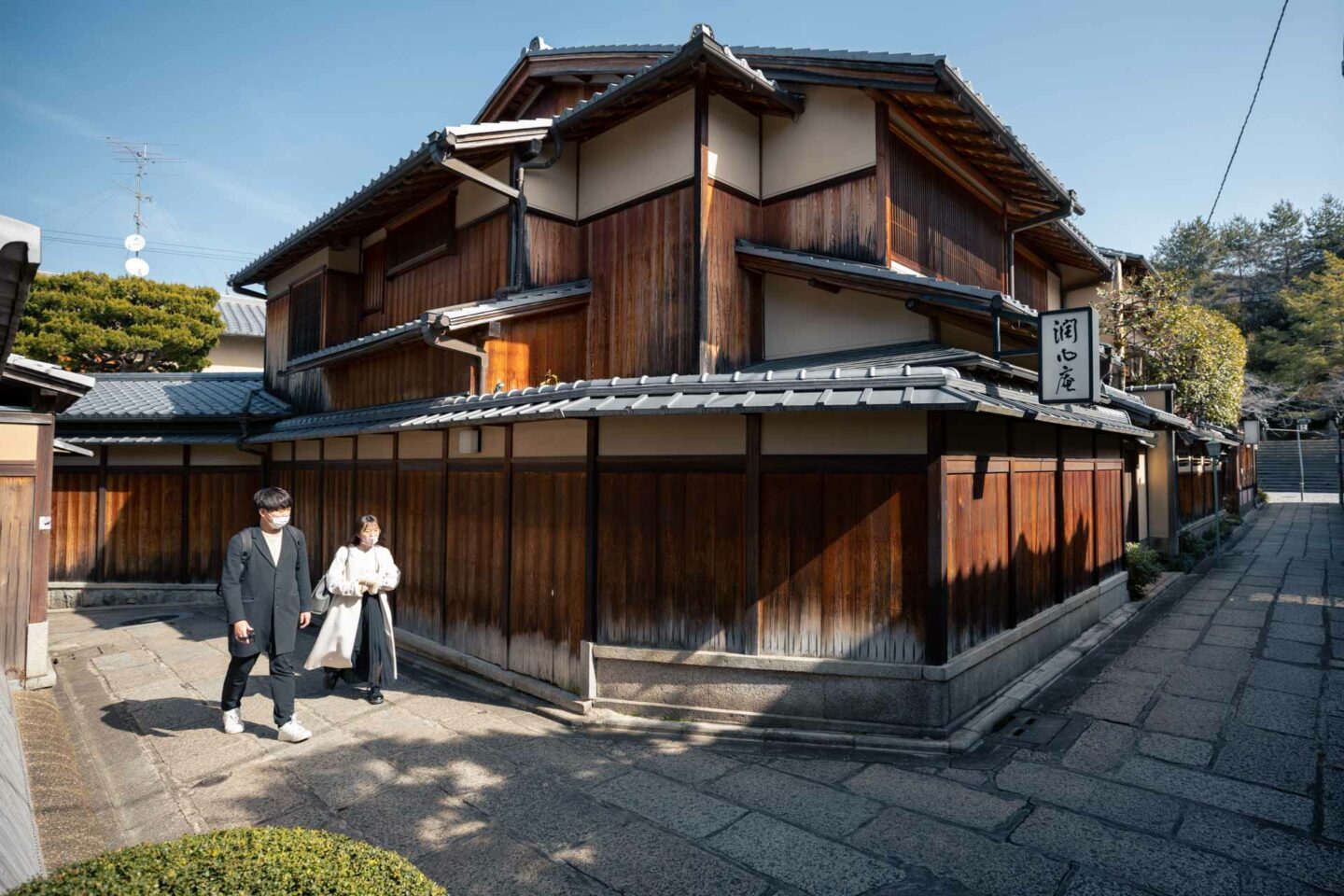
VISIT THE KYOTO ATTRACTIONS EARLY
Kyoto receives 87 million tourists per year on average, so visiting the tourist spots in Kyoto early is a great way to avoid crowds and walk around peacefully.
The popular things to do in Kyoto and all the major attractions are packed with tourists, so it’s wise to go early in the morning when the lines are shorter.
Plus, you’ll benefit from cooler temperatures, which is a plus in the summertime.
COME IN APRIL FOR CHERRY BLOSSOM
To see the cherry blossoms in Kyoto, consider coming in early April when you can really experience the city in full bloom.
The cherry blossom starts in late March but the peak comes in April, and this is precisely where you can see the city as beautiful as ever.
DON’T TIP
When it comes to Japan, one thing to keep in mind is that tipping is seen as rude and, therefore, it’s better not to tip. In fact, it could even be seen as an insult by the locals.
Instead of tipping, show a sign of appreciation either verbally or with a bow to express gratitude for the service provided. This applies to restaurants and ryokans too.
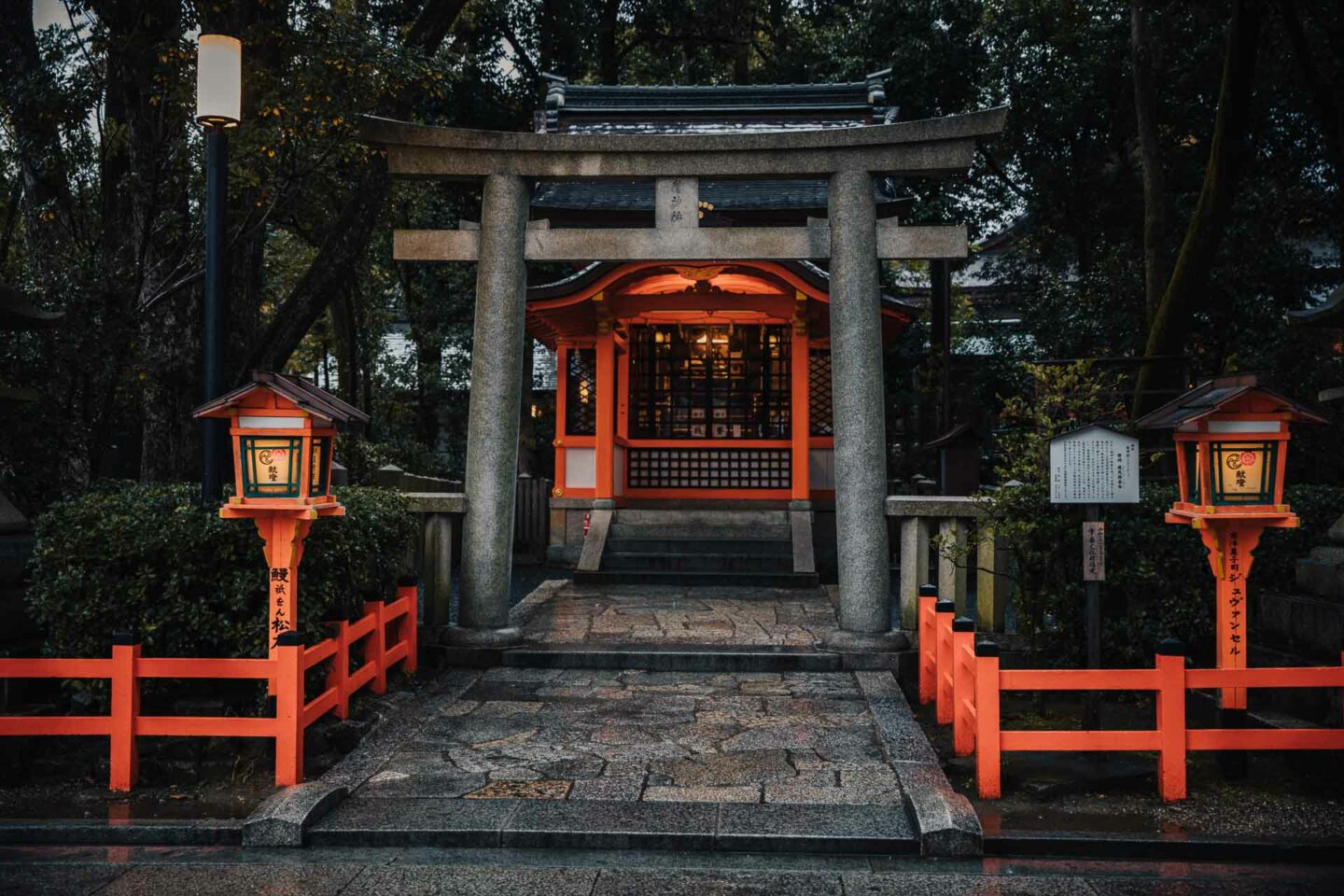
GET TRAVEL INSURANCE
Getting travel insurance should be an essential consideration when traveling in Japan. Unfortunately, accidents can happen, and it’s always best to be prepared for the worst.
Additionally, make sure you commit only to reputable companies and read the fine print carefully!
I personally use Heymondo and am very happy with their policy, coverage, and customer service. Check them out here below when planning a day trip in Kyoto.
MOBILE DATA:
When you arrive in Kyoto Japan, you’re going to want to get online, and purchasing a sim card is very simple. You can do this at the airport on arrival at one of the retail stores.
Alternatively, I recommend purchasing an eSIM in advance with pre-loaded mobile data so you can get online as soon as you land and stay connected on your trip.
Forget plastic SIM Cards… Get an eSIM!
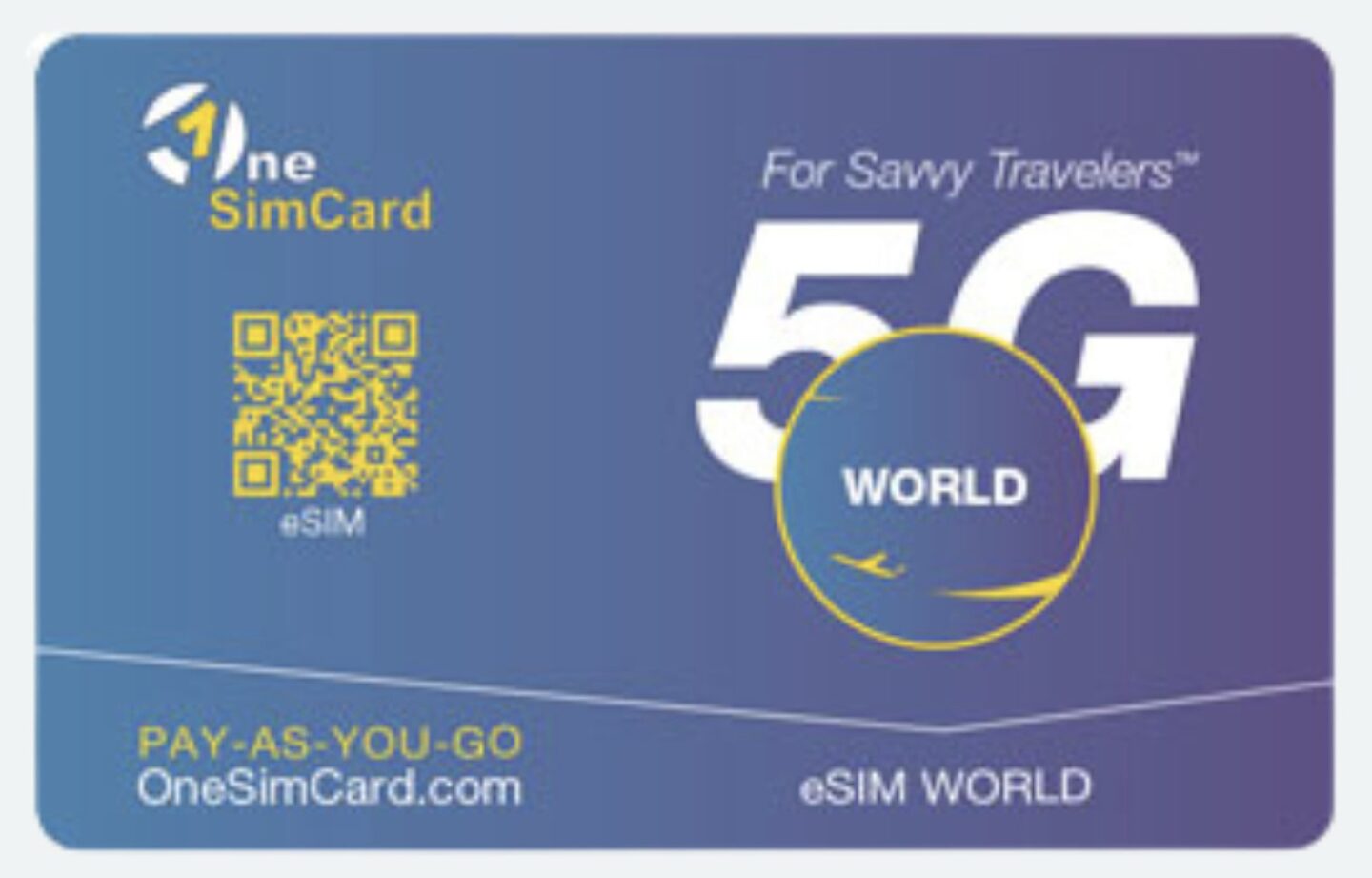
Say hello to eSIM – a virtual SIM card pre-loaded with mobile data so you can get online and stay connected around the world.
OneSimCard is the best eSIM for travel, with low-cost data packages available in 150+ countries.
Simply buy online, install it on your smartphone, and you’re good to go!
Click here or on the image below for an interactive map of Kyoto.
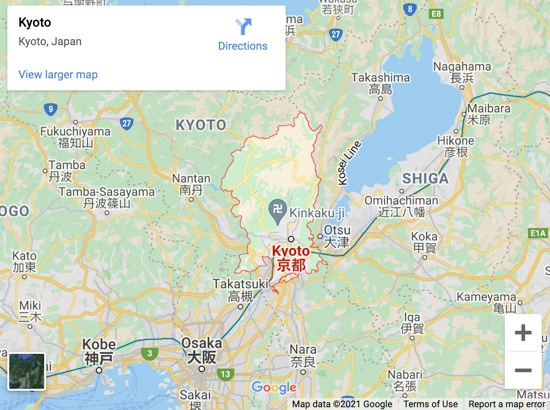
WHAT TO PACK FOR KYOTO
When planning a one day trip Kyoto, here is a list of items I highly recommend bringing with you:
Must-Have Travel Essentials
Hidden money wallet.

Keep your cash and other valuables safe with this anti-theft hidden money wallet!
Reusable Water Bottle
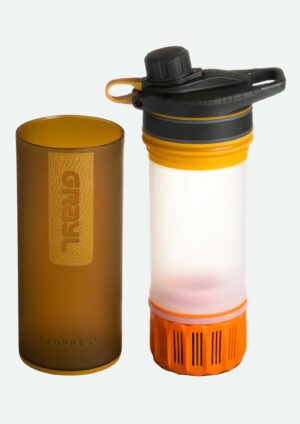
The GRAYL GeoPress is the best reusable bottle that allows you to purify water from anywhere!
Travel Backpack
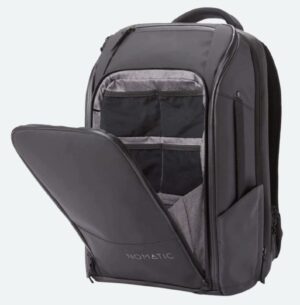
The Nomatic Travel Backpack has 20+ innovative features, perfect for everyday use!
Quick-Dry Travel Towel
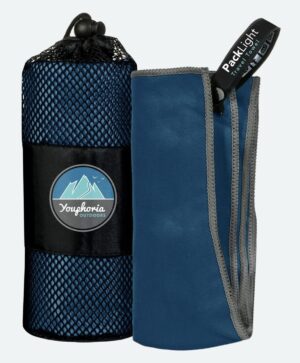
The most compact, lightweight, and quick-dry towel for traveling!
Portable PowerBank
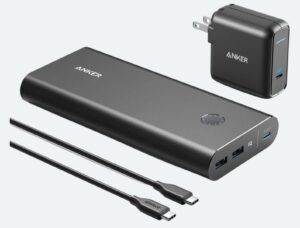
Keep your phone, laptop, and accessories charged while you’re on the go with the Anker PowerBank!
GENERAL TIPS FOR JAPAN
Most Japanese people can speak English, so if you are ever lost or need help with something you will be able to converse in English.
Also, all the signs at the airports, train stations, shopping malls, etc. are written in both Japanese and English.
The currency in Japan is Yen (¥) and the exchange rate is approximately $1 USD = 130 ¥.
There are plenty of ATMs in Japan located in the majority of convenience stores, in front of banks, inside hotels, etc. where you can easily withdraw cash to have with you during your trip.
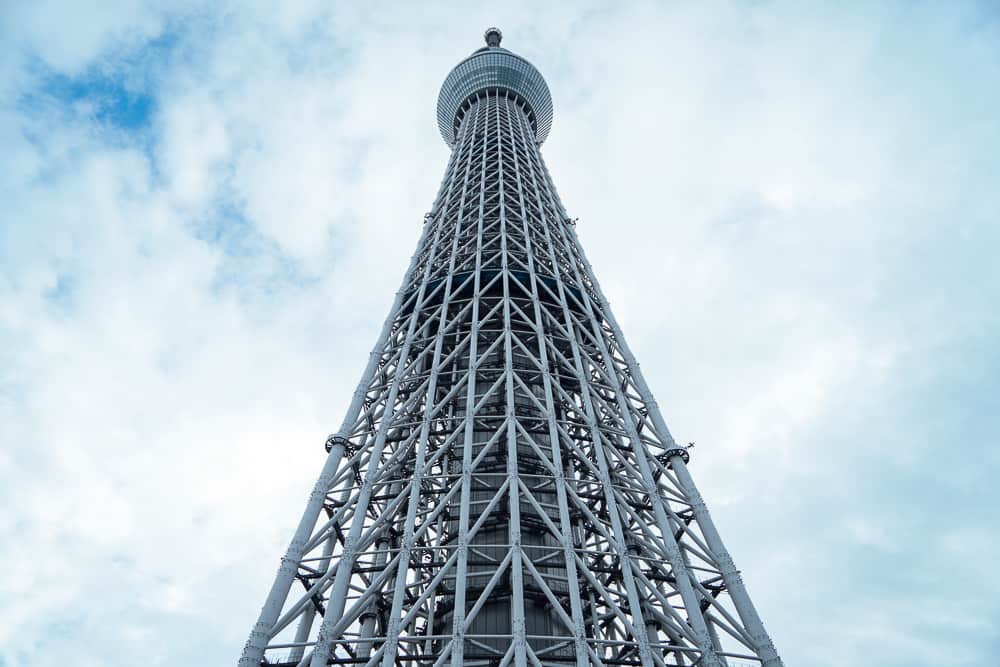
HOW TO GET AROUND JAPAN
The easiest and most convenient way to discover Japan is with a Japan Rail Pass that is valid for use on the vast majority of railways and local buses operated by JR (Japan Rail) throughout the country.
Choose between an Ordinary Pass, or choose the Green Class Pass if you’re looking to travel in more comfort with reclining seats, a footrest, extra leg space, and a travel magazine.
The JR Pass includes the Shinkansen (bullet train), Limited Express, Local Trains, Monorail, JR Buses, and the Miyajima Ferry.
You could even take a Kyoto 1 day itinerary from Osaka if you’re planning to visit both.
The Japan Rail Pass is definitely the best ticket to have when planning your Japan itinerary, and you can then take the Tokyo to Kyoto bullet train!
Travel Japan with the JR Pass!
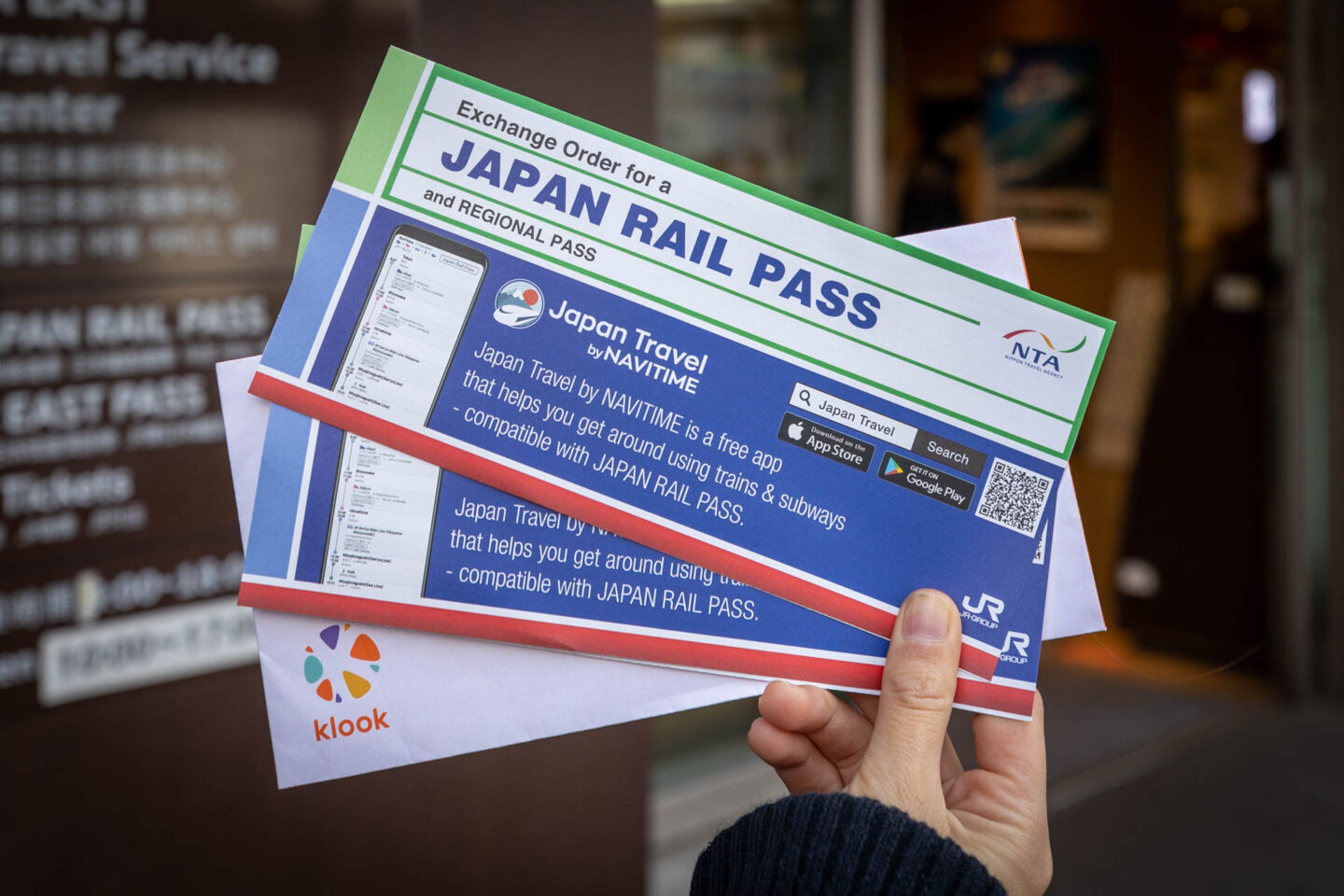
Get a 7-day, 14-day, or 21-day JR Pass for your trip to Japan and enjoy unlimited travel on trains and buses!
The JR Pass is valid on the Shinkansen (bullet train), Limited Express, Local Trains, Monorail, and JR Buses.
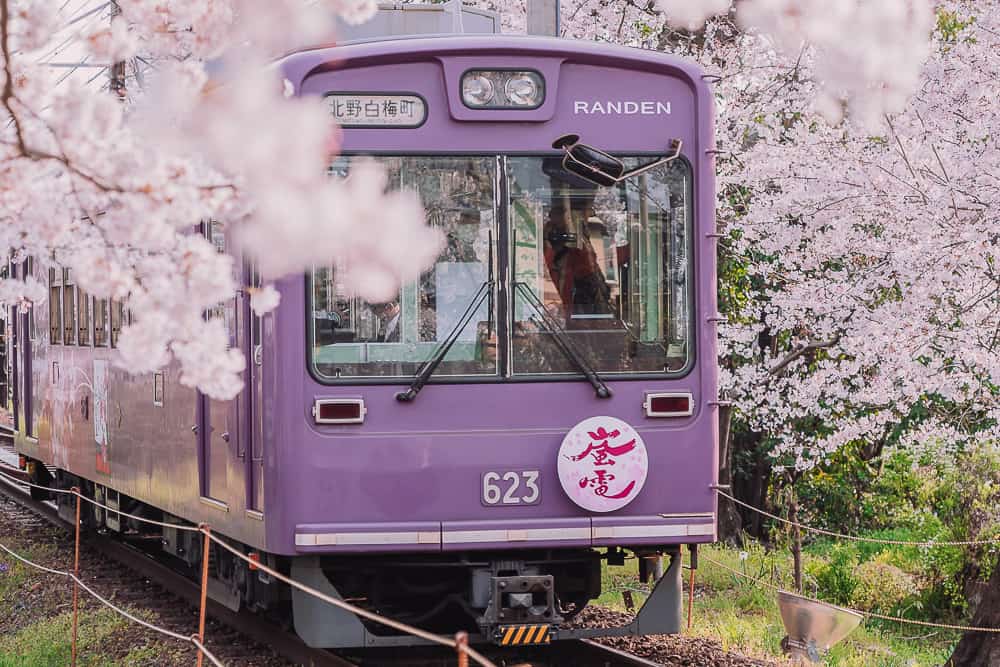
BEST TIME TO VISIT JAPAN
The best time to visit Japan depends on what you plan to do.
I personally prefer the spring and summer months in Japan (April – September) when temperatures are warm and the landscapes are vividly green.
However, visiting Japan in winter (December – March) is absolutely magical because the landscapes are completely covered in glistening white snow.
Visiting Japan in winter also means you have to opportunity to go skiing and snowboarding in Japan’s alpine regions .
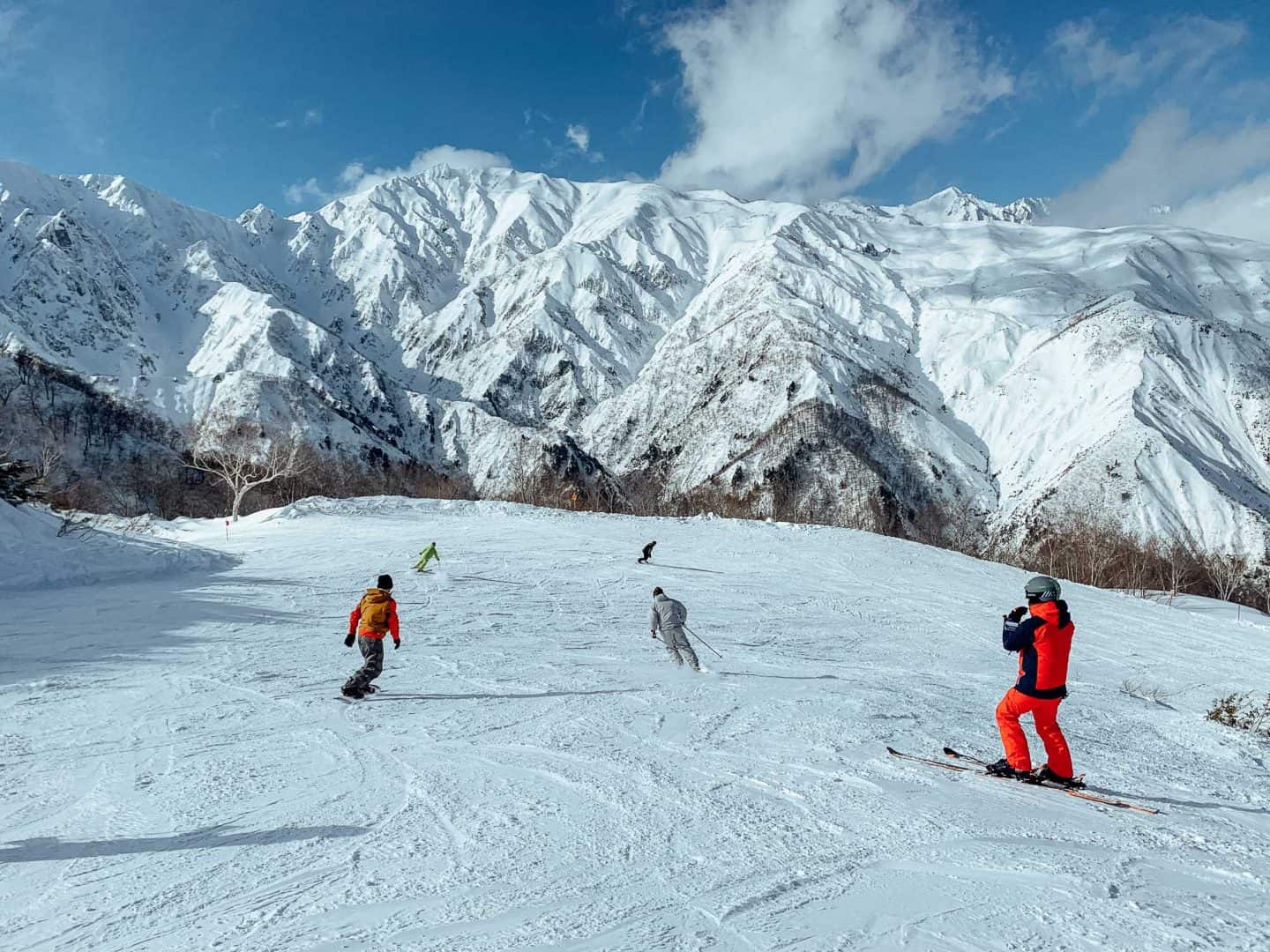
VISA FOR JAPAN
Japan is visa-free for travelers from over 65 countries and you can stay in Japan for up to 90 days on a tourist visa.
Click Here to see the full list of nationalities that are eligible for the free 90-day tourist visa.
You don’t need to apply online for this as you will be granted a 90-day tourist visa at the airport when you arrive.

More Japan Travel Guides
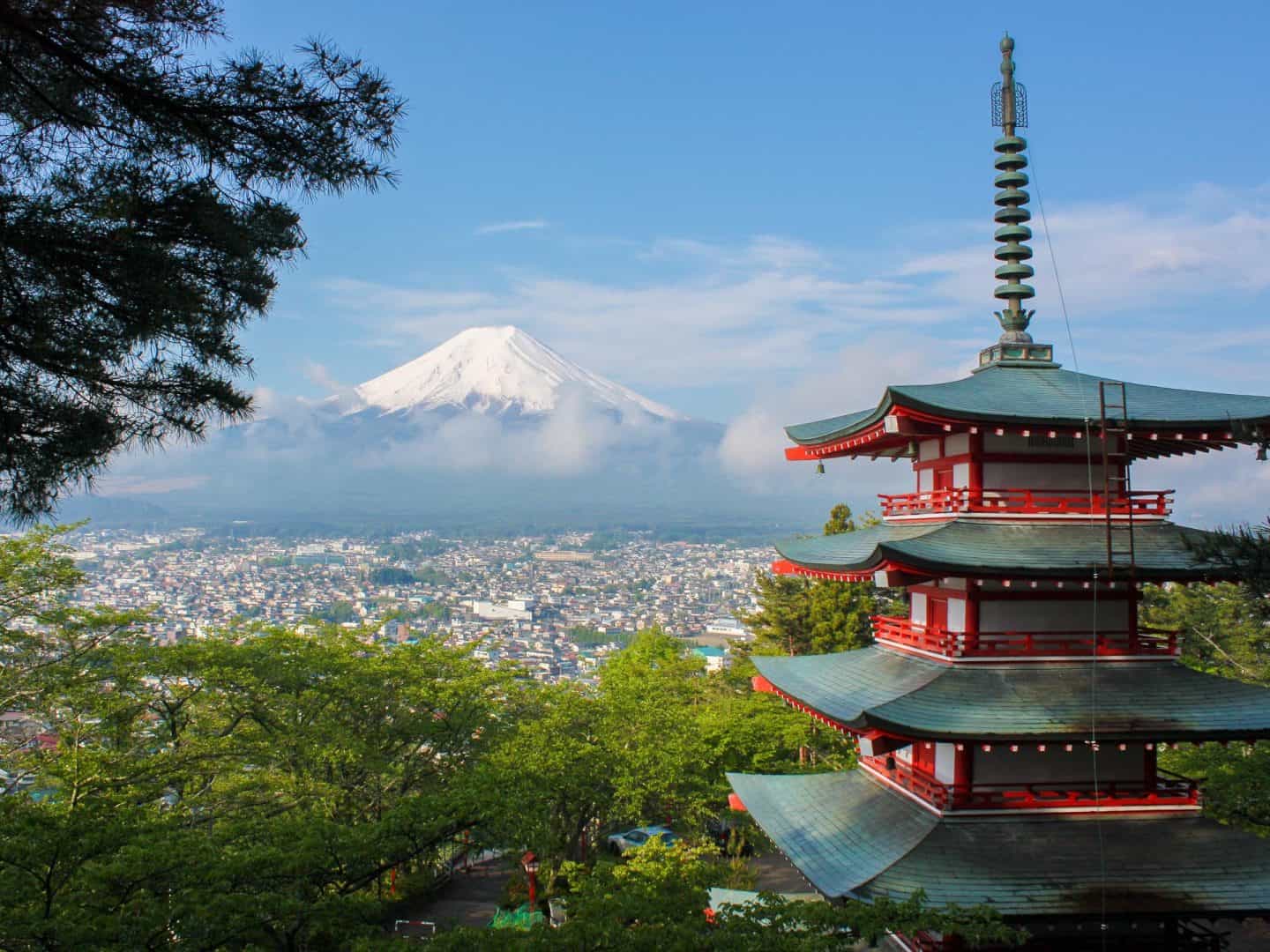
Click the button below to view all articles related to Japan!
FINAL THOUGHTS – KYOTO ITINERARY
After 7 eventful days exploring Japan, my short one day itinerary Kyoto by far exceeded my expectations!
With many fun activities to do and attractions to see, Kyoto is well worth adding to your Japan Itinerary . I guarantee you won’t regret taking a Kyoto one day trip!
If you have any questions at all about this 1 Day in Kyoto Itinerary , please leave me a comment below and I will get back to you as soon as I can.
For a quicker response, be sure to join Jonny Melon’s Travel Tribe on Facebook and post your questions or recommendations to our awesome community.

TRAVEL RESOURCES FOR YOUR NEXT TRIP
Whether you’re a seasoned traveler or it’s your first trip overseas, here are some useful travel resources to help you kick-start your next adventure!

Search and book accommodation worldwide.

Compare and book cheap flights to anywhere.

Find tickets, tours, and experiences around the world.

Book buses, trains, and transfers online in advance.

Search all rental cars in your next destination.

Need travel insurance for your next trip?
THANKS FOR READING
Hey friend, thanks for reading this guide!
Please know this post may contain affiliate links. When making a purchase through one of my links, I earn a small kickback at no extra cost to you and it’s a big help to keep the site up and running. Rest assured, I only promote products and services that I personally use and recommend.
Click here to find out how you can support the site organically .
Many thanks!
PIN IT FOR LATER
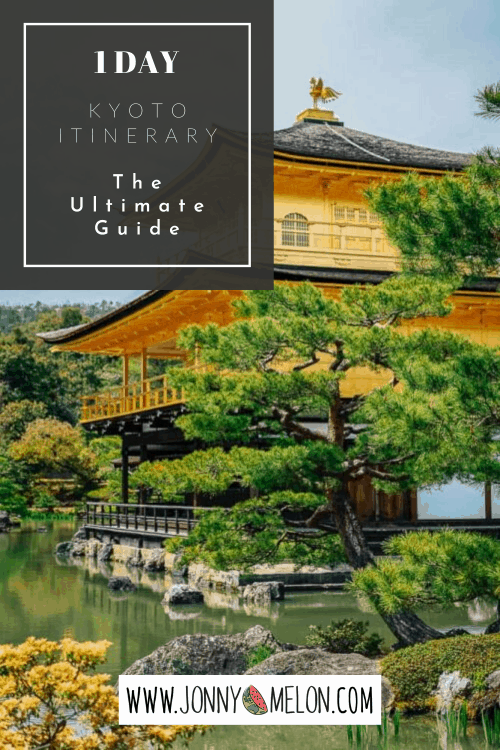
Leave a comment Cancel reply
Notify me of follow-up comments via e-mail.
Work with us
Support the site
Plan Your Trip
Travel guides
Destinations
Hotel guides
Find best tours
Travel Gear
Travel resources
How to start a blog
Photography guides
Follow On Socials
© 2024 Jonny Melon Adventure Travel Blog. All rights reserved.
Privacy Policy | Terms | Sitemap
- Media & Industry
- Meetings & Events
- Select Language 简体中文 繁體中文(香港) 繁體中文(臺灣) India (English) Bahasa Indonesia 한국어 ภาษาไทย Tiếng Việt Singapore (English) Philippines (English) Malaysia (English) Australia/New Zealand (English) Français Deutsch Italiano Español United Kingdom (English) Nordic countries(English) Canada (English) Canada (Français) United States (English) Mexico (español) Português العربية Japan(日本語) Global (English)
- India (English)
- Bahasa Indonesia
- Singapore (English)
- Philippines (English)
- Malaysia (English)
- Australia/New Zealand (English)
- United Kingdom (English)
- Nordic countries(English)
- Canada (English)
- Canada (Français)
- United States (English)
- Mexico (español)
- Global (English)
- Fujiyoshida
- Shimonoseki
- Ishigaki Island
- Miyako Island
- Kerama Island
- Tokyo Island
- Koka & Shigaraki
- Hida Takayama
- Ginza, Nihonbashi
- Beppu & Yufuin (Onsen)
- Ginzan Onsen
- Nagasaki Islands

- Kumano Kodo
- Shikoku Karst
- Amami Oshima
- Hachimantai
- Omihachiman
- Aizuwakamatsu

- Diving in Japan
- Skiing in Japan
- Seasonal Flowers in Japan
- Sustainable Outdoors
- Off the Beaten Track in Japan
- Scenic Spots
- World Heritage
- Home Stays & Farm Stays

- Japanese Gardens
- Japanese Crafts
- Temple Stays
- Heritage Stays
- Festivals and Events
- Theater in Japan
- Japanese Tea Ceremony
- Cultural Experiences in Japan
- Culture in Japan

- Local Cuisine Eastern Japan
- Local Cuisine Western Japan
- Local Street Food
- Japan's Local Ekiben
- Japanese Whisky
- Vegetarian and Vegan Guide
- Sushi in Japan Guide
- Japanese Sake Breweries

- Art Museums
- Architecture
- Performing Arts
- Art Festivals
- Japanese Anime and Comics
- Japanese Ceramics
- Local Crafts

- Scenic Night Views
- Natural Wonders
- Theme Parks
- Samurai & Ninja
- Iconic Architecture

- Wellness Travel in Japan
- Japanese Ryokan Guide
- A Guide to Stargazing in Japan
- Relaxation in Japan
- Forest Bathing (Shinrin-yoku)

- Experiences in Japan
- Enjoy my Japan
- National Parks
- Japan's Local Treasures
- Japan Heritage
- Snow Like No Other
- Wonder Around Japan

- Visa Information
- Getting to Japan
- Airport Access
- COVID-19: Practical Information for Traveling to Japan
- Anime Tourism
- Countryside Stays
- Accessible Tourism
- Hokkaido Great Outdoors
- Scenic World Heritage in Tohoku
- Shikoku’s Nature and Traditions
- Southern Kyushu by Rail

- Traveling by Rail
- How to Travel by Train and Bus
- JR Rail Passes
- Scenic Railways
- Renting a Car
- Sustainable Travel in Japan
- Travel Brochures
- Useful Apps
- Online Reservation Sites
- Eco-friendly Accommodation
- Luxury Accommodations
- Traveling With a Disability
- Hands-free Travel
- How to Book a Certified Tour Guide
- Volunteer Guides
- Tourist Information Center

- Japanese Manners
- Spring in Japan
- Summer in Japan
- Autumn in Japan
- Winter in Japan
- Cherry Blossom Forecast
- Autumn Leaves Forecast

- Japan Visitor Hotline
- Travel Insurance in Japan
- Japan Safe Travel Information
- Accessibility in Japan
- Vegetarian Guide
- Muslim Travelers
- Safety Tips

- JAPAN Monthly Web Magazine
- Arts & Cultures
- Nature & Outdoor
- Festivals & Events
- Insider Blog
- Things to do
- Local Guides
- Food & drink
- Traditional
- Hokuriku Shinetsu

My Favorites
${v.desc | trunc(25)}
Planning a Trip to Japan?
Share your travel photos with us by hashtagging your images with #visitjapanjp
24 Hours in Kyoto
Japan’s ancient capital of Kyoto is home to a wealth of culture, art as well as some 1,000 temples and shrines. Undoubtedly, 24 hours in Kyoto is an inadequate amount of time to marvel at all the city has to offer, but this walking itinerary is an excellent way to discover some of its highlights.

Heian-jingu Shrine is a must-visit, even when you're short on time in Kyoto
8:30 am – Ginkaku-ji Temple
Early-morning starts pay off in Kyoto , especially during the peak seasons of spring and autumn. Start your explorations of the ancient capital by heading to Ginkaku-ji , the so-called Silver Temple, located in the Higashiyama hills. Despite the name, the temple may never have been coated silver, as was the wish of the man who built it, the shogun Ashikaga Yoshimasa. Ginkaku-ji dates back to 1490 and is one of the most important monuments to Zen architecture in the city.
The grounds are delightful, and there is always something in bloom, whether camellias or azaleas, the year-round. Souvenir boutiques line the hill path up to the temple, including a kiosk peddling the famous Shogoin Yatsuhashi sweet, a parcel of cinnamon-flavored, glutinous rice with a variety of fillings.

Honen-in Temple's mossy thatching concealed behind foliage makes it a magical spot to visit
9:30 am – Philosopher’s Path
Return to the foot of the hill, and just to the south, you will encounter the trailhead of the Philosopher’s Path, named after the influential professors who taught nearby and took regular, contemplative strolls along the canal here. With some 300 cherry trees along the way, it’s crowded with people during the first week of April but is relatively serene the rest of the year. Several temples and shrines dot the hills along the way, but it is worth veering off the path to pay a visit to Honen-in. This 17th-century temple, shaded by forest, is a haven of moss that grows even on the thatch of the front gate. Local artists often host exhibitions here.
It takes roughly another 30 minutes to reach the end of the path, where your journey continues by road.

The historic Nansen-ji Temple is best known for its impressive gate
10.30 am – Nanzen-ji Temple
Nanzen-ji was once one of the most important temples in Japan, but now its monumental, 22-meter-high Sanmon Gate steals the limelight. It was built in 1620 by one of the generals of the first Tokugawa shogun to appease the souls of those perished in the siege of Osaka Castle and harbors several legends surrounding the fugitive, Ishikawa Goemon. You can climb up the many stairs to where Ishikawa supposedly took refuge until he was caught and, as the story goes, boiled in a pot of oil by the Kamo River. Stop by the Roman-style aqueduct in the northeast corner by the abbot’s hall, which was part of an ambitious 1890s project to bring Kyoto a supply of water from the nearby Lake Biwa, and feels somewhat out-of-place in a temple complex.
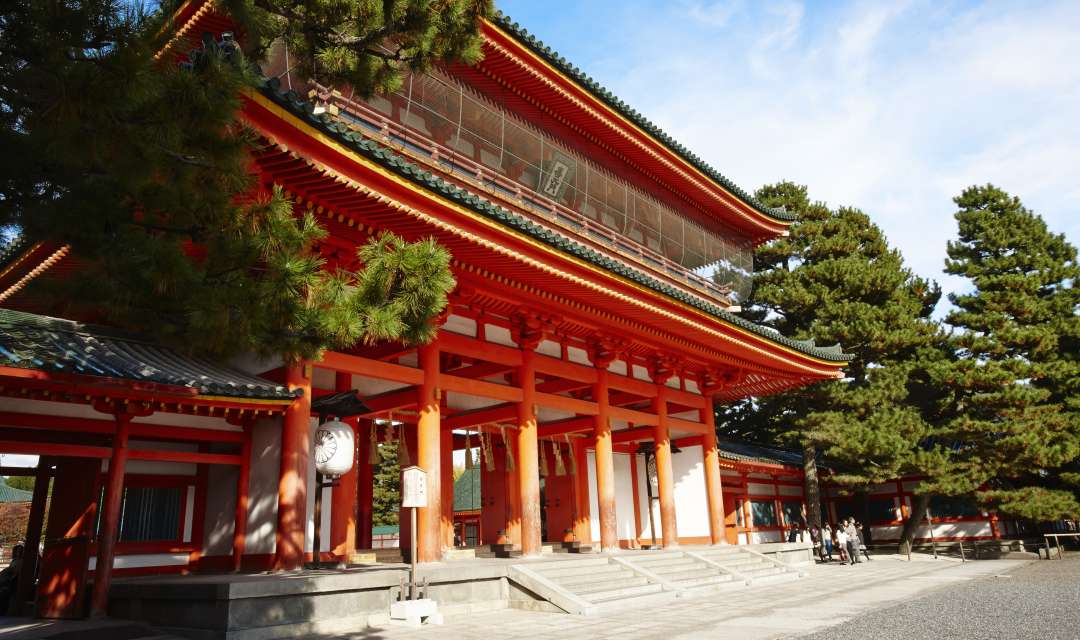
Heian-jingu Shrine's gardens are unmissable when in Kyoto
11.30 am – Heian-jingu Shrine
Leave the Nanzen-ji precincts and walk in the direction of the canal for another 20 minutes to the red torii gate that leads up to Heian-jingu Shrine . This 1895 replica of the original imperial palace (albeit not on the original site and a bit smaller) was built as a Shinto shrine to commemorate two of Japan’s emperors, who were the first and last to reign out of Kyoto. It also has wonderful gardens with expansive ponds and is a favorite for herons and egrets. Theatrical Noh performances by firelight take place in the large shrine courtyard in the summer.
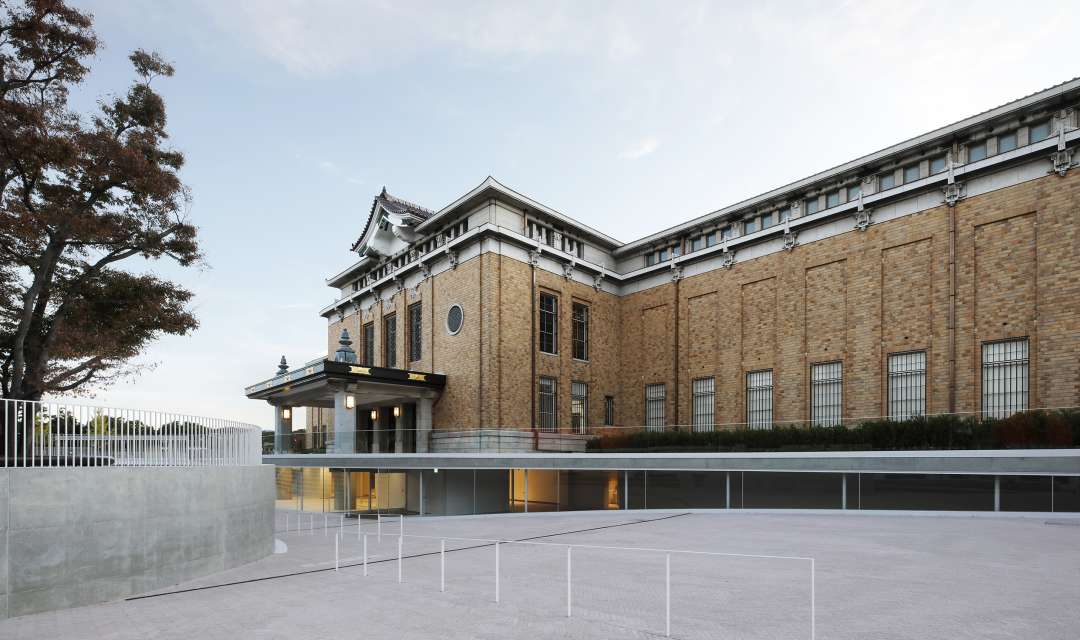
Photo: Takeru Koroda. Courtesy of Kyoto City KYOCERA Museum of Art
12.30 pm – Okazaki area
The leafy Okazaki area has been transformed in recent years with the pedestrianization of the stretch up to Heian-jingu Shrine. It is host to many food and antique market events between the spring and autumn, so the chances that you will encounter an event are high. Why not spend your lunch hour here and picnic outside on a beautiful day? The area hosts numerous museums, including the Kyoto City KYOCERA Museum of Art, due to reopen in spring 2020, the Hosomi Museum and The National Museum of Modern Art. One that is hidden away but worth a visit is the Fureaikan Museum, on the basement floor of the Miyako Messe expo hall, which provides a comprehensive look at the rich craft cultures of the region, and often invites local artisans to come and work in the museum for the benefit of visitors.
2 pm – Shirakawa Canal and Gion
Wander south of Okazaki Park, and you will find another charming, willow-lined waterway with quaint stone bridges. Following the Shirakawa for about 30 minutes, you will eventually reach the geisha and entertainment district of Gion . A picturesque scene unfolds at the stretch on Shinbashi Street, where the gently-flowing canal ends. In this area, you will find the beautifully-preserved teahouses that host the exclusive geisha receptions, as well as the shrine of Tatsumi Daimoyojin, dedicated (appropriately) to the goddess of the arts.

Shijo Street is a pretty, leafy street full of boutiques
3 pm – Shijo Street
Just further south of, and parallel to Shinbashi Street is Shijo Street, a hugely popular destination for shopping. The shopping continues on the other side of the Kamo River, with more familiar brand names and large department stores where you can pick up a delectable bento box for dinner at one of the underground food courts.
About the author
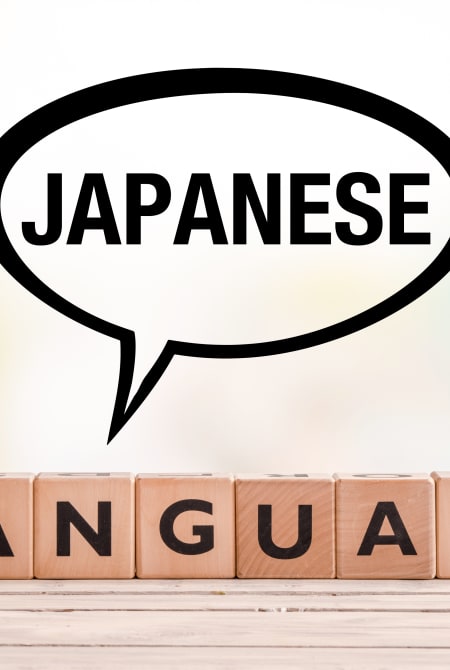
Lucinda "Ping" Cowing is an Asia travel specialist, and director at the award-winning, non-profit magazine, Kyoto Journal. She lives a nomadic existence, moving between Japan, Taiwan and Portugal.
- Local Guides (43)
- Culture (26)
- Things to do (24)
- Outdoor (22)
- Food & drink (13)
- Traditional (12)
- Adventure (10)
- City life (10)
- Global site (3)
- Tradition (2)
- Consumer (2)
- Outdoors 22
- Tradition & Culture 16
- Food & Drink 11
- Itineraries 11
- Food & drink 6
- Virtual travel 5
- Travel hacks 4
- Manga & Anime 4
- Tradition 3
- Tradition&Culture 3
- Arts & Cultures 2
- Tradition and Culture 2
- Caleb DeMarais (9)
- Brock Kuhlman (8)
- Melanie Sweeney (6)
- James Hadfield (5)
- Alison Beale (5)
- Michael Lambe (5)
- Richard McCracken (4)
- Donny Kimball (4)
- David McMahon (4)
- Julian Ryall (3)
- Rebecca Carlton (3)
- Lucinda Cowing (2)
- Kristopher Spencer (2)
- Jeremy Kuhles (2)
- Jamie Lee Reed (2)
- Aidan McFarlane (2)
- Ashleigh Leyshon (2)
- Lissa Carandang-Sweeney (2)
- Jim Rion (2)
- Gaby Doman (1)
- Ashley Owen (1)
- Andrew Echeverria (1)
- Michael Sosnick (1)
- Kirsty Munro (1)
- Erin Kessler (1)
- Sarah Sommer (1)
- Previous Article
- Back to Overview
- Next Article
Please Choose Your Language
Browse the JNTO site in one of multiple languages
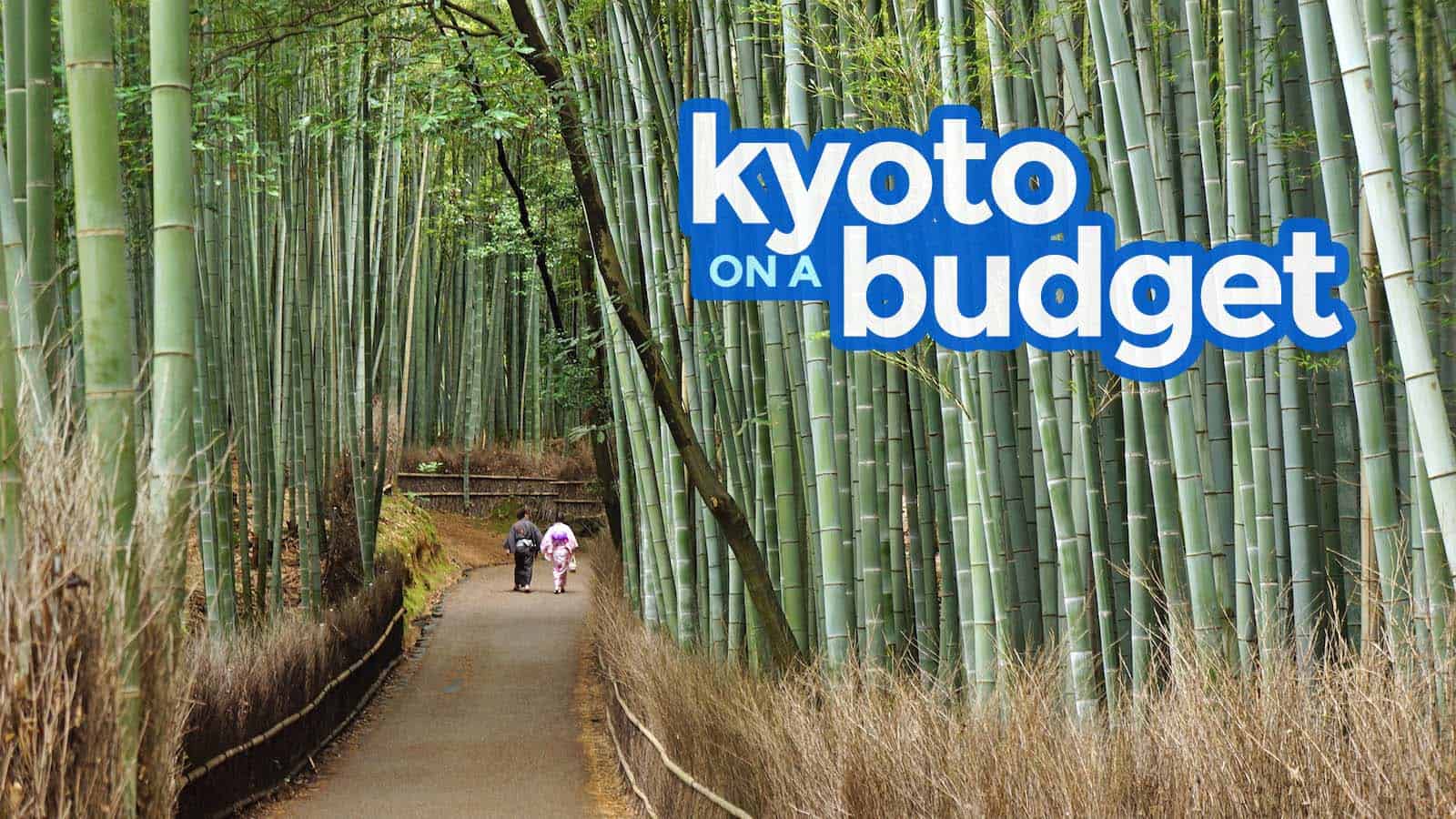
KYOTO TRAVEL GUIDE: Budget Itinerary, Things to Do

It was mid-summer when I set foot in Kyoto for the first time. The deciduous forest of the Arashiyama district was very lush and green, awfully green. Green is great; I love green. But as a guy who hailed from a tropical island carpeted in evergreen rainforests, it was not really the color I was excited to feast my eyes on. The longer I walked, the more I realized that it was a mistake booking June tickets to Japan. What was I thinking? Was I even thinking when I booked it? But kicking myself in the butt lasted for only a minute. Summer may not be the best time to be here, but the proverbial silver lining appeared amidst the greenery. There were fewer tourists, and the weather was pleasant, perfect for a long afternoon walk.
That or I was just mastering the art of sweet lemoning.
Before that trip ended, I did what every other typical travel blogger does when writing about a place they enjoyed tremendously: make a solemn pledge to return. And return I did. Multiple times. Because I’m typical like that. LOL.
WHAT'S COVERED IN THIS GUIDE?
Understanding Kyoto
Kyoto is the capital of Kyoto Prefecture, which is part of Japan’s Kansai Region (along with Osaka, Nara, Hyogo and a few others).

Today, Japan’s seat of power is Tokyo. Yet, Kyoto is still the cultural core of the archipelago. Kyoto remains home to impressively maintained and restored ancient temples and shrines. When most major cities in Japan have shifted to highlighting its modern and futuristic attractions, Kyoto remains steady in its dwelling in the past and flaunting its cultural heritage. Kyoto pulsates at its own pace, a bit slower but curiously mesmerizing.
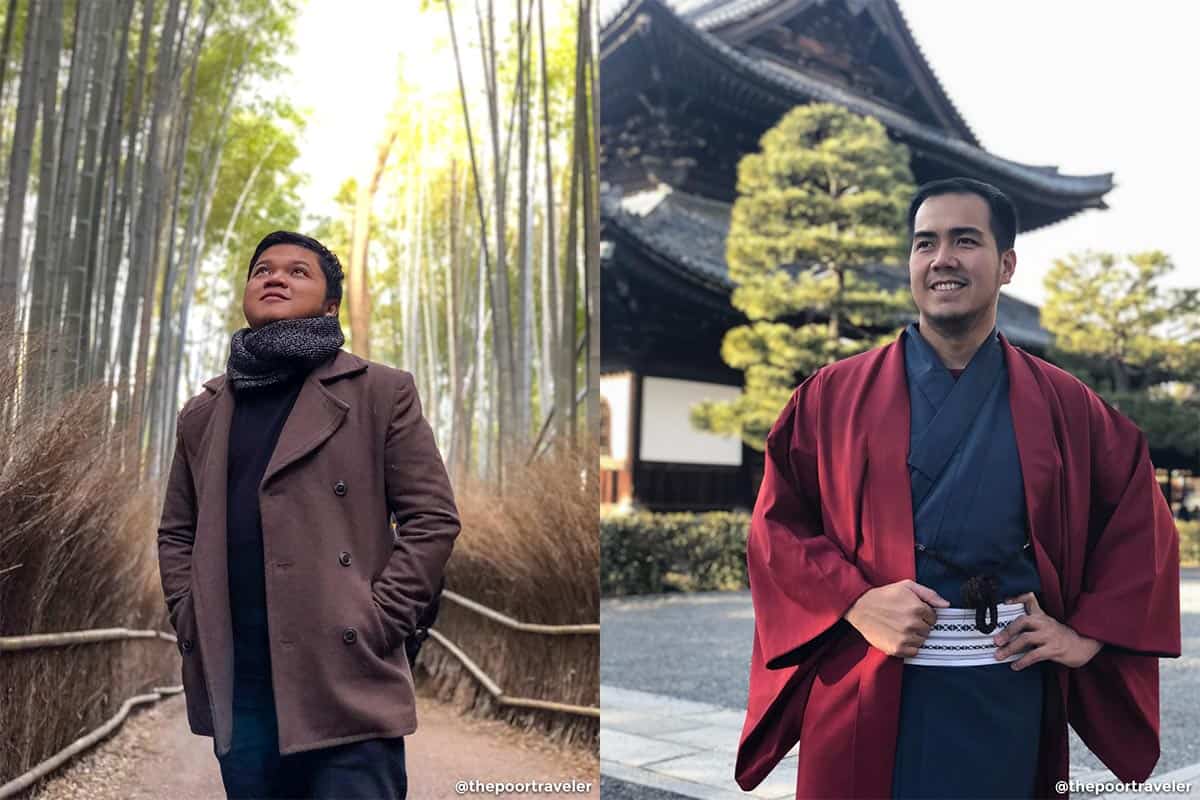
Other info you need to know:
- Language: Japanese (Nihongo). The majority of the locals seldom speak English, but most of the signs and other tourist promotional materials have English translations.
- Currency: Japanese Yen (JPY, ¥). JPY 1000 is around USD 9.36, EUR 7.60, PHP 484 (as of February 2018).
- Money Exchange. There are a lot of money changers throughout Osaka and Kyoto, but save yourself the trouble and just exchange currencies before your trip. SANRY’S has good rates. You can also withdraw from ATMs when you’re there, but they’re pretty hard to find. Most of the ATMs we saw didn’t accept international cards.
- Modes of payment: Most establishments prefer cash payment, but many of them also accept credit card transactions.
- Electricity Info : 100V, 50/60 Hz. Type A sockets. Plugs have two flat pins. Type B is sometimes used but not that common.
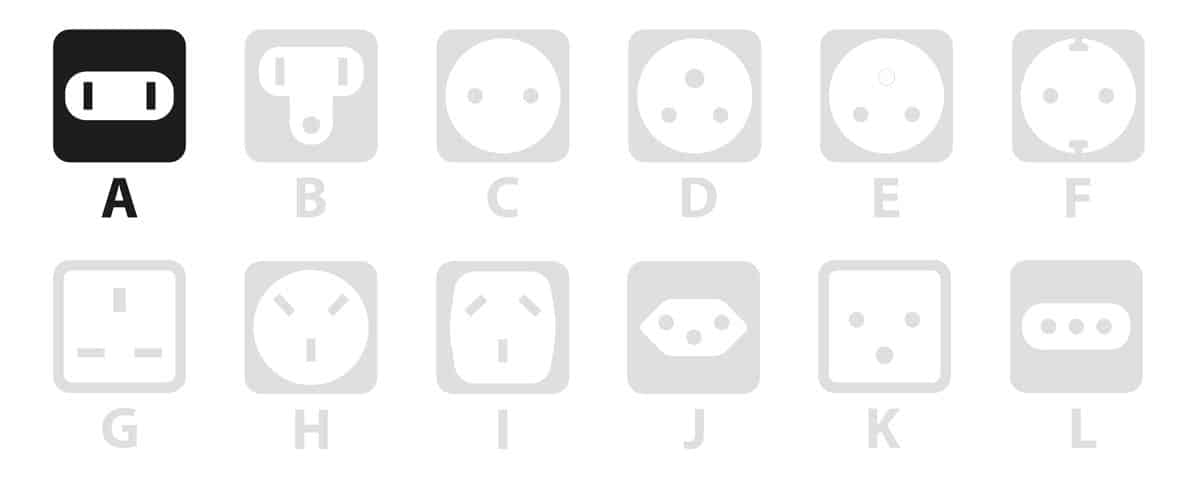
When is the Best Time to Visit Kyoto?
Every season highlights a different side of Kyoto: clad in the fiery colors of autumn, dressed in white snow in winter, adorned with the pink glow of cherry blossoms in spring, and, finally, drowned in a sea of verdancy in summer. Each has its own pros and cons, but if you’re after visual spectacle, these two will be your best bets:
- Late March to early April for the cherry blossoms
- Mid- to late November for the colors of fall
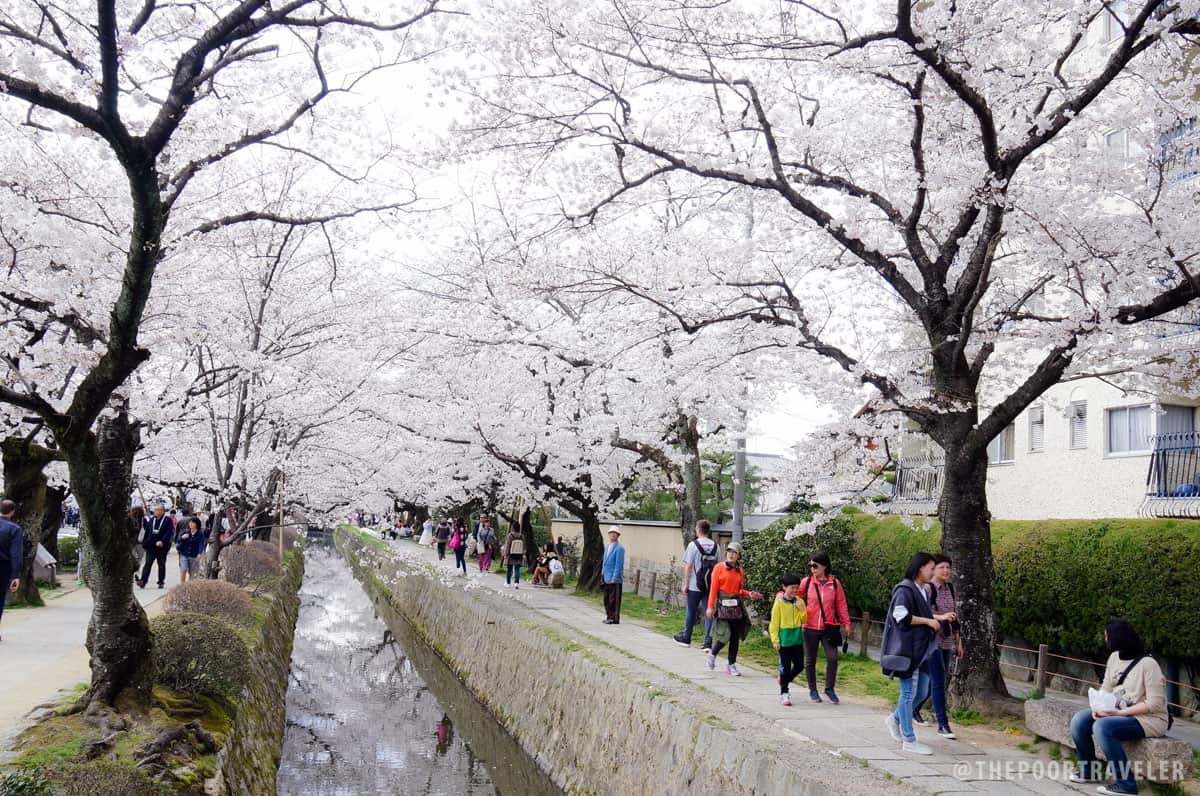
Spring is also the beginning of peak season, when cost of flights and hotel rooms begin to rise. Yes, the sakura experience is magical, but prepare to shell out more dough and share the place with a bigger crowd.
Summer is also part of the peak season. If you’re from the tropics like me and you want to explore in an atmosphere different from what you’re used to, stay away from the summer months. Not only are these months crowded, they can also be too hot. Longer days also mean you have more hours of daylight, more time to explore, and more opportunities to take wonderful photos.
Autumn is a great time to be in Kyoto because this is when the prices drop, crowds thin, and foliage turns fiery orange and red. Temperature is also pleasant and comfortable for sightseeing.
Winter is great for budget travelers because airfares are lowest at this time. However, establishments tend to open later and close earlier.
You might also want to avoid these dates:
- Golden Week (April 29 – May 5)
- Obon Festival (August 13–15)
- Cherry Blossoms Season (Late March-Early April)
These dates bring the biggest crowds and steepest prices.
How to Get a Japan Visa
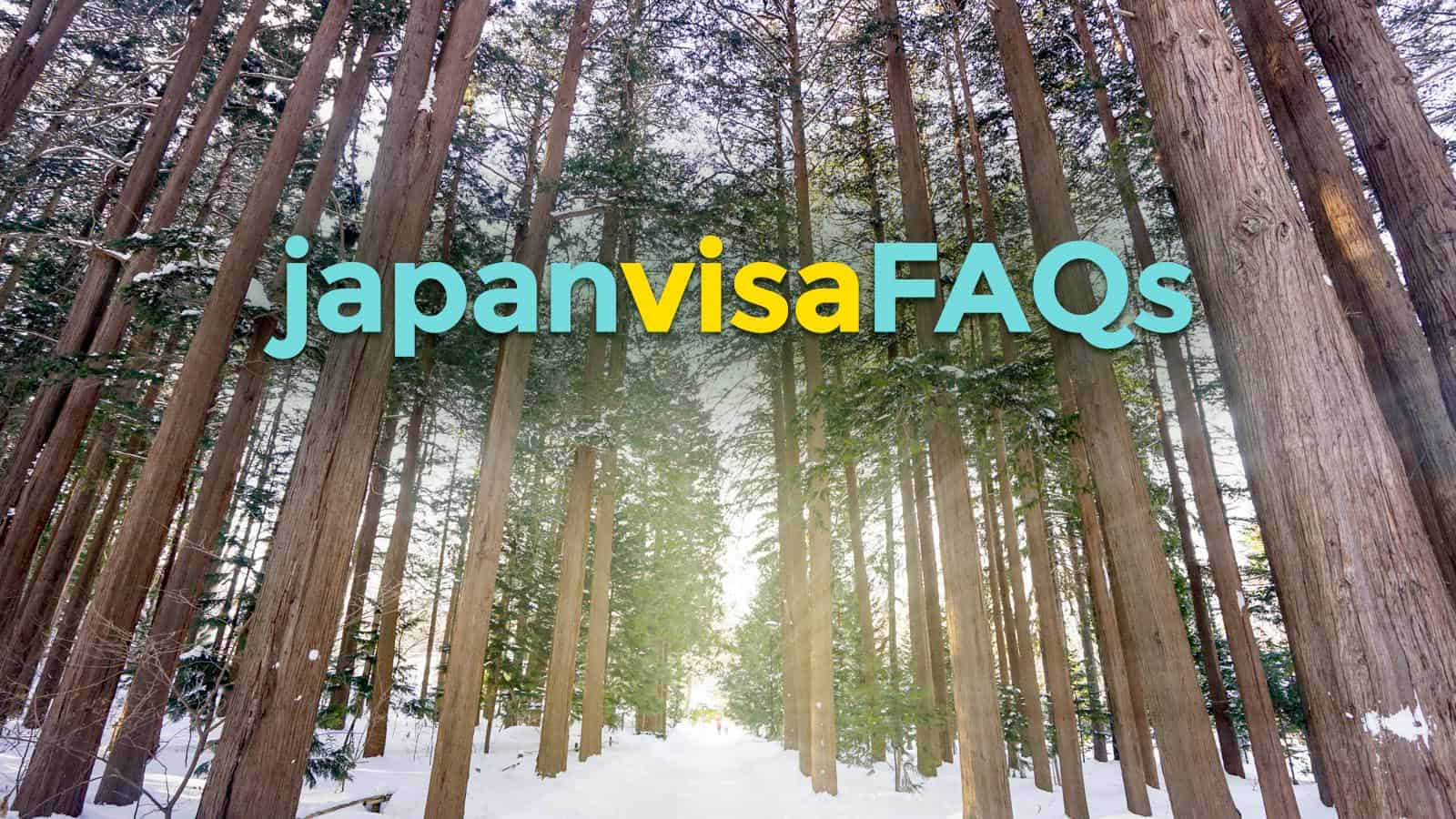
If you’re from the Philippines, the posts below will help you get through the application process.
- How to Apply for TOURIST Japan Visa
- How to Apply for a Visa for VISITING FRIENDS or RELATIVES
- How to Apply for a MULTIPLE Entry Japan Visa
- Japan Visa Frequently Asked Questions
How to Get to Kyoto
Manila to kyoto.
Kyoto Prefecture doesn’t have its own airport, but the regions’s primary gateway, the Kansai International Airport (KIX), is just 1.5 hours away.
A lot of airlines fly from Manila to Kansai Airport. If you book way in advance, you’ll get the best deals from Cebu Pacific Air. Cebu Pacific flies to Osaka five times a week. Their lowest year-round fare is at P6399, which is a great deal already.
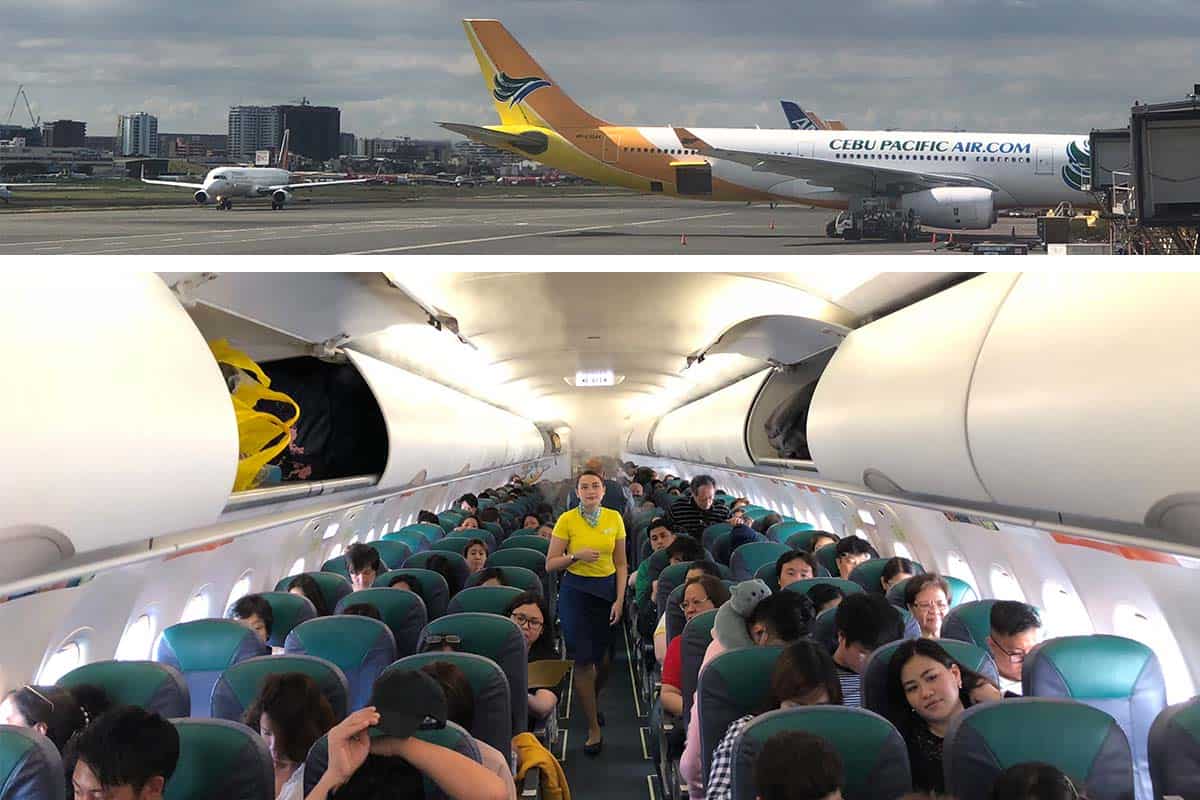
You can also wait for a SEAT SALE! For one of our trips, I was able to score a roundtrip Cebu Pacific ticket from their P20 SALE. The base fare per leg was only P20, but including all the taxes, I only paid PHP 5984 for the roundtrip ticket (PHP 2992 per way). That includes a prepaid baggage allowance of 20 Kg. Not bad. Not bad at all.
Search for cheap flights here
Kansai airport to kyoto.
Kyoto is only 1.5 hours from Kansai Airport by train, longer by bus.
There are many routes you can take to get to Kyoto from Kansai airport, but many of them entail multiple transfers. What I recommend is taking the Limited Express Haruka Train that will take you straight to Kyoto from the airport.
Limited Express Haruka Travel time: 80 minutes Regular Fare: ¥1880 + ¥970 (seat fee)
You can save a lot of money in two ways:
- JR West Kansai Pass . If you’re planning on visiting multiple cities within Kansai Region in a few days, this is great for you because you can enjoy unlimited rides to most JR lines including the Haruka train to Kyoto . More info about the Kansai Pass here .
If you decide to purchase either the West Kansai or ICOCA via Klook, here’s how to use them.
- Book a ticket with Klook.
- When the transaction is complete, you will be emailed a mobile voucher. Print it out or save it on your phone.
- On the day of your trip, upon arrival at Kansai Airport, find the HIS Counter at the Arrival Hall. There is usually a small KLOOK logo displayed in front of the counter. Show your mobile voucher to the staff. – If you booked an ICOCA Card, you will be given the actual ICOCA card. – If you booked a JR Kansai Pass, you will be given a physical voucher.
- Proceed to the Train Station on the second floor of the building opposite the Arrival Hall. Find the JR Ticket Counters. – If you booked an ICOCA Card, tell the staff you’re booking a Haruka Train and show your ICOCA card to avail of the discount. Prepare to pay ¥1600. – If you booked the JR Kansai Pass, exchange the voucher given to you for the ACTUAL JR KANSAI PASS.
- Enter through the JR Gates of the Station.
- Check your platform on the screens around the station. Go to the designated platform and board the right train.
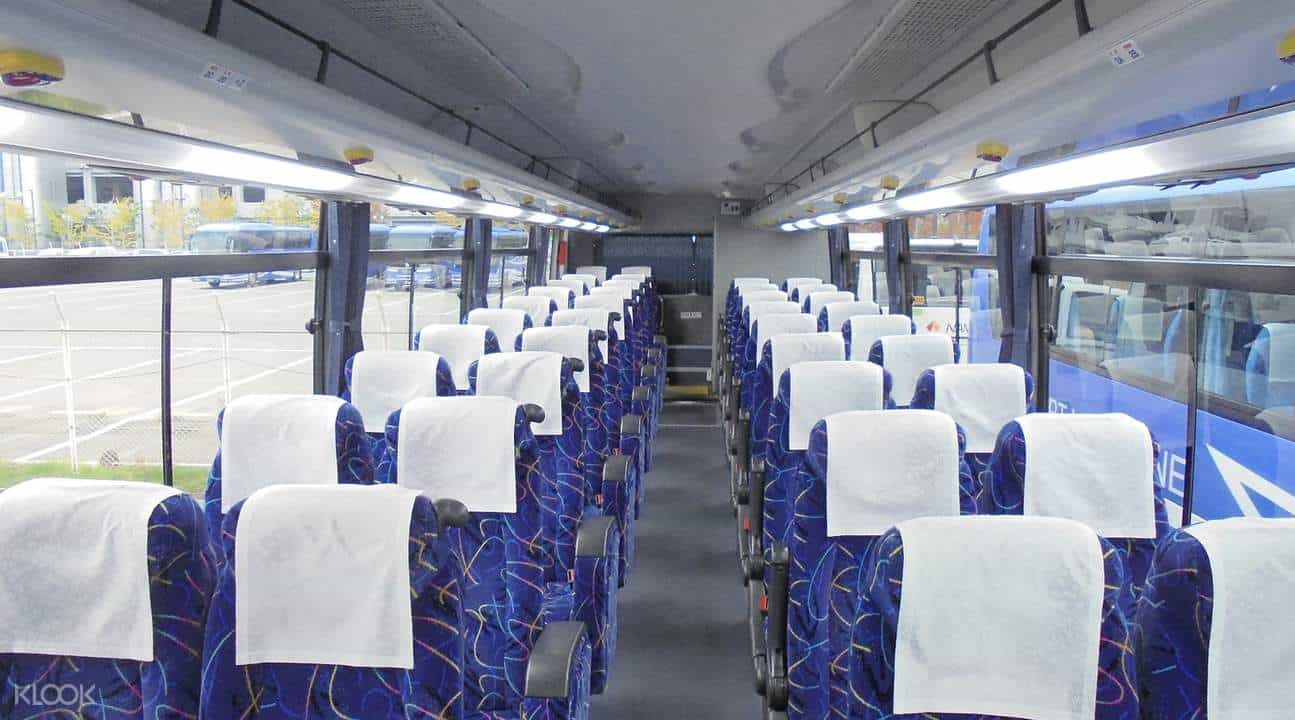
Klook also offers the cheapest bus tickets to Kyoto from Kansai Airport.
KIX Airport Limousine Bus Operating hours: 6:05am-11:40pm Travel time: 90 minutes Fare: ¥1098
Make sure you read the instructions after booking. But right now, this is how to claim this ticket:
- When the transaction is complete, you will be emailed a mobile voucher. You can print it out or save it on your phone.
- On the day of your trip, upon arrival at Kansai Airport, find the EASYGO or HIS Counter near the North Exit at the Arrival Hall of Terminal 1. There is usually a small KLOOK logo displayed in front of the counter. Show your mobile voucher to the staff. You will be asked for your passport. Then, you will be given the bus ticket.
- The staff will tell you the platform where you can board the bus. Just follow them and board the bus to Kyoto.
That’s it! Welcome to Kyoto!
Where to Stay in Kyoto
Which part of the city is best for travelers? Definitely, the area surrounding Kyoto Station.
Kyoto Station is the heart of the city. It is impossible to explore Kyoto without setting foot in its vicinity. One way or another, you’ll find yourself here, whether you’re catching a train or bus or looking for a place to eat. Hence, the closer you are to the central station, the more convenient and hassle-free your trip will be.
Here are some of the best hostels and guesthouses near Kyoto Station, as ranked by Agoda users (as of March 2018). I was able to try K’s House myself, and it was a delightful experience.
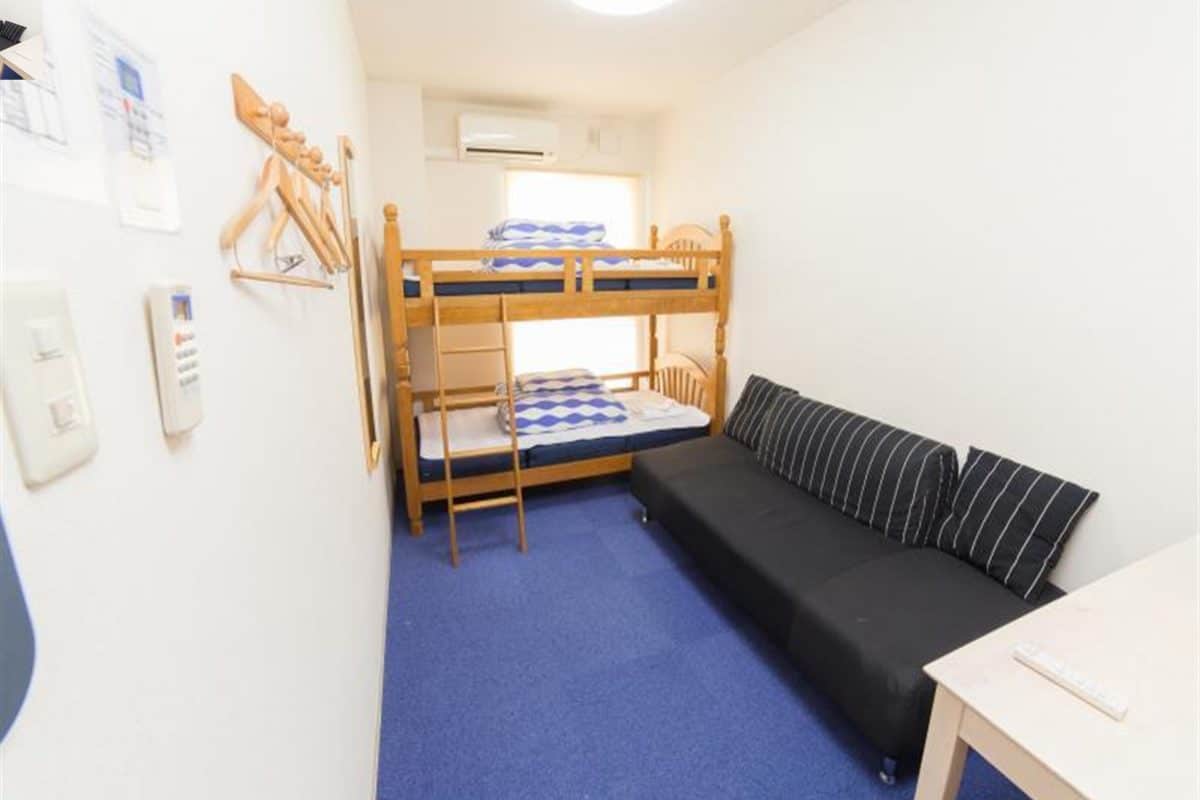
- K’s Guesthouse Kyoto . CHECK RATES & AVAILABILITY .
- Tomato Kyoto Station . CHECK RATES & AVAILABILITY .
- Daiya Ryokan . CHECK RATES & AVAILABILITY .
Search for more Kyoto Hotels!
Internet connection in kyoto, pocket wifi rental.
You will find wi-fi rental booths at the Arrival Area of Kansai Airport. Rates are usually between JPY 800-900 per day. However, they are very in demand so there might not be any more available if you arrive in the late afternoon or evening. Some establishments accept only credit card transactions.
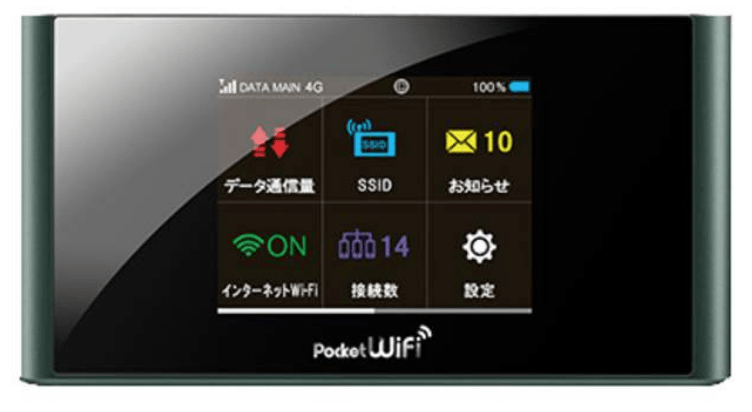
If you really want to make sure you get a mobile wifi, you can reserve one in advance via Klook for only PhP 389 per day for unlimited 4G access. That’s a lot cheaper than those you will find at Kansai airport. The best part, if you’re a group, you can connect multiple devices hassle-free. You can then split the cost with your friends. You can pick up the device at the airport. No deposit is required .
If you opt with a 4G Data SIM, you can choose between two packages: unlimited 4G data for 8 days (around ¥3360) and 3GB data for 8 days (around ¥2160). If you’re a heavy data user, best to go with the Unlimited Plan. You can pick up the SIM card at Kansai Airport.
How to Get Around Kyoto
Almost every key tourist attraction in Kyoto is accessible by train. Hence, if you become familiar with the train system, you’re good to go. But it’s not that easy.
Kyoto Station alone is massive. It is a behemoth of a terminal. Train and subway lines operating to, from and around the city converge here. You have to make sure you’re on the right platform and you’re boarding the right car of the right train. A few trains split into two at one point and part ways. You don’t want to be on the wrong car.
One thing that has proven helpful to me again and again is Hyperdia. It’s a web-based search engine that would tell you train schedules and routes instantly. Just make sure you know the closest train station to your destination and let Hyperdia do the rest. Here’s more info : HOW TO USE HYPERDIA .
There are also train passes that will make your journey more hassle-free.
Below is a quick overview of these passes. We have a more detailed post here: KANSAI PASSES: WHICH IS BEST FOR YOU?
JR Pass is a good option if you’re on a multi-city journey across Japan. But here’s the caveat: It only makes sense for multiple long-distance travels. If that’s not clear enough, let me stress that even more. MULTIPLE LONG-DISTANCE travels. For example: Osaka-Tokyo-Sapporo or Tokyo-Osaka-Hiroshima-Fukuoka.
If that sounds like the trip you want to take, then go ahead. Get a JR Pass. Note, though, that you can’t purchase a JR Pass in Japan because it’s offered only to foreign tourists. Thankfully, you can book via Klook. If you live in the Philippines, the pass will be delivered to you in 7 days.
Klook offers the cheapest JR Passes available.
JR West Kansai Rail Pass
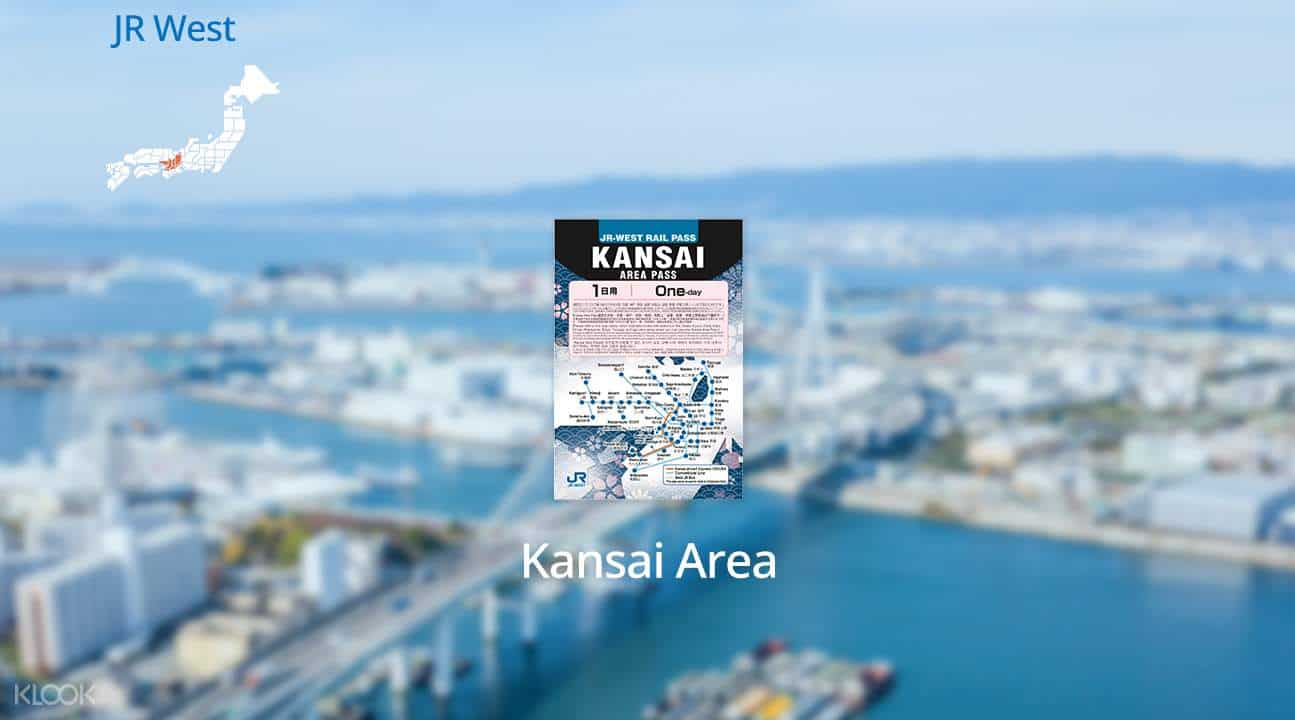
If you’re planning to visit places that are relatively close to each other — like Osaka-Nara-Kyoto — this is what you need, not a (nationwide) JR PASS.
This pass offers unlimited rail and bus rides to and in many cities in Kansai Region including Osaka, Kyoto, Kobe, and Nara. You can also use this to travel from Kansai Airport to Osaka and back. Available in 1-, 2-, 3- and 4-day validity variants.
Note that this pass is only accepted on JR Trains.
Do you need this pass?
- If you plan on staying within Kyoto and not visiting other cities, this is not for you. Just get an ICOCA Card or single-journey tickets at the station.
- If you plan to visit Kyoto, Nara, Kobe or other cities in Kansai, this could be great for you.
IMPORTANT! You can’t buy this pass in Japan. You have to purchase ONLINE. This pass is meant for foreign nationals traveling as a temporary visitor (tourist) in Japan. You can book online below:
Kansai Thru Pass
Offers unlimited rail and bus rides in many cities in Kansai Region including Osaka, Kyoto, Kobe, and Nara. You can also use this to travel from Kansai Airport to Osaka or Kyoto. JR Lines are not covered, though.
Available in 2- and 3-day validity variants.
The ICOCA Card isn’t a pass. It’s a prepaid IC card. It’s sort of Kansai’s version of Tokyo’s SUICA or PASMO Card.
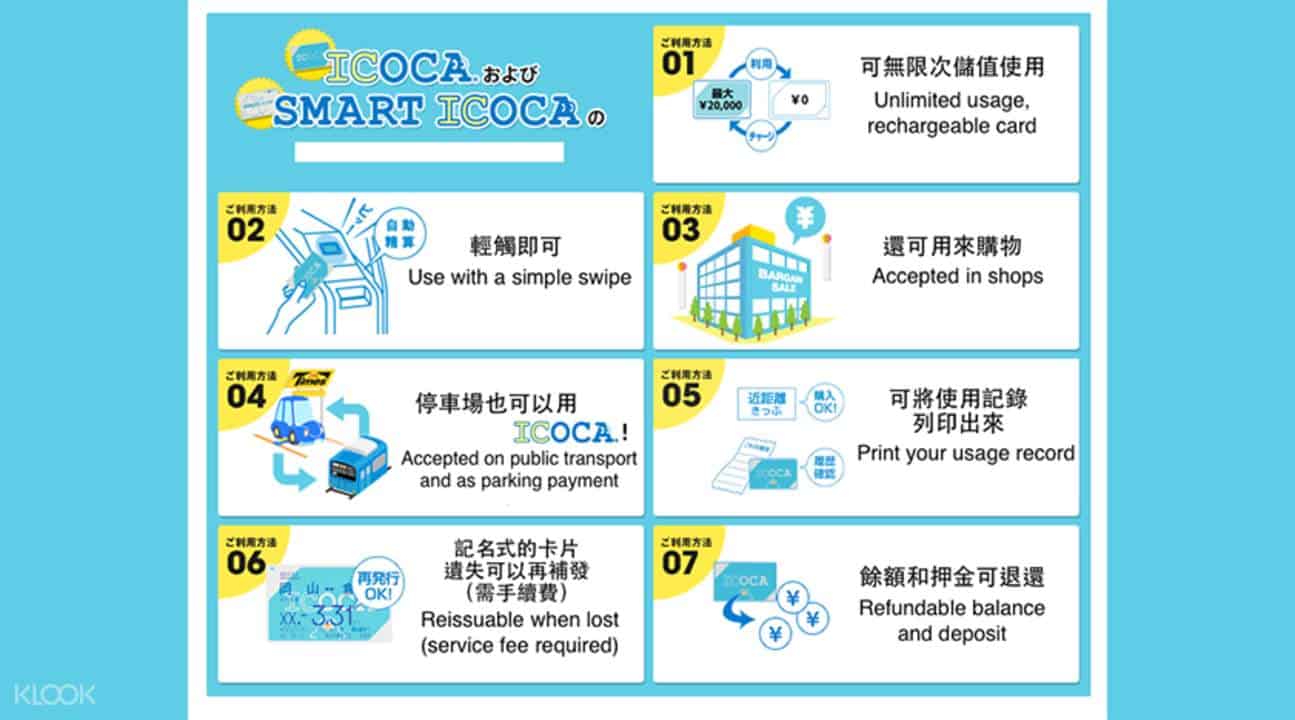
When you use an ICOCA card, you still pay for every trip. You just need to quickly hover the card over the reader at the station gates and you’re through. You can also use it not just on trains but also on buses, lockers, vending machines, and even convenience stores. Yep, lockers. The ICOCA card works on lockers at train stations!
You can also use it to snag some discount on your train to or from Kansai Airport. The best direct journey from the airport to Kyoto (or vice versa) is the HARUKA Train. And if you have an ICOCA Card, it will slash a significant amount from the ticket price. We’ve used it on our recent trip. We simply had to go to JR Counter, show our ICOCA Card, and tell the staff we’re booking a Haruka train. Normally, it costs around ¥4000 one-way, including the seat fee. But with ICOCA, it’s only ¥1600 .
You can get an ICOCA card from Klook, which is already preloaded with ¥1500 + the deposit of ¥500. You can get the deposit when you return the card.
Things to Do in Kyoto
Osaka may be too obsessed with its ever-growing skyline but Kyoto is quite the opposite. Development is noticeable but it shines in places where it dwells in the past. Historic districts and ancient structures are its biggest crowd-drawers — Fushimi Inari Shrine, Kinkakuji (Golden Pavilion), Gion District, and the Arashiyama District.
Before I enumerate the attractions I recommend, consider exploring in style by renting a kimono!
Kimono Rental
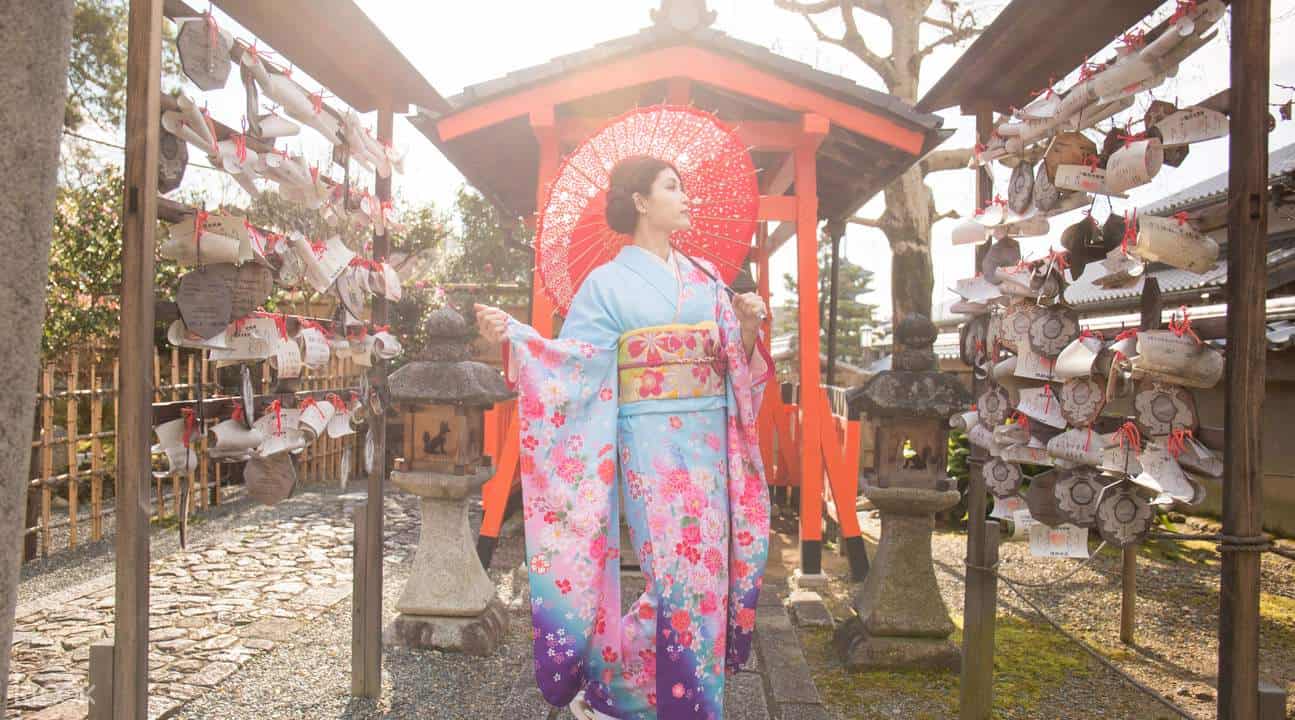
We’ve done this on our last trip, and it made our trip much more unforgettable. If you want to take awesome photos at the each tourist spot, try dressing up in a full traditional kimono set.
Fushimi Inari Shrine
Nearest Station : JR Inari Station Admission Fee : FREE
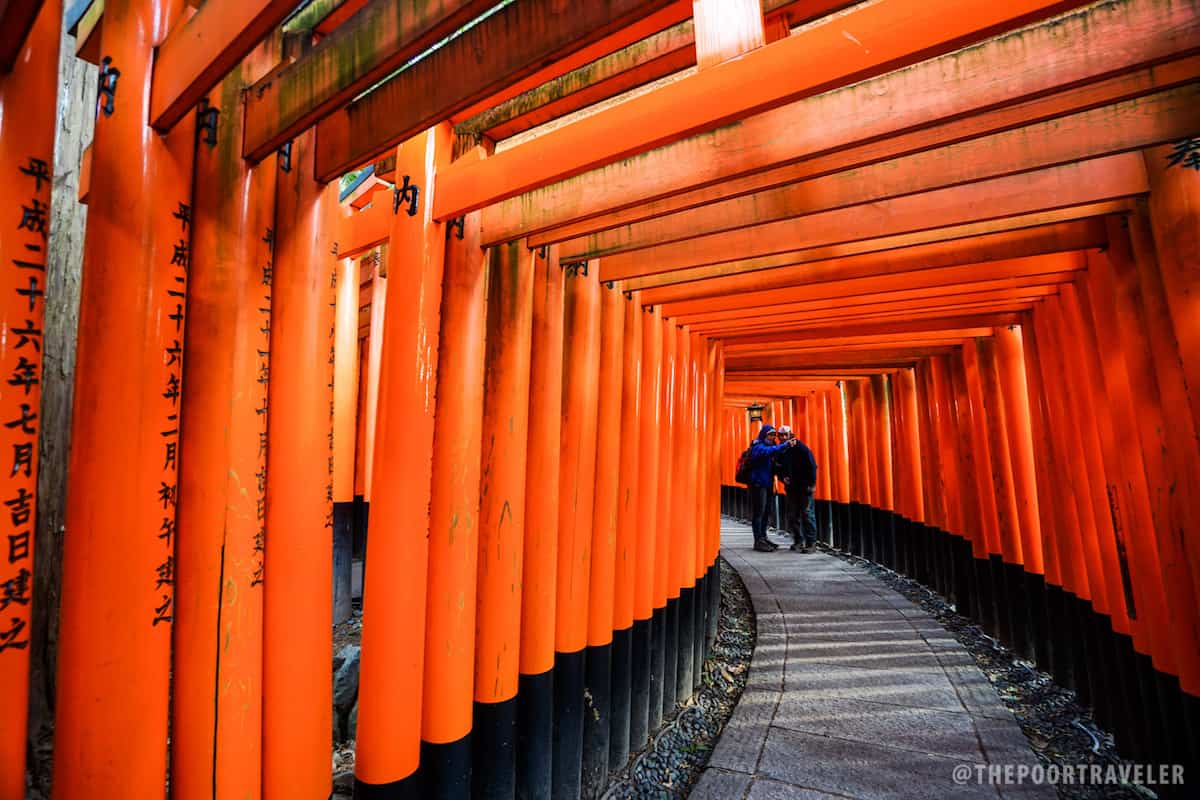
Fushimi Inari Shrine (伏見稲荷大社 or Fushimi Inari Taisha) is the most well-known and most important Shinto site that is dedicated to Inari in the city of Kyoto, Japan. While the thousand torii gates are the most picturesque parts of the site, they are but trails that connect the shrines and other places of worship. The shrine was built in 711 by one Hata-no-Irogu. According to legend, he was a powerful man, who one day shot an arrow at rice-cake target. To his surprise, the rice cake transformed into a swan and perched on a peak of the mountain. Rice began growing at the site, sustaining the community. A shrine was erected as a tribute to the god of rice, Inari. In 816, it was moved to its current location, at the base of the Inariyama hill.
More info here: Fushimu Inari Shrine
Nearest Station : Saga-Arashiyama Station (JR Sagano/Sanin Line)
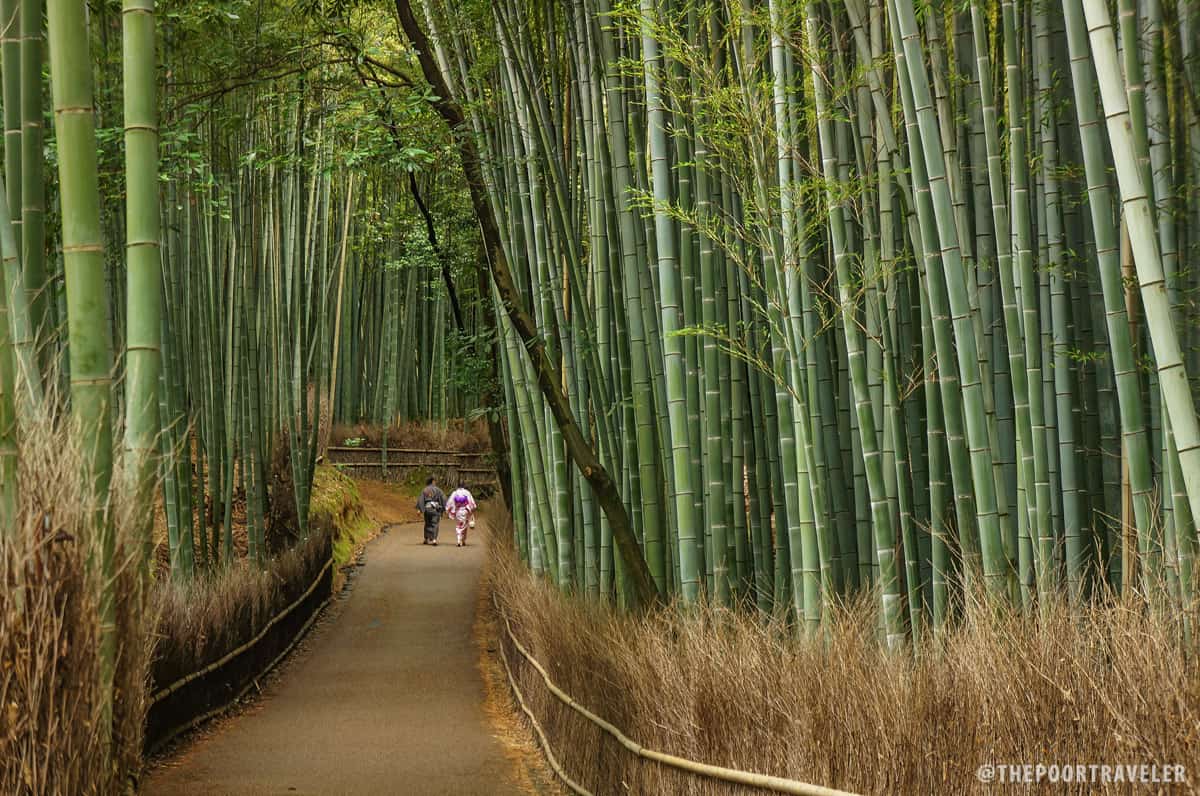
Kyoto’s Arashiyama district is dotted with shrines, temples, and other important landmarks. Many of these can be accessed for FREE. Of these, the most popular are the Tenryuji Temple (which collects a entrance fee) and the adjacent Bamboo Forest.
Regarded as the best among the Five Great Zen Temples of Kyoto, Tenryuji Temple has been declared by the Japanese government as a Special Place of Scenic Beauty and in 1994 was inscribed as a UNESCO World Heritage Site. It was originally founded in 1339 by Shogun Ashikaga Takauji as a place to console the spirit of Emperor Go-Daigo. Zen master Muso Soseki was the founding priest. Today, it is a major tourist destination, alluring everyone with its Zen beauty and tradition.
An exquisite garden encloses this temple, which makes the walk getting here an event in itself. Next to an abbey hall is the Sogen Pond, which is frequented by many species of birds. The trail ends at the start of the bamboo groves.
If you have more time, drop by Togetsukyo Bridge, Horinji Temple, and Nanamiya Shrine.
You can easily do this tour on your own (DIY-style), but if you have the budget and you want to level up your experience, you can book a Rickshaw Tour and let a local do the footwork and show you around the area.
Kinkaku-ji: Temple of the Golden Pavilion
How to get there : Kyoto City Bus number 101 or 205 (230 yen) Opening Hours : 9am-5pm Admission fee : 400 yen
Nearest Stations : Gion Shijo Station (Keihan Line), Kawaramachi Station (Hankyu Line) Entrance Fee : FREE
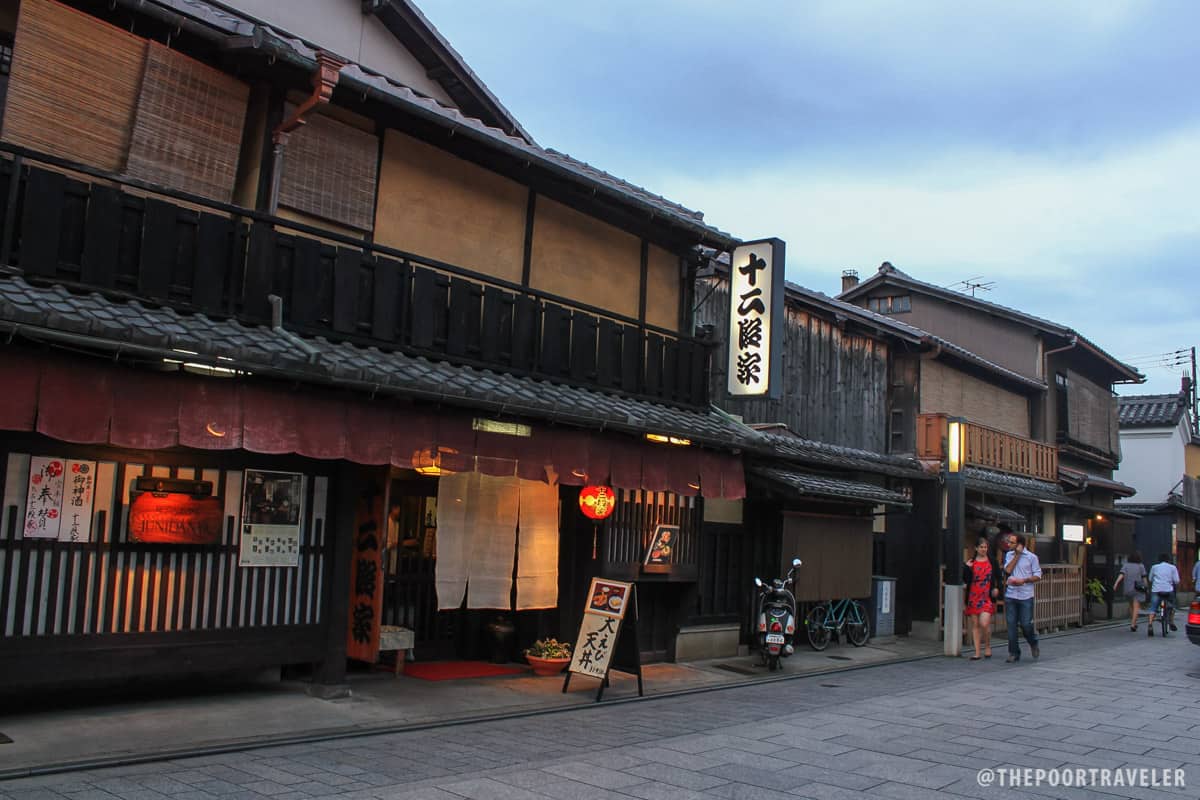
Gion District is famous for two iconic forms of traditional Japanese entertainment — the kabuki and the geisha. They are what people from all over the world travel to Kyoto for. While they are very different from each other, their roots are intricately tangled. I was thankful that once in my life my soles touched the ground where these two art forms burgeoned and flourished.
More info: Gion District
Kyoto Tower
Nearest Station : Kyoto Station Opening Hours : 9:00am to 08:40pm Admission Fee : 770 yen
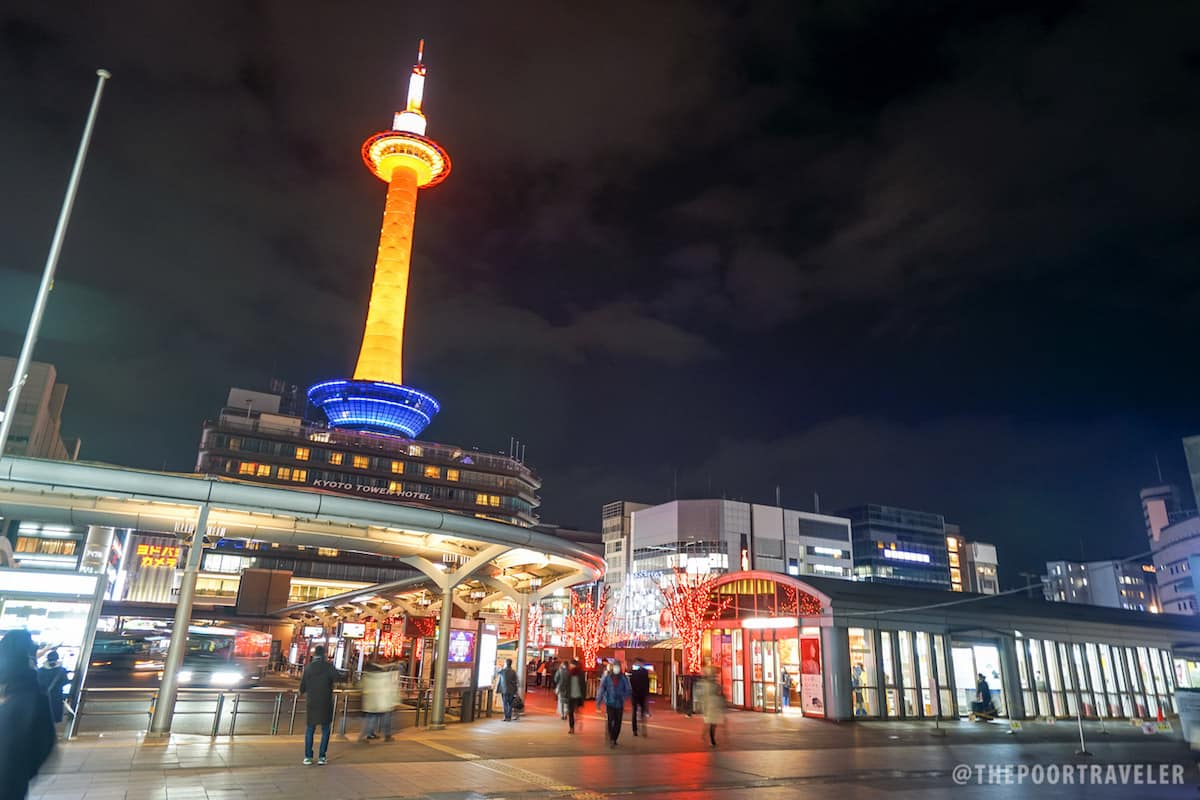
The tallest building in Kyoto, featuring an Observation Deck that provides a panoramic view of the city.
Toei Studio Park
Nearest Stations : Uzumasa-Koryuji Station (Keifuku Arashiyama Line) or JR Hanazono Station Opening Hours : 9:30am-4:30pm Admission Fee : 2200 yen
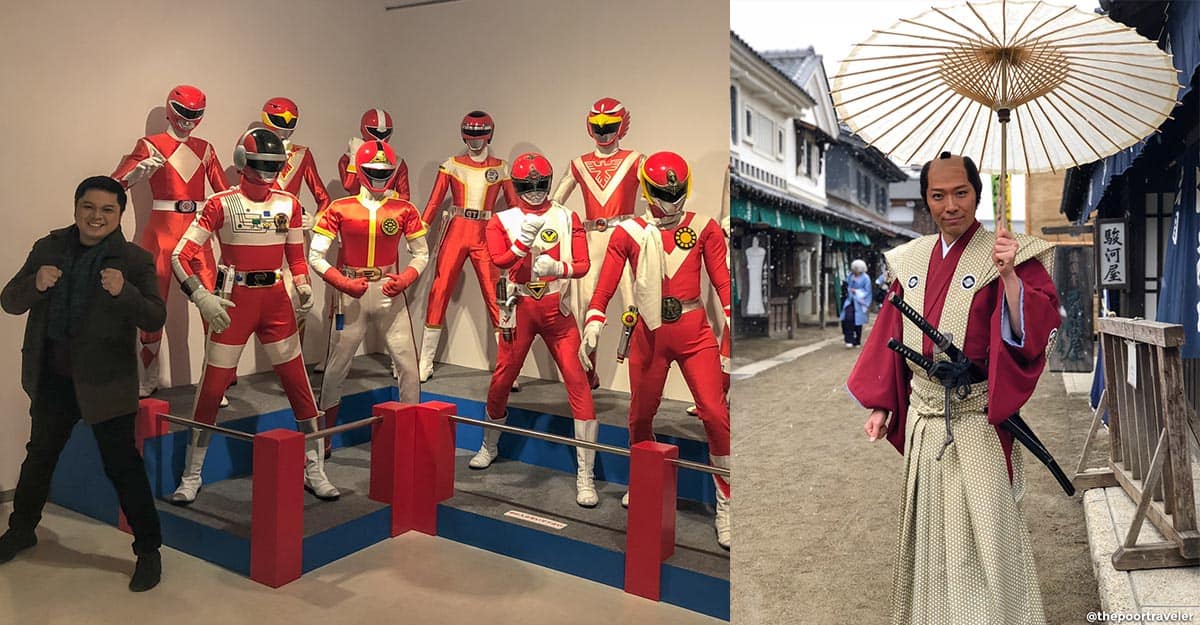
The Toei Kyoto Studio Park (東映太秦映画村, Tōei Uzumasa Eigamura, or more simply Movie Land) is actually a film set that has been made open to the public. It is the only theme park in Japan where visitors can watch and observe actual filming of period dramas (jidaigeki films). More than 200 movies are shot here every year! But it is more than a movie set.
It is a Japanese pop culture explosion contained in a theme park! It was that one attraction in Kyoto that I had a strong personal connection to because it reintroduced me to the heroes of my childhood! Ninja shows, anime artifacts, samurai fighting lessons, and super sentai reunion filled that visit, the most memorable for me. And because I’m shallow like that. Visitors may also choose to rent a full Edo period costume and dress up as a samurai or a geisha so they could explore the park in style!
More info: Toei Movie Park
Other Attractions
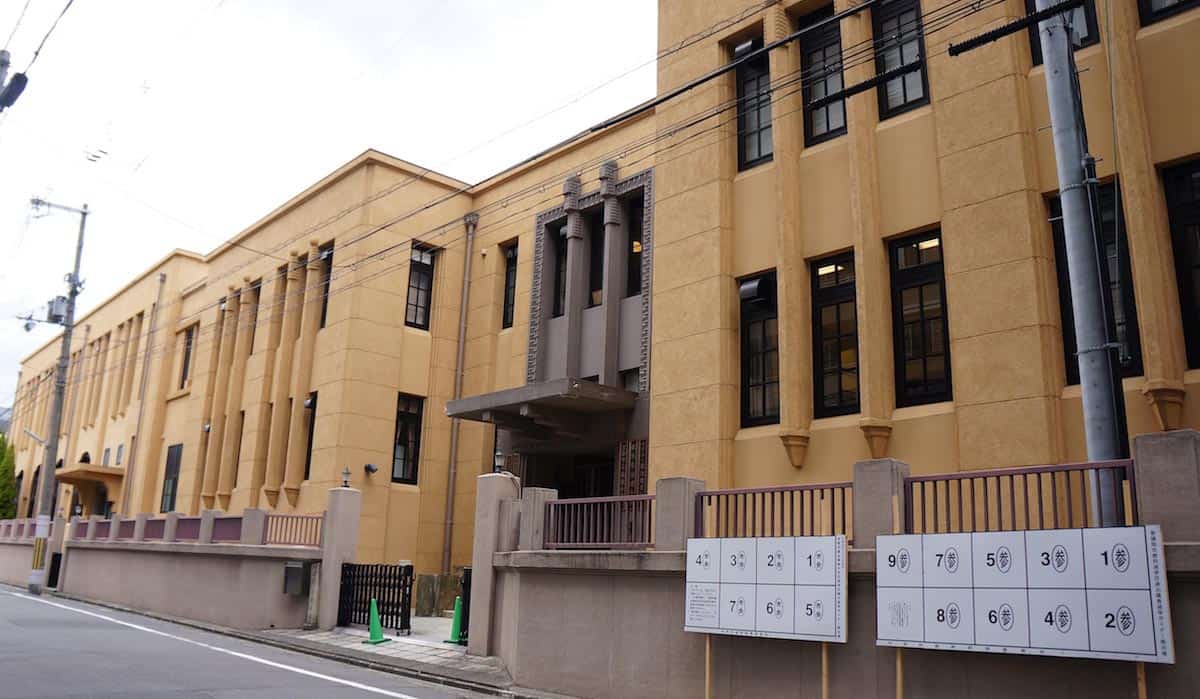
- KYOTO INTERNATIONAL MANGA MUSEUM Nearest Station : Karasuma-Oike Subway Station Opening Hours : 10am-6pm every day except Wednesday and holidays
- TOFUKUJI TEMPLE Nearest station : Tofukuji Station (JR Nara Line) Hours open : 9am-4pm (may change per season) Entrance Fee : ¥400 (Hojo and gardens), ¥400 (Tsutenkyo Bridge and Kaisando Hall)
- KIYOMIZUDERA TEMPLE How to Get There : From Kyoto Station, take Bus 100 or 206 (15 minutes, ¥230 yen) and alight at Gojo-zaka or Kiyomizu-michi bus stop. Walk for 10 minutes. Hours open : 6am-6pm Entrance Fee : ¥400
Sample Kyoto Itinerary
Below is a sample 4-day 4-night itinerary which involves spending 2 nights in Osaka and another 2 nights in Kyoto.
For the Osaka leg, please read this first: OSAKA TRAVEL GUIDE WITH ITINERARY
This Kyoto itinerary assumes the following:
- You’re taking Cebu Pacific flight scheduled to arrive in Osaka at 8:10pm.
- IMPORTANT! In this case, make sure that the first thing you do after going through Immigration and picking up your bags is to head straight to the HIS Office to collect the passes and/or mobile wifi that you booked with Klook because it closes at 10pm.
- You DON’T need a JR Pass or Kansai Pass for this Kyoto itinerary . The OA Pass for the Osaka leg and ICOCA Card for Kyoto are enough. Using the JR Pass will cost much more.
- You’re staying in a capsule hotel in Namba, like Capsule Hotel ASTIL Dotonbori or Y’s Cabin Osaka Namba (¥3250 per night)for the Osaka leg, and at a dorm near Kyoto Station like K’s House (¥2500 per night) for the Kyoto leg.
- You’re skipping breakfast . It’s healthy (according to intermittent fasting advocates, hehe) and you’re poor!
Make the necessary adjustments to match your schedule and preferences.
Day 0 08:10pm – Arrival at Kansai Airport 09:10pm – Collect Klook passes at Arrival Hall 09:54pm – Board Nankai Airport Express to Namba, ¥920 10:30pm – Check-in at the hotel
Day 1: OSAKA 07:00am – Wake up 08:30am – Subway to Tanimachiyonchome Station (Osaka Castle), FREE (OA Pass) 09:00am – Osaka Castle, FREE (OA Pass) 12:00nn – Subway to Nakatsu Station (Ramen Yashichi), FREE (OA Pass) 12:30nn – Lunch at Ramen Yashichi, ¥730 02:30pm – Subway to from Nakatsu to Umeda, FREE (OA Pass) 03:00pm – Umeda Sky Building Observatory, FREE (OA Pass) 04:30pm – Subway from Umeda to Namba, FREE (OA Pass) 05:00pm – Early dinner at Tokisushi, ¥1134 06:00pm – Dotonbori Tour, FREE (OA Pass) 09:00pm – Back to hotel, sleep
Day 2: ENDO SUSHI, TRANSFER TO KYOTO 05:00am – Wake up 06:00am – Subway to Tamagawa Station (Endo Sushi), FREE (OA Pass) 07:00am – Breakfast at Endo Sushi, ¥1242 08:30am – Subway Tamagawa to Namba Station, FREE (OA Pass) 09:00am – Start packing 10:30am – Hotel check out 11:10am – Subway to Shin-Osaka, FREE (OA Pass) 12:05nn – Transfer to a JR Local or Special Rapid train to Kyoto, ¥560 12:30pm – Arrival at Kyoto Station 12:40pm – Find lockers to store luggage, ¥700 01:00pm – Quick lunch (onigiri, etc), ¥500 01:27pm – Train to Saga-Arashiyama, ¥240 02:00pm – Explore Arashiyama, Tenryuji Fee: ¥500 05:32pm – Train to Kyoto Station, ¥240 05:45pm – Dinner at Kyoto Ramen Street, ¥900 07:00pm – Collect bag from locker 07:30pm – Walk to hotel 08:00pm – Hotel check-in 08:30pm – Sleep
Day 3: KYOTO 07:00am – Wake up 08:00am – Take Bus 101 or 205 to Kinakuji, ¥230 09:00am – Kinkakuji Temple, ¥400 11:00am – Bus to Kyoto Station, ¥230 12:00nn – Lunch, ¥1000 01:07pm – Train to Inari Station, ¥140 01:12pm – Fushimi Inari Shrine, FREE 03:20pm – Train to Gion-Shijo, ¥270 03:50pm – Explore Gion 06:30pm – Back to Kyoto Station 07:00pm – Dinner, ¥900
Day 4: UNIVERSAL STUDIOS 07:00am – Check out 08:06am – Train to Universal City, ¥800 08:55am – Store luggage in locker, ¥700 09:00am – Universal Studios Japan, ¥7900 12:30pm – Lunch, ¥1500 04:00pm – Train to Airport, ¥1190 05:30pm – Check in 08:30pm – Flight out
If you follow this Kyoto itinerary, prepare to shell out around ¥40,000 (USD 380, PHP19,750) including possible miscellaneous expenses like bottled water and some snacks but excluding airfare.
Universal Studios Japan eats up the biggest chunk of the budget. You can save a lot by skipping it, if it’s not your priority anyway. Instead, I strongly recommend Toei Studio Movie Park in Kyoto. This is my most-loved theme park in Japan because it’s uniquely Japanese. (More info about that here: Toei Kyoto Studio Park .) This way, the cost goes down to only ¥31,000 (USD 295, PHP15,300)
Another way to further reduce the cost is by limiting your food budget to only ¥500 per lunch/dinner. Convenience stores and supermarkets offer cheap meals for much lower. But you’re in Japan! It would be such a shame to visit Osaka and not eat out!
You can also find an early morning flight so you can save one hotel night.
This itinerary may also be too dense for you. It was for me, haha. In fact, I skipped a few of these because my legs were this close to falling off. That’s because I’m old and lazy. Again, that’s me.
More Tips for the Poor Traveler
Here are more tips to help make your trip go smoothly.
- Lockers . In major stations in Osaka and Kyoto, you’ll find them in many corners. There are two types: electronic and coin lockers. Rental costs ¥300-¥700 depending on the size. In Kyoto, if your hotel is far from Kyoto Station (which is the focal point of everything touristy in the city) and your flight is scheduled at night, you may choose to store your baggage at one of the many lockers scattered at the lower levels of the station. This way, you save a hotel night and does not need to travel back to the hotel just to get your things.
- Tipping is unusual in Japan. Most restaurants have the cashier stationed by the exit so you pay after your meal, on your way out.
- When in doubt, ask . The people of Osaka and Kyoto are some of the friendliest I have ever met.
2️⃣0️⃣2️⃣0️⃣ • 1️⃣ • 1️⃣7️⃣
More Tips on YouTube ⬇️⬇️⬇️
Is this post helpful to you?

Related Posts:
- OSAKA AND KYOTO: Budget Travel Guide
- JAPAN MULTI-CITY TOUR: How to Plan a Budget Trip
- 10 Food Delights to Try in Japan
- Snapshot: Lovers in Arashiyama Bamboo Forest – Kyoto, Japan
- KAKIGORI: The Grandmama of Halo-halo
- TAKAYAMA TRAVEL GUIDE: Budget Itinerary & Things to Do
- YONAGO & DAISEN Travel Guide & Budget Itinerary
- ONOMICHI TRAVEL GUIDE with Budget Itinerary

- Recent Posts
- 2024 Resorts World One HONG KONG CRUISE Guide for First Timers - 13 April 2024
- FLIGHT RESERVATION for VISA • How to Get Dummy Ticket for Schengen, Canada, China and Other Visa Applications - 22 March 2024
- 2024 Cebu Pacific Promos & PISO SALE with List of Covered Destinations - 4 March 2024
Featured On

We heard you!
Your comment is now queued for moderation! We’ll try to get back to you soonest. While waiting, follow us on these channels.
Subscribe on Youtube! Follow us on Instagram!

Japan Travel Blog (Day 8) – Kyoto, Part 1
Early in the morning I had to leave Tokyo for Kyoto, where I would be spending the next two days with xanthe! To reach Kyoto I would take the super high-speed bullet train from Tokyo station. I had never been on a bullet train before so I was looking forward to it. In Japan, the bullet train is referred to as “Shinkansen”.
In general, I tend to dislike asking for directions. Instead I would prefer navigating around on my own. The only thing is that the Shinkansen line at Tokyo station has about a gazillion different platforms and I ended up on the wrong platform! In the end I had to seek help at the information counter. Lesson learned: always ask for directions when you have heavy luggage and a large Hello Kitty cushion in tow!
Three kinds of bullet train ply the Tokaido Shinkansen line from Tokyo to Shin-Osaka (kyoto lies along this route). My rail pass allowed me to take the Hikari train, which I did at 11:06am.

Every hour, two Hikari trains operate on this route. Each train travels as quickly as 300 kilometres per hour. At that speed, it would take me less than 3 hours to get to Kyoto!
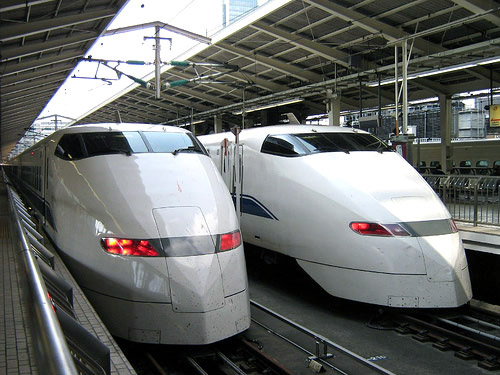
They had stalls selling bento sets on the train platforms. I got myself an unajuu (eel and rice) set.
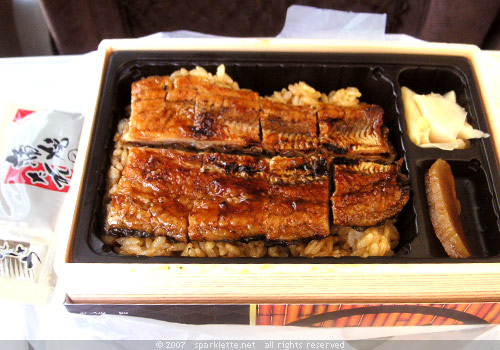
One for the road!
At that point I was pretty sad to be leaving Tokyo. The time I spent there had been so wonderful and memorable! With my ipod earphones plugged in, I felt doubly melancholic.
Soundtrack: John Mayer – Clarity
The video above was taken just as the train was departing Tokyo station.

The train made a few stops along the way. I noticed this interesting building at one of the stops (nagoya, I think). It had many well-known brands of electronics and technology products arranged neatly on its facade.
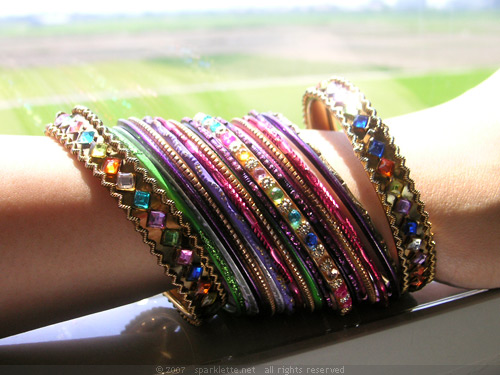
My colourful Indian bangles!
Soundtrack: Alicia keys – Caged Bird
The train ride was a good one. It allowed me to see the more rural side of Japan with all its small houses and vast fields of greenery. What a stark contrast this was from the metropolitan Tokyo that I had been seeing for the past 7 days!
I reached Kyoto after 2 hours and 40 minutes! This shiny building is Kyoto station. It is the most important transportation hub in Kyoto where people can take the railway, subway or bus.
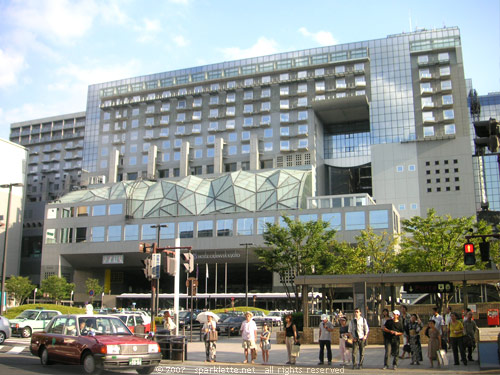
At the station, I found interest in a couple of food stores while waiting for xanthe to arrive.
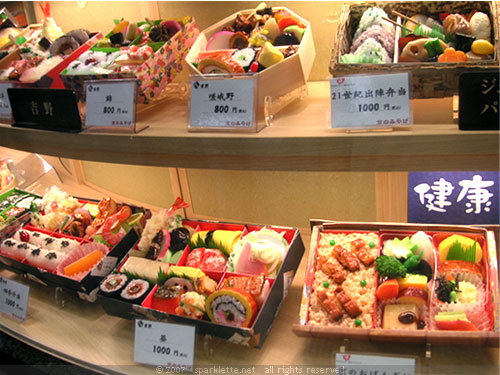
The bento sets were so detailed and elaborate!

Then it was time to head to our hotel. We had booked our accommodation a month prior to our arrival, and clean forgot that it was within walking distance to Kyoto station! Yay! What convenience!

The moment we opened the door to our hotel room, we were pleasantly surprised by how cosy it was! Our beds had beautiful comforters and bedding. My Hello Kitty cushion looked right at home!

We also found an interesting boiling device in the room; it was built right into the table!
By the time we settled down it was already late afternoon. We had just one and a half days in Kyoto – time to hit the streets!

On our way to the hotel earlier I had spotted some wooden houses from afar. Kyoto is formerly the capital of Japan and well-known for having such traditional wooden houses.
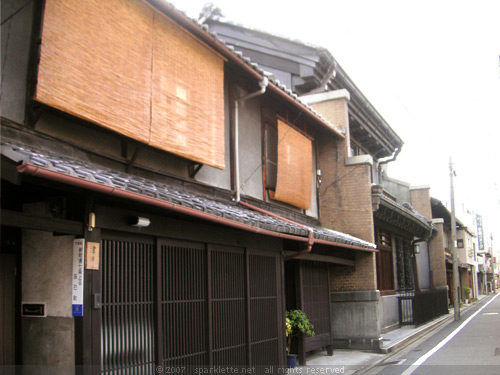
So on one side you get a bustling city scene with tall buildings and busy roads; on the other side you get a peaceful area rich in tradition that looks a completely different world!

We spent the next half hour walking through the lanes and alleys and admiring the houses!

Wooden nameplates outside a door. It seems there were a few people or households living beyond that door.

This house looked so quaint!

My favourite is this particularly sweet-looking house! It might have been an eatery or something.
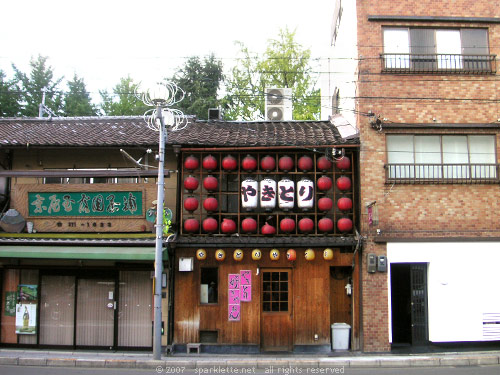
A row of shops lining the streets of Kyoto. They share the same traditional look as well.

Big-ass bottles. What are they, sake? Shochu?
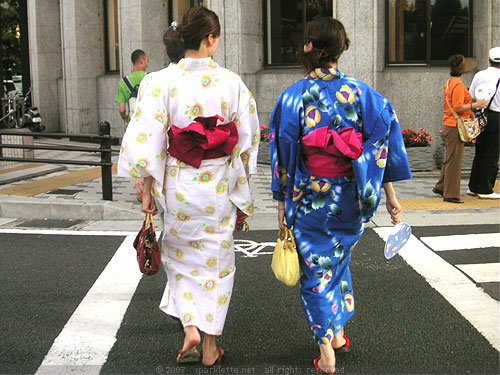
Japanese girls wearing colourful yukata, which is a more casual form of kimono worn during summer. This was a very common sight; people would wear these out on the streets, to the malls, etc.

Kyoto is home to 2000 Buddhist temples and Shinto shrines!
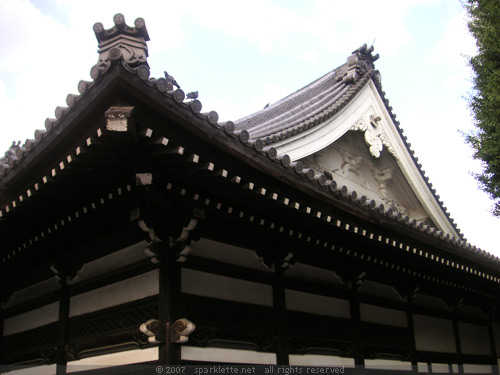
This was the first temple that we visited as it was within walking distance from our hotel.

Pretty flowers by the road!
Notice anything out of the norm in this photograph below?

All passengers board the bus at the back and alight at the front!
Regardless of the distance travelled, each bus ride costs ?220 for adults (that’s about 3 bucks). Passengers would pay their fares at the front of the bus (where the driver can get a clear view) just before they alight. That explains the unusual arrangement of the bus!

We took the bus to an area called “higashiyama”. Our main purpose there was to visit the famous Buddhist temple, kiyomizu-dera, which is a UNESCO World Heritage Site . The temple was located really far off from the main road. We had to take a long walk on kiyomizuzaka, an upward-sloping lane lined with souvenir shops and eateries on both sides.
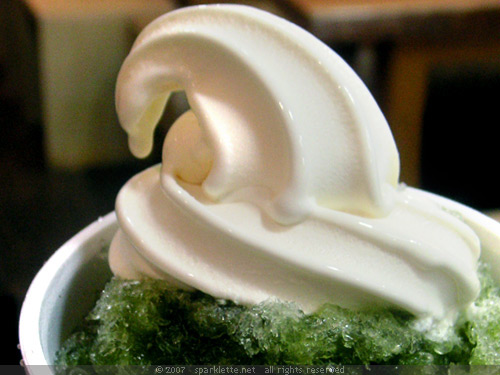
A little shaved ice dessert to send us along our way. When you’re in Japan, you have to go for the green tea flavour! And the vanilla ice cream? That’s just good sense. (count the number of ice cream in this post! People with the correct answer get to treat me to real ice cream! Haha!)

Here we are! The renowned kiyomizu-dera!
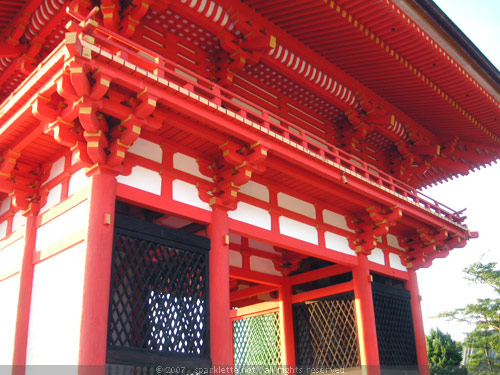
Its intricate red and white main gate.
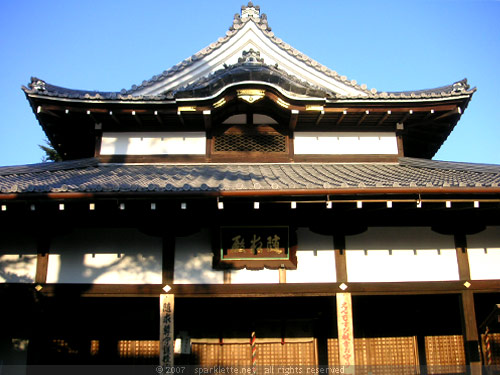
Before entering the main praying area, visitors are supposed to rinse their hands at the purification fountain.

Or here too.

Vast forest beyond the temple. Can you spot the pagoda?

An outdoor stage used for performances, like the one at the Shinto shrine I visited in Day 5 . Temples and shrines, they all look the same after a while don’t they?

The veranda at the top of this staircase is supported by hundreds of pillars and juts out over the hillside. From here you can enjoy a sweeping view of the entire city of Kyoto!
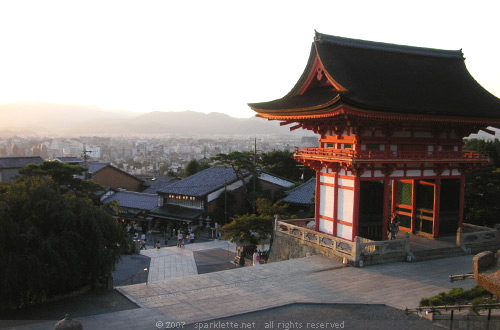
Following the temple visit, we took a stroll down the quaint kiyomizuzaka slope that we passed earlier.

This must be a hot-spot for tourists because there were numerous souvenir shops, each one selling the same stuff as the next.

Did I not tell ya? The Japanese are crazy about Hello Kitty!

More ice cream! We opted for black sesame and purple bubblegum flavours this time round.

Yummy! I never thought I would like black sesame ice cream (the colour alone has always turned me off)!
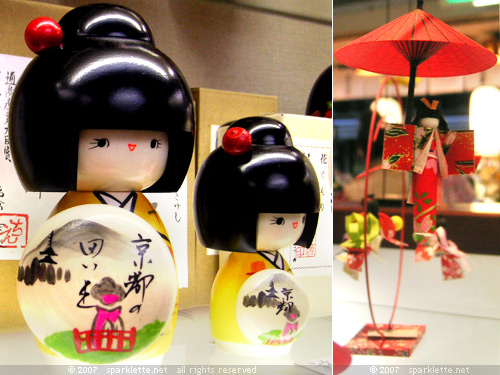
Cute figurines of geishas.
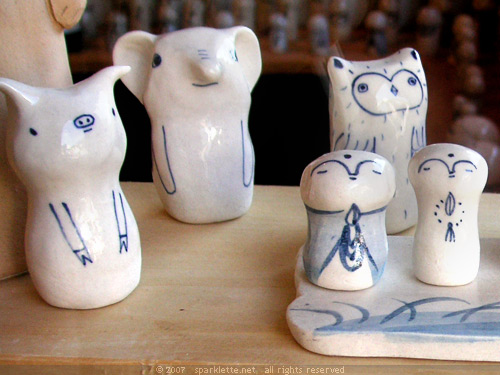
More cute figurines! These were handcrafted porcelain ones of animals!
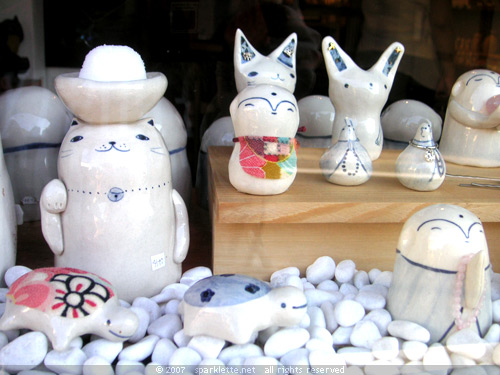
Remember the cute car we spotted in shibuya back in Tokyo? This is the one:

Well, as luck would have it, we spotted another one of it right there in Kyoto, parked next to a traditional wooden house!

Towards the end of the slope this white-coloured restaurant caught our eye. Many Japanese restaurants have plastic food replicas displayed on the outside that are really useful for people that don’t speak Japanese (remember my food ordering process in Day 1 ?).
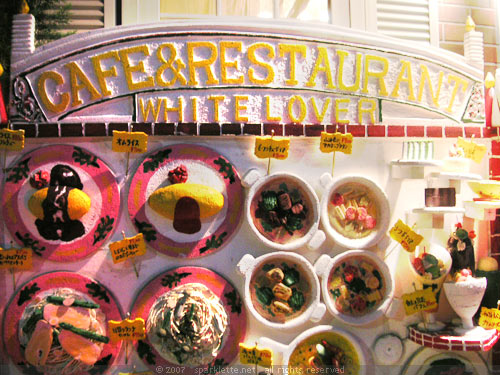
These particular food replicas looked entirely different from the usual plastic ones we saw. They appeared to be hand-painted and made out of clay! For some reason that was enough to attract us to have our dinner there!
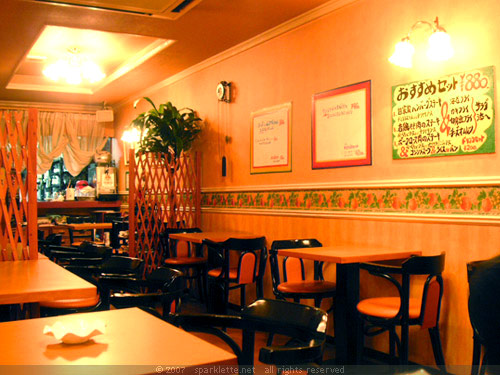
There was no other customer and it continued that way throughout the entire duration of our meal.

Dwarf figurines by the window.

Uniquely-designed menu with text that looked like they had all been painstakingly written.

Pork cutlet with a little mound of noodle.
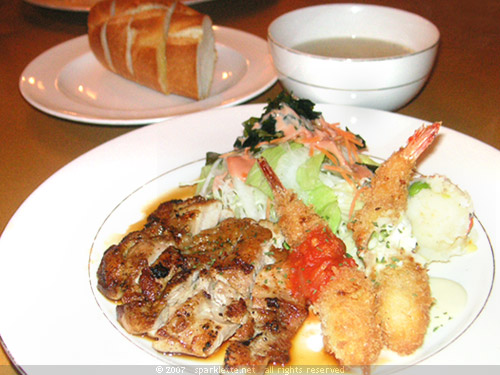
Chicken steak in teriyaki sauce and breaded prawn.
Then it was time to head back.
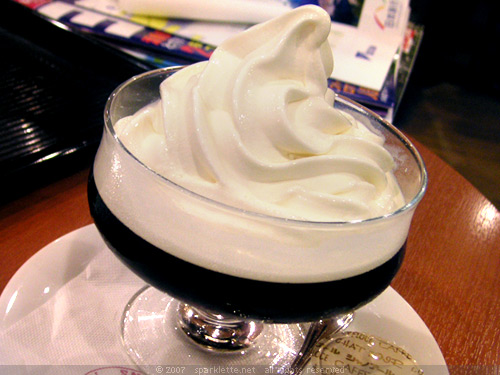
But not before having a little coffee jelly (with ice cream) at caffe veloce, a café near our hotel. Yummy!

Very nice! I’m surprised that Kyoto is only 3 hrs by shinkansen. I did not get the chance to ride the shinkansen; perhaps next time.
Were the people aboard the shinkansen very quiet? I noticed that when I took a private train (by accident, because we wanted to take the JR), that one guy had “shushhed” me and the train was very quiet. No cell phones, no one talking, etc.
Kyoto is not what I expected, based on your pictures. I thought it was very nature-like, with very few buildings.
Your pictures of the plastic food displays makes me miss Japan SOOOO much! I miss how polite everyone is, and how they greet you with “irasshaimase!” when you walk in to a store or restaurant.
Your Hello Kitty pillow is so kawaii! It looks like Hello Kitty is sleeping in your bed.
It was shorter than 3 hours actually. The bullet train was really fast!
The Shinkansen wasn’t that quiet because it was packed with foreigners! There were conversations going on at times but in general, it was still much quieter than any other train I have been on.
Notice that on subway trains even, you hardly hear the phone ring. Not even an SMS! With incoming calls, people would simply not answer them. My friend who’s working in Tokyo told me that even when the trains are packed during the morning rush hours, it would still be silent.
I expected Kyoto to have many of these wooden houses in addition to being a modern city. On my way there on the Shinkansen I did spot those nature-like areas you’re talking about, with sparse buildings and all. They were the neighbouring prefectures or something. We wanted to go check it out but again, we ran out of time!
There is just so much to see in Japan, I doubt that even a whole year would be enough!
Japan is just so much fun! I wanted to go Tokyo before heading back to Buffalo, but alas no time. Interesting how the culture is so diverse for a rather homogeneous country… how it’s modern yet respectful of traditional beliefs (e.g. not answering cellphones in subway). Great multi-sensory travelogue you’ve produced Ms. V!
Wow, you sure blew away all our pathetic attempts at capturing holiday experiences with this series of gorgeous photographs, witty captions and brilliant posts! I love Japan and have been there 3 times already and counting. For my trip to Melbourne (starting tonight…hehe), I’ll aspire to put up some nice photo heavy post like this…. *deep bow*
Hi, nice pics out there for kyoto and Tokyo… I stopped by Tokyo recently for 3 days….can’t believe you missed Tsukiji…the tuna auction and sushi there is fantastic. Do make a trip there next time. Me and my wife are planning our next trip to kyoto and osaka now… Keep up the good work, enjoy reading your blog…
Very valuable and enjoyable research material for the next trip hehe…
P.S. The big ass bottles are sake I think. The bigger more well known brands…
hi veron, how much you paid for your 11 days japan trip?
your pictures are so tempting for me to go there holiday. would be trying their sakura season next year :-)
Kevin : Thanks! Your highly interactive blog with all the interesting photos and videos are what inspired me to come up with a “multi-sensory” travelogue, as you call it. Otherwise it would simply be just photos and text.
walter : Hey! My bro is leaving for Melbourne tonight too! You guys may end up catching the same flight.
hawk : The Tsukiji fish market was actually part of our planned itinerary but we left it out in the end; there wasn’t time! The next time I go to Tokyo again I would be there!
lorewang : For airfare and accommodation alone it was about $1500. I spent much more on other stuff such as food, transportation, admission passes and shopping!!
Great insight on your trip, I love reading all the different aspects of your trip. Keep it coming!!
wow … the picture that captured my attention is the …… “that bowl of unagi with rice”!
japan really do give generous portions of unagi! unlike shops here in Singapore ….
*hungry* ….
Willy : Sure! Day 9 would be full of great pictures, I promise. I’m working hard to get it posted!
Jayson : That lunch box cost me almost 20 bucks. So it’d better have lots of unagi!
Do check out the toilet at the Kyoto Station, it’s in the hotel.
Sawadee krup! i’m sittin in the canteen at Thammasat University (small one near Grand Palace) havin a cold drink in this hot weather. walked past and saw that it’s graduation day so came in for a look. Very interestin and VERY crowded. It’s a big carnival setting.
Hi hi! I just resume reading your blog after having lost your link in my ‘favourites’. I found your blog again after searching on stuff in Japan..and I’m just so glad to find your blog! It’s as ever interesting!
Lovely updates on Tokyo and Kyoto so far. Looking forward to more on Kyoto! Is it easy to travel around Japan without following any tours? My biggest concern is the language; its quite a handicap, not being able to read signs and conversing with people. My friends who are going to both Tokyo and Osaka in Dec got this tour package @ Natas for about S$1900 per pax (7 days). It includes air tix on JAL, accomodation and food for certain days.
I cannot help but admire the beautiful photos here. The hello kitty cushion makes the room inviting for you, I am sure. :)
By the way, I have tried to access your blog from office during lunch hours for the past weeks, but have difficulties doing so. The message reads “Access denied”. Anyway, good thing that I can still access your blog from home to enjoy the beautiful scenes of Japan. Thanks for the posts.
Got here while googling for Kyoto! Have seen your site around on several ocassions (and Twitter as well). I’m going there in October, your travelogue serves as a good reference read! =D
xtemujin : Thanks! Maybe next time.
Dennis : I miss Bangkok!
strawberry : So glad you found sparklette.net again!
Joyz : Yup! I’m quite against following tour groups. Traveling on our own is so much more fun! The language barrier is an obstacle though; it takes a longer time to get to people. But experiencing all the differences of a new country is the gist of travelling, isn’t it?
py : Love the kitty cushion! Thanks for highlighting the problem to me. I myself have encountered the same problem from time to time. Still working to fix it for good!
Mail Order Bride : Have fun!
Happened to chance upon your site while searching for places to go in tokyo and kyoto. I hope it’s not too late to ask for advise..May i know which hotels did you stayed in both places? How much does the bullet train cost? How did u manage to budget 1500 bucks for accomodation + airtickets?(as air tickets alone cost 1.2k..)
I am planning a trip in Nov and happened to find yr blog. It was really helpful.
May I know the hotel name you stayed in Kyoto?
Rgds Cheryl
How to travel from Osaka City to Tokyo Disneyland? Which station and which Line.? Please help.
Click here to cancel reply.
- Czech Republic
- Budapest, Hungary
- Amsterdam, Netherlands
- Switzerland
- Complete Japan Travel Guide
- Kanto Region (Tokyo, Hakone)
- Kansai Region (Osaka, Kyoto)
- Kansai Wide (Wakayama)
- Chugoku Region (Hiroshima)
- Chubu Japan
- Hokkaido Japan
- Kyushu Japan
- Jeju Island, South Korea
- KLOOK Promo Code & Voucher (2024 April)
- Agoda Promo Code
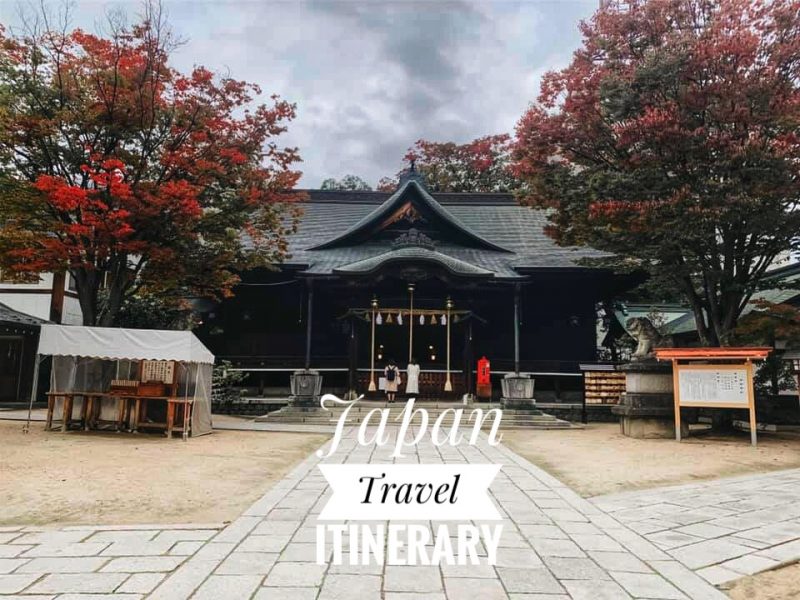
Japan Itinerary Blog: Perfect Travel Route for 7, 10, 15 Days
Last updated on April 21st, 2024
Are you planning a trip to Japan and looking for a Japan itinerary? Here we give you first-hand travel tips and recommendations for Japan, together with a perfect Japan travel itinerary for 7, 10, 15, or even 21 days with the best places to visit. All the recommended attractions are ideal to put into your travel plan that we consider to be the highlights of Japan for first-timers.
Land of the Rising Sun, Japan is an amazing country where ancient traditions and vibrant modern culture collide, awakening the curious corners of the mind, and pushing you to explore as much as possible. As a Japanese culture lover, I’ve managed to travel to Japan more than 10 times, either short-stay business trips, self-plan travel with families and friends, or even back-packing solo budget trip, I am never getting tired of visiting this amazing country.
There is so much to offer including the stunning natural scenery, hot spring onsen bath, traditional cultural towns, and vibrant futuristic cities. With the exquisite Japanese cuisine, mouthwatering fresh seafood, and regional delicious ramen, I can even make a trip to Japan just for Japanese food! Not to mention the seasonal activities that happening in Japan such as cherry blossom in spring, summer festival celebration, fall foliage during hall, and skiing and snowboarding in the winter.
In this Japan Itinerary , we’re covering a number of cities and towns that provide an immersive travel experience. It’s an active popular route for Japan itinerary that will take you through 4 regions and at least 8 cities. Each provides an opportunity to be wowed by the scenery, witness ancient history, expand your palate and discover unique Japanese culture. This Japan itinerary is flexible, feel free to extend or shorten your stay in the locations we recommend. In addition to recommended stops, we’ll be covering flights and transportation, recommended hotels, and activities.
We hope you find this Japan travel Itinerary blog helpful when planning your trip. Besides, this Japan travel guide is very compressive and long. For your convenience, I’ve compiled links to transportation, hotels, tours, and other services followed by different topics. Feel free to check on each section if you wish to know more about a specific topic.
Table of Contents
How Long to Spend in Japan?
One question that many potential visitors ask frequently is how long they should spend in Japan? And my answer is that it depends on what you want to see and how many places you want to visit . The country is vast and each region offers different things to do. I can spend days in Tokyo city alone and continually find new things to see and do.
Planning a trip to Japan ain’t an easy task because there’s just SO MUCH to explore . But, it is possible to enjoy the best of Japan with whatever time you have on your Japan travel itinerary. That being said, a two weeks Japan itinerary is the best way to explore some of the popular sights and get an introduction to some of the cities in Japan. But if you have more time to spend, then you can’t go wrong with taking advantage of it and extending your stay in this lovely nation.
One thing to keep in mind no matter how long you have to dedicate to your Japan travel itinerary is that it is impossible to see absolutely everything so make sure to prioritize what you want to visit, don’t rush for everything, and travel in leisure!
Best Time To Visit Japan
Any time! Japan is a ‘year round’ destination and each season brings a reason to visit Japan ! Whether it’s the famous sakura or cherry blossom season and pretty weather in the spring, the hot and liveliness of summer, the fall color changes of autumn, or the icy cold snowy festival of winter, you can’t go wrong traveling to Japan at any time of the year.
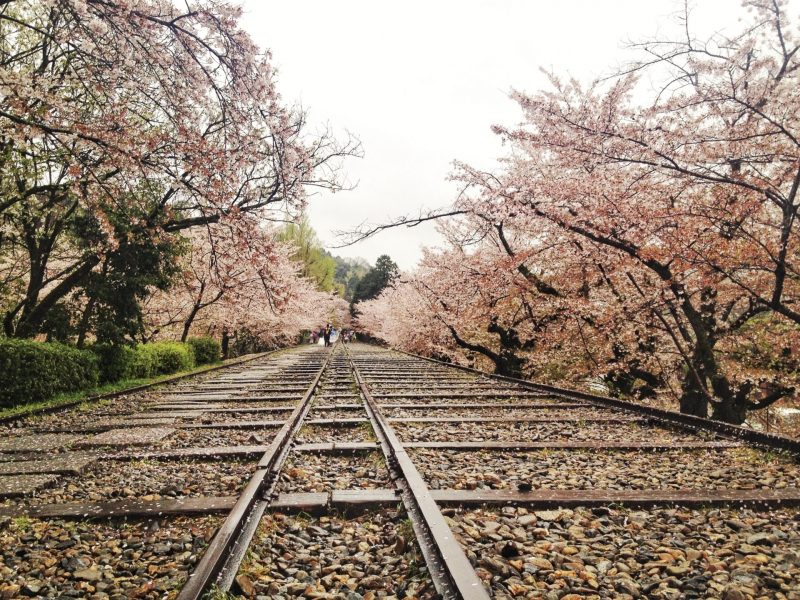
Visiting Japan in Spring : From March to May is the Spring season in Japan with little rainfall, clear skies, and mild temperatures. It is the best season to visit in Japan as it is the famous sakura blossom season that usually happens from late March to the beginning of April.
During these few weeks, this is the travel peak season in Japan, so expected higher price increases in accommodation and bigger crowds. But I assure you, that you won’t regret visiting Japan during the cherry blossom season as Japan is amazingly beautiful with everything clad in picturesque pink sakura. Japan’s National Holiday, Golden Week also falls in this season from late April to the first week of May.
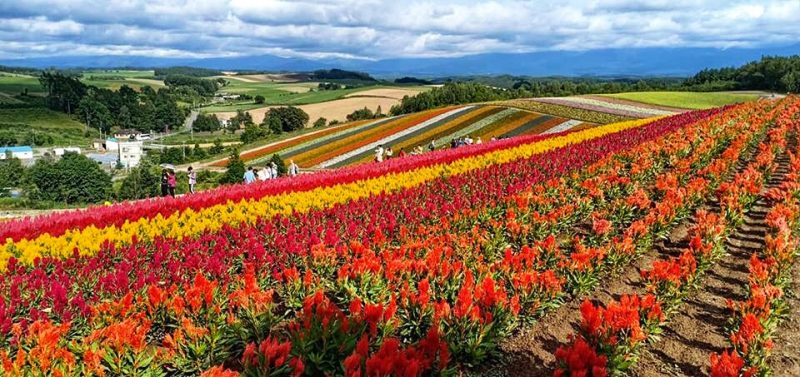
Visiting Japan in Summer : The summer season in Japan is started from June to August and the weather is hot and humid. The daytime temperatures are often higher and require paying more attention to physical well-being.
Summer in Japan is a great opportunity to experience the Japanese culture related to this season such as fireworks, festivals, and the Japanese love to plan their summer holiday in the cooler region such as Nikko, Hakone, and especially Hokkaido. Hokkaido’s flower field is one of the popular activities during Summer in Japan.
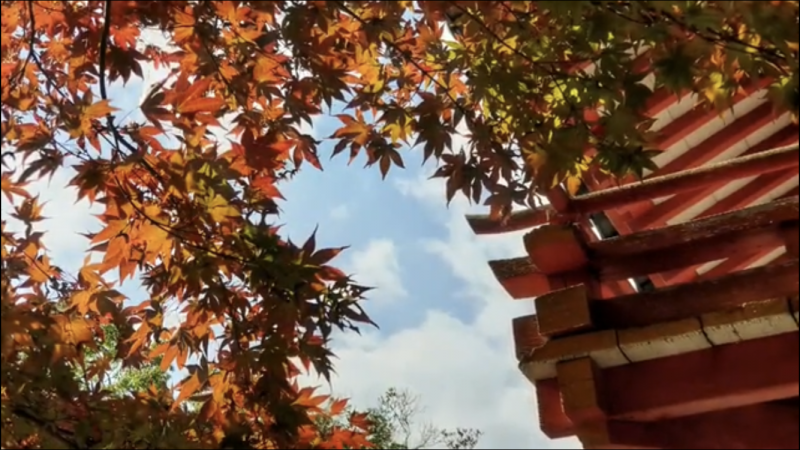
Visiting Japan in fall : From September to November, Autumn is the season of gorgeous fall foliage. The weather in fall is very comfortable and suitable for traveling in Japan but typhoons may occur between September to mid-October. So please note this and best to plan to visit Japan from late October to November.
Viewing the fall foliage, or “momijigari” in Japanese , is one of the most awaited activities in Japan with autumn leaves painting the whole country in crimson and gold. Kyoto is the best place for viewing the spectacular fall landscape.
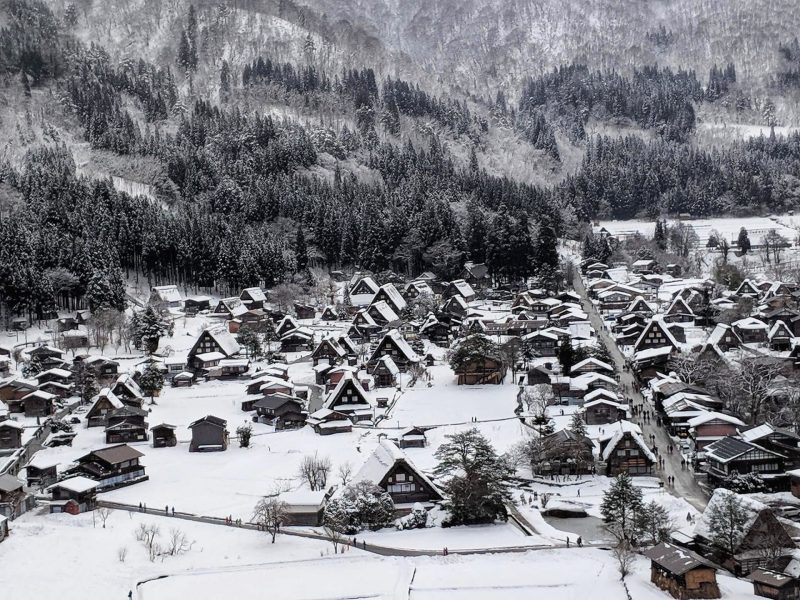
Visiting Japan in Winter : Starting from December to February is the winter season in Japan and it is the coldest season of the year. Winter illuminations started features all over Japan, it’s the best time for enjoying the hot spring. Imagine dipping in a natural hot spring and relishing in the beautiful winter scenery surrounding you.
Besides, Hokkaido is the best destination to enjoy the winter season in Japan with excellent ski resorts for winter activities and gorgeous snow festivals in Sapporo.
How To Travel in Japan
International visitors typically arrive at Tokyo’s Narita Airport (NRT), the busiest airport in Japan. Some may choose to arrive at Haneda International Airport (another airport in Tokyo and mostly for budget airline and domestic transfers), Kansai Airport (KIX) in South of Osaka, or New Chitose Sapporo Airport in Hokkaido.
Browsing through Skyscanner to get a cheap ticket to Japan
If you are landing at Narita Airport, there are a few ways to access Narita Airport and the Tokyo city area; by train, bus, private transfer, or taxi.

From Narita Airport To Tokyo
Few train companies running for the Narita Airport route. A faster train will be faster and more comfortable but also more expensive.
- JR Narita Express (N’EX), or JR Narita Line Rapid Train will head over to Tokyo Station.
- Keisei Skyliner, or Keisei Access Express, Keisei Main Line Rapid Limited Express to Downtown Ueno or Nippori Stations.
Pro Tips : Klook offer Skyliner ticket at cheaper price . Easy redeem at Narita, Ueno or Nippori.
Airport Limousine Bus is is the budget and most convenient option if your hotel is located at one of the drop-off points along the bus route. It greatly helps those with lots of luggage.
Go for a private transfer or taxi if you want the utmost convenience and ease, especially without having to drag your luggage around. This works best if you’re coming together with other people so that you can share the cost and save more. ( Book via Klook with best price offer )
Few considerations when you choose which mode of transportation, which is budget, time-consuming, Convenience, and where you heading to.
We have documented a Japan transport Guide to help you decide on your transportation from Narita Airport to Tokyo City – From Narita Airport To Tokyo: How To Decide Your Best Transport .
Getting Around in Japan
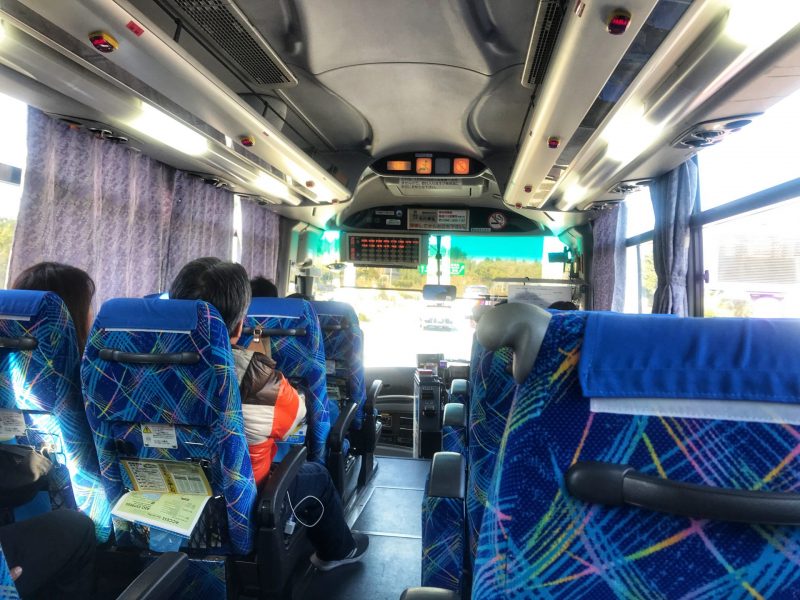
Japan has the best and most effective public transportation system in the world, making it easy to get around the country, either by high-speed train (Shinkansen), local train, bus, or self-driving .
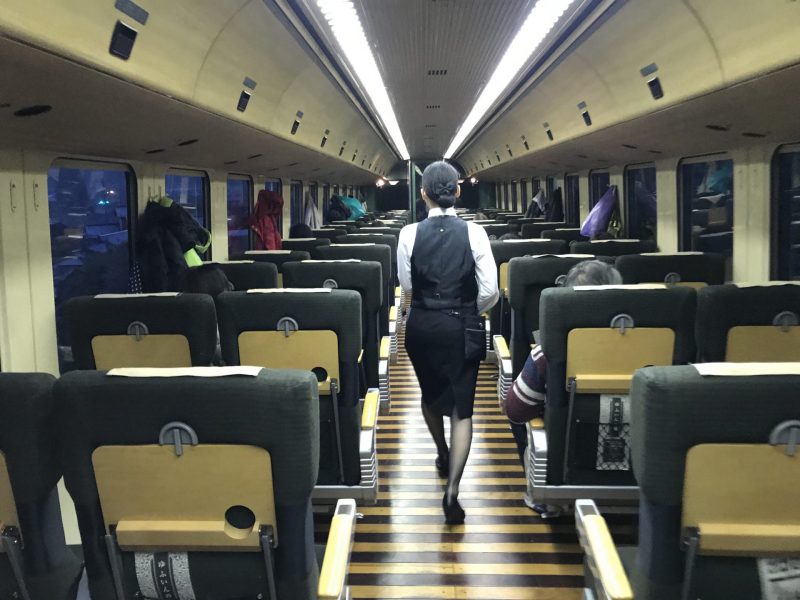
The Japanese train system is amazing with an extensive network of high-speed trains that can take you almost everywhere in Japan. Trains are typically reliable, comfortable, run on time, and are super fast. Train travel is the best option, for city-to-city transfer when you planning to move between the major cities. It can be done by bus but it would be much slower. Most of the time, we used the train to travel around Japan.
Check the Japan JR Pass to travel in Japan with hassle-free
Renting Car in Japan
If you want to have a bit more flexibility, have an easier time getting off the beaten path, or simply don’t want to be at the mercy of inconvenient train or bus timetables then renting a car could be a good option for you. While you don’t need a car in big cities and towns in Japan (all of the city centers are incredibly walkable and public transit is quite good), it can be really helpful if you want to get out into nature or visit some areas with fewer public transit connections such as Hokkaido and Kyushu.
Find and compare your rental car at RentalCars.com .
Self-driving is the best way to explore the regions especially if you are traveling with family and kids. If you’re interested in hiring a car in Japan, we recommend using RentalCars.com to find the best prices on a car rental. Different options and a wide selection of cars with price comparisons.
Besides, we also documented how to rent a car and drive in Japan. Read here for the Useful Tips on Renting A Car in Japan .
What is JR Pass?
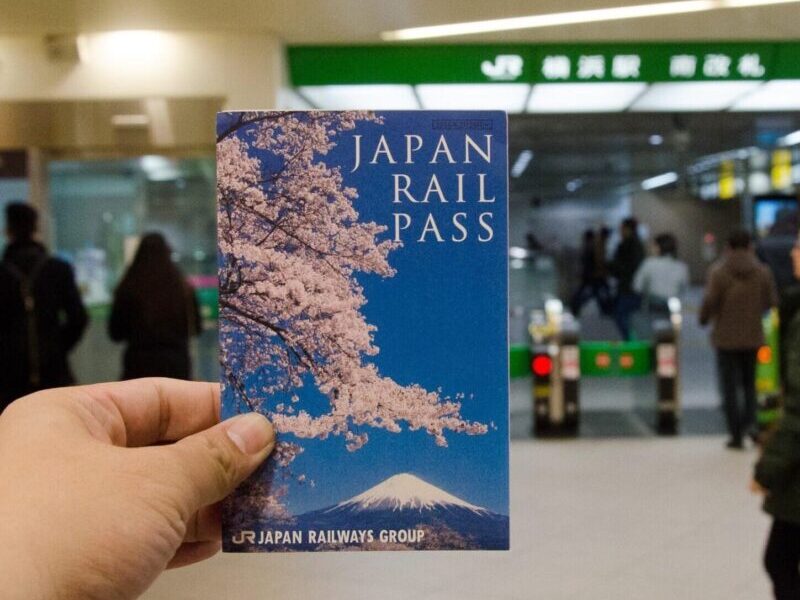
As a traveler planning on a DIY itinerary to Japan , for sure you heard about JR Pass . JR Pass is a form of rail pass that provides almost unlimited access to all JR trains in Japan for 7, 14, or 21 days. This is a unique train pass available only to foreign visitors that makes train travel much cheaper.
But take note, JR Pass is only valid for JR trains under Japan Rail Company . In Japan, many train companies are well-connected between and within the cities, and JR is one of the biggest and most comprehensive train companies with Shinkansen also under JR.
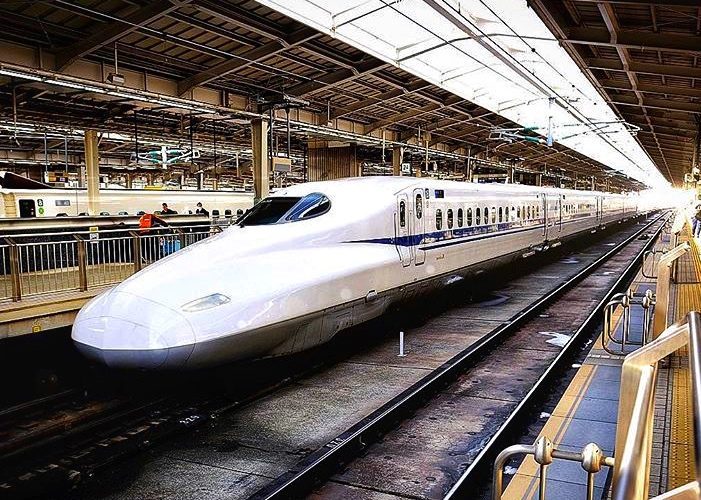
Getting a JR Pass makes sense ONLY if you are planning to visit multiple cities in Japan. The JR Pass is not cheap but the train fare between cities isn’t cheap too! You’ll be saving a lot more by getting a JR Pass. The pass is counting by days, so we recommend that you wait to activate your JR Pass until you are leaving Tokyo for long-distance train travel around Japan.
The easiest and least expensive way to buy the Japan Rail Pass is online from an official JR Pass vendor before you leave for Japan. It is considerably cheaper (10 to 13% cheaper) to get it ready at your home country compared to buying it on the spot. You can check out the latest prices for green and ordinary passes on Klook or Japan Rail Pass for more information.
Click here for prices & information on how to order and save with the JR Pass .
Japan Travel Tip : Due to the massive price increase for the Japan Rail Pass, travelers might find it harder to maximize the value of the JR Pass. This pass will only be worth the money if you plan to travel to many places in Japan. You can get the Point-to-Point Shinkansen Ride with a QR Code for a hassle-free ride.
Planning on Japan Itinerary
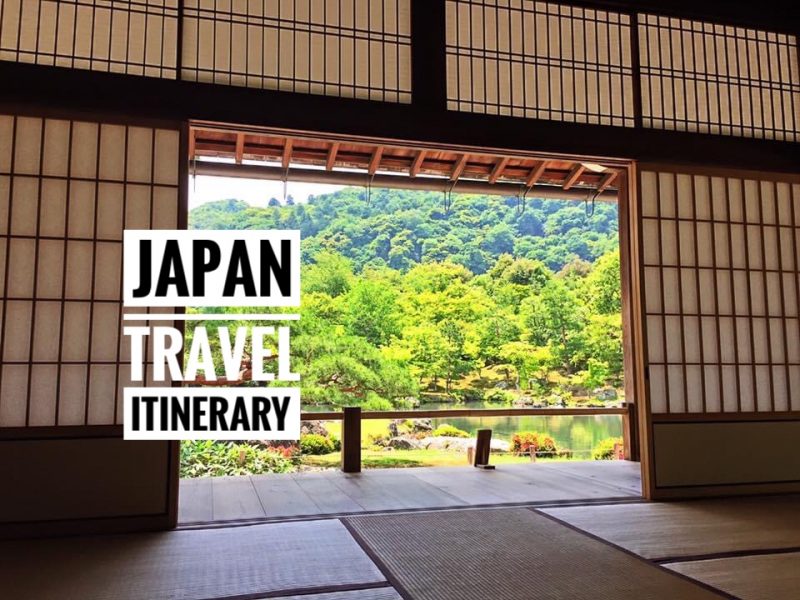
Although Tokyo, Osaka, and Kyoto are three of Japan’s most iconic cities, there are still many interesting places to explore. For first-timers visiting Japan, 2-weeks is the best duration to experience the highlight of Japan .
With two weeks in your hand, you can plan your Japan itinerary with the most popular travel route, Tokyo, Osaka, and Kyoto, and included some day trips from the big cities, such as Hakone, Nara, Uji, and more. You can also include some of the central regions and visit the traditional Japanese village if time permitted.
We will include the recommended day trip as part of this Japan itinerary travel guide blog. Besides, rest assured, this Japan itinerary can be also flexible if you only have less than 2 weeks in Japan. We will reduce the traveling time and guide you on where to stay in Japan, without keeping switching to hotels when traveling here.
Here are some sample Japan itineraries to visit Tokyo, Kyoto, Osaka, Nagoya, and Hiroshima area with travel tips at each session.
Our Japan itinerary (Popular Route) :
- Day 1 – 5: Arrived in Japan. Exploring Kanto Region in Tokyo and nearby day trips. (At least 3 Days)
- Day 6 – 11 : Heading to the Kansai region for Kyoto, Osaka, Nara, Uji, and more. (At least 4 Days)
- Day 12 – 18 : Proceed to Chubu Region to Takayama, Shirakawago, Kanawaza, and more. (At least 4 Days)
- Alternatively, further to the Chugoku region to visit the infamous Hiroshima and Miyajima (At least 2 days)
All different routes are the ideal itineraries to follow if you want to explore several Japanese cities in two to three weeks. You can easily pick 2 to 3 popular routes from above and combine some of the small cities and towns that we’ll be going to share in the below Japan travel blog which appeals to you the most.
Let’s start to check out this ultimate Japan travel itinerary!
Japan Itinerary 1st Stop: Kanto region
Start this classic Japan itinerary in the modern and urban Japan capital of Tokyo. This incredible Japanese city is popular for a reason: it is absolutely beautiful, energetic, easy to navigate, and packed with fun and interesting things to do.
This ultra-modern city has one of the world´s best and most amazing shopping, dining, and nightlife. It is also filled with Japanese history so that travelers also have the opportunity to cover quite a bit of ground and get to know this great city. There is plenty to do and see in Tokyo. Spend at least two to three full days in Tokyo city and do short day trips outside of Tokyo!
The ideal Japan itinerary in the Kanto region is as below :
Day 1: Harajuku, Shibuya, Shikuju, or Roppongi. Day 2: Asakusa, Ueno, and Akihabara. Day 3: Tsujiki Market/Toyosu Market, Tokyo Tower, and Odaiba. Day 4 – 5 : Short trip to Hakone, Kawaguchiko, or Nikko.
Further Read More : Tokyo Itinerary – What To Do in Tokyo .
Things To Do in Japan Itinerary (Kanto Region)
Tokyo is the place to experience the modern side and culture of this amazing country. It can be divided into eight exciting neighborhoods or 23 special wards, and each place offers different types of interesting things to do and see.
Harajuku, Shibuya, Shinjuku, Roppongi
Harajuku – Famed for its fashion scene, quirky culture, cosplay shops, and so much more! This is the place where Tokyo’s youth come to show off their latest fashion outfit and shop for new ones. But you can have both the traditional and modern culture on the same day.
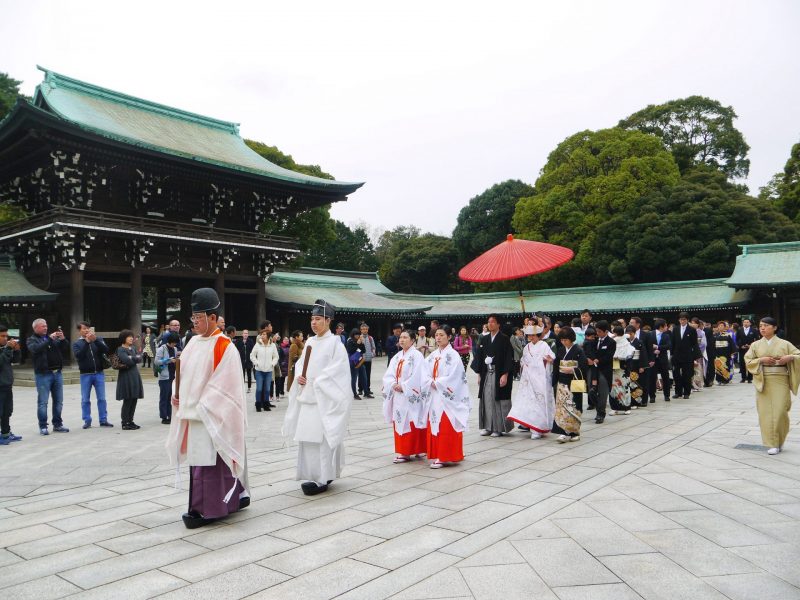
Start your day in the pleasant walk in Yoyogi Park toward to the Meiji Shrine, a historical Shinto Shrine in Tokyo located in Harajuku. You might even see the Shinto wedding if lucky!
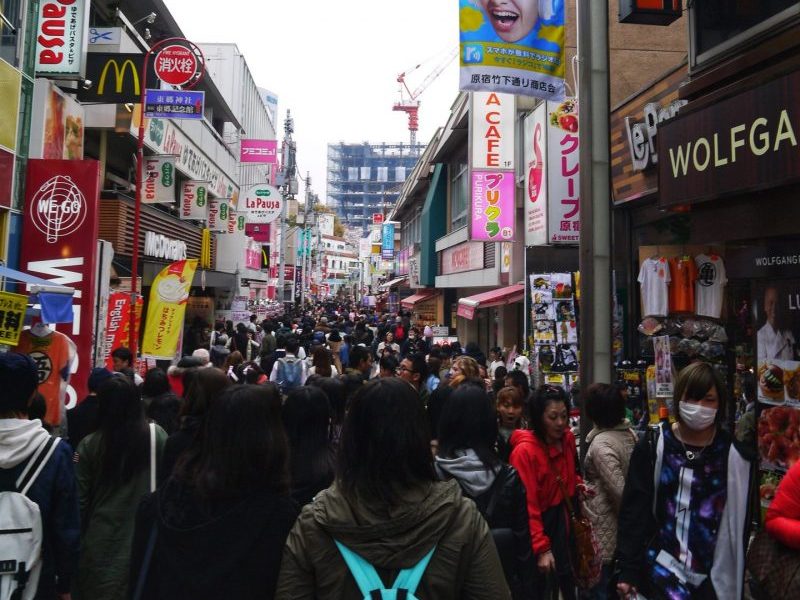
Next, walk across the street to Takeshita Dori that filled with captivating shops and cafes, trendy people, and street food. Then walking through the Omotesando, the Tokyo version of Champs Elysées, with designer boutiques and international fashion brands. The cat’s street, a more relaxed and hipper kind of vibe also hidden in the street of Harajuku.
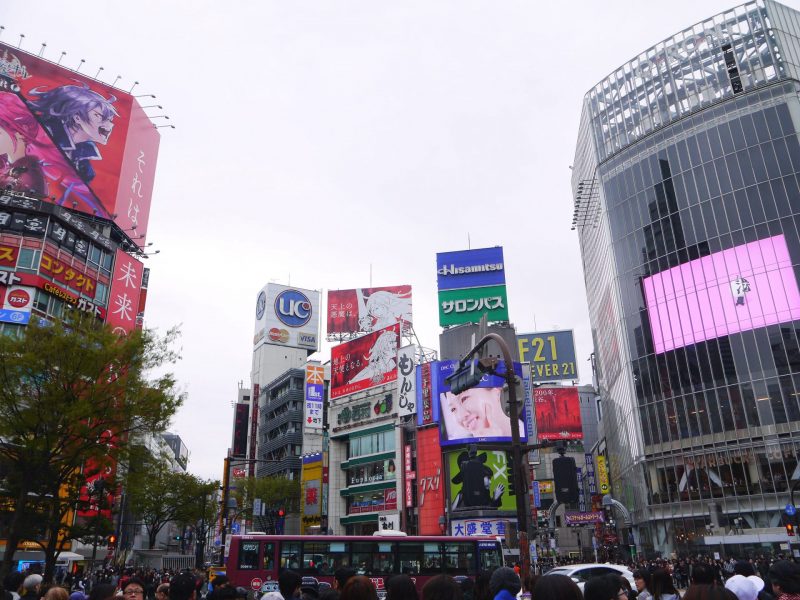
Shibuya – The center of Tokyo, along with Shinjuku. It is a major action and fun area with lots of restaurants, a shopping mall with a strong youth presence towards fashion and culture.
The famous Shibuya Crossing is found in front of Hachiko Exit, Shinjuku. Every few minutes the pedestrian light would turn green in this world´s busiest pedestrian and the entire crossing will be filled with a ton of people coming from all directions. A crazy scene that has been featured in many movies, video games, and music videos.
Don’t forget to check out the famous Hachiko Statue, a legendary Japanese dog who is famous for being extremely loyal.
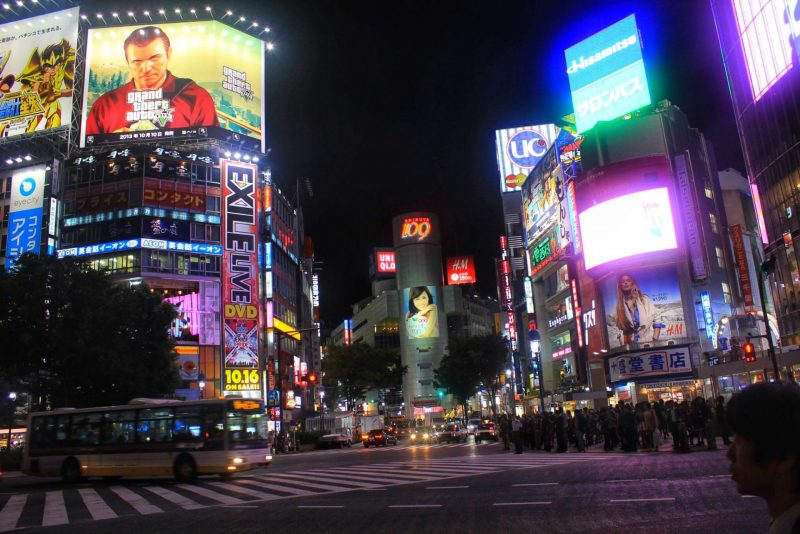
Shinjuku – Another major city center of Tokyo with the modern skyscrapers building surrounding. Go to the Tokyo Metropolitan Government Building for a bird’s eye view of Tokyo for free. In Shinjuku, you will also find Golden Gai and Memory Lane, and restaurant alleys that have been unchanged since the second world war.
The Memory Lane aka Omoide Yokocho or “Piss Alley” is featured varied tiny eateries and small izakaya, the best place to spend your dinner or supper with ramens, kushiyaki, yakitori (skewered grilled chicken), and more. You can drink Japanese beer, sake, or whiskey highball here! Having food in the Tokyo alley to feel nostalgic for traditional Japanese food.
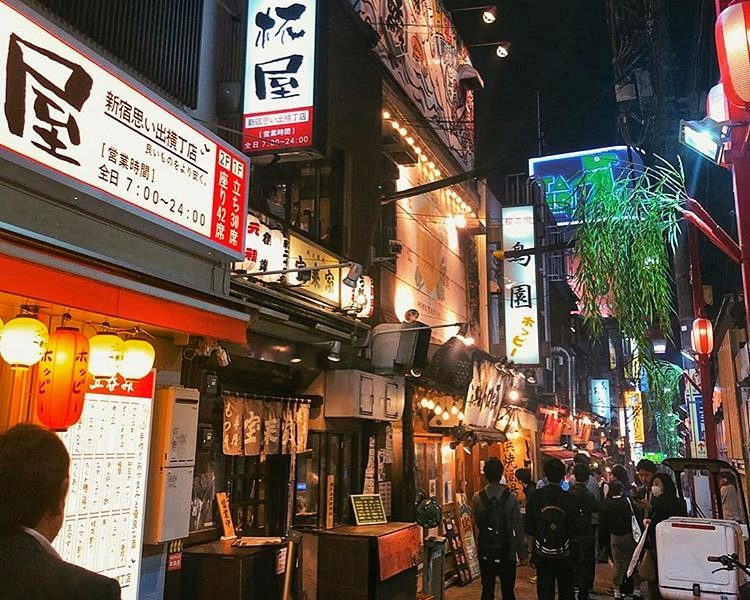
Roppongi – This area is famous for entertainment and nightlife with several galleries, shopping centers, and theaters. Together with Tokyo Metropolitan Government Building at Shinjuku and Tokyo Tower, Roppongi is featured with the best night view of Tokyo at Roppongi Hills. Just pick one of them for the best view of Tokyo city.
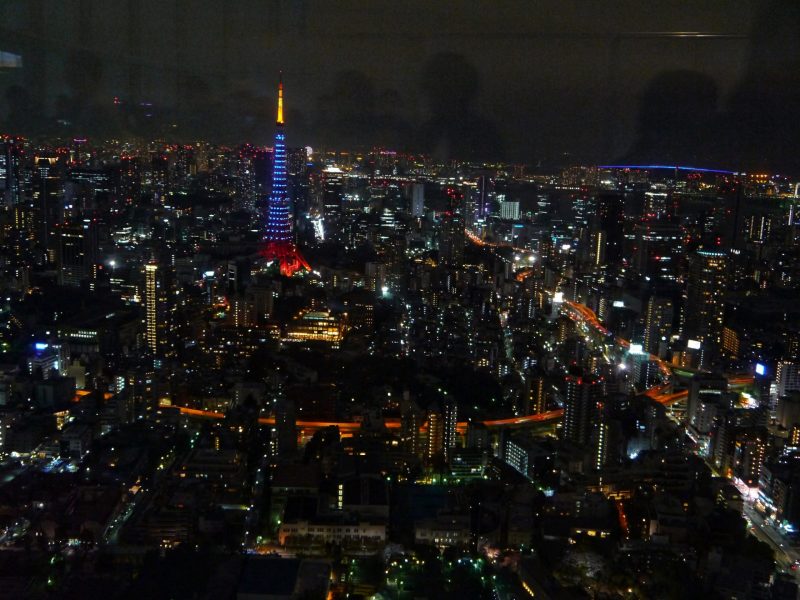
Tokyo Fish Market, Ginza, Tokyo Tower, Odaiba
Toyosu Market/Tsukiji Market – If you are a foodie like me, visiting the fish markets in Tokyo is a must. A visit to the crazy Tuna auction is one of the best ways to feel the atmosphere at the fish market in Tokyo.
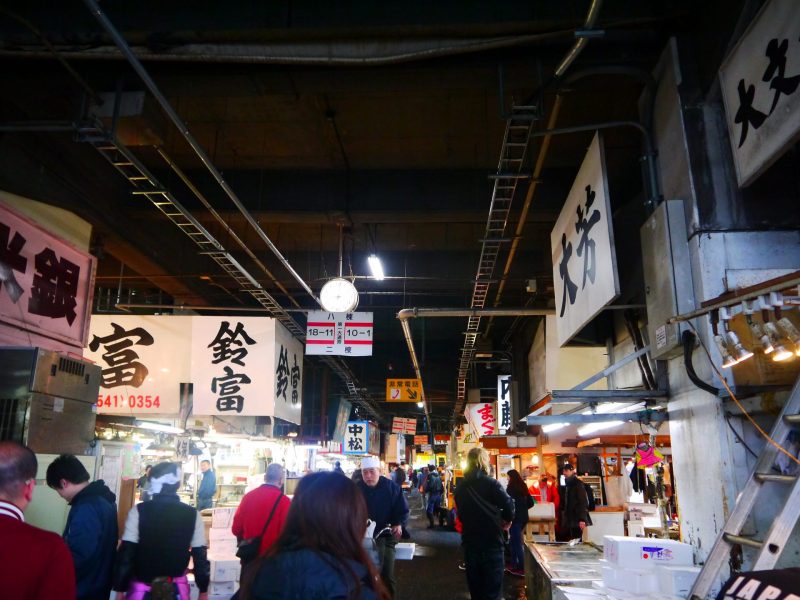
The famous Tsukiji Fish Market (inner market) has been closed down and moved to Toyosu Market in 2019. But still, you can eat the fresh sushi and sashimi at both fish markets with many the excellent seafood restaurants for a culinary visit.
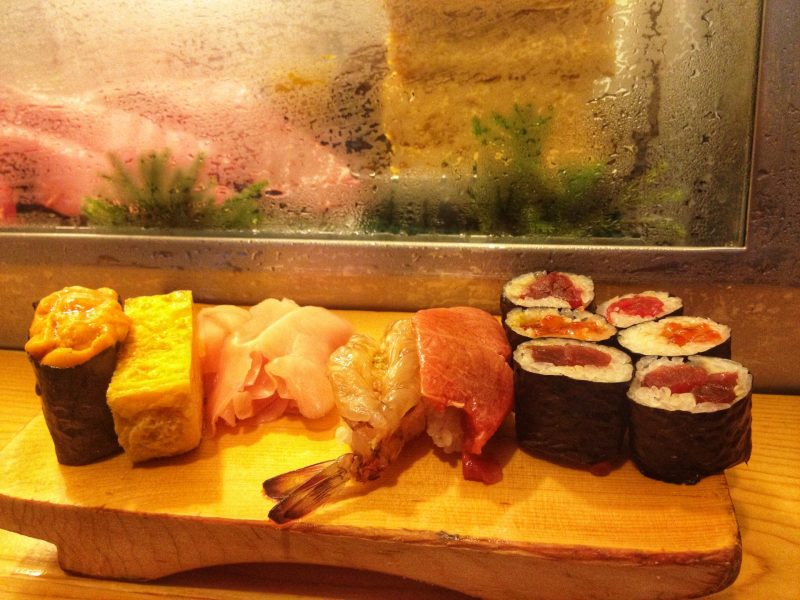
Ginza and Tokyo Tower – Tokyo’s version of New York`s Fifth Avenue, Ginza is one of the city’s upmarket shopping districts with broad boulevard shopping streets. Next couple your visit to Tokyo Tower, the signature tower of Tokyo.
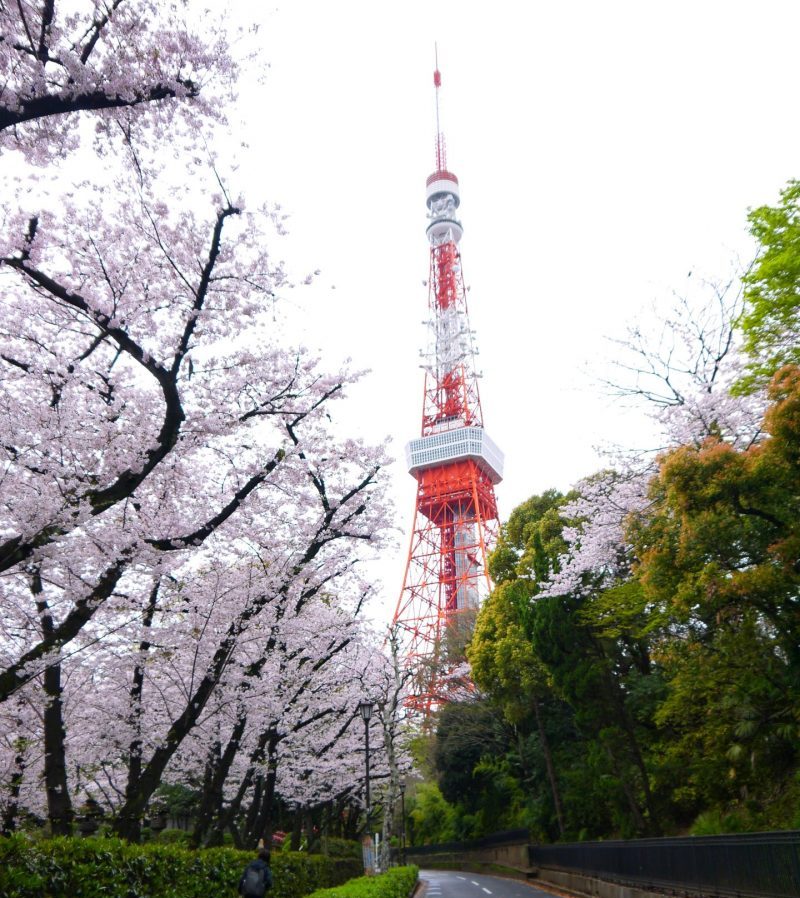
Odaiba and Tokyo Bay – The man-made island to protect the marine life and it was turned into a modern shopping and entertainment center. It consists of a beach, a waterfront, promenades, and walkways with a lovely view of the Rainbow Bridge.
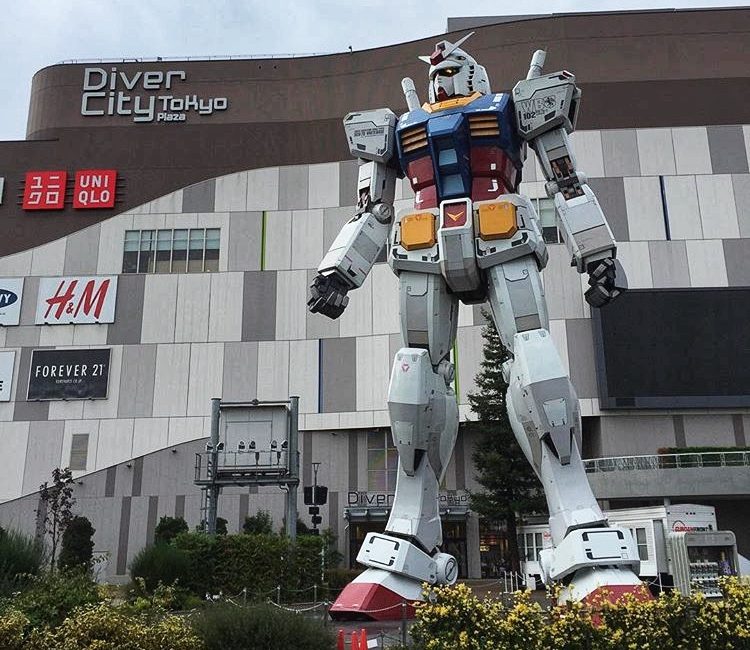
Asakusa, Ueno, Akihabara
Asakusa – The ‘olden’ district where you can get a feel of how Tokyo was in the past decades. It is the favorite district by the backpacker with many cheap foods and budget accommodation around. Find Tokyo`s most visited temple, Senso-Ji Temple, the oldest temple in Asakusa, Tokyo.
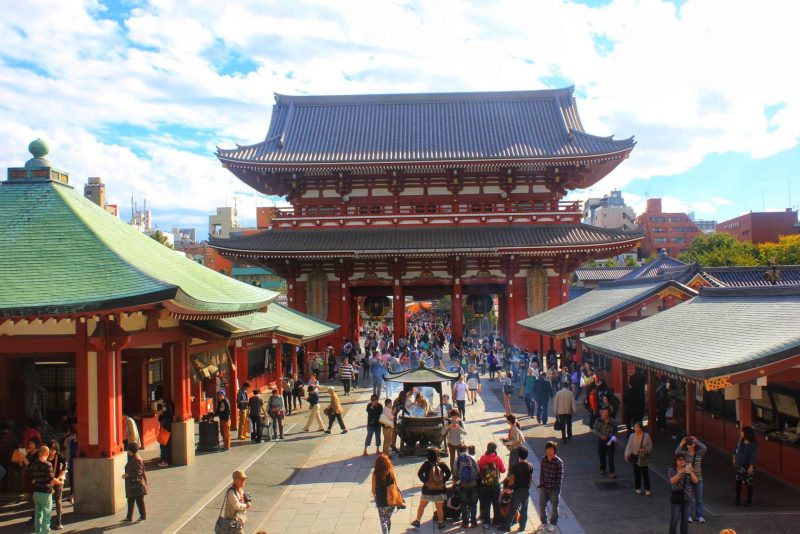
Check out its impressive bright red gate – the Kaminarimon Gate at Asakusa and walk toward the shopping street Nakamisedori for some street food and souvenirs.
Tokyo’s tallest building, the Tokyo Sky Tree is located beside the Sumida River and Park.
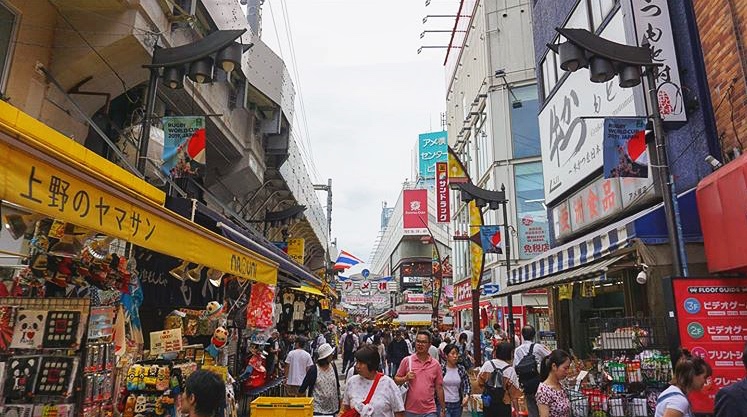
Unique Attractions in Kanto Region
If you’re planning to spend more time in Tokyo, then you may want to have some interesting attractions to visit on the Japan itinerary. Listed below are some unique tourist activities that you can include in Tokyo.
- Tokyo Disneyland and Tokyo DisneySea ,
- Street Go Karting Experience in Akihabara (Booking is a MUST!)
- teamLab Borderless (Temporary Closed for relocation)
Note : teamLab Borderless in Odaiba Closed August 31, 2022 and it is relocating to the Toranomon-Azabudai Project which will completion at 2023. Rest assure. Visitor can still visiting teamLab Planets TOKYO in Toyosu until the end of 2023.
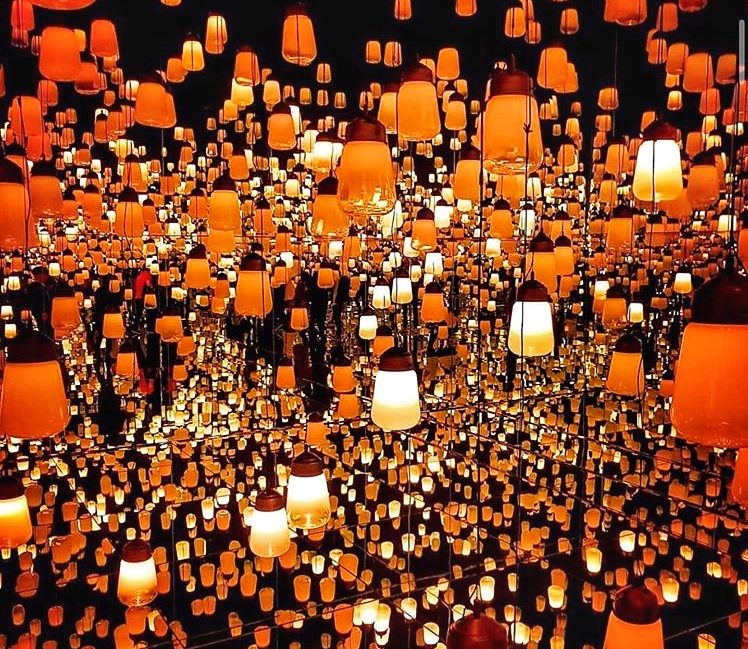
Short Trips in Kanto Region
If you’re interested in seeing more of the Japanese nature beyond its capital, use one of the days in this Japan itinerary to go on a day trip. There are countless amazing places to visit from Tokyo and for sure will give you a great view of Japan.
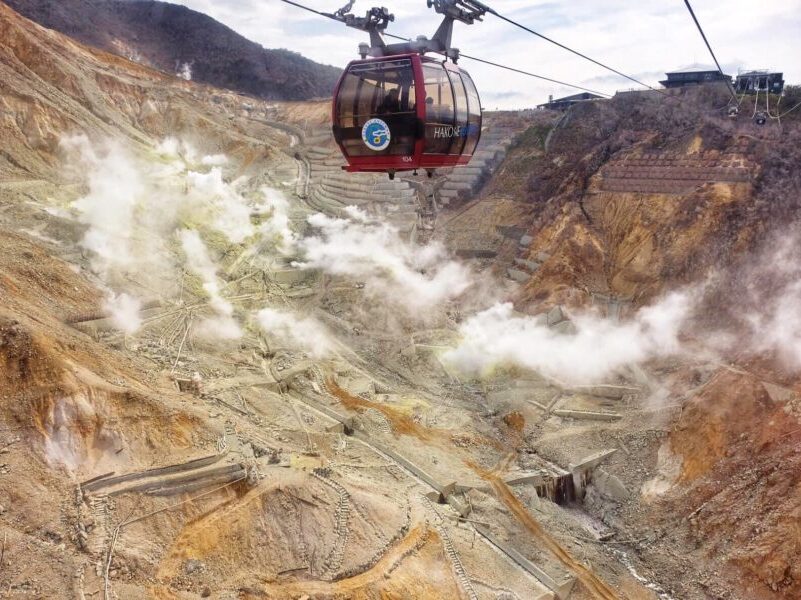
Nikko – Located north of Tokyo with 2 hours by train, Nikko is one of the most popular day trips from Tokyo. It is a lovely hillside town with an impressive amount of Buddhist temples and shrines tucked away in the green and lush forest.
Hakone – A onsen town to experience the natural hot spring bath in Tokyo. It’s also famous for beautiful nature such as Lake Ashi, and Owakudani Hell Valley, and also a chance for you to see Mount Fuji up close (depending on the weather).
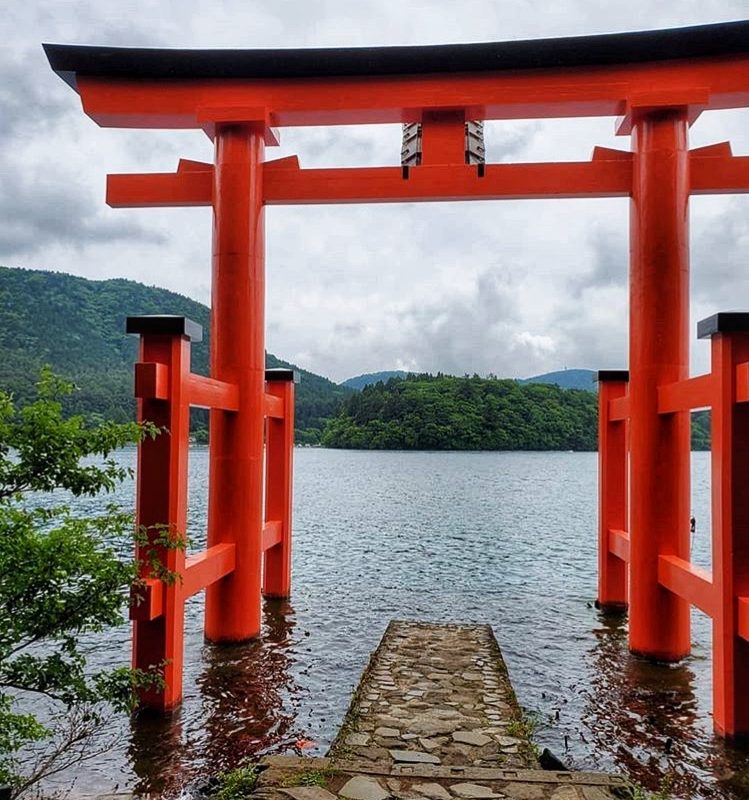
Kamakura – A beach-side little town with about a 1-hour train journey from Tokyo. Kamakura’s highlight is the stunning old Buddhist temples with a tall bronze statue of Amida Buddha, completed in 1252.
Fuji Five Lakes and Mt Fuji – A lovely area with five lakes surrounding Mt Fuji with about 2 hours by train from Tokyo. The Kawaguchi-ko is the most popular lake among the five lakes, and several temples and shrines can be planned into your Japan itinerary. The Red Chureito Pagoda with Mount Fuji in the background is one of the popular attractions in the Fuji Five Lakes area.
After enjoying a number of great days in the Kanto region, it’s time to head on to your next destination!
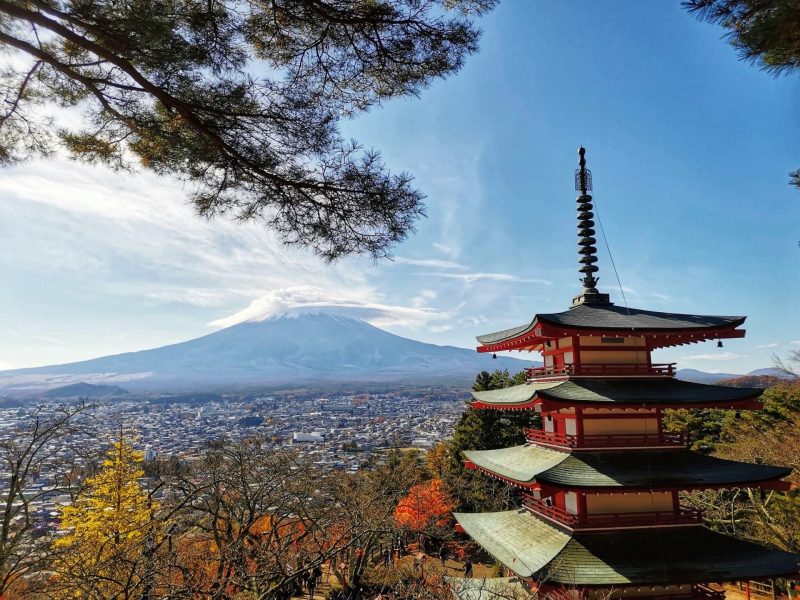
To save up on transportation costs, consider getting the transport passes to get around Hakone, Kamakura, and Fuji Five lakes areas.
Hakone Free Pass (from ¥4,600) – Valid for two or three days, can be used for unlimited travel on eight transportation options including the Hakone Tozan Train, Hakone Tozan Bus, Hakone Sightseeing Cruise, Hakone Tozan Cable Car, and Hakone Ropeway.
Hakone Kamakura Pass (from ¥7,000) – Valid for three days, unlimited use of all transportation options in Hakone areas and also to Kamakura. The transportation option also included all Odakyu Lines (Odakyu Odawara Line, Odakyu Enoshima Line, Odakyu Tama Lines, and Enoden trains between Fujisawa and Kamakura.
Read more on how to visit Hakone in the budget way : The Ultimate Hakone itinerary with Hakone Free Pass .
What To Eat in Kanto Region
Make sure to taste the mouthwatering Japanese cuisine when traveling in Tokyo city. There is so much delicious food to eat in Japan, from Michelin star Restaurants, and local traditional cuisine, to cheap budget food. Just grab a hot bowl of steaming ramen and slurp away just like the locals.
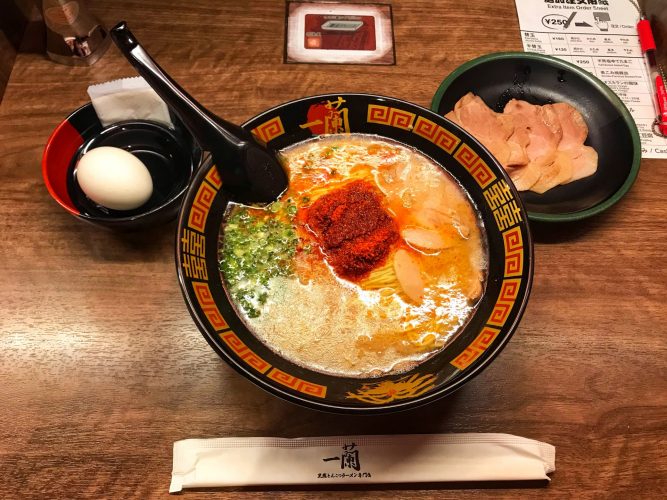
Related Food blog in Tokyo and Kanto Region for you if you’re looking for what to eat in Kanto Region.
- Mutekiya Ramen Ikebukuro: Must Eat Tokyo Best Ramen
- Ichiran Ramen Ueno: Best Ramen Shop in Ueno Tokyo
- Daikokuya Tempura: Asakusa Must Eat Food
- Chuka Soba Tomita Ramen: Tokyo Best Tsukemen
- Ichifuku Shibuya: A Taste of Tokyo Michelin Miso Ramen
You may also read our Tokyo food Guide on what Japanese dishes you must try when visiting Tokyo.
Where To Stay in Japan: Kanto Region
Tokyo has an incredible variety of accommodation available with several great places to stay in Tokyo that will suit any travel style. Accommodations in Tokyo can range from the world’s most luxurious hotels, mid-range business hotels, ryokans (Japanese style inn), bed and breakfast, lodges, and budget hostels.
If you’re looking for a great place to rest your head, click here to read our Ultimate Guide to where to stay in Tokyo .

We recommended staying in the Shinjuku area due to its convenience and close to the main transportation hub for the JR train, buses, and metro system.
Shinjuku Top Pick : Hotel Sunroute Plaza Shinjuku is our best pick and we loved it. The price is reasonable, featured comfortable rooms with excellent service and location, close to the subway/train station Shinjuku. The JR train station is within walking distance. There are plenty of excellent restaurants and eateries nearby. Extremely popular and rooms also run out fast.
Alternatively, Shinjuku Prince Hotel is located right next to the lively Kabukicho area. So you can find a lot of eateries and restaurants nearby. Added, it is only a 5-minute walk from JR Shinjuku Station. Spacious and clean room to make a comfortable stay.
Not quite what you’re looking for? Click here to browse the best deals on hotels in Tokyo .
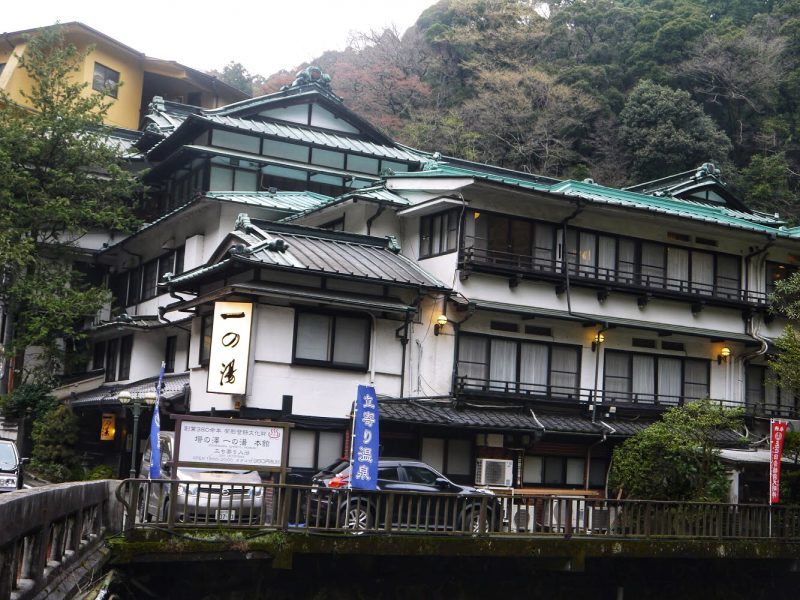
It is also best to plan to stay one night in the traditional ryokans, such as Hakone to soak into the natural hot spring bath to experience the Japanese culture in style. Our top recommendation especially for first-time travelers is Tonosawa.
Nestled in the arms of a picturesque valley, this area is renowned for its hot spring bath and quieter place to base yourself on a trip to Hakone. The historical Ichinoyu Honkan and Fukuzumiro are the perfect picks.
It can be difficult to find the best stay in Hakone, click here to read our ultimate guide to where to stay in Hakone .
Japan Itinerary 2nd Stop: Kansai Region
Next, heading to the Kansai region to continue Japan’s adventure. Here, you will explore Kyoto, Osaka, Nara, Uji in this part of Japan itinerary. Take note that it takes around 3 to 4 hours by bullet train (shinkansen) to get to Kyoto from Tokyo. With that said, the Japan itinerary for the first day in the Kansai region should be fewer, but depending on your arrival time, it’s still possible to do a lot.
The ideal Japan itinerary in Kansai region is as below :
Day 6: From Tokyo to Kyoto. Half-Day Trip to Uji. Day 7: Southern Higashiyama at Kyoto. Day 8: Kyoto West Area: Arashiyama and Kinkajuji. Day 9: Day Trip to Nara. Day 10: From Kyoto to Osaka. Exploring Osaka. Day 11: Osaka.
Of course, depending on your travel plan, you can freely swap the day arrangement or attractions in your Japan itinerary!
Related Read for Japan Itinerary at Kansai Region :
- Things To Do With Osaka Amazing Pass for 1 day or 2 days
- 15 Things To Do and Eat for 3 Days in Kyoto
- Nara Itinerary: Perfect Day Trip From Osaka & Kyoto
- Uji Itinerary: Best Day Trip From Kyoto
Things To Do in Japan Itinerary (Kansai Region)
Before continuing on the Japan itinerary in the Kansai region, make sure you understand how to travel from Tokyo to Kyoto and Osaka. The main golden route in Japan, Tokyo, Kyoto, and Osaka are connected with the Tokaido Shinkansen line. This line offers the fastest and smoothest way for traveling between Tokyo station, and Shin-Osaka or Kyoto stations, included with the Japan Rail Pass .
A standard Tokyo to Kyoto trip with the JR Pass takes up to 140 minutes at ¥13,080, depending on train type.
Speed Train running between Tokyo, Osaka, and Kyoto:
- Nozomi trains are the fastest with only 140 minutes at about ¥14,000 with seat reservation and ¥13,080 on the non-reserved seat. Not included in JR Pass.
- Hikari trains slightly slower at 160 minutes with seat reserved cost at ¥13,500 and non-reserved at ¥13,080.
- Kodama trains take about four hours with a seat reserved at ¥13,500 and non-reserved at ¥13,080.
Once everything is settled and check in to your hotel in Kyoto, it’s time to kick start again your Japan travel itinerary in the Kansai region.
One of the most iconic cities to visit on any Japan itinerary is Kyoto, Japan’s historical and cultural capital. Known for its grand colorful Shinto shrines, ancient Buddhist temples, and fantastic Japanese gardens, Kyoto is an incredible city to visit no matter what kind of Japan route your find yourself on.
Take at least two days to explore the city to its fullest, taking in all of the main sites like the Kiyomizu-dera, Arashiyama, the Fushimi Inari Shrine, and many others. Remember, no Japan trip is complete without a visit to Kyoto, it is mandatory!
Southern Higashiyama Kyoto
Located along the slopes of Kyoto’s eastern mountain, the Southern Higashiyama is a preserved historic district and very popular in Kyoto. The notable attractions include the grand Kiyomizu-dera Temple, the cozy streets of Ninen-zaka and Sannen-zaka lined with traditional wooden buildings, and the Yasada Pagoda.
Besides, it is a good idea by wearing the kimono and exploring this area to experience the feel of ‘old Kyoto’. You’ll definitely fall in love with Kyoto here and I highly recommend doing it in the unique atmosphere of Kyoto.
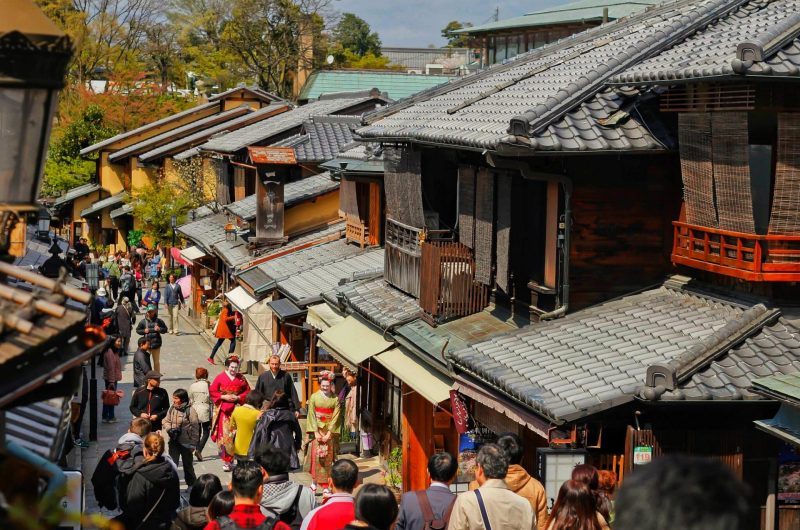
Kiyomizudera : A famous temple in Kyoto that’s listed under the UNESCO World Heritage. Best known for its wooden stage that stretches out to the hillside as it offers great views over the cherry and maple trees. (Admission is ¥400).
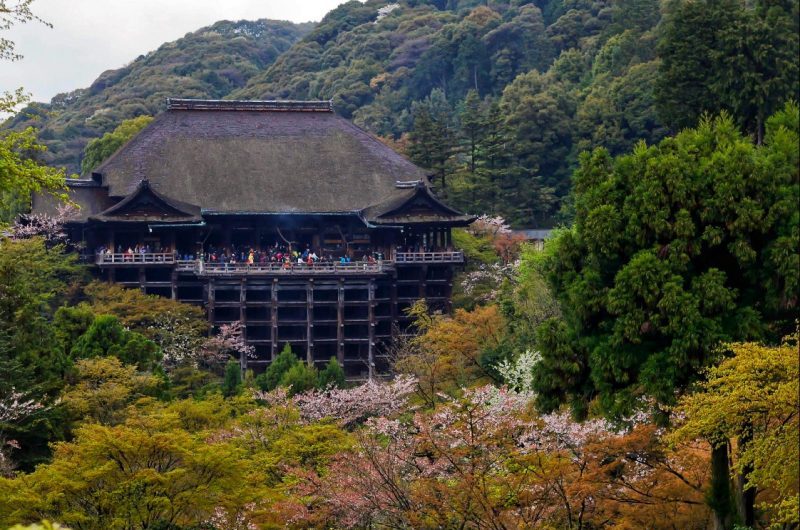
Fushimi-inari : Famous for the arcades of vermillion torii gates. One of the most important shrines in southern Kyoto that you absolutely must NOT miss! From the main base building, there are thousands of eye-catching torii leading to the forest of Mount Inari. The hike takes about 3 hours but you’re free to stop halfway and return to the base whenever you like.
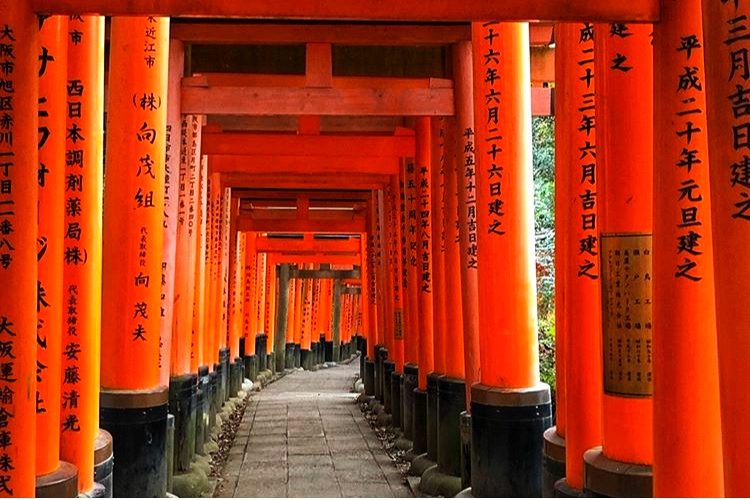
Kyoto West Area
Located on the west side of Kyoto, Arashiyama is another must-visit in Kyoto and is particularly popular during the spring and autumn season. Arashiyama is full of incredibly interesting things to do and offers so much beyond its main sights.
Plan your Japan itinerary by riding the Sagano scenic sightseeing train to Arashiyama, taking the Hozugawa River Boat ride, enjoying the scenic walk under the famous bamboo groves, and crossing the Togetsukyo Bridge, or visiting the Monkey Park Iwatayama.
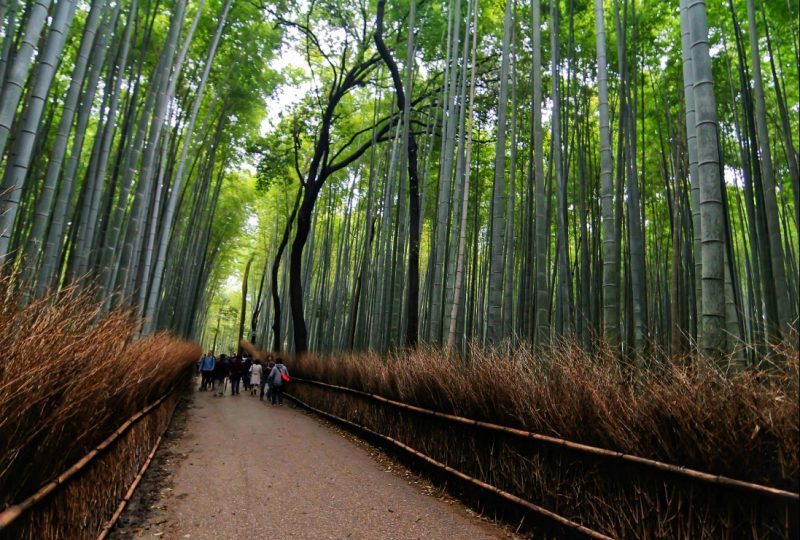
To avoid the crowd, I recommend coming to Arashiyama in the early morning. And you can also pre-book your Sagano scenic Train ticket via Klook to enjoy the mountain view at the Japanese village, riding along the Hozugawa River.
Related Read :
- Ride On Arashiyama Sagano Scenic Railway
- Half Day Trip To Arashiyama
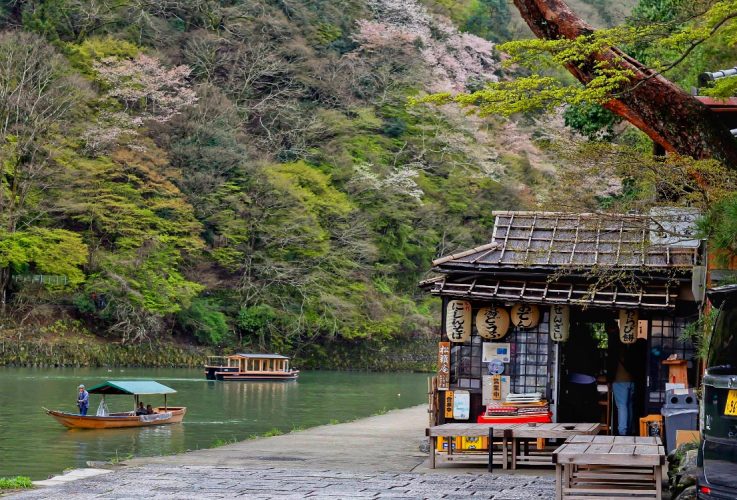
Kinkakuji : Another popular sight in Kyoto. The Zen temple is completely covered in gold leaf with golden shiny color. You can enjoy its impressive architecture as it overlooks a picturesque pond. Just follow the path and walk around the lake to marvel at the famous Golden Pavillion floating on its small lake.
Check out our trip to Kinkajuji from Arashiyama .
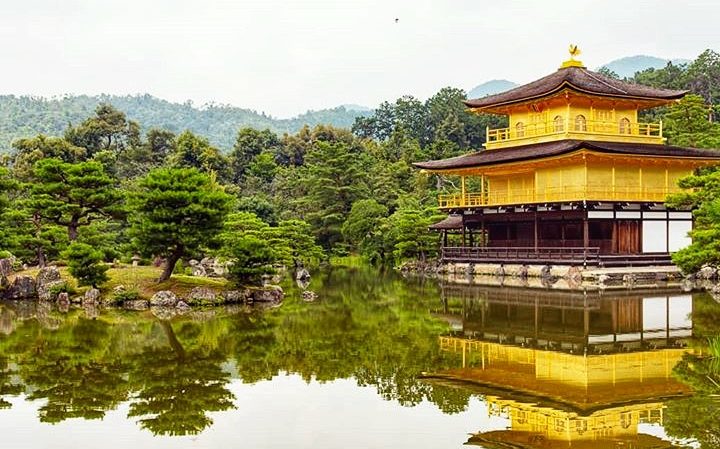
Gion : Kyoto’s historic neighborhood and offers a fascinating glimpse into Japan´s history. Some of the houses are best preserved from the Edo period until today. It is also Kyoto’s most famous geisha district. A lot of visitors come and visit with the hope to catch a glimpse of a Geiko as she hurries through the streets.
Pontocho : This is a dining area that’s packed with restaurants offering a wide range of choices from local to foreign cuisines.
Nishiki Market : Known as “Kyoto’s Kitchen”, this is a long yet narrow shopping street that features over 100 lively shops and restaurants. A great spot for you to visit for your Japan itinerary if you want to buy any fresh produce or Kyoto specialties.
If you still have some more time, there are still many notable temples and shrines that does not include in this Japan itinerary. The Nanzen-ji Temple, Ginkaku-ji Temple, Nijo Castle, Toji Temple, Kyoto Imperial Palace, and many more are worth spending time exploring in Kyoto.
Day Trip in Kansai Region: Nara
Because you have the time if you’re following this particular itinerary, it is also a great idea to go on a day trip from Kyoto. One of the most popular is the Nara, which is only about an hour from Kyoto. You could also head to Uji, which is also a great place to visit for its traditional green tea and historical shrine.
Both Nara and Uji are located between Kyoto and Osaka. So it is flexible to interchange if you want to plan for the day trip from either location.
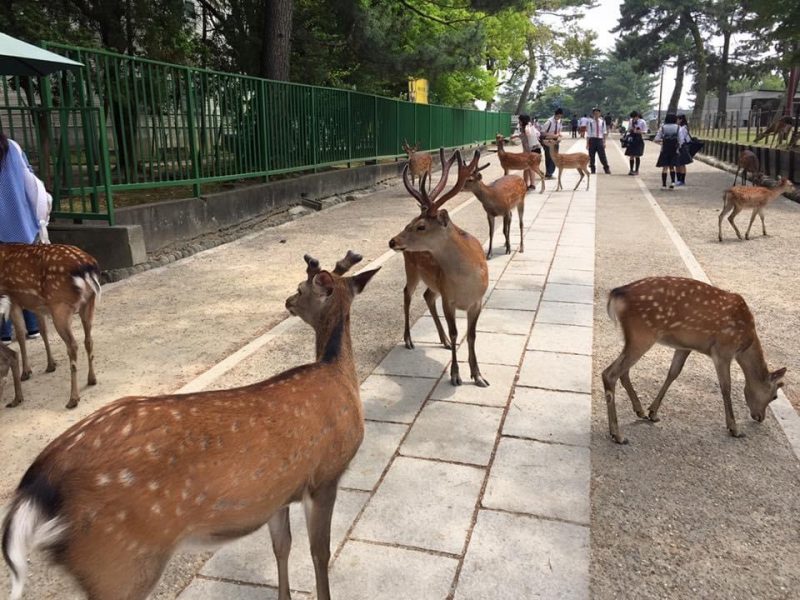
Nara : It is always a great idea to plan a day trip to Nara from Kyoto or Osaka. The traveling journey takes about 1 hour by train. You can venture into the Nara district for its historic treasures and adorable deer park.
Deer Park : The large park in the center of Nara is home to thousands of wild free-roaming deer. In the Shinto religion, deers are considered messengers of gods and Nara made them as a symbol of their city. Feed them by buying the crackers that are sold all over the park at a low cost. Do be careful though as they can get quite playful some times.
Todaiji Temple : One of the landmarks in Nara. The Big Buddha hall, Daibutsuden is the world’s largest wooden structure and houses Japan’s largest bronze Buddha statue.
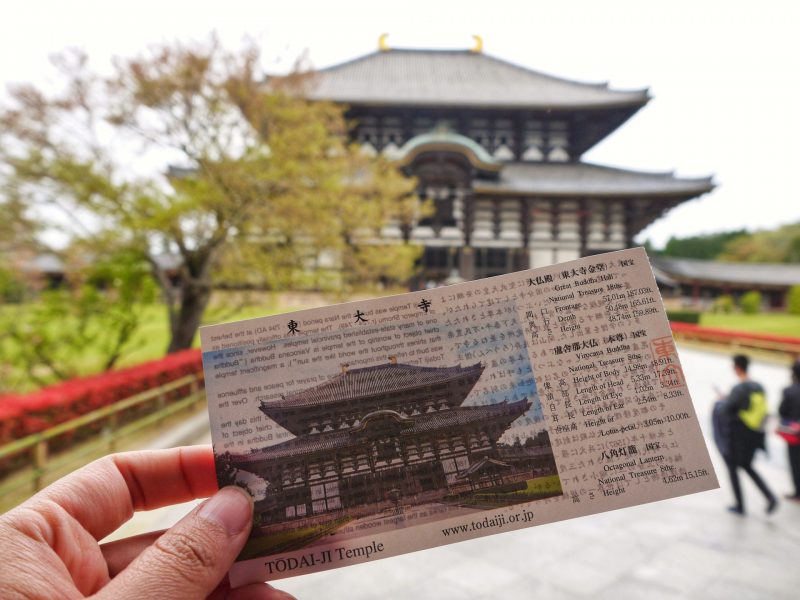
Day Trip in Kansai Region: Uji
Uji is more like a hidden gem with peaceful charm yet historical importance. It takes approximately 20 minutes by train from Kyoto Station. It is famous for its high quality green tea products and historical shrine. So don’t forget to taste the matcha green tea and dessert in Uji.
A famous temple in Uji is the Byodoin Temple. The sight of its Phoenix Hall reflected in the pond’s surface has a beauty that is beyond imagination.
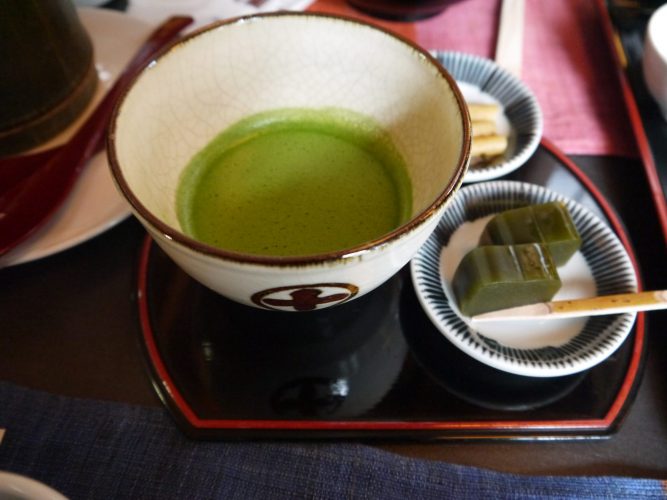
Next, it’s time to explore the amazing Osaka, the second-largest metropolitan in Japan after Tokyo. This wonderful city is best known for its grand shogunate Osaka Castle, and also a popular kitchen hub for some of the best restaurants in Japan.
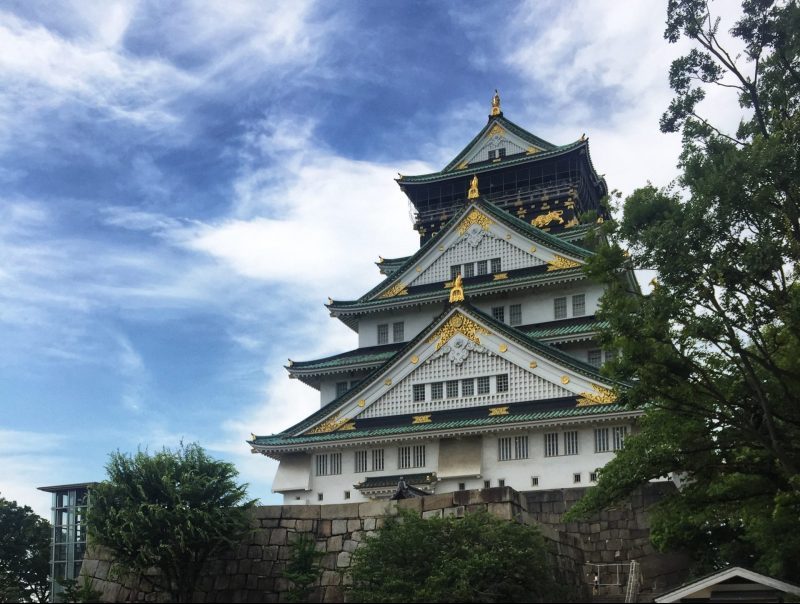
Osaka Castle : An iconic Osaka landmark, one of the few historical sights in the modern city of Osaka since the 16th century. This Japanese castle has been destroyed during the war and restores to its original with the support of the government and the Osaka people. The exterior was designed to what it looks like centuries ago, but the interior is utterly modern with air-conditioned and lifts supported.
Kuromon Ichiba Market : If you’re looking for a fresh seafood market in Osaka, this is the place to go to for your Japan itinerary. A lively covered market full of the shop selling local produce and a huge variety of fresh seafood. Taste the sea urchin, fugu fish, scallop, gigantic crab, or the toro from any one of the stores here.
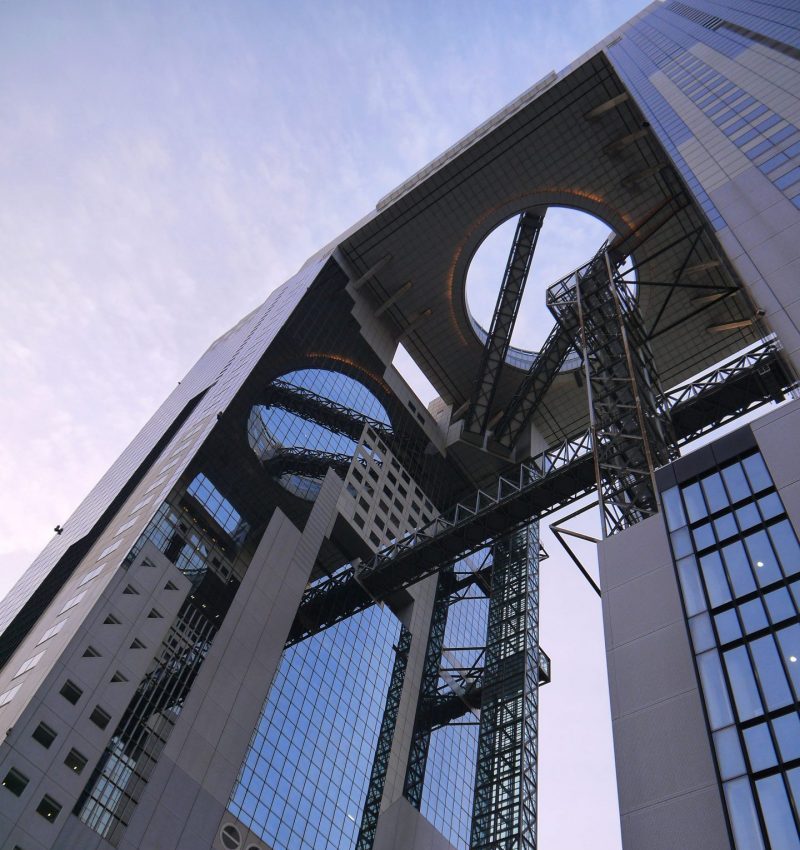
Umeda Sky Building : A 173-meter unique building design consists of two towers connected by the “Floating Garden Observatory” on the 39th floor. Don’t miss out on the photo opportunities on the long escalator that leads to this observatory!
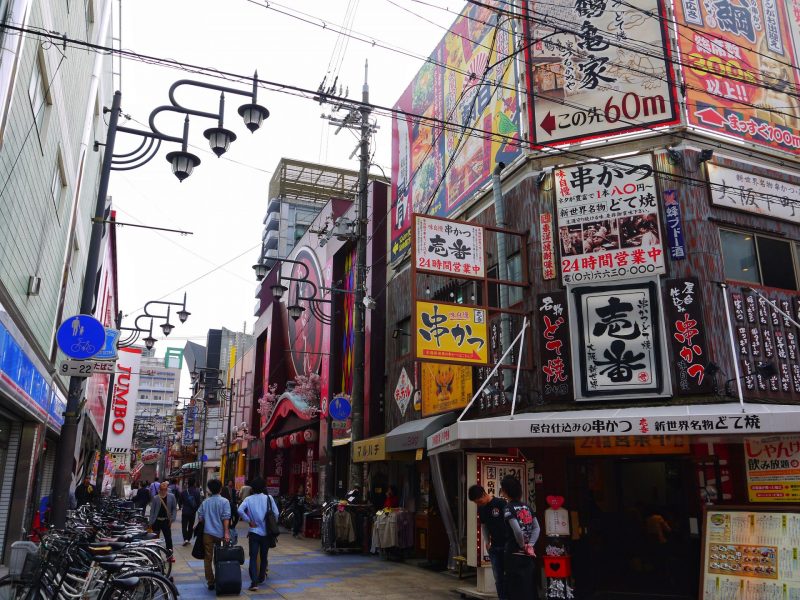
Shinsekai : An entertainment district in the early 20th century but was neglected in the decades afterward. It is now is full of uniqueness and memorability with many nostalgic and vintage things. Visit the Tsutenkaku Tower (the symbol of the district) and taste the kushikatsu (battered deep-fried foods) in Shinseikai.
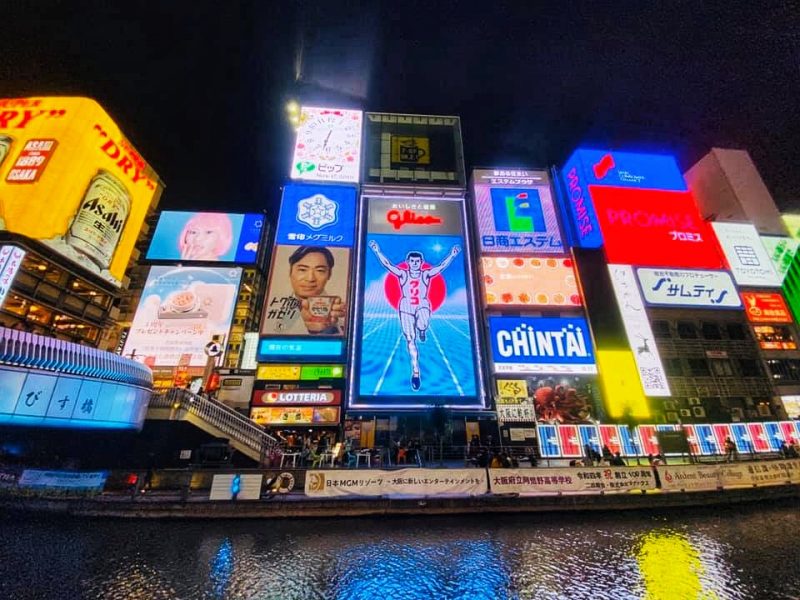
Dotonbori : A lively entertainment area that runs parallel to the Dotonbori canal. In Dotonbori, you’ll find it full of shops, restaurants, and bars with eye-catching billboards and neon lights. The signature Glico’s Running Man signboard is located at Dodonbori. Make sure that you visit here at night!
Unique Attractions in Kansai Region
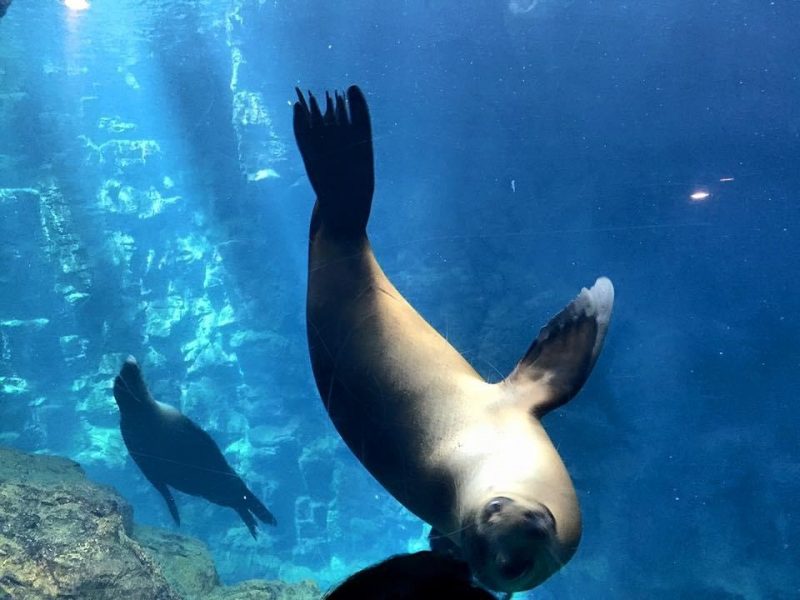
There are also some unique attractions that worth to coupled into your trip in Kansai region.
Universal Studios Japan needs a little introduction. It’s one of Osaka’s most visited attractions, and worth to spend your time in this famous Theme Park. Favorite attractions include the newly open Mario Adventureland, The Wizarding World of Harry Potter, the Minions, Transformers, and Jurassic Park!
Universal Studios Japan (USJ) with 1, 1.5 and 2-day Studio Pass
Osaka Aquarium Kaiyukan was an amazing experience and would recommend this to anyone who loves sea creatures. It is one of the world’s largest aquariums, with over 600 species of animals and witness aquatic animals of the Pacific Rim in the recreation of their habitats.
Skip the ticket queue with Klook voucher !
What To Eat in Kansai Region
Osaka is known as one of the ultimate food destinations in Japan. It is a city with passionate food lovers and an abundance of things to eat. Takoyaki (Octopus Ball), Okonomiyaki (Japanese Savory Pancake), Kushikatsu (Battered, Deep-Fried Skewer), ramen, sushi, and more.
A variety of food and restaurants can be found in Osaka. If you’re not sure where and what to eat, the two main places to try a variety of food are Dotonbori and Ichiba Kuromon market.
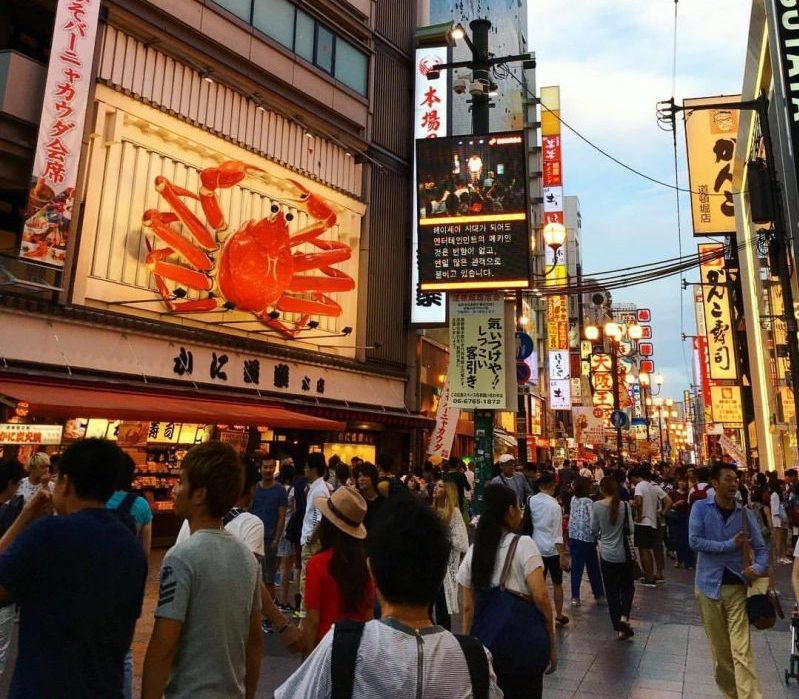
Dotonbori — Probably the best place in Osaka to get your fill of street food, you can find mouth-watering snacks here for really affordable prices. One of the must-tries is Takoyaki!
Kuromon Ichiba Market — One of the top spots for fresh seafood, you can find various stores selling freshly cut sashimi don for as low as ¥380, ramen bowls for ¥250, as well as oysters and grills on sticks.
For more food options in Osaka! Check out our Osaka Food Guide .
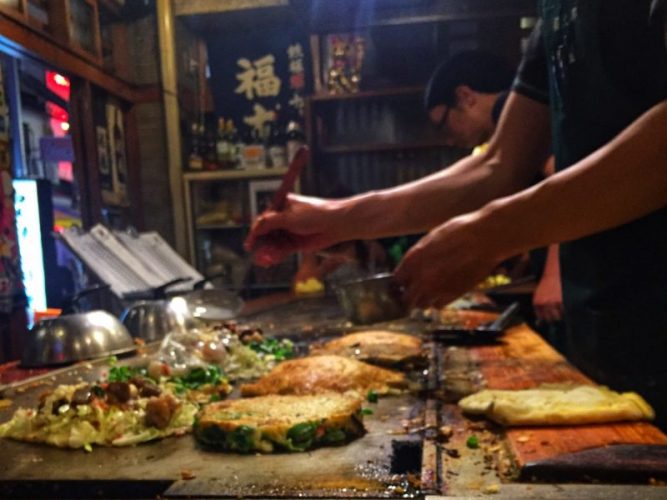
While food in Kyoto is more focus on traditional local dishes which required good quality of water to produce. You can have a good taste on Tofu, Sake, soba, or some of the modern and traditional twist food for your food journey in Kyoto.
Related Kyoto Food Blog : Top 7 Must Eat Food in Kyoto .
Where To Stay in Japan: Kansai Region
To ease on your Japan itinerary for where to stay in the Kansai region, we recommended staying in Kyoto and Osaka when planning on your Japan itinerary for Kansai region. Depend on your preferences, each area have their advantages and what type of accommodations you are interested in.
Best Stay in Kansai Region: Osaka
Osaka is the major city and a vibrant hub of the Kansai region. It has well-connected public transport with JR Shinkansen, speed trains, local trains, busses in the city. Food lovers would love to stay in the city because it is a food paradise with a variety of good choices. Osaka is not just about food, but it’s a great place to start your journey in Kansai and a handy base for most adventures and tourist hot spots. The accommodation ranges are also very wide, and great choices from luxury high-end hotels to the budget hostel.
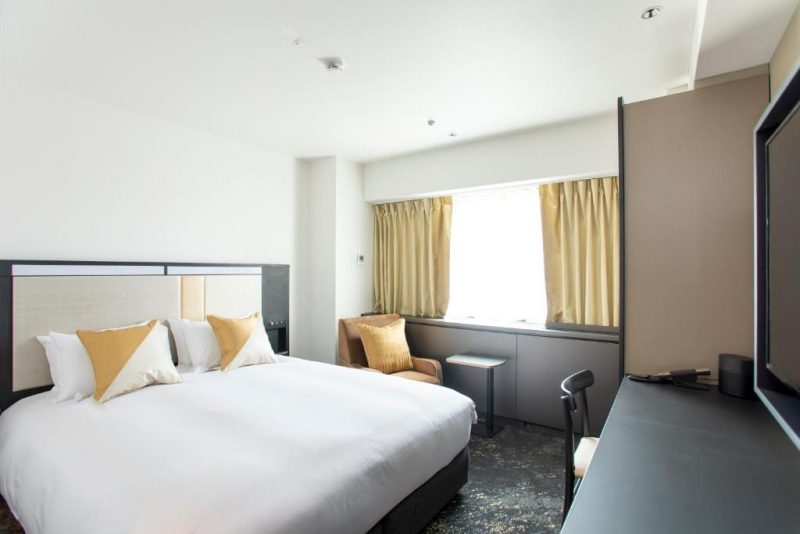
Best Value : Cross Hotel Osaka is located about a 5-minute walk from the Namba Station Midosuji Line. This 4-star hotel by far is one the most popular hotel in Osaka and always the top pick of travelers. The location is fantastic which situated between Dotonbori and Shinsaibashi. That’s mean all the restaurants and shopping arcades are within walking distance. All rooms have comfy beds and there are a lot of rooms to choose from. Personally, Cross Hotel Osaka is a perfect place for families and all kinds of travelers. Room running fast, make sure to book earlier.
Click Here to check the best current rates and availability of Cross Hotel Osaka .
Popular Pick : Nest Hotel Osaka Umeda is a 3-star hotel situated nearby Umeda Station. It is a decent chain of business hotels in Japan. All rooms are cozy and modern. Very suited and practical for the traveler who looks for a comfortable stay. Reasonable price tag too!
Click Here to check the best current rates and availability of Nest Hotel Osaka Umeda .
Best Stay in Kansai Region: Kyoto
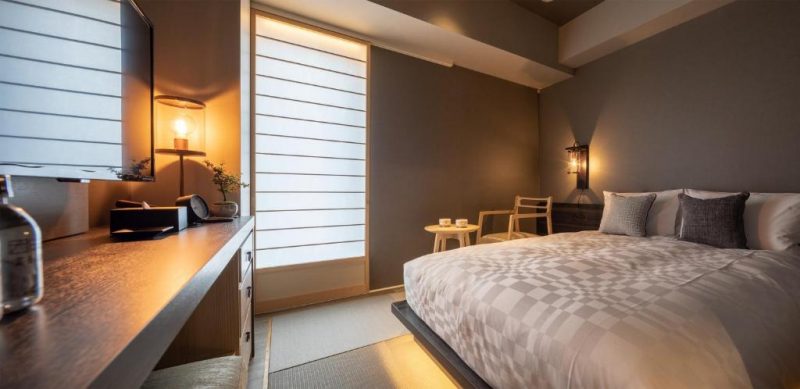
Kyoto is one of the best stay to stay in Kansai region. It is a perfect stay for lovers of history thanks to its sprawling tapestry of iconic temples, Shinto shrines and prominent buildings. If you would like to stay in a ryokan, a traditional Japanese Inn, where you sleep on futon mats and eat a traditional Japanese dinner then Kyoto has more Ryokans than any other city.
Best Stay : Hotel Resol Kyoto Kawaramachi Sanjo is another popular pick in Kyoto. You will fall in love with this cozy hotel once you walked in. The environment is so tranquil and serene with various styled rooms available. Perfect location at Kawaramachi Sanjo within walking distance from station, cool modern decor with elegant Japanese elements. Most importantly, this beautiful historic hotel is offering rooms at a reasonable price.
Click Here to check the best current rates and availability of Hotel Resol Kyoto Kawaramachi Sanjo .
Japan Itinerary 3rd Stop: Chubu Region (Option)
Lastly on the Japan itinerary is the Chubu region. In fact, the Chubu region is my favorite travel destination of all. Many notable attractions are worth to into your Japan itinerary. Here is the best pick from my travel experience with all the highlights that you’re not gonna miss. We have considered the traveling time and interest in below Japan travel plan, and you’re welcome to change according to your needs. Our recommendation attractions included.
The ideal Japan itinerary in the Chubu region with 5 days is as below :
Day 12: From Osaka to Takayama. Day 13 – 14: Kamikochi and Stay in Hirayu Onsen Day 15: Shiragawago. Day 16: Kanazawa. Day 17: Tateyama Kurobe Alpine Route. Day 18: Matsumoto.
Things to do in Japan Itinerary: Chubu Region
Takayama: If you’re looking for a thoroughly old and authentic traditional Japanese village, traveling to the city of Takayama is a must. It is a beautifully preserved old mountain city located in northern Gifu Prefecture in the heart of the Japanese Alps. Strolling in Sanmachi Suji with beautiful old preserved streets lined with charming old wooden houses with small shops, cafes, and restaurants.
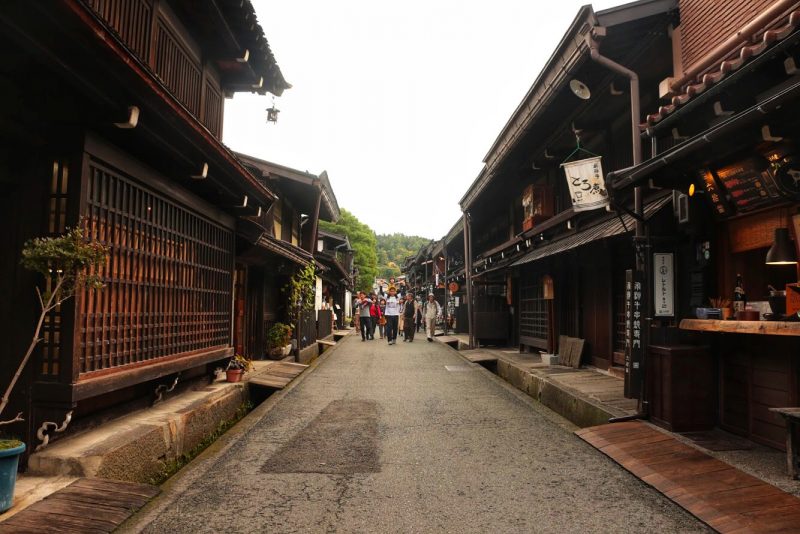
Sample some local specialties such as Hida beef sushi, Mitarashi Dango (savory skewer rice ball topped with soy sauce and sesame paste), and taste the local sake. It all makes you feel like you are back in the old Japanese Edo period.
Check if your Japan itinerary falls within the famous Takayama Festival, one of Japan’s best festivals . It is held in the old town twice a year, in spring (14th – 15th of April) and autumn (9th – 10th of October), a great fun experience.
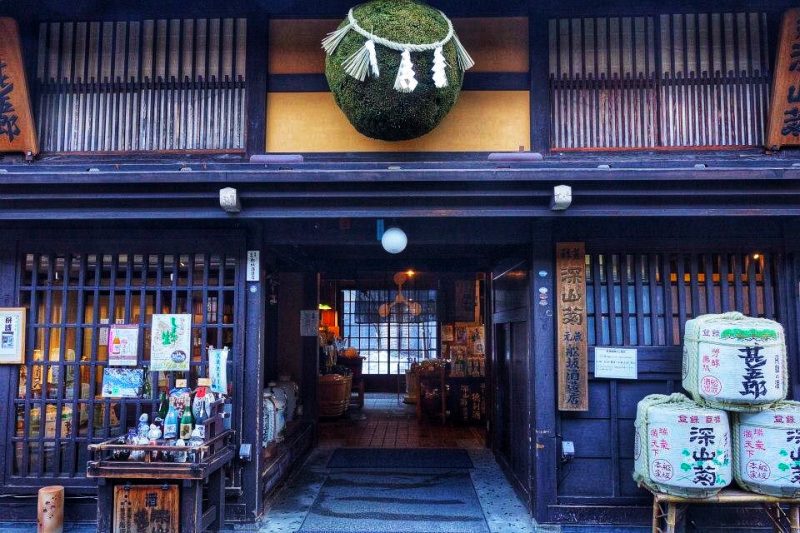
We loved Takayama and recommended spending at least one day in the beautifully preserved old city of Takayama. Many budget accommodations and nice ryokans (traditional Japanese inns) that you can consider spending one night here.
Where to Stay : Located within the historical area in the central town, this delightful Hotel Wood Takayama gains its popularity. The Takayama’s top attraction, Sanmachi street is just a door away. This brand new hotel has a beautiful contemporary design and traditional touch, ideal for unwinding after a day of adventures. Extremely popular and room easily fully booked.
Getting To Takayama from Osaka :
The simplest and most comfortable way to travel between Osaka and Takayama is to take the Limited Express Hida which runs directly between Osaka Station and Takayama Station in around 4 hours and 20 minutes. There is only one train service each day which leaves in the morning.
Alternatively, you can take the Tokaido Shinkansen from Shin-Osaka Station to Nagoya and then change to the Hida service there. The train journey takes about 3 hours and 45 minutes, and you can consider spending a little time exploring Nagoya city.
The Japan Rail Pass fully covers the Limited Express Hida and also covers shinkansen services between Osaka and Nagoya, except the Nozomi train.
Kamikochi and Hirayu Onsen
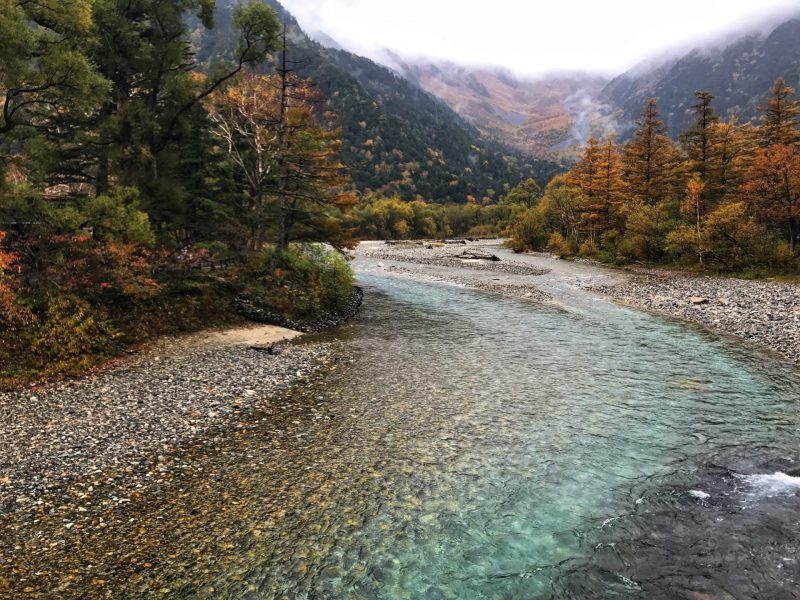
Kamikochi : A perfect day trip from Takayama for hiking in the Japanese Alps. It is Japan’s best kept secret and preserved in its natural state. Many travelers are coming along the way to Kamikochi for its stunning scenery, alpine flora, wildlife, and plants.
The whole journey took us about six hours, hiking along the beautiful Azusa river. End your hike by staying one night in traditional ryokans in Hirayu Onsen.
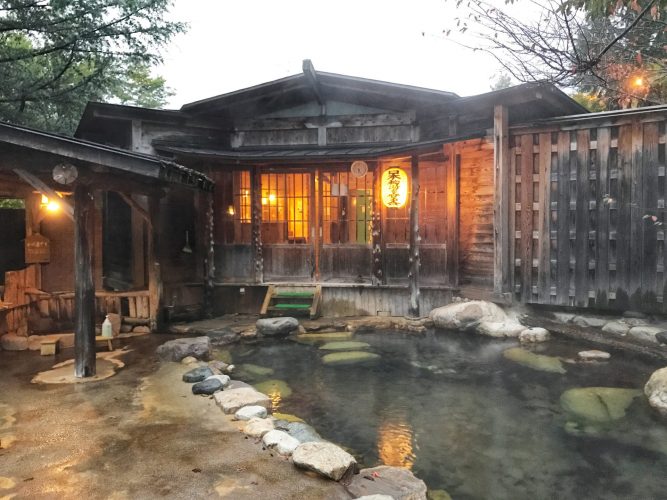
There are many traditional onsen ryokan in the Hirayu Onsen region. We stayed in the Suimeikan Karukaya Sanso (水明館 佳留萱山荘) is a hot spring paradise located in a gorgeous remote valley. It featured amazing hot spring variety with a splendid view of the mountains.
Note: Close for renovation (2022)
Shirakawago
Shirakawa-go: One of the popular attractions in Japan’s itinerary and listed under UNESCO World Heritage Sites. It is a small, picturesque traditional village in Japan with the signature Gassho-style farmhouses. The Gassho-zukuri Houses is a unique praying hand design with a steep slanting thatched roof system. Many of them are already 250 years old and most of them are now museums and restaurants.
Stroll around the narrow streets and admire the famous gassho-zukuri farmhouses in Shirakawa-go. For more info, read the Shirakawago itinerary here.
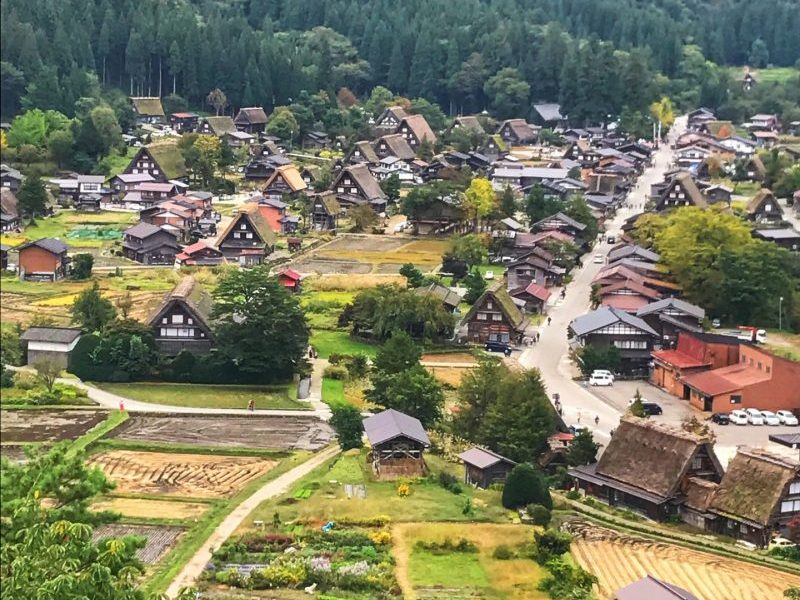
Transport Arrangement to Shirakwago :
Take the bus from Takayama to Shirakawa-go in the morning which takes about 40 minutes. Nohi bus (濃飛巴士) departs every hour, running between Shirakawago, Takayama, Kanazawa, and Toyama. When you arrived in Shirakawago, leave your luggage at the tourist center and explore the village.
At the end of the day, take your luggage and continue your travel journey to Kanazawa by Nohi bus (40 minutes). Alternatively, do a day trip back to Shirakawa-go from Takayama instead if you don´t want to bring your luggage.
The bus fare costs about ¥2,000 one way. Unfortunately, Shirakawago is not accessible by train, and JR Pass is not valid on these buses. If your Japan itinerary only covers the Chubu region, the Takayama-Hokuriku Area Tourist Pass will be covered on this.
The little Kyoto in Northern Japan, Kanazawa. It is the capital of the Ishikawa prefecture and it boasts historical attractions. Spend a day wandering around Kanazawa city, sample the delicious Japanese seafood, and visit the Japanese garden, museum, and historical building here.
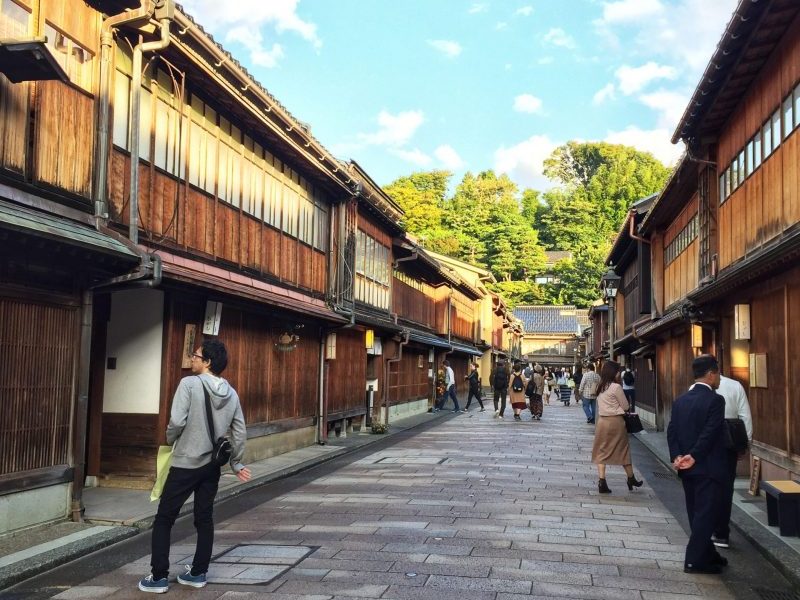
There are many things to do in Kanazawa as part of your Japan itinerary:
- Kenrokuen – A Japanese Garden ranked as one of the top three gardens in Japan.
- Nagamachi Samurai District – Beautifully preserved Samurai with full of Edo period atmosphere.
- Chaya district – The Geisha districts with old traditional Japanese wood houses and well-preserved traditional buildings in this neighborhood.
- Omicho Market – Local traditional market in Japan, selling local produce such as seafood, vegetables, fruits, and more. Best place to sample various local foods and other delicious Japanese dishes.
- And Kanazawa 21st Century Museum, Historical Kanazawa Castle, temples, shrines, and more.
Where to Stay : We stayed in Hotel MyStays Kanazawa Castle , a standard business hotel in Japan at a reasonable price tag. It has the best location in Kanazawa, within walking distance from the Kanazawa station. Guests can enjoy the in-house hot spring bath which is a great plus. Click for the room availability .
Getting around Kanazawa is very convenient with excellent bus transportation services. The Kanazawa Loop Bus and Kenrokuen Shuttle Bus covered almost all the attractions in Kanazawa city. The flat-rate fee at ¥200 per ride for adults and you can get the Hokutetsu One Day Pass at Kanazawa Station.
Tateyama Kurobe Alpine Route
If you’re up for incredible and unique nature activities in Japan, it’s a MUST to visit the stunning mountain sightseeing route that’s commonly referred to as the “Roof of Japan”. You will travel across the alps of Japan by different transport means for an awesome and unique nature experience.
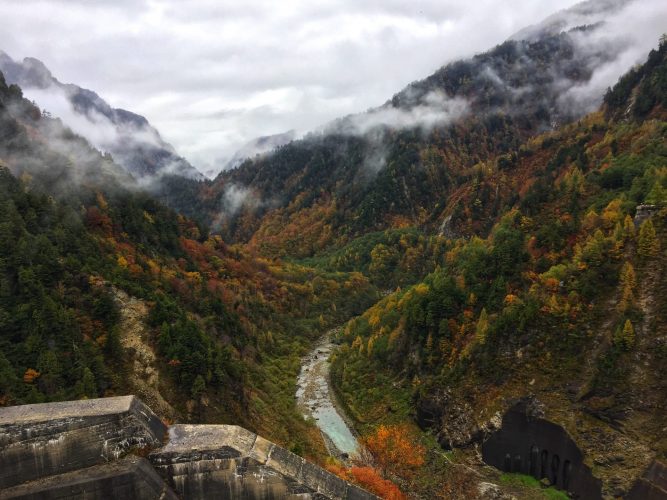
This Tateyama Kurobe Alpine Route is only open from the 15th of April till the 30th of November, as it closes during winter. The popular grand ‘Snow Wall’ that’s open from mid-April to late June. While beautiful alpine flowers started to bloom around June with the lush green mountain range, and slowly turn their color from green to yellow and red in fall.
Remember to bring warm clothes with good walking shoes. You might experience a different season here, just like us! The scenery is changing from Autumn foliage to winter sonata during our visit to Tateyama Kurobe Alpine Route in October.
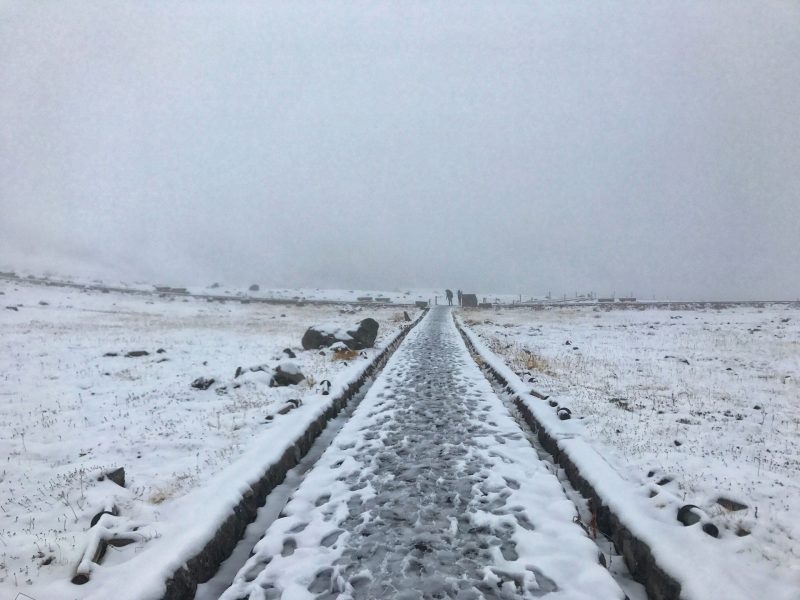
Depend on where you start your journey, either from west to east or another way round. Follow from our Japan itinerary, you can start from Kanazawa, 1 hour from Dentetsu Toyama (the start point for the Kurobe Alps). Alternatively, rest your head in Toyama if you want to start the journey early. The whole journey takes about 9 hours and you will end at Shinano-Omachi before proceeding to Matsumoto.
Take note that JR Pass does not cover the Tateyama Kurobe Alpine Route. You need to purchase the additional Tateyama Kurobe Option Ticket at ¥9,800. Highly recommended to get this option ticket to save yourself the headache.
Sound confusing? Read through the below explanation and you’ll find out it is very easy to plan on the Tateyama Kurobe Alpine Route itinerary .
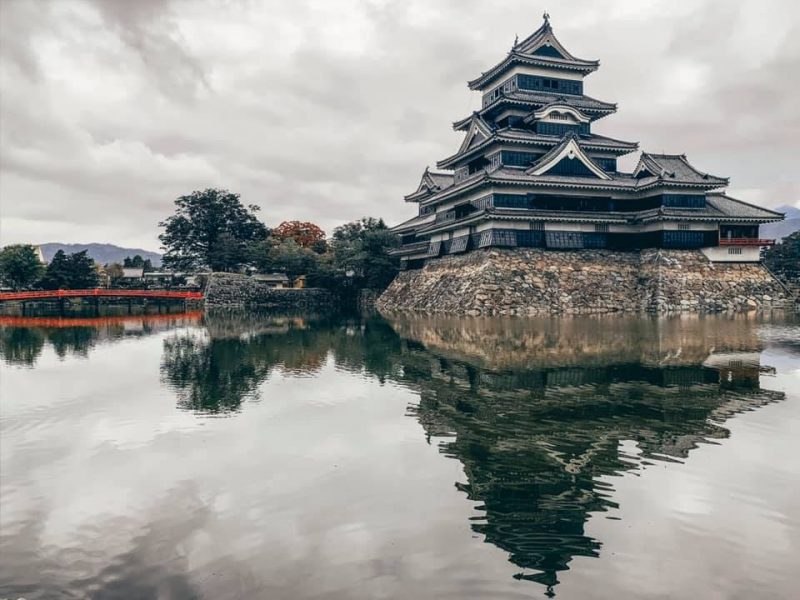
After the exhausting day on Alpine Route, take an easy and relaxing stroll in Matsumoto, one of Japan’s finest cosmopolitan cities that still have that rural feel.
The main attraction in Matsumoto is the beautiful black and white Japanese Castle, one of the Top Three Japan Premier Castle and the most complete up to today. The castle is surrounded by a lake and a bright red photogenic bridge. Spend your day in the Matsumoto castle and stroll along the Nawate-dori, along the river with cozy shops and cafes.
This is the kind of place that can keep you occupied in relaxing vibes, with its stunning castle, captivating districts, and enchanting vistas.
Where To Stay : We rest our heads in Ace Inn Matsumoto after the end of the Alpine Route trip. It is a great little business hotel with a convenient location. The location is superb, right in the center of Matsumoto, within walking distance of the train station.
A little bit of upgrade and stay at central Matsumoto, Onyado Nono Matsumoto Natural Hot Spring and Buena Vista offer luxurious and professional service at a reasonable price.
Other Notable Attractions in Chubu Region:
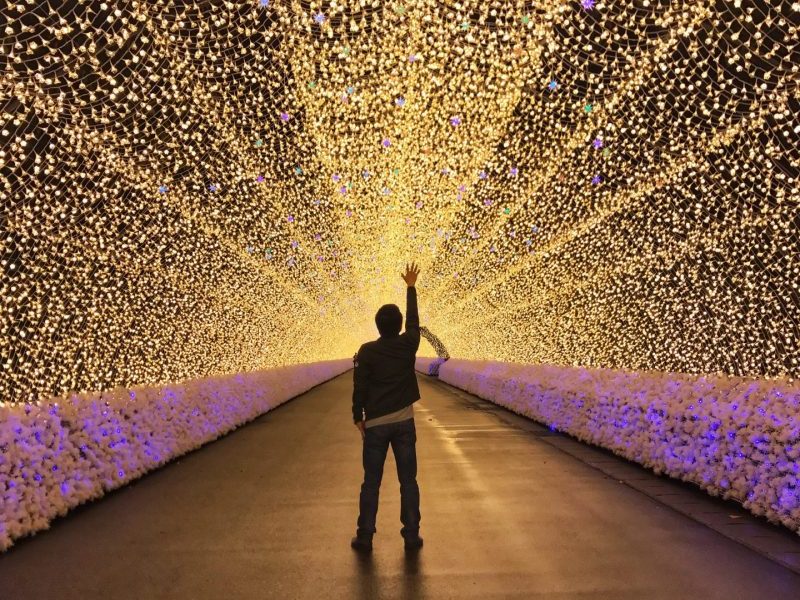
Nagoya : The main city in the Chubu region and known for its towering castle. Other notable sites are including Nabano no Sato, Atsuta Shrine, and mouthwatering tebasaki (Japanese chicken wing) and miso dishes.
See here for a list of things to do in Nagoya to plan on your Japan itinerary.
Where to Stay : We stayed in Nishitetsu Hotel Croom Nagoya and highly recommended it. Strategic location and next to the subway station. We also recommended Nagoya JR Gate Tower Hotel which is directly connected to Nagoya JR Station. It is one of the great choices for travelers looking for a convenient stay.
Jigokudani Monkey Park : The ‘Snow Monkeys’ bathing in a natural onsen is only found in Niigata, Yamanouchi. This is the best place where you can watch the snow money up close in the park. The park is open all year but if you want the best photos of the monkeys, come from January to February when the park is covered in blinding white snow.
Japan Itinerary 3rd Stop: Chugoku Region (Option)
Chugoku region is lesser known by travelers compared to the Kanto and Kansai region. But many locals love visiting the Chugoku region for its well-known historical, traditional shrines, and natural beauty. The Shinkansen ride from Shin-Osaka to Hiroshima takes only 1.5 hours. Again, for JR Pass holders, take note that you cannot ride on Nozomi and Mizuho Shinkansen.
We recommended spending at least 2 days in this region to explore it with a relaxed vibe. But, it is possible to do Hiroshima and Miyajima in one day via a day trip from Shin-Osaka. However, some planning is necessary and you can only focus on certain attractions.
Related Chugoku Region itinery:
- Hiroshima Itinerary: A Travel Guide Blog
- Things To Do in Miyajima Itinerary: A Travel Guide Blog
- Mt Misen Itinerary: Miyajima Ropeway and Hiking Travel Guide
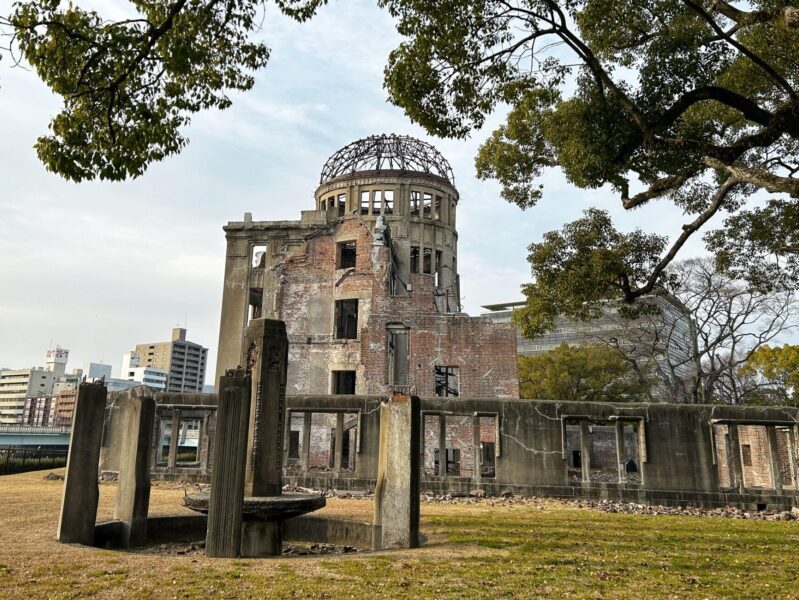
Hiroshima should be a name familiar to those who studied world history in school and all of us. With the grim past, Hiroshima is full of fantastic sights and historical attractions.
The important historical sites like A-Bomb Dome, Peace Memorial Park, and Peace Memorial Museum are all powerful and confronting. A visit to Hiroshima is truly an emotionally-encompassing experience!
Miyajima Island
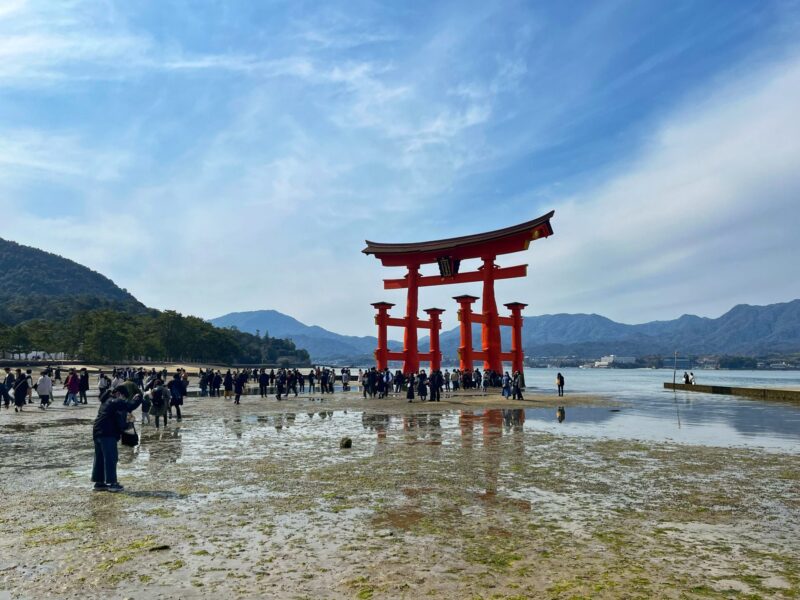
Miyajima Island : We also recommended spending another day on this enchanted island. It is only about 45 minutes from Hiroshima station with a combination of the train and the ferry. The best thing is Japan Rail Pass allowed visitors to make the round-trip by train and ferry for free!
Miyajima island houses the world-famous Itsukushima Shrine and its enormous torii gate. At high tide, this UNESCO World Heritage Site and the giant Torii gate appear to float on water. The island is so beautiful to walk around, with ancient temples to admire, and delicious food stores offering oysters and local snacks.
Where to Stay : Hiroshima Station is the best place to situate yourself if you are with a tight schedule. The location is very convenient and you can use the train, catch the streetcar, and Meipuru-pu bus when traveling around the city.
APA Hotel Hiroshima-Ekimae Ohashi is a popular chain Japanese hotel, offering a clean and comfortable stay. Conveniently located within a 4-minute walk from the JR Hiroshima station. Your stay is boasted spacious public baths at a reasonable price tag.
Related Read : Where To Stay in Hiroshima: Best Hotels Pick
How To Maximized Japan Rail Pass in Japan Itinerary
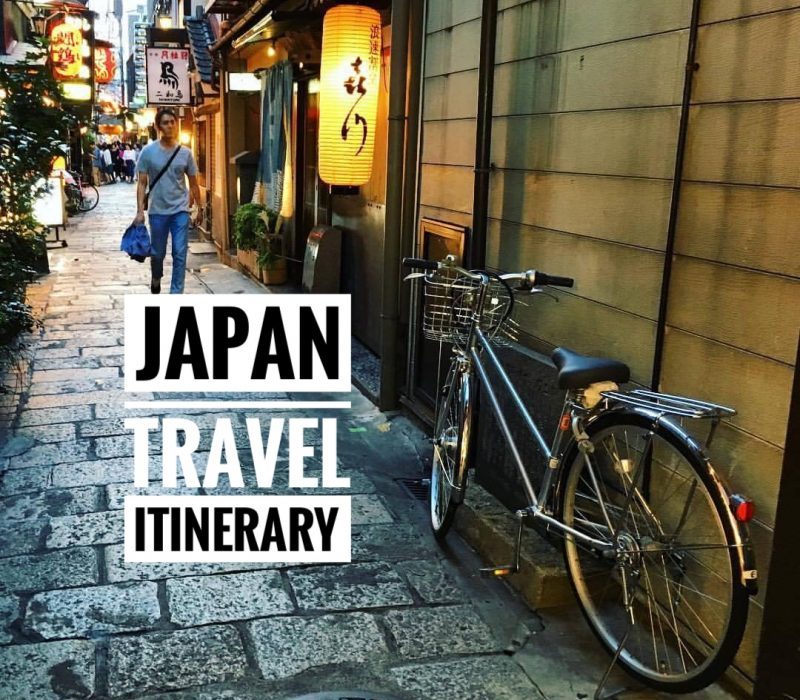
It’s hard to include all the attractions just in one Japan itinerary. The above Japan itinerary included most of the interesting places that are worth putting into your Japan travel trip, depending on your interest and budget. But there are still more hidden gems and you can’t pack with SO many interesting places in one trip.
Due to the massive price increase for the Japan Rail Pass, travelers might find it harder to maximize the value of the JR Pass. This pass will only be worth the money if you plan to travel to many places in Japan. Luckily there are more budget-friendly alternatives to getting around Japan!
Here is our recommendation for maximizing the Japan Rail Pass in Japan itinerary.
If you only have 7 days or less in Japan: It’s preferable to just stay in one region, like Kanto and Kansai, especially if it’s your first time in Japan. You can explore each region based on our recommendation.
Japan Travel Tip : If you’re only planning to visit one region in your Japan itinerary, then you don’t need a Japan Rail Pass and you can consider getting the JR regional pass for respective region.
- JR Alpine-Takayama-Matsumoto Area Pass at Chubu Region.
- JR West Kansai Area Pass that focusing on Kyoto, Osaka, Himeji, Kobe area.
- JR Wide Kansai Area Pass to visit Okayama, Wakayama, Kinosaki Onsen, Amanohashidate, and more.
If you only have 10 to 15 days in Japan: Pick any two regions for your Japan itinerary. It is possible to do 5 or 6 days in Kanto, and 5 or 6 days in Kansai Region. It is possible to squeeze in some of the attractions in the Chubu region if you’re willing to do a fast-paced trip.
Japan Travel Tip : It’s a good idea to get a JR Pass for this. You can get the 7-Day JR Pass and plan your Japan itinerary accordingly. Depends on your preferred stops, so you should read through this article.
If you only have more than 15 days in Japan: With this number of days, you’ve got all the time to take things easy! You freely extend your days per area to see any places you can explore when planning on your Japan itinerary travel route.
Japan Travel Tip : For sure you’ll travel to a lot of places. Just get a JR Pass for 14-Days or 21-Days , and plan your Japan itinerary travel route.
That being said, a two-week Japan itinerary is the best way to explore some of the popular sights and introduce some of the cities in Japan.
It’s preferable to just stay in one region, like Kanto and Kansai, especially if it’s your first time in Japan.
Pick any two regions for your Japan itinerary. It is possible to do 5 or 6 days in Kanto, and 5 or 6 days in Kansai Region.
With this number of days, you’ve got all the time to take things easy! You freely extend your days per area to see places you can explore when planning your Japan itinerary travel route.
Wrap-Up: My Japan Itinerary?
Phew! That’s it for a full detail of Japan itinerary for your trip! Japan is a country that’s rich in culture, history, and natural beauty. It’s no wonder why it’s a popular destination for travelers from all around the world.
We have traveled to Japan many times and here is all the best pick with the popular route for you to travel. Take note that it is impossible to pack all of the attractions as you will be running around from one place to the next places without enjoying the most.
Obviously, there is more to Japan other than the famous Japan travel destinations of Tokyo, Kyoto, Osaka, Nagoya , and more. We also share the links to access the Kyushu and Hokkaido region . Although those places do not include in this Japan itinerary, if you have more days on your Japan itinerary, consider filling it up with any of the following destinations!
For a complete list of amazing tours and activities to do in Japan, see here!
- Japan Travel Guide: Thing To Do and Eat in Japan
- Japan Food Guide: Must-Try Japanese Dishes in Japan
Japan Itinerary by region :
- Kanto Japan – Tokyo, Hakone, Kawaguchiko.
- Kansai Japan – Osaka, Kyoto, Nara, Uji, Kobe.
- Kansai Wide Region – Wakayama, Kumano, Kii-Katsuura, Hyogo, and more.
- Chugoku Region – Hiroshima, Miyajima island, Mount Misen.
- Chubu Region – Nagoya, Takayama, Shiragawa-go, Toyama, Kanazawa, Matsumoto, and more.
- Kyushu Region – Fukuoka, Kumamoto, Oita, Beppu, Kurokawa Onsen, Aso, Miyazaki, and more.
- Hokkaido Region – Sapporo, Hakodate, Lake Toya, Asahikawa, Noboribetsu, Otaru, Furano, and more.
Useful transportation guide to save you some money when traveling in Japan:
A Guide for Japan Rail JR Pass: Budget + Tips
- Useful Tips on Renting Car in Japan
- Finding The Best Kansai Train Pass: Budget Guide & Transport Tips
- Finding The Chubu Best Transport Pass: By Bus, Train, Self Driving
You Might Interested:
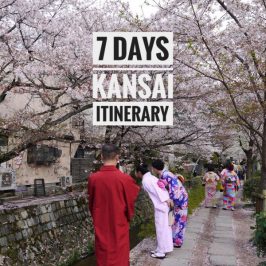
7 Days Kansai Itinerary: A Complete Travel Guide Blog
Last updated on April 21st, 2024 Planning on 7 days Kansai itinerary to Kyoto, Osaka,...
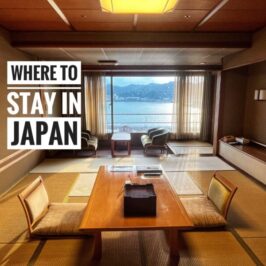
Where To Stay in Japan: Top City & Onsen Town
We have listed our accommodation guide at Japan's popular travel place. Check out read my...
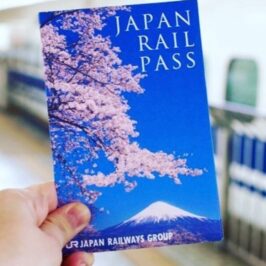
Here sharing my budget tips using Japan Rail Pass from my previous experience in Japan....
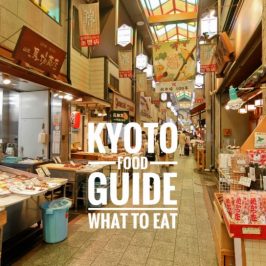
What To Eat in Kyoto: Top 8 Must Eat Food Guide
Visiting Kyoto and looking for what to eat in Kyoto? Here is the top 7...
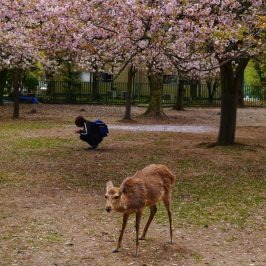
Nara Itinerary: A Travel Guide Blog To Visit Nara
Nara is very ideal for a day trip from Osaka and Kyoto by train. Here...
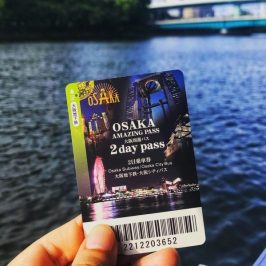
Osaka Amazing Pass Itinerary: A Travel Guide Blog
The best way to visit Osaka with Osaka Amazing Pass! My 2-Days Osaka itinerary include...

Now open: Six Senses Kyoto brings IHG’s wellness-focused brand to Japan
A nother property from TPG's list of the most exciting hotels opening in 2024 is welcoming guests — and this time, it's great news for fans of Japan, wellness experiences and IHG One Rewards .
Introducing the Six Senses Kyoto in Japan.
Made up of just 81 rooms and suites, Six Senses Kyoto is the first Six Senses property in Japan and part of the wellness-focused brand's push to enter into more urban spaces (a London property is set to open in the latter half of the year).
Inspired by Japan's Heian period (from 794 to 1185), the hotel offers a "modern interpretation" of the art- and culture-filled time through features like folding screens made with hand-crafted Rakyukai tiles; modern interpretations of art called Choju-giga, which is said to have been the first type of manga (a Japanese style of comic books); and plenty of natural elements inspired by Japanese gardens.
In the rooms, guests will find that same mix of modern and historic Japanese design, architecture and hospitality with wood-paneled walls, pillow menus, Naturalmat organic mattresses, Bluetooth speakers, yoga mats and more. Travelers who need more space can opt for suites as large as three bedrooms, and if sleep is an issue, the property offers sleep consultations for guests.
Six Senses is most famous for its wellness and spa programs — and Six Senses Kyoto has it all, including the brand's signature wellness screenings, half- to six-day wellness programs and a spa. Exclusive to the Kyoto property, the Ah-un treatment uses various rituals and sound therapies to help guests find "inner peace, balance and awakening in Zen."
Food at Six Senses Kyoto was designed to "take guests on a journey through the ancient Japanese calendar," which comprises 24 seasons, Six Senses shared in a statement. That means at Sekki, the hotel's main restaurant, meals will be hyper-seasonal, vegetable-forward and full of meat and produce sourced from nearby. The menu will constantly rotate depending on what ingredients are available.
There's also a cafe with healthy teas, juices and pastries, plus a cocktail bar, Nine Tails, with a menu of artisanal cocktails and alcohol-free creations.
Guests can also expect to see the best of Six Senses' sustainability efforts in Kyoto and even join in on a tour or various workshops to see it all in action.
How to book : Rates at Six Senses Kyoto start around $1,000 or 228,000 IHG One Reward points per night.
Related reading:
- Six Senses is opening a 3-island resort in South Carolina — and the journey starts on Hilton Head
- A nearly perfect desert oasis: The Six Senses Shaharut in Israel
- No shoes, great service: A review of IHG's Six Senses Laamu in the Maldives
- The first Six Senses in the Caribbean is now open
Editorial disclaimer: Opinions expressed here are the author’s alone, not those of any bank, credit card issuer, airline or hotel chain, and have not been reviewed, approved or otherwise endorsed by any of these entities.


IMAGES
VIDEO
COMMENTS
Get my 14 Days in Japan Itinerary: https://shop.allansu.com/b/0Y5f9Get a Pocket WIFI/Simcard: https://www.sakuramobile.jp/allansu-topGet an e-SIM for Japan:...
Today I have come to the Amazing Kyoto! This is my first time visiting and I wanted to share my first impressions of the place. Kyoto is absolutely stunning ...
🌟Subtitles Translation🌟If you are fluent in other languages, please click on the link below to help create subtitles so that other language speakers can en...
The Fushimi Inari Shrine is one of Kyoto's oldest and most historic landmarks. It is an important Shinto shrine in southern Kyoto and is famous for its thousands of torii gates that line a network of trails toward Mount Inari. Address: 68番地 Fukakusa Yabunouchicho, Fushimi Ward, Kyoto, 612-0882, Japan. Fushimi Inari Sando Chaya ...
History of Kyoto. Your Perfect 3 Days in Kyoto Itinerary. Day 1 in Kyoto. 8:45am - Nijo Castle. 11 am - Menbakaichida Fire Ramen - Lunch. 1 pm - Kyoto Imperial Palace. 4 pm - Nishiki Market. Day 2. 8 am - Kiyomizu Dera Temple.
It's Jessica of Bon Traveler here and I'm excited to share a three-day itinerary to Kyoto. When it comes to Japan, there is no destination quite like Kyoto. Having been three times, I find myself falling more in love with each visit. Something about its historical past, the preservation of arts, and natural beauty set it apart from other ...
From Kansai International Airport in Osaka, to get to Kyoto, you can ride a train. Haruka train departs every 30 minutes, so about 2 trains per hour. Travel time is about 1 hour and 40 minutes. Fare is about PHP 847 / JPY 1,880 / USD 35. Non-reserved seat fee PHP 970 /JPY 1,114 / USD 9.
3. Stroll around Kyoto's Higashiyama (東山) and Gion district. Kyoto is charming for its quaint old Japan look. Well, the old Japan area is mostly located in the Higashiyama district. Higashiyama means "eastern mountain" and that's exactly where the district is located - along the slope of the eastern mountain of Kyoto.
Japan Vlog: KYOTO & OSAKA 4-day Itinerary Planning a trip to Japan? Here is our Japan travel vlog #2. Everything you need to know about places to eat, travel tips, and best things to do in OSAKA & KYOTO 2023! I hope my 4-day itinerary in Osaka and Kyoto helps you see what life is like in Japan. Enjoy this Japan travel vlog as I share what we ate at the Dotonbori street market, Cup Noodle ...
Japan Visa Requirements: https://www.youtube.com/watch?v=Y-wX7hSYpIE&t=314sFast Track Registration: https://www.vjw.digital.go.jpHow to get International Dri...
Explore the rich cultural wonders of Kyoto and Nara Park with us in this Japan vlog! Spend two days in Kyoto, discovering the best sights and activities, including iconic torii gates at Fushimi Inari, the breathtaking Kiyomizu-Dera temple, and the serene Arashiyama Bamboo Forest. Indulge in Kyoto's diverse food scene, from savory soba noodles and takoyaki to fire ramen and castella cake.
Travel at your comfort level and leisure. Discover the best attractions and fully utilize your trip for 1 day, 2 days, 3 days, or even 1 week in Kyoto. 3 Days Kyoto Itinerary. Arrived Kyoto. Day 1: Visit Southern Higashiyama District. Day 2: Western Kyoto, Arashiyama. Day 3: Day Trip to Nara / Uji. More Day Trip from Kyoto.
Japan's ancient capital Kyoto is a must-visit when you are traveling to Japan. Kyoto is home to some of the country's most famous spots and therefore a popular tourist destination. The beautiful city is located at the heart of the Kansai region and offers a wide range of activities to do and places to visit. Being largely spared from the WWII bombings, the city could preserve many of its ...
Ultimate 2024 Kyoto, Japan Planning Guide. Our Kyoto, Japan planning guide offers tips & tricks, recommendations for hotels and other accommodations, best temples & shrines, transportation hacks, where to eat, crowd info, what it's like to visit post-reopening, why we love the city, and more. ( Updated January 3, 2024 .)
The Arashiyama Bamboo Forest entrance fee is FREE, which is another great reason to visit on your one day in Kyoto itinerary. Opening hours are Monday to Sunday from 5:30 am - 11:30 pm, and that is so convenient if you plan a day trip to Kyoto from Osaka. BOOK NOW: Arashiyama Bamboo Forest Tour. Arashiyama Bamboo Grove - Kyoto things to do.
Feb. 6, 2020. Lucinda Cowing. Japan's ancient capital of Kyoto is home to a wealth of culture, art as well as some 1,000 temples and shrines. Undoubtedly, 24 hours in Kyoto is an inadequate amount of time to marvel at all the city has to offer, but this walking itinerary is an excellent way to discover some of its highlights. Heian-jingu ...
Embark on a mesmerizing journey through the heart of Kyoto, Japan, with Vitalii Grytsenko! 🌸🇯🇵 Dive into the rich tapestry of culture, history, and breath...
Kyoto is the capital of Kyoto Prefecture, which is part of Japan's Kansai Region (along with Osaka, Nara, Hyogo and a few others). This post is co-presented by Cebu Pacific Air. For over a thousand years, Kyoto was the Imperial capital of Japan, the main reason why it is teeming with structures and customs from the bygone times.
Japan Travel Blog (Day 8) - Kyoto, Part 1. Sparklette Posted by Veron Ang 2024-04-20 • 27 comments. ... Kyoto is formerly the capital of Japan and well-known for having such traditional wooden houses. So on one side you get a bustling city scene with tall buildings and busy roads; on the other side you get a peaceful area rich in tradition ...
This is my trip of 4days in Kyoto, Japan on late May.UP NEXT... OSAKA TRIP! Insta: babyb_mari https://www.instagram.com/babyb_mari About Mehttps://www.canva...
JR Pass is a form of rail pass that provides almost unlimited access to all JR trains in Japan for 7, 14, or 21 days. This is a unique train pass available only to foreign visitors that makes train travel much cheaper. But take note, JR Pass is only valid for JR trains under Japan Rail Company.
Introducing the Six Senses Kyoto in Japan. Made up of just 81 rooms and suites, Six Senses Kyoto is the first Six Senses property in Japan and part of the wellness-focused brand's push to enter ...
Hi friends! 🌱 I hope you've been enjoying the Japan vlogs so far!🇯🇵 In this video, I took a short trip to Kyoto with my sister and her bf! We visit Kiyo...
Kyoto, Japan is the ideal place to combine a city and nature break. 💚 We found that there are many places to enjoy nature in and around Kyoto, perfect for a...